Pages :
1
2
3
4
5
6
[
7]
8
9
10
11
12
13
janoscar
03-02-2015, 11:48 AM
Thanks wimpel69 for posting modern music that has exactly the vibe and vigor Mr. Caldwell's Good Friday is lacking so immensely when it comes to the "modern" part.
I don't know the name of the author above who claims that Ozawa's interpretation of Sessions was vapid. The opposite is true: It was actually Ozawa who made Session's
Concerto for Orchestra immortal! Anyway this is a great opportunity for everybody to hear how nice modern music can be, when a composer has balls! Bravo!!
wimpel69
03-03-2015, 11:36 AM
No.717
The work of the English composer and viola-player Frank Bridge (1879-1941) is now
beginning to enjoy some favour, not least through the fact that he was the teacher of Benjamin
Britten, one of whose earlier works is based on a composition by Bridge. He is best known
for his early success, the multi-part symphonic poem The Sea (which you will also find in
this thread), as well as the mature cello concerto Oration and the powerful Phantasm for
piano and orchestra. This album uniquely features a selection of short, "light" orchestral works
that you won't find elsewhere.

Music Composed by Frank Bridge
Played by the Chelsea Group Opera Orchestra
With Lowri Blake (cello)
Conducted by Howard Williams
"Smaller companies have sometimes recorded enthusiatic semi-amateur orchestras for whom
allowances have to be made, so I must report at once that the Chelsea Opera Group Orchestra
is a perfectly acceptable ensemble which obviously boasts some very good players. Some of
the shorter pieces they play, like the two intermezzos from a 1921 London theatre production
called Threads, are most attractive in a style reminiscent of Norman O'Neill. Others, like Heart's
Ease and Norse Legend have a greater range of expression while still possessing a simple elegance;
and Robert Cornford has wrought a most effective cello suite from three cello and piano pieces.
Lowri Blake plays this suite with notable beauty of tone, and throughout the programme
Howard Williams conducts with evident affection and sympathy for the music. The recording of
this most delectable record is rich and lifelike, though on my copy the channels were reversed.'"
Gramophone
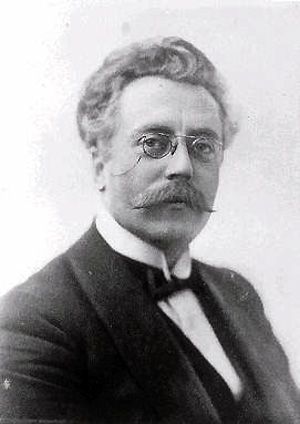

Source: Pearl CD (my rip!)
Formats: FLAC(RAR), DDD Stereo, mp3(320)
File Sizes: 234 MB / 120 MB (FLAC version incl. artwork & booklet)
The FLAC link has now expired. No more requests for this, please!
mp3 version -
https://mega.co.nz/#!Th5zGZQS!Qlf-sWdm9Wkzvbjn-W2RUnIG_kO8k14U61J64bhywO8
Enjoy! Don't share! Buy the original! And please click on "Like" if you downloaded this album! :)
Guideff
03-03-2015, 01:03 PM
Many thanks for Frank Bridge: Norse Legend, Vignettes de Danse, Threads, Suite for Cello.
Soothing.
wimpel69
03-03-2015, 03:33 PM
No.718
Stanislaw Moniuszko (1819-1872) was Poland’s leading opera composer in the 19th century,
his work said to ‘bridge the gap between Chopin and Szymanowski’. His skill as a born melodist is
apparent in the ‘beautiful and inspired’ overture to Paria, while the dramatic Halka was
the work which brought him national acclaim. An affinity with Liszt’s tone poems can be heard in
the substantial overture Bajka, while the scene for The Haunted Manor is set with
an atmospheric "Intrada."
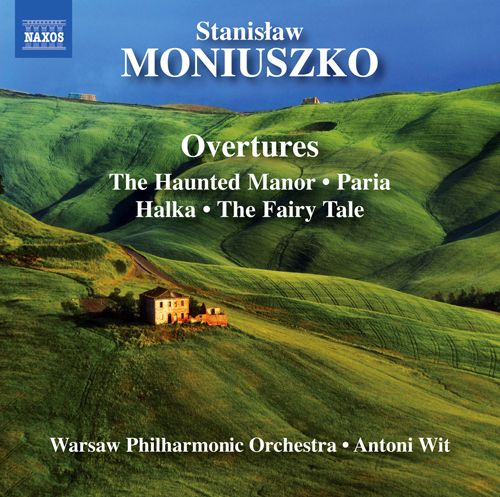
Music Composed by Stanislaw Moniuszko
Played by the Warsaw Philharmonic Orchestra
Conducted by Antoni Wit
"Moniuszko’s natural heartland was Polish nationalist opera although there are plenty
of songs and some masses (here and here). His seemingly frictionless and flighty
melodic skills lie somewhere north of bel canto and somewhere south of Tchaikovsky.
This collection of operatic overtures stretches across twenty years and is quite
charming. It will probably have you looking for the complete operas - good hunting,
though Dux have done some valuable work here (Paria; Halka; Flis). The success of
this most generously timed disc can be equated with one of my Recordings of the
Year: Somm’s British operatic overtures. If you liked the Somm collection you will
love this.
Bajka is the longest overture on this 80-minute CD and bristles with strutting pride,
evergreen and bird song. It is a freestanding concert overture and can be bracketed
very approximately with the Liszt and Tchaikovsky tone poems. You may have heard it
already if you know the CD-Accord disc of Polish orchestral music. If Tchaikovsky can
be glimpsed in Bajka then it’s a case of Schumann meets stormy Tchaikovsky in
Paria which itself sports a lovely whispered melody (2:50) - clearly a Moniuszko
speciality. Halka alongside The Haunted Manor have lent Moniuszko’s name a
modest fame. I am not familiar with the whole opera but while jolly enough it does
not strike me as superior to Paria. Indeed some of it rattles and crashes like one of
the Vienna Strausses’ operatic overtures, yet with some imaginative strokes
redolent of Weber and Mendelssohn (6:10). Verbum Nobile is a later work from
a one-act opera poking fun at the ways of the aristocracy. It is a light overture
which has something of the tang and crash of a Supp� overture. Flis has less of
the crash-bang-wallop of Verbum Nobile. Oddly enough its quiet musings reminded
me at first of the dreamy aspects of Arensky’s Dream on the Volga and Lyapunov’s
Zelazowa Vola. These static aspects are cast aside for an energetic national dance;
the whole running to ten minutes. Hrabina has a Dvoř�kian accent recalling the
Czech Dances. A formula is in evidence here but that is shaken free for the
overture to The Haunted Manor which is pregnant with tension in a way not
experienced with the other overtures here. Jawnuta, as befits the subject
matter of this “idyll in two acts”, has a Hungarian flavour and a most striking
part for solo trumpet. The New Don Quixote, or 100 Follies is a three-act operetta
“after Cervantes”. It is quite early and after the initial musings this overture
bubbles with Beethovenian energy. The last overture is The Hetman’s Mistress.
It was scored for piano (four hands) and comes down to us here in an
orchestration by Zygmunt Noskowski. More recently Witold Rowicki has made
another performing version. This one by Noskowski - a composer whose
symphonies I hope Naxos will pick up - presents the Moniuszko we know
from the other overtures here.
The playing and engineering is exemplary; my only real criticism is that there
is an edge to the violin sound. Otherwise everything is comme il faut from
Poland’s capital orchestra and leading conductor. Paul Conway’s notes tell us
what we want to know without any opaque and unnecessary musical technicalities.
This collection certainly takes us well beyond the usual Halka and Haunted
Manor overtures and does so without any suggestion of choking dust."
Musicweb
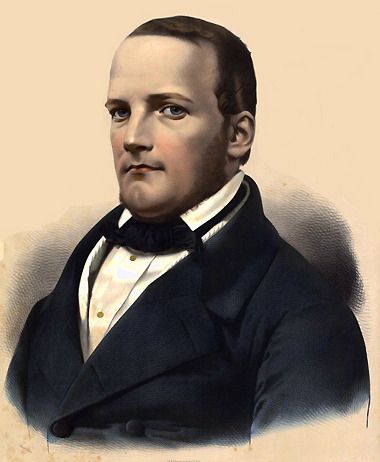
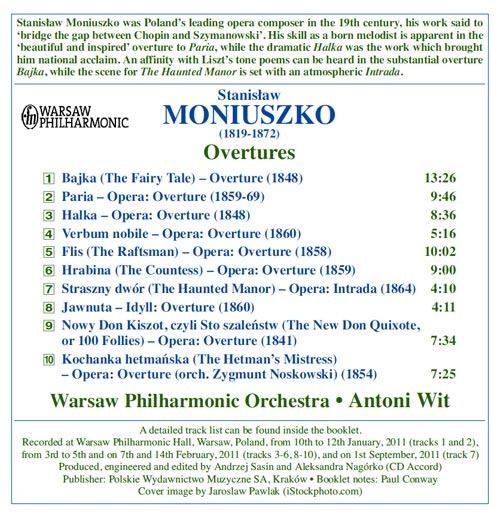
Source: Naxos CD (my rip!)
Formats: FLAC(RAR), DDD Stereo, mp3(320)
File Sizes: 375 MB / 199 MB (FLAC version incl. covers & booklet)
The FLAC link has now expired. No more requests for this, please!
mp3 version -
https://mega.co.nz/#!e5B2EJ7L!Sj2SPW51DUdkUf8xrXDDyYwqVZmAs2BdBeHHZ0k 5POs
Enjoy! Don't share! Buy the original! And please click on "Like" if you downloaded this album! :)
wimpel69
03-03-2015, 06:22 PM
No.708 (by request)
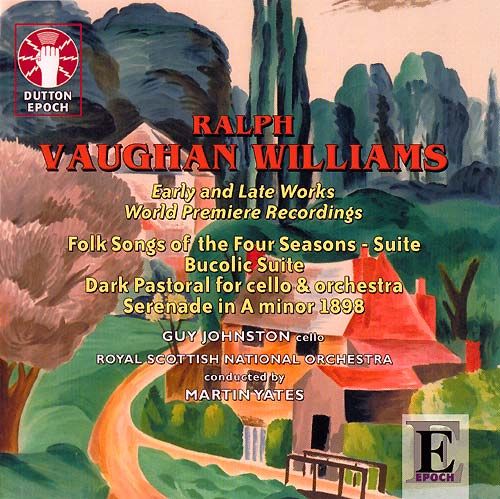
Music Composed by Ralph Vaughan Williams
Played by the Royal Scottish National Orchestra
With Guy Johnston (cello)
Conducted by Martin Yates
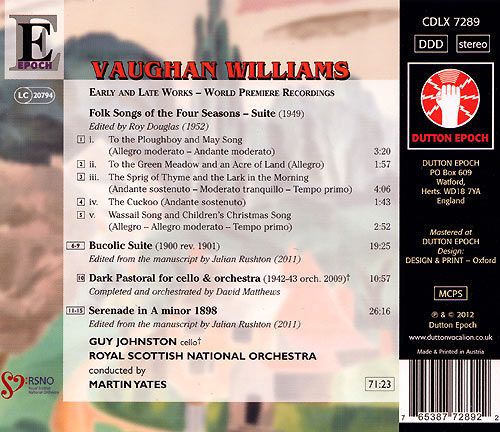
A note to those who requested the FLAC link for this disc. I had to replace the FLAC link with a new one
because it was "temporarily unavailable" (which, in MEGA-speak, means permanently unavailable).
So if you haven't downloaded the FLAC version for this album, please request the new link.
Also, please note that, to make room for new posts, I am now deleting the "expired"
requested FLAC uploads more quickly than before (approx. after 1 month). So if you
have requested FLAC versions, download them soon!
booster-t
03-03-2015, 07:26 PM
This CD — Stanislaw Moniuszko: Overtures — is IMHO, one of the better unknown disks I have encountered here. As an unabashed romantic period "fan", this fits nineteenth century musical styles perfectly ... you can hear echoes of Berlioz and Mendelssohn as well as Lizst ... plus some of the elegance of Dvorak's folk-song based overtures. A real catch.
wimpel69
03-05-2015, 05:57 PM
No.719
Kazuo Yamada (1912-1991) was one of Japan’s most influential composers and conductors who,
in his own works, rejected the ‘facile exoticism’ of Japanese nationalism that became the vogue at the
onset of the Sino-Japanese war in 1937. The little symphonic poem A Song of Young People is one such
‘protest’ work. Kiso (Old Japanese Melody) is an orchestral paraphrase of two folk songs, while
the symphonic suite India is a reworking of the ballet score Spellbinding, which is based on
Indian legend. The Mahlerian Grand Treasure is a threnody for the dead that movingly incorporates
Japanese instruments related to shomyo (the chanting of Buddhist hymns) which, in Yamada’s own words,
‘can in a sense be thought of as the origin of Japanese music’.
Yamada’s compositional style reflects diverse influences from Richard Strauss, B�la Bart�k, Paul Hindemith,
and 20th-century French music. He always expressed interest in avant-garde methods of the day such
as Expressionism and the Neue Sachlichkeit (The New Objectivity). Importantly, however, his most
significant influence was Mahler’s music, which can probably be ascribed to his study with Klaus
Pringsheim, one of Mahler’s pupils. Yamada once confessed that Mahler was “the man for whom
I feel the strongest affinity and sympathy”.
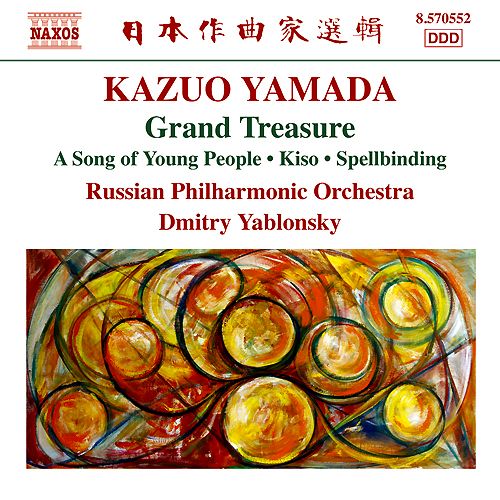
Music Composed by Kazuo Yamada
Played by the Russian Philharmonic Orchestra
Conducted by Dmitry Yablonsky
"My sparse acquaintance with the name of Kazuo Yamada comes entirely in the world of
conducting, this being my first knowledge of his life as a major composer. My recognition
of him comes from the fact he was the first native musician to form a symphony orchestra
in Japan, which today we know as the celebrated NHK Symphony. For me the work that
marks him out among major 20th century composers comes with Grand Treasure or more
aptly described as ‘the Emperor’s people’, and is probably a hidden commentary on the
thousands of people who died in the Second World War…in Dmitry Yablonsky [the Russian
Philharmonic Orchestra] obviously have a conductor sympathetic to the composer.
The recording sound is very good."
David's Review Corner
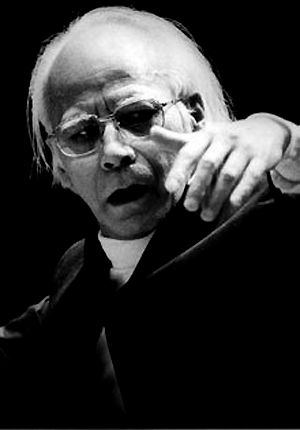
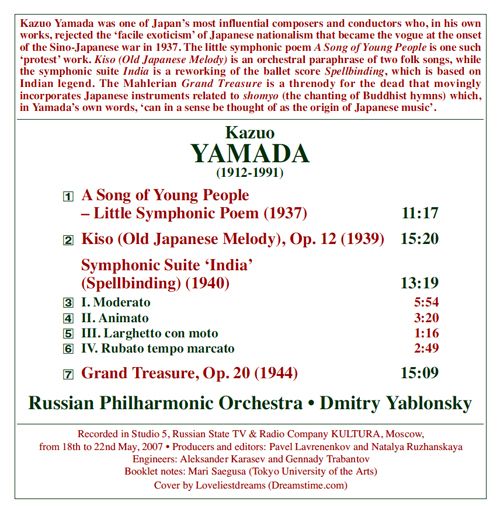
Source: Naxos CD (my rip!)
Formats: FLAC(RAR), DDD Stereo, mp3(320)
File Sizes: 284 MB / 135 MB (FLAC version incl. covers & booklet)
The FLAC link has now expired. No more requests for this, please!
mp3 version -
https://mega.co.nz/#!PI0lnBKT!LgEWakVYtLl5b7uYM2ahFQDP0zYlYpOlp28-DstyTvM
Enjoy! Don't share! Buy the original! And please click on "Like" if you downloaded this album! :)
wimpel69
03-06-2015, 11:20 AM
No.720
Portsmouth Point is an overture for orchestra by the English composer William Walton,
composed in 1925. The work was inspired by Rowlandson's print depicting Portsmouth Point.
Walton recalled that the main musical had come into his mind whilst riding on a route 22 bus
in London. Portsmouth Point depicts in musical form the rumbustuous life of British 18th century
sailors. Commentators have noted the influence of Igor Stravinsky's music and of jazz in the
rhythms of the score, as well as the rhythm of the Catalonian sardana dance.
The Sinfonia Concertante was originally conceived as a ballet for Diaghilev's Ballet Russe, but
the Russian impresario rejected the composer's concept, so Walton redrafted the score for orchestra
with piano obbligato. Completed in this form in 1927 and first performed by the Royal Philharmonic
Orchestra tinder Ernest Ansermet in 1928 with the pianist York Bowen, to considerable critical
approval. Walton revised the Sinfonia concertante in 1943, now removing something of the complexity
of the piano part, cutting some contrapuntal elements.
Walton’s characterful and highly theatrical score for his only original ballet, The Quest, is the
most enigmatic of his entire œuvre. At forty minutes duration it constitutes one of his half-dozen
most substantial works, yet since the limited run of the original production in 1943 it has received
only two further performances. Written for Frederick Ashton's Sadlers Wells Ballet, a scenario
prepared by his friend the writer Doris Langley Moore that was derived from the allegorical poem
"The Faerie Queene" by Shakespeare’s contemporary Edmund Spenser. Intractable material for
a ballet, it might be thought, but as it featured St George and presented in graphic form the
conflict between good and evil, it provided a good opportunity to present a morale-boosting
patriotic spectacle at a low point in the war.
In Siesta, an oboe plays an Italian street song evocative of the Siena night scene
which Walton saw and described after he and his publisher, Hubert Foss, escaped from a
reception: ‘Up one little street, we stopped on hearing music. We were at the top of the
steps to a lower level and at the bottom was a tiny open space lit by one lamp. Four people
were playing tangos on mandolins and whistling the tune with a flexatone to help, and one
or two couples were dancing. It was such a beautiful sight, so simple and romantic and
peasant-like and such a change from the idiotic reception.’ That scene is captured by
the delicate orchestration.
Twentieth-century English composers have delighted in the picaresque ‘comedy overture’, full of
bustle and incident, bright orchestration, often loosely engaged in delineating the character of some
rogue or other from the byways of literature. Scapino – his name derives from the Italian word ‘to
escape’, from his adeptness at getting out of sticky situations, and is perhaps the source of the English
word ‘escapade’ – is a stock figure in the Italian commedia dell’arte, a quick-witted schemer and
scoundrel motivated by self-interest and self-preservation. Scapino is just the kind of fellow around
which to write a picaresque overture, and he announces himself at once with a crowing, strutting
trumpet theme, molto vivace. An agile transition theme and a more expressive but somehow
slippery second subject completes the roster of his melodic signatures in an always-cheerful
exposition. Spiky orchestration and pungent flecks of dissonance remind us always that we are
in the presence of an untrustworthy, if occasionally charismatic rascal.

Music Composed and Conducted by William Walton
Played by the London Symphony and London Philharmonic Orchestras
With Peter Katin (piano)
"... a very valuable addition to the Walton discography, particularly when the sound
is outstanding, among the finest of its period. The ten little pieces of the Music for
Children are delightfully done, with the subtleties of the instrumentation beautifully
brought out, so that the final ‘Alla Marcia’ becomes quite a demonstration piece with
its contrasting fanfares for horns and trumpets. It is good too to have the suite which
Vilem Tausky drew from Walton’s wartime ballet, The Quest … it certainly makes a
colourful and very characteristic suite in this brief form, superbly played by the LSO.
Walton in his late sixties may have been a more relaxed conductor than he had been
earlier, but with his feeling for rhythms and line he still provides unique insights."
Gramophone
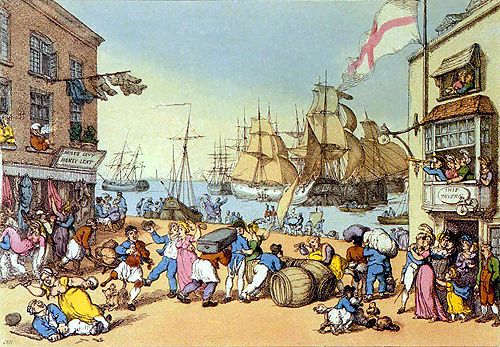
"Portsmouth Point" by Thomas Rowlandson.
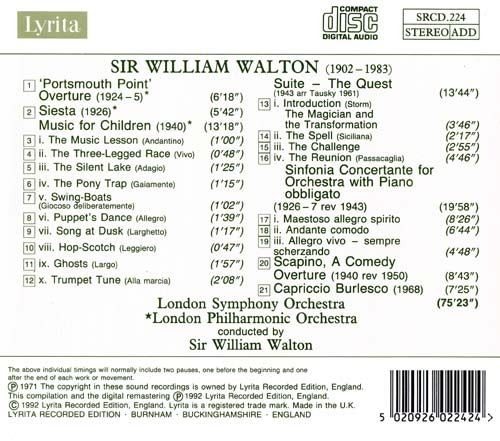
Source: Lyrita Records CD (my rip!)
Formats: FLAC(RAR), ADD Stereo, mp3(320)
File Sizes: 370 MB / 171 MB (FLAC version incl. artwork & booklet)
The FLAC link has now expired. No more requests for this, please!
mp3 version -
https://mega.co.nz/#!3JdUyDCJ!zjpRo8CCySDFnPyqllG_7vfLls3yXepdgcaY-HLq7yM
Enjoy! Don't share! Buy the original! And please click on "Like" if you downloaded this album! :)
markcope1961
03-06-2015, 01:44 PM
If ever a man was destined for �immortality� within the realms of internet landscapes, then it�s Wimpel69. In a world of ever shifting values and unrelenting change, Wimpel stands firm, as a beacon of quality and selfless endeavors�. In the unofficial dictionary of ffshtrine lore, the term Wimpel69, is a definition for �Musical Integrity & Impeccable Standards��
bohuslav
03-06-2015, 06:47 PM
This is my Walton desert island disc, splendid played and genious recorded. Once on two
LP's now (i own it since 1993 ;O) on one disc.
wimpel69
03-07-2015, 05:31 PM
No.721
Alexandre Tansman’s final three symphonies all use the standard four-movement format with
Scherzo placed third. The Seventh (1944) is subtitled "Lyrique" and its outer movements, as well
as the Andante cantabile, illustrate why. But the bulk of the work is rhythmic and vigorous, not least
in the playful Scherzo. It is not hard to see why it made such an impression at its premiere in 1947.
The Eighth Symphony, however, the Eighth (1947-48) may even be the finer work, especially
in the final three movements (the Scherzo is a real gem), and possibly Tansman’s finest. Both
symphonies rely heavily on Stravinskian neoclassicism – particularly that of the Symphony in C –
but Tansman adapted this to create a naturally symphonic manner utterly alien to the Russian.
Tansman also had a flair for orchestration and a knack for soaring melodies not far removed from
Martinu’s symphonies. After their success, it may seem a surprise that Tansman’s Ninth and last was
never performed during the remaining 28 years of his life, a symphonic silence almost as long as that
of Sibelius. The answer may be a variant of “ninth symphony syndrome”; perhaps the composer
realised that the symphony did not recapture the �lan of its predecessors, still less scale the heights
of Beethoven, Bruckner or Schubert.

Music Composed by Alexandre Tansman
Played by the Melbourne Symphony Orchestra
Conducted by Oleg Caetani
"The Seventh Symphony of 1944, as a matter of fact, is dedicated to Stravinsky, but that’s the
end of the connection. Although subtitled “Lyrique,” this is not its most salient aspect. As in
most of the Tansman symphonies, four movements lasting more or less 20 minutes is a sufficient
compass within which Tansman works his transformative wiles, opening (and sometimes closing)
with a minute or two of quiet pensiveness before plunging into his characteristically sleek and
motoric drive in which one can sometimes faintly discern echoes of Poulenc and Gershwin. Some
of the bustling themes make one think of An American in Paris , but instead this is “ A Pole in
Paris,” having the time of his life. After an Andante sostenuto slow movement and a Molto
vivo Scherzo (both of these also quite typical), the finale moves back and forth between a
mournfully reflective Adagio and an invigorating Allegro deciso before falling away into gradual
diminishment. (This is what we think the marking Perdendoso means.)
The 1948 Eighth Symphony (the only work here to have been briefly available in a rather dim
“live” Dutch performance conducted by Kubel�k) was originally titled Music for Orchestra , an
indication that during his final decades Tansman would be moving away from strict Classical
forms and would even be injecting more atonalish textures into some of his later works. This
22-minute, four-movement symphony is distinguished by a rather austere “El�gie” in memory
of the Belgian conductor Franz Andr� and a Molto vivace Scherzo that is full of jazzy offbeats.
Tansman’s Ninth and final effort in the symphony form—though there was to be a piquant
Chamber Symphony for oboe, English horn, and chamber symphony during the 1960s—was
not commissioned, as were the others, and thus was never heard by the composer. But in this
magisterial work Tansman gives us the quintessential Tansman universe in which his trademark
industrial-strength ostinato rhythms and his vibrant sectional harmonic shifts and washes
of sound reach heights of excitement and ethereality that are alternatively terrifying and
exhilarating. The Grave slow movement is one of his most dignified and commemorative,
while the scherzo begins Molto vivace but gradually shifts gears into his typical fade-out
finish. Though the finale begins Lento, it is quickly overwhelmed by a threatening Allegro
con moto molto risoluto double fugue (one of his rare instances of fully developed
counterpoint), climaxing in a peroration of complex grandeur. This is Tansman operating
at the peak of his powers.
Oleg Caetani and his down-under musicians give this hair-raisingly impetuous but always
disciplined music the strongest possible advocacy, with Chandos’s Super Audio engineering
adding an ambience and finish of hyperreality. This CD is the best possible introduction
to a composer who deserves far wider exposure. The 2008 Want List begins to grow."
Fanfare


Source: Chandos Records CD (my rip!)
Formats: FLAC(RAR), ADD Stereo, mp3(320)
File Sizes: 225 MB / 148 MB (FLAC version incl. artwork & booklet)
The FLAC link has now expired. No more requests for this, please!
mp3 version -
https://mega.co.nz/#!LIMTGKwC!-z4rtyZJffufFYKKeahLv_JR9dJ_BOnW6IZykZryR54
Enjoy! Don't share! Buy the original! And please click on "Like" if you downloaded this album! :)
bohuslav
03-07-2015, 07:18 PM
A underrated composer, shame on me, remember not one melody from him. So i must listen to my Tansman cd's a little more than once ;O)
khaldun1
03-08-2015, 01:47 AM
Wonderful music that give enormous pleasure! Thank you Wimpel69
booster-t
03-08-2015, 04:25 AM
Lovely ... so much music ... so little time
wimpel69
03-08-2015, 05:41 PM
Lovely ... so much music ... so little time
The story of my life. ;)
No.722
2013 celebrated the 100th anniversary of the birth of Jerome Moross, an American original.
Best known for his outstanding motion picture scores, he considered himself primarily a composer
of concert music and this recording, originally released by Koch, demonstrates his considerable
contribution to American music. Writing for the theatre remained Moross’ first love as a composer.
Frankie and Johnny, written in 1938, was one of a number of works he wrote for this medium.
The recording spans his compositional output from his earliest work, Biguine, written in 1934,
to his last completed work, the Concerto for Flute and String Orchestra, composed in 1978.

Music Composed by Jerome Moross
Played by the New Zealand Symphony Orchestra
With Alexa Still (flute)
Conducted by JoAnn Falletta
"Once again, producer Michael Fine has come up with a fascinating and rewarding program
off the well-worn path. The performances are good, better than merely professional, with
Alexa Still particularly adept at sweet singing when the composer calls for it. Most labels,
even when recording unfamiliar repertoire, tend to record the same unfamiliar repertoire,
on the likely grounds that it has some sort of track record. Fine mixes less-familiar with
largely unknown. In my opinion, his catalogue is one of the most enterprising and lively
in the business. And, yes, I bought this disc with my own money."
Classical Net
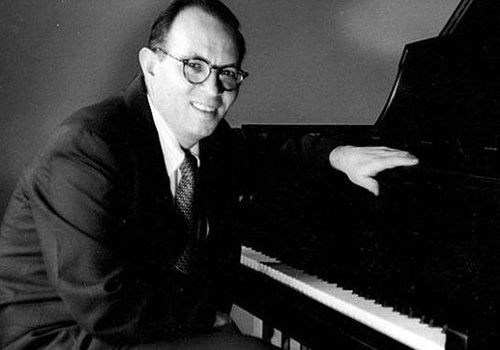

Source: Albany Records CD (Originally on Koch International) (my rip!)
Formats: FLAC(RAR), DDD Stereo, mp3(320)
File Sizes: 267 MB / 136 MB (FLAC version incl. cover & booklet)
The FLAC link has now expired. No more requests for this, please!
mp3 version -
https://mega.co.nz/#!rJUzXAyR!V-Ej0WpIXD5EyZ3zdj10cqCs2Xbql58UFIelqVOrCaw
Enjoy! Don't share! Buy the original! And please click on "Like" if you downloaded this album! :)
---------- Post added at 05:41 PM ---------- Previous post was at 05:36 PM ----------
The FLAC links for Nos. 691 to 700 have now expired. No more requests for these, please!
bohuslav
03-08-2015, 06:09 PM
I own this CD with the same artists but from Koch-Schwann and the cover picture is different.
wimpel69
03-10-2015, 11:49 AM
No.723
Kurt Weill's Kleine Dreigroschenmusik (Little Three-Penny-Music) is one of the mainstays of the
repertoire for symphonic winds. It is in Weill's characteristic mixture of classical, popular, and dance
music styles with an overlay of a rather seedy-sounding adaptation of European jazz styles.
It contains one of the best-known of all popular songs. Weill's successes on the stage led Bertolt Brecht
to propose a full-length work to be adapted from Gay and Pepusch's The Beggars' Opera (1728).
That work had done what Weill and Brecht wanted to do: It had practically swept traditional opera off
the stage in London, substituting a new form that used popular ballads as its musical basis. Weill
wrote all new music, while Brecht adapted the tale of the life and loves of the villain Macheath to
a more contemporary setting, enabling him to attack the corruption and moral decay he attributed
to the democratic Weimar government. Die Dreigroschenoper (Three-Penny Opera) was a sensation
and played at least 10,000 performances in various productions in the 1920s. In 1929, Weill responded
to requests for an orchestral suite by adapting eight of its numbers into a suite.
Although widely known as a writer of bizarre, mysterious works such as the novel "The Sheltering
Sky" and the fabulous collection of short stories "The Delicate Prey and Other Stories", the ex-patriate
American Paul Bowles has also been a prolific composer of songs, operas and instrumental
pieces, who studied with Aaron Copland, Virgil Thompson and Nadia Boulanger. Originally written
for an Orson Welles production "Too Much Johnson", Music for a Farce for a small orchestra,
including a percussion section with unusual instruments like an electric doorbell and milk bottles,
was composed in 1938. It a hilarious set of 8 sections of "slap-stick"-like music with chase scenes,
prat-falls, and some really (and purposefully) corny sentimental music.
Edgar Var�se often insisted that music is both a science and an art. With his ingeniously
inventive orchestration in mind, through which he put many sounds into the world that had never
existed before, perhaps he should have summed it up as "alchemy"; he certainly did love the
symbolism of arcane religions. Octandre is a brilliant, purely technical study of the
inexplicable abracadabra of sound that Carlos Ch�vez rightly called gold. With this
accomplishment, Var�se moved significantly closer to his ideal of a purely material
music of "spatial projection."
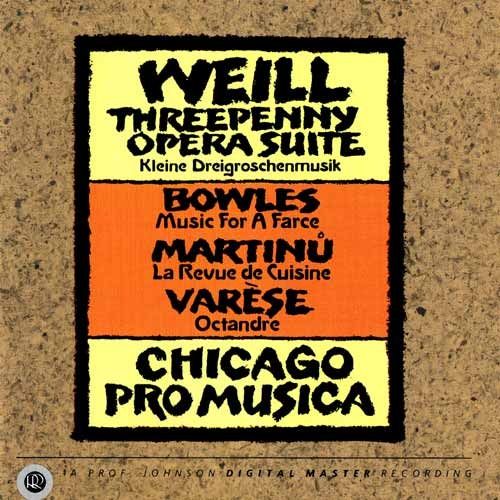
Music by (see above) & Bohuslav Martinu
Played by the Chicago Pro Musica Chamber Players
"It takes a fairly exceptional account of the Kleine Dreigroschenmusik to hold a candle
to the London Sinfonietta on DG, but this one by the Chicago Pro Musica, whose players
are drawn from the Chicago Symphony Orchestra, certainly does; I would happily take
either recording from my shelves, confident of 20 minutes' pleasurable listening.
Arguably there is more to Weill's music than that, and there are quite a few details
where David Atherton persuades his players to add an ironic twist, which is not a
concern of the Chicagoans. And the generosity of vibrato in the latter ensemble's
saxophones and trombone (rather George Chisholm-ish in the "Ballad of Mack the
Knife") is not a plus in my book. Still, for accomplishment, refinement, and clarity
of recorded balance, the performance remains a fine one.
If the players are, as it seems, unconducted, their Var�se Octandre is quite remarkably
polished, with every detail of the score meticulously observed and ensemble playing
razorsharp. Again, so far as characterization is concerned, there is an argument for
the grating of a slightly blunt razor in this music (the rasping trumpet gets it, the
rather polite horn misses it) in order for its violent energy to register fully; but the
sheer musicality of this reading gives it a validity all its own.
Paul Bowles's Music for a Farce adds rather less to the sum total of human experience,
although its scoring resourcefully conceals the fact that only five players are involved
(which in turn reflects on the exceptional skill of the Chicago players in varying
perspectives and shading tone-colours). Dating from 1938, this suite of incidental
music hankers after a time when Satie's Parade and Milhaud's La creation du monde
were freshly minted.
After this, Martin�'s La revue de cuisine gives the disc a happy send-off, the more
so for the wit with which Easley Blackwood dispatches the vamp-till-everybody-else-
is-fed-up piano part and for the delicious rhythmic pointing of the proto Maxwell
Davies "Charleston"."
Gramophone
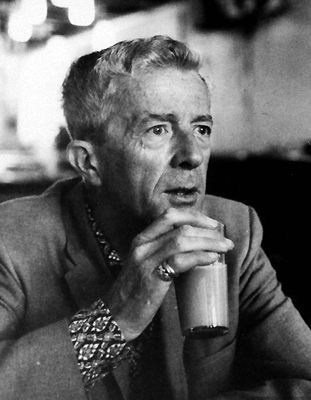
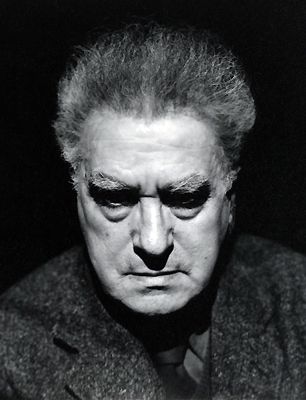
Paul Bowles, Edgar Var�se.

Source: Reference Recordings CD (my rip!)
Formats: FLAC(RAR), DDD Stereo, mp3(320)
File Sizes: 255 MB / 127 MB (FLAC version incl. cover & booklet)
The FLAC link has now expired. No more requests for this, please!
mp3 version -
https://mega.co.nz/#!OIlRyJZT!o_w8pFcNCBD8QzYVCEFW6cYpkSWQcfhtbnUq4LE TM2c
Enjoy! Don't share! Buy the original! And please click on "Like" if you downloaded this album! :)
wimpel69
03-13-2015, 02:48 PM
No.724
One of the most significant threads in Gian Francesco Malipiero’s huge and many-sided output,
the symphonies strengthen his claim to be regarded as the most important and original Italian composer
of his generation. Sinfonia dello zodiaco vividly depicts the ever-changing moods of the four seasons
in twelve movements that are analogous to the signs of the zodiac. The work’s four component main
subdivisions (or partitas [‘partite’], as they are called in the score) are each further subdivided into three,
making no fewer than twelve movements altogether. These are designed to be played with somewhat
longer pauses between the partitas than between the individual movements within the partitas.
Moreover it is clear from the symphony’s subtitle (‘4 partite: dalla Primavera all’inverno’), as well as
from internal evidence, that the partitas correspond to the seasons of the year; while the component
movements are analogous, at least in number, to the twelve signs of the zodiac mentioned
in the main title. Malipiero was himself extremely evasive about the inspiration behind this work
(‘I can say nothing about this symphony—neither justify its form nor its title. I must keep the secret
of its origins’). Examination of the music, however, reveals no obviously recognizable attempt to
depict the zodiac signs themselves: the overtly descriptive elements seem to relate entirely to
the cycle of the seasons.
The perky capriciousness of his brief Symphony No.9 is interrupted by an unforgettable but enigmatic
outburst by trumpets and percussion marked ‘Ahim�’ (Alas!) in the score. Symphony No.10, his
musical tribute to an admired colleague, Hermann Scherchen, is named after the ancient Greek goddess
who cuts short the thread of life.

Music Composed by Gian Francesco Malipiero
Played by the Moscow Symphony Orchestra
Conducted by Antonio de Almeida
"The Moscow Symphony Orchestra in 1993 was basically a pick-up band, and not the world’s
greatest by a long shot, but these nevertheless are appealing performances of some very
strange music. The Sinfonia dello zodiaco covers a lot of territory: the 12 months of the year,
signs of the zodiac, divided into three “partitas”, each representing one of the seasons. It’s
colorful, curiously wistful music well worth getting to know. The two symphonies are later
works, written in an acerbic chromatic idiom. No. 9, “dell’ahim�”, features a violent scream
at the beginning of its finale, hence the title. No. 10, “Atropo”, is a very brief piece in four
pithy movements, dedicated to Hermann Scherchen, who championed so much modern
music. It’s possible to imagine more unanimity from the strings, or some sweeter-toned
reeds, but it probably will be a long time before something better comes along. Until
then, this series is more than respectable."
Classics Today
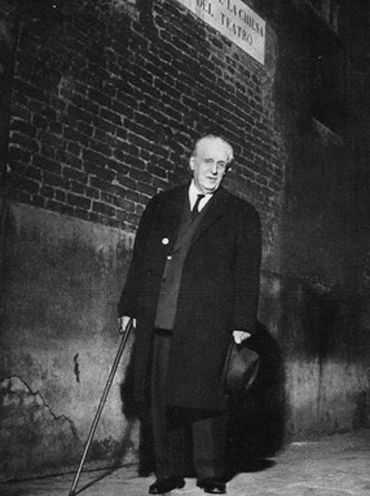
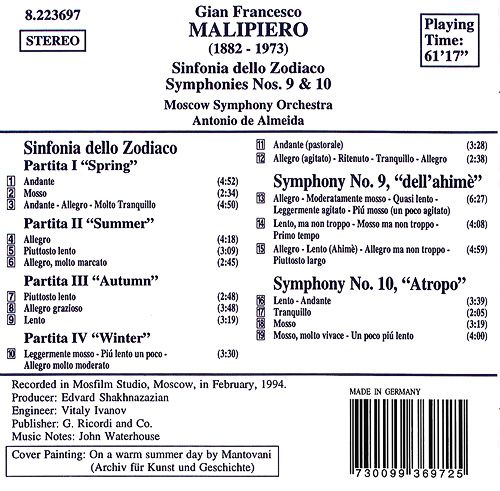
Source: Marco Polo CD (my rip!)
Formats: FLAC(RAR), DDD Stereo, mp3(320)
File Sizes: 292 MB / 165 MB (FLAC version incl. cover & booklet)
The FLAC link has now expired. No more requests for this, please!
mp3 version -
https://mega.co.nz/#!TUV3gRhK!bhzK2sPa8qfLHMG5z2Up1Gh8t-jqZwzGhwZVR-YNP2o
Enjoy! Don't share! Buy the original! And please click on "Like" if you downloaded this album! :)
wimpel69
03-16-2015, 05:28 PM
No.725
This album, with four world premiere releases, offers a representative
slice of 20th-century Swiss music, ranging from Othmar Schoeck’s late-
Romanticism via the neoclassicism of Adolf Brunner to the Modernism
of Ernst Widmer. Nearly fifty years separate Schoeck’s first and
last major orchestral works, recorded here – but his commitment to the
German Romantic tradition remains undimmed. Brunner’s neoclassical
Partita betrays the influence of Hindemith, but has a Brahmsian
meatiness to its piano part, while Widmer’s influences in his exuberant
concerto range from Bart�k to Brazilian street music.

Music by Othmar Schoeck, Adolf Brunner & Ernst Widmer
Played by the Royal Scottish National Orchestra
With Fali Pavri (piano) & Martin Gibson (timpani)
Conducted by Rainer Held
"Othmar Schoeck was an important Swiss composer during the first half of the
twentieth century. In contrast to the more dissonant style pursued by contemporaries,
Schoeck is known for his essentially tonal music and his attention to melodic values,
rather than dissonant effects. As to his many works, Schoeck made major
contributions to lieder with his numerous settings of song texts.
Schoeck studied formally at the Zurich Conservatory and during the period 1907-
08 worked privately with Max Reger in Leipzig. When he returned to Zurich in
1908, he established a career that involved composition and conducting. Among
his earliest works is a Serenade for Orchestra (1908) which was part of a composition
festival in Baden. He quickly became recognized as a composer for orchestra and
song; he held various teaching positions and performed on piano to accompany his
wife, and several other singers. Schoeck remained in Switzerland throughout his
career, where he was regarded as the country's foremost musician. In addition to
lieder and orchestral works, Schoeck composed several operas, the most important
of which is Penthesilea (1927), an impressive setting of Kleist's drama. Of his other
works, it is notable that he composed various settings for male chorus, a medium
associated with song of the choral societies of the nineteenth century.
Stylistically Schoeck's clearly tonal works involve some careful and effective use
of dissonance. His music is reminiscent of Hindemith from the 1930s and 1940s.
As with Hindemith, Schoeck's strong anchoring in traditional harmony and
conventional forms made his music more accessible to the general public."
All Music

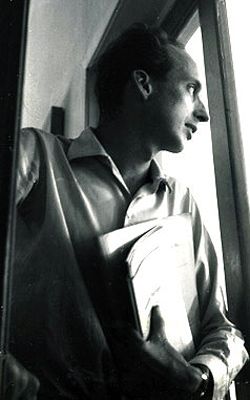
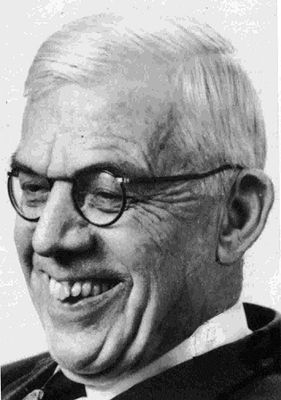
Othmar Schoeck, Ernst Widmer, Adolf Brunner.
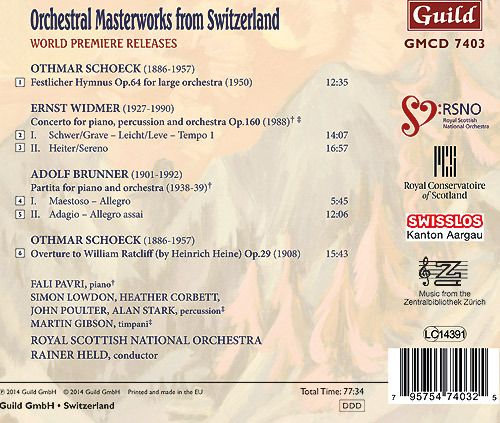
Source: Guild CD (my rip!)
Formats: FLAC(RAR), DDD Stereo, mp3(320)
File Sizes: 376 MB / 186 MB (FLAC version incl. artwork & booklet)
The FLAC link has now expired. No more requests for this, please!
mp3 version -
https://mega.co.nz/#!6VMU1LCa!7WjYkbcuOLNAuUrTZnQRbaleZ4VHItULIIdvGl5 uHMk
Enjoy! Don't share! Buy the original! And please click on "Like" if you downloaded this album! :)
bohuslav
03-17-2015, 04:57 PM
Schoeck: Hymnus is fantastic, so many young soundtrack composers would learn here so much.
wimpel69
03-18-2015, 11:42 AM
I actually thought that Widmer's very intense Piano Concerto is the most
striking piece on that abum. Full of memorable incident. :)
No.726
Under the direction of Professor Russel Mikkelson, The Ohio State University Wind
Symphony is a nationally recognized ensemble devoted to the preparation and performance
of the finest traditional and contemporary music for band. On this disc from Naxos’s popular
Wind Band Classics series, they present a wide-ranging program with global connections, from
the overture to Russian composer Dmitry Kabalevsky’s opera about a Breton master carpenter,
Colas Breugnon, to Aaron Copland’s El sal�n M�xico which takes us ‘south of the border’.
Contemporary American composers are represented by Donald Grantham, whose Southern
Harmony draws on an 1835 collection of American songs, Morten Lauridsen’s sublimely
still O Magnum Mysterium, and John Stevens’s colorfully-scored Symphony in Three
Movements.

Music by (see above)
Played by the Ohio State University Wind Symphony
Conducted by Russel Mikkelson
"It’s telling that the disc gets its title from the Grantham—it’s a superior piece to the much longer
Stevens, which is unfortunate. The wind band world could use more “substantial”—longer, more
“symphonic” in conception—works like this Symphony. However the musical content here simply
can’t sustain interest over this long a duration. Stevens is an interesting composer and has written
some very appealing pieces for brass instruments; one hopes a full band work of comparable
quality is forthcoming. By comparison, the Grantham is one of the finest original works for winds
of the last twenty years. While exploring and developing folk materials is hardly new territory
for band works, the composer manages to do so in a fresh and interesting way. The antiphonal
clapping in the brief third movement is tremendously exciting, and the harmonic language is
original and ingratiating, especially in the second and fourth movements.
All the transcriptions are excellent. The Copland is not only very idiomatic—the original has
plenty of wind and percussion emphasis already—but receives what is probably the best
performance on the disc. The Lauridsen has become extremely popular both in its original
choral version, and in this great version for winds. While I wouldn’t say this version is superior
to the original, the drama of the piece is made more explicit by the wider dynamic range and
tone colors, both expertly handled by Reynolds. The Kabalevsky is not quite as convincing as
the other two, but is effective enough as a flashy opener."
Musicweb
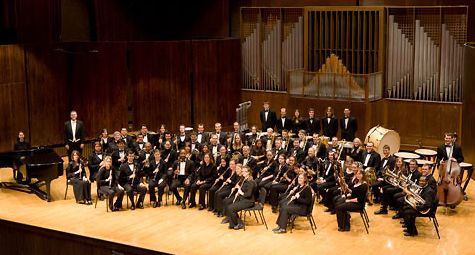
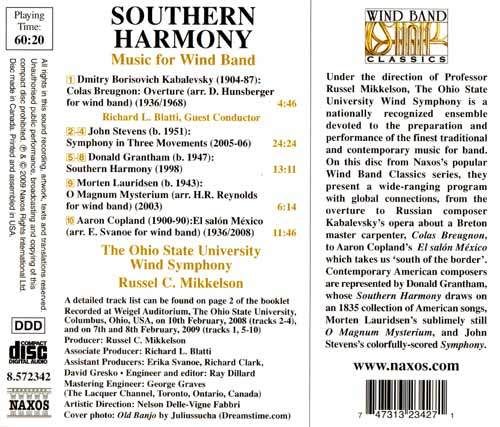
Source: Naxos CD (my rip!)
Formats: FLAC(RAR), DDD Stereo, mp3(320)
File Sizes: 239 MB / 138 MB (FLAC version incl. cover & booklet)
The FLAC link has now expired. No more requests for this, please!
mp3 version -
https://mega.co.nz/#!rJ81QKDI!dxpJckLA8MNEpwRdXKDJm72Q7V0PtnegszxmX2k eGeQ
Enjoy! Don't share! Buy the original! And please click on "Like" if you downloaded this album! :)
booster-t
03-18-2015, 06:21 PM
Thank you for the Egge, Howells and Harty CDs. I thought ,my tastes were eclectic, but your go way beyond me ... and I am thrilled to be able to expand mine.
wimpel69
03-19-2015, 11:28 AM
No.727
The CD's title "Visions of the East" alludes to the overtly Japanese and Indian idioms that generate these works,
and which were Alan Hovhaness's stylistic modus operandi of the early-to-mid 1960s. This disc certainly lays
to rest the myth sometimes propagated that Hovhaness' music was all hued by Armenian liturgical or folk influences;
in fact, he had already moved on by the mid-1950s. These recorded works are responses to the composer's
extended trips to locations such as Bombay, Madras, Tokyo, Seoul and Hawaii, and show his orchestral writing at
its most radically non-Western. The classical Indian currents that pervade the Vahaken Symphony (misleadingly
catalogued as No.10) show a composer at ease with just melody – and a little rhythm – to generate an entire
extended work, whilst the clear musical template for works such as Floating World and Zeami is the
Gagaku court music of ancient Japan. It was perhaps inevitable that as Hovhaness learned Gagaku instruments
when in Tokyo, he would incorporate their idioms into his works.
Whilst these evocative works are anything but rehashes of his celebrated Mysterious Mountain, there will
hardly be disappointment for lovers of that work – as ever, the composer retains his transparent, shimmering
textures and graceful melodic lines, albeit with much bolder exotic strokes and little-to-no Western rhetoric.
In the sonoristic tone poems Ode, Floating World and Zeami Hovhaness employs, to great
effect, his apocalyptic orchestral whirlwinds of "controlled chaos" - a nice musical analogy to his Japanese
subject matter. Listeners may momentarily be reminded of Messiaen in pentatonic mode (think Turangalila
Symphony), but this is very much Hovhaness' personal response to Eastern music, something which
he investigated with a sense of wonder and humility a long time before serious composers were
'sanctioned' to do so by the university World Music curriculum.
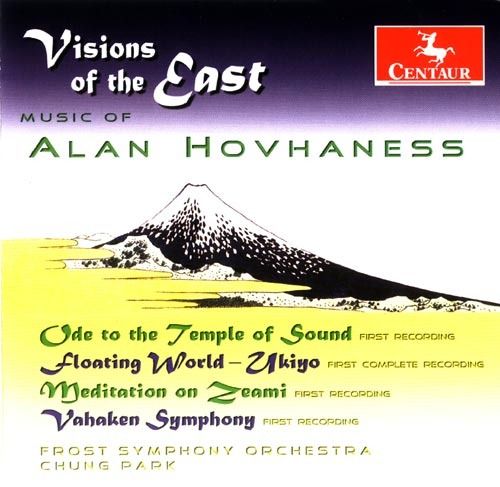
Music Composed by Alan Hovhaness
Played by the Frost Symphony Orchestra of Miami University
Conducted by Chung Park
"This is one of the best Hovhaness recordings to come along in quite a while. Yes, much
of his music has a familiar, repetitive quality: bells and gongs, rippling harps, sinuous Eastern
melodies, the occasional fugue (especially in the symphonies), the use of glissandos, soft
chord clusters, and rhythmically free episodes inspired by his study of Korean and Japanese
traditional music, and a love of simple prettiness connects all of these pieces. But this
doesn’t mean that they are identical.
For example, Floating World is a symphonic poem that includes a clear march episode
(unusual in Hovhaness) and a more pungent harmonic language than we usually find.
The symphony, in three movements of modest length, has a directness and concision
that really is “symphonic”, comparatively. Both Ode to the Temple of Sound and
Meditation on Zeami are just plain gorgeous, in the vein of Mysterious Mountain or
Fra Angelico. All are CD premieres, and all are splendidly played and recorded by
the orchestra of the University of Miami. Fans of the composer, and you know who
you are, will definitely want this."
Classics Today
http://i1164.photobucket.com/albums/q574/taliskerstorm/p10s10_zps5b3sk0gq.gif
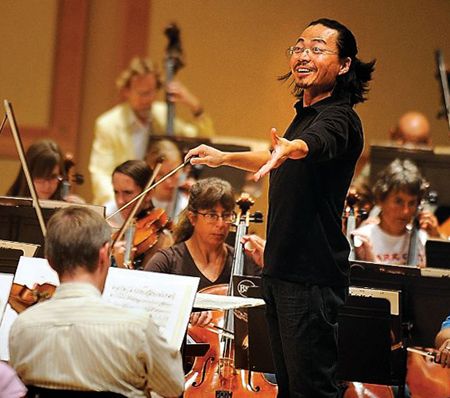
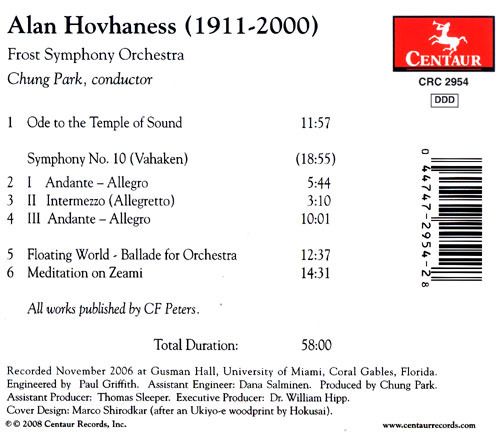
Source: Centaur Records CD (my rip!)
Formats: FLAC(RAR), DDD Stereo, mp3(320)
File Sizes: 207 MB / 133 MB (FLAC version incl. covers & booklet)
The FLAC link has now expired. No more requests for this, please!
mp3 version -
https://mega.co.nz/#!6BFxET5I!ZjGbtgwqp5KeBFpnDlVGjZleWS_RsbWMp_zs9iR FYbY
Enjoy! Don't share! Buy the original! And please click on "Like" if you downloaded this album! :)
bohuslav
03-19-2015, 12:01 PM
Great share, love many Hovhaness pieces, these are unknown to me. Many thanks wimpel69.
Dashiell2001
03-19-2015, 09:55 PM
Love Hovhaness x Brilliant x Thanks
ansfelden
03-21-2015, 12:13 AM
Thank you very much for Hovhaness and for the swiss classics, wimpel69. Quite uncreadible shares !
wimpel69
03-21-2015, 06:54 PM
No.728
The English pianist, organist, celesta-player and composer, Roderick James Charles Elms (*1951),
studied at the Guildhall School of Music (graduating in 1965), and at the Royal Academy of Music
(graduating in 1970), which has awarded him the honorary distinction of Associateship in recognition
of his contribution to the music profession. In 1974 he became Fellow of the Royal College of Organists.
Roderick Elms appears in concerts, recordings and broadcasts (Radio and Television) with most of
Britain’s major orchestras, both as a principal keyboard player and soloist.
Elms has had a lifelong passion for writing and his compositions feature regularly in concerts,
church services and broadcasts. He is Composer in Association to the Elgar Chamber Orchestra
and his compositions, which range in diversity from solo instrumental music to symphonic
compositions, are now heard across the UK, the USA and Canada. Much of his instrumental music
has been recorded by the RPO for the Dutton label under the title "A Little Fall-ish!"
This CD includes his popular Concertino for Celeste, Four Seasonal Nocturnes for horn,
Cygncopations for cor anglais and the P�an for organ and strings. This is essentially
British "light music" meant to amuse and entertain.
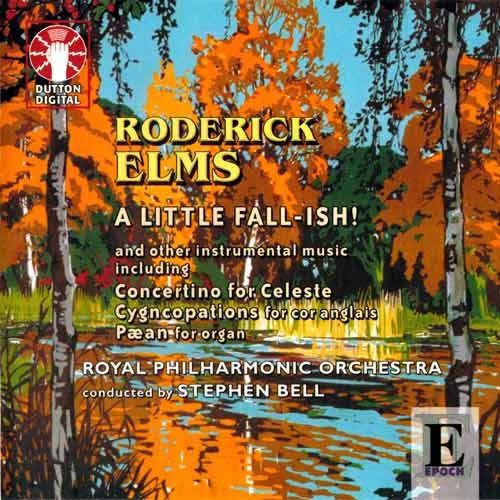
Music Composed by Roderick Elms
Played by the Royal Philharmonic Orchestra
With Roderick Elms (celesta) & Victoria Walpole (cor anglais)
And Janice Graham (violin) & Stuart Nicholson (organ)
Conducted by Stephen Bell
"This CD was issued in 2006 but seems not to have been reviewed here previously.
More's the pity, because it's one of the most enjoyable British light music CDs to come
my way in recent years. Roderick Elms's name will already be well enough known for
his appearances on CD as solo pianist in music by Richard Addinsell, Hubert Bath and
others. The music here, though, is by no means written just as a vehicle for his own
performing talents. Indeed Elms appears only as soloist in the opening Concertino
for Celeste and as pianist in a few other pieces.
Don't let the CD's somewhat gimmicky title, 'A Little Fall-ish!', put you off. The music
belongs irrefutably to the British light music tradition. The CD title comes from the
first movement of the delightful Four Seasonal Nocturnes for solo horn and orchestra,
which capture aspects of the changing seasons in various countries. A breath of
fresh air is above all what the CD conveys, with suggestions of Delius and Vaughan
Williams in the restrained and delicate orchestration. That Elms has a fine ear for
instrumental textures and colours is further demonstrated by the 'Fandango
Fantastico' for organ and guitar, and not least by the final three-movement suite
of arrangements of Bach for piano and orchestra. Altogether this is a CD of
atmospheric and approachable music of real charm. Elms is very decidedly a
composer worth getting to know."
Masterkeyboards
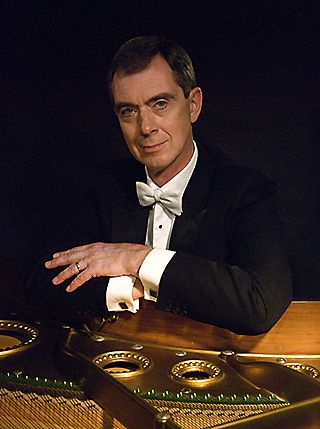
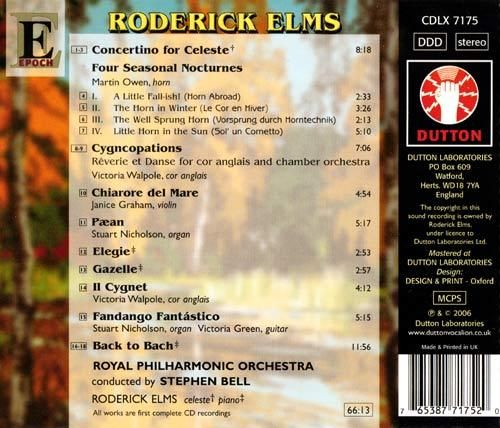
Source: Dutton Epoch CD (my rip!)
Formats: FLAC(RAR), DDD Stereo, mp3(320)
File Sizes: 308 MB / 152 MB (FLAC version incl. covers & booklet)
The FLAC link has now expired. No more requests for this, please!
mp3 version -
https://mega.co.nz/#!OJdUVAbS!I0U6Le5K1AlgQSMh3Qx9zTSBubY-fYasOSNkMux2t3k
Enjoy! Don't share! Buy the original! And please click on "Like" if you downloaded this album! :)
---------- Post added at 06:54 PM ---------- Previous post was at 06:21 PM ----------
The FLAC links for posts Nos. 701-710 have now expired. No more requests for these, please!
Guideff
03-21-2015, 10:34 PM
Many thanks wimpel69 for '#533 - Bao Yuan-Kai, Son of the People Symphony'.
Just finished listening to it. Beautiful music.
booster-t
03-22-2015, 05:03 AM
Roderick Elms: Concertino for Celeste is a wonderful little piece ... sounds almost like a movie score ... highly recommended
Guideff
03-22-2015, 03:34 PM
Roderick Elms: Concertino for Celeste is a wonderful little piece ... sounds almost like a movie score ... highly recommended
booster-t is quite right, 'a wonderful little piece.'
I also chuckle at the rest with the subtle humour in such titles as 'the horn in winter and the horn in the sun etc.' (well that's the way I look at it, anyway).
Overall a really pleasant, relaxing and understated cd, but (probably because of this) a memorable and totally enjoyable one.
Many thanks wimpel69.
wimpel69
03-22-2015, 06:08 PM
No.729
Danish composer Peder Gram (1881-1956) enjoyed a prominent position in his time,
not only because of the fine craftsmanship and artistic standard of his musical works, but also
because of the many organizational duties in the musical world that made him one of his
generation's most influential Danish musical personalities. This release features some of Peder
Gram's most exciting orchestral works, covering the full spectrum of large-scale expression;
from the sparkling and effectful to the highly dramatic and illustrative, festive and powerful.
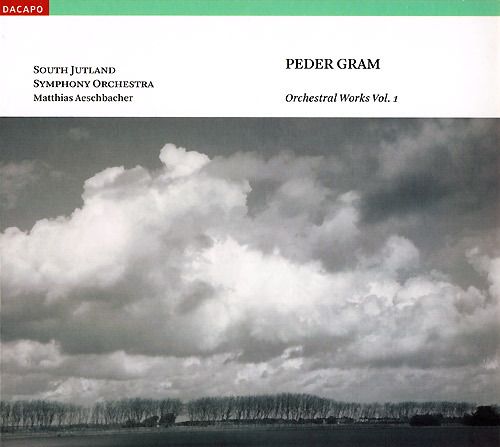
Music Composed by Peder Gram
Played by the South Jutland Symphony Orchestra
Conducted by Matthias Aeschbacher
"Peder Gram is a composer well worth getting to know. His administrative duties as the
guiding spirit behind the establishing of Danish Radio in the first half of the 1900s
prevented him from composing a large body of music, but what he did write is clearly
of high quality. A contemporary of Nielsen, he shares some of his more famous colleague’s
neo-classical leanings: the driving rhythms and effective use of woodwind sonority are
both in evidence, and the two composers share some harmonic quirks that mark their
music as distinctively Danish. Otherwise, Gram goes his own way, both in his love of
instrumental color (he has a particular fondness for the celesta) and in his occasional
recourse, in Po�me Lyrique and the Prologue to a Drama by Shakespeare, to a richer,
more fin-de-si�cle sort of Romantic lushness of texture.
The outstanding item on this disc is the First Symphony, a three-movement piece that’s
melodically very attractive, convincingly structured, and beautifully scored (consider
the effective contributions of the harp, an instrument that Nielsen likened to finding
“a hair in the soup”). The performances are vital and committed, doing the music full
justice, but it’s also true that the strings of the South Jutland Symphony Orchestra sound
thin at times, and the acoustics of the recording venue, a bit dry (if clear), don’t flatter
them. Still, for the sheer quality of the pieces themselves, and for the usefulness of this
disc in rounding out the picture of Danish music in the first decades of the last century,
I have no problem in suggesting that you give Gram a listen."
Classics Today
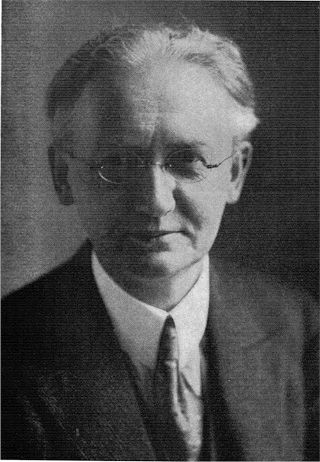
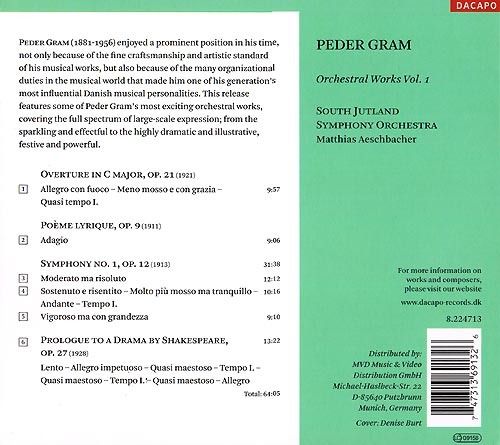
Source: Dacapo CD (my rip!)
Formats: FLAC(RAR), DDD Stereo, mp3(320)
File Sizes: 327 MB / 146 MB (FLAC version incl. covers & booklet)
The FLAC link has now expired. No more requests for this, please!
mp3 version -
https://mega.co.nz/#!SUszDA6S!oijNBew5FVkcRPP5Uo7Icb0JmYo3LyXALgHivqo vLtw
Enjoy! Don't share! Buy the original! And please click on "Like" if you downloaded this album! :)
wimpel69
03-23-2015, 11:01 AM
I have also re-upped the very first album I posted in this thread, Behzad Ranjbaran's The Persian Trilogy,
which was - ironically - the very last depositfiles upload that was deleted.
wimpel69
03-23-2015, 12:31 PM
No.730
The gentle urbane art of Jean Francaix, at once freshly engaging and invariably distinguished
by an unerring sense of style, has endeared itself to successive generations of musicians and music-
lovers. His death in 1997 at the age of 85 removed from contemporary music one of its most
immediately appealing and distinctly Gallic masters. This alluring orchestral music undulates between
the dreamy and the dramatic, exemplifying Francaix's attractive use of sound colour and harmonies.
The Scuola di Ballo, a ballet in one act, is based on music by Boccherini, largely from his quintets.
The Pavane pour un G�nie vivant was written to mark the fiftieth anniversary of Ravel's death, and
the Symphonie was written in Haydn's memory. The S�r�nade has neoclassical overtones,
and the Ouverture anacr�ontique attempts to portray an imaginary world, without wars, in which
all is well. The content therefore is largely retrospective, but remains charismatically original throughout.

Music Composed by Jean Francaix
Played by the Ulster Orchestra
Conducted by Thierry Fischer
"For addicts of Jean Fran�aix’s droll, deadpan and meltingly lyrical work, Hyperion has
delivered again. This round-up covers 50 years of his creative life, starting from the Serenade
which helped get his name around in his precocious early twenties: fully formed Fran�aix
in miniature, with Jacques Ibert the only hint of a precedent for its audacious blend of
refinement and good humour, spiked with character episodes for solo trombone or
folksy violin or reflective bassoon."
BBC Music Magazine
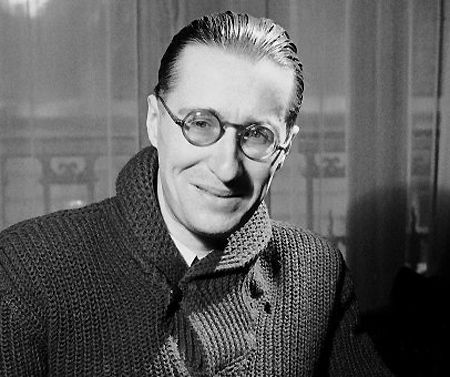
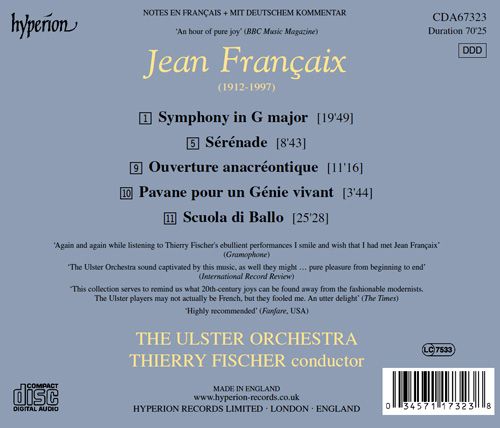
Source: Hyperion Records CD (my rip!)
Formats: FLAC(RAR), DDD Stereo, mp3(320)
File Sizes: 259 MB / 165 MB (FLAC version incl. cover & booklet)
The FLAC link has now expired. No more requests for this, please!
mp3 version -
https://mega.co.nz/#!2N91QKKQ!RyQvChCK6EmYFGQ3M6ozLl_pa3_C8F7tRjnjc0y IFpE
Enjoy! Don't share! Buy the original! And please click on "Like" if you downloaded this album! :)
wimpel69
03-23-2015, 01:55 PM
No.731
Dutch composer Johannes Verhulst (1816-1891) was a prot�g�e of Mendelssohn’s and became
musical director of Leipzig’s popular Euterpe concerts. The success of his compositions led to a
knighthood from King Willem II and the position of Director of the Royal Music. Other prestigious
directorships followed. His influence was tremendous: he familiarised Dutch audiences with the
works of Schumann, Gade and Brahms; he had a great affinity for the music of Beethoven, setting
a new standard for its performance; his international reputation was confirmed with an honorary
membership, together with Liszt, Berlioz and Gade, awarded by London’s Royal Philharmonic Society.
Verhulst’s Symphony in E minor was written in Leipzig in 1841 and achieved lasting popularity
for its warm, colourful orchestration and youthful freshness. The gifts of the young Verhulst emerge
in all three of his concert overtures, which were composed between 1835 and 1839, the years
of his apprenticeship. Verhulst’s music is characteristic of its time and reminiscent of that of
Schumann and Mendelssohn, with whom he was well acquainted.
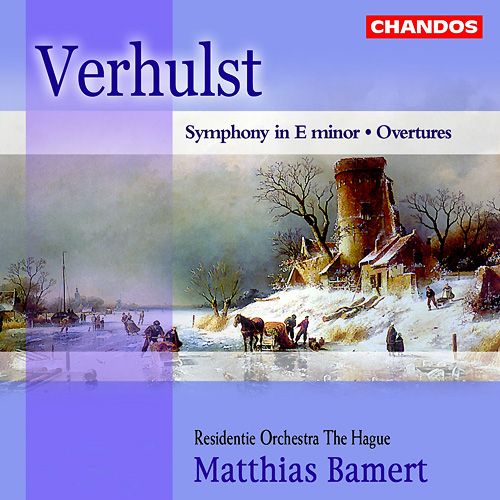
Music Composed by Johannes Verhulst
Played by the Residentie Orchestra The Hague
Conducted by Matthias Bamert
"This is enjoyable and cultivated music and is persuasively performed here, the Residentie
Orchestra responding eagerly to Matthias Bamerts clear-sighted direction and ear for detail.
The recording is excellent, as is Leo Samamas extensive booklet note. One wants now to
explore Chandos previous issue of Verhulst, his Mass setting, Op. 20."
Gramophone
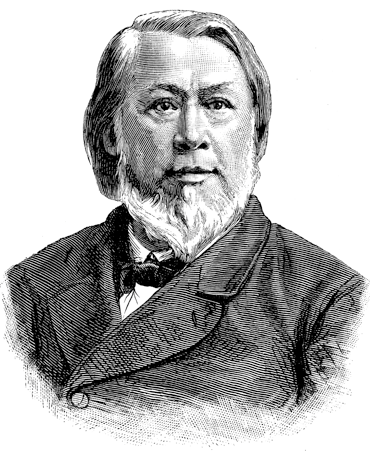
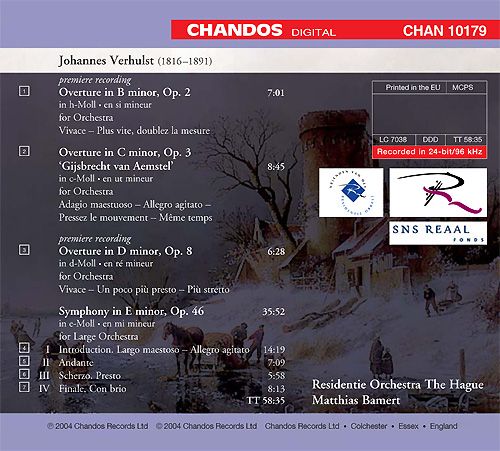
Source: Chandos Records CD (my rip!)
Formats: FLAC(RAR), DDD Stereo, mp3(320)
File Sizes: 263 MB / 135 MB (FLAC version incl. cover & booklet)
The FLAC link has now expired. No more requests for this, please!
mp3 version -
https://mega.co.nz/#!2EkwlI7S!GYu6tR4vKVeatAwZYt6KKLAd4Q59Ui9ijOEraU7 NlLU
Enjoy! Don't share! Buy the original! And please click on "Like" if you downloaded this album! :)
booster-t
03-23-2015, 05:06 PM
At last! Something I already had ... andI agree with wimpel69 .. this is worthy of any collection.
wimpel69
03-25-2015, 10:57 AM
No.732
Bernard Rands (born 2 March 1934) is a British-American composer of contemporary classical music.
Rands was born in Sheffield, England. He studied music and English literature at the University of Wales,
Bangor, and composition with Pierre Boulez and Bruno Maderna in Darmstadt, Germany, and with Luigi
Dallapiccola and Luciano Berio in Milan, Italy. He held residencies at Princeton University, the University
of Illinois, and the University of York before emigrating to the United States in 1975; he became a U.S.
citizen in 1983. In 1984, Rands's Canti del Sole, premiered by Paul Sperry, Zubin Mehta, and the
New York Philharmonic, won the Pulitzer Prize for Music.
Commissioned by Meet the Composer and The Philadelphia Orchestra as part of the former organization's
Orchestra Residencies Program, Canti dell'Eclisse (Songs of the Eclipse) was given its premiere by
the Orchestra with bass soloist Thomas Paul and Conductor Gerard Schwarz on January 28, 1993, at the
Academy of Music in Philadelphia.
The first work Rands wrote expressly for The Philadelphia Orchestra in his capacity as its composer-in-
residence was Ceremonial 3, commissioned by Carnegie Hall in honor of its centennial, and given
its premiere there under Riccardo Muti's baton on March 18, 1991.
Completed in October 1984, each of the two suites of Le Tambourin, which may be performed separately,
consists of three short movements, scored for large orchestra. The musical character of each of the individual
movements was prompted by specific visual characteristics found in certain paintings and drawings by Van Gogh.
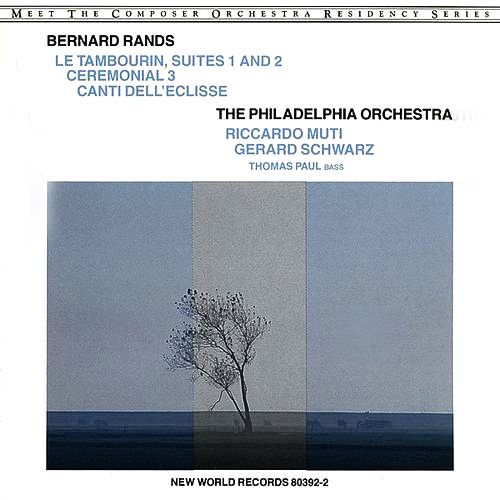
Music Composed by Bernard Rands
Played by The Philadelphia Orchestra
With Thomas Paul (bass )
Conducted by Riccardo Muti & Gerard Schwarz
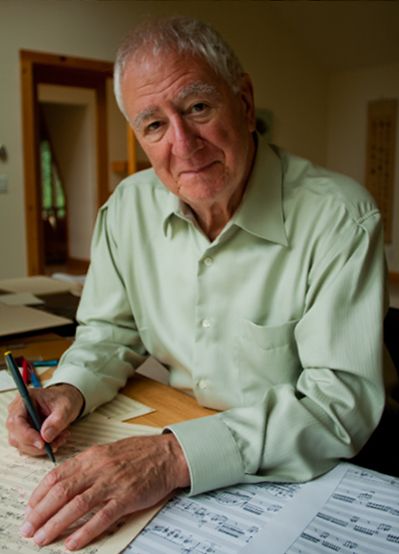
Source: New World Records CD (my rip!)
Formats: FLAC(RAR), DDD Stereo, mp3(320)
File Sizes: 301 MB / 199 MB (FLAC version incl. cover & liner notes)
The FLAC link has now expired. No more requests for this, please!
mp3 version -
https://mega.co.nz/#!6JVmwIDb!Vr7Aq-JRYjJYrKE3mpKMDuJcYYrDPvxTOwDeiw2s-7k
Enjoy! Don't share! Buy the original! And please click on "Like" if you downloaded this album! :)
wimpel69
03-25-2015, 12:00 PM
No.733
American composer James Yannatos (1929-2011) comments on the works on this album:
"I was transfixed by events in Tiananmen Square - excited by the students' quest for (greater) freedom
and appalled by the brutal response by the government. As a musician I felt impelled to speak out in the
only way I could. I spent the summer of 1989 immersed in the rhythms and cadences of Chinese folk tunes from a
collection by Yuen Ren Chao given to me by his daughter, Rulan Chao Pian, my colleague in the music
department. Elements of these tunes were chosen to serve as my musical materials for the six movement
symphony I planned to write. Sketches were made that summer and the work was completed
and orchestrated by January of 1990. The emotions I originally felt - anger, frustration, helplessness,
sadness were transformed during the composition of the piece into a more positive, hopeful, even
joyous vision of what could be - what will be. The tragic elements became a subplot in the drama;
the energy, hope, and vision of the students became the central image. Each movement is a tableau,
self-contained but referential, thematically and emotionally, to the whole.
William Doppmann, who performed the Barber Piano Concerto with the Harvard-
Radcliffe Orchestra in 1988, asked me to write him a Piano Concerto. The only guidelines given were
that it be a substantial piece which would show off the piano in various ways. I started to think
of ways to approach this formidable task in the summer of 1992, started to compose the work in
the fall of 1992, and finished it in the spring of 1993, completing the orchestration that summer.
From the past, the four-movement concerto grosso in which the soloist was also an integral part of the
ensemble served as a loose model. Motivic and thematic elements from a variety of past sources
(Vivaldi, Albinoni, doxology, Mozart) as well as from my own work served as musical material to be
integrated into an expressive and richly associative narrative work."
This is my second Yannatos upload on ffshrine. The first you can find >here< (
http://forums.ffshrine.org/f92/wimpel69-concerto-collection-flac-work-progress-130729/17.html#post2791222).
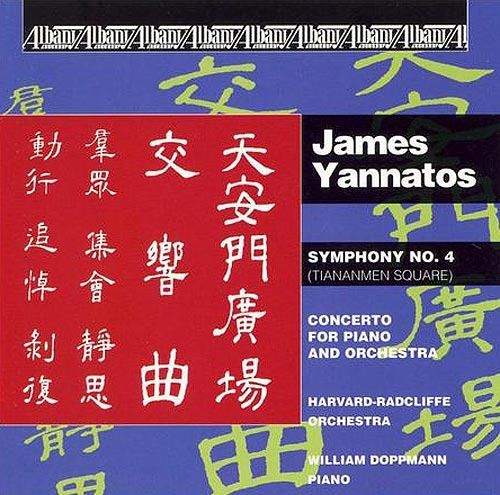
Music Composed and Conducted by James Yannatos
Played by the Harvard-Radcliffe Orchestra
With William Doppmann (piano)
"Albany quickly follows up its well-received CD of James Yannatos's Trinity Mass with
another disc of the composer's music. Yet, while there are many impressive passages in
these two works - especially the symphony - I cannot say that I wholeheartedly urge you
to seek out this CD. The Piano Concerto of 1992-93 is genial, eclectic music that on first
hearing sounded winning and inviting....The Fourth Symphony (1989-90), subtitled
"Tiananmen Square," is another long work but one that I feel is slightly more successful....
For live recordings, the sound is excellent; the audience is dead silent, and the sound is
close and full."
Fanfare

Source: Albany Records CD (my rip!)
Formats: FLAC(RAR), DDD Stereo, mp3(320)
File Sizes: 230 MB / 142 MB (FLAC version incl. cover & liner notes)
The FLAC link has now expired. No more requests for this, please!
mp3 version -
https://mega.co.nz/#!2UVQRYLA!_kmLiRUPRKgn_2YJlBf5jJ7E5WvEA7hmMYDZhso Da3o
Enjoy! Don't share! Buy the original! And please click on "Like" if you downloaded this album! :)
wimpel69
03-26-2015, 10:46 AM
No.734
The CD includes premiere recordings of works by Khachaturian, Gli�re, Prokofiev and Shostakovich.
It also features Rimsky-Korsakov’s popular Trombone Concerto, with the internationally acclaimed
French trombonist Jacques Mauger as soloist. The Royal Northern College of Music Wind Orchestra
performs internationally and is recognised as one of the leading conservatory ensembles in the world. It has
already released several highly enjoyable discs on Chandos, all notable for their energy and brilliance.
The Manchester Prokofiev Symposium of February 2003 included the world premiere performances of several
newly discovered or newly available works by Prokofiev. For example, until very recently, only the first two
marches of Marches for Military Band were available for performance. Prokofiev composed the third
march for a competition but never orchestrated it, which might explain the absence of a title. On the manuscrip
t of the piano score he wrote: ‘If the March is too long or the second trio too difficult, cut the trio out.’ The trio
was only reinstated in this arrangement by Samuel Becker, which also includes the omitted fourth march,
the Cavalry March, making this the first ever recording of the work as conceived by Prokofiev in 1937.
Khachaturian’s The Battle of Stalingrad is another premiere. In the mid-1970s the former music
director of Marlborough College asked Boosey and Hawkes for permission to arrange Khachaturian’s
ballet Gayane. The request eventually made it to Khachaturian himself, who not only granted
permission but sent an autographed score of the wind orchestra setting of the suite from his score
to the film The Battle of Stalingrad.
Works included:
Reinhold Gli�re: Solemn Overture for the 20th Anniversary of the October Revolution
Igor Stravinsky: Circus Polka
Sergei Prokofiev: Four Marches for Military Band, op.59
Nikolai Rimsky-Korsakov: Concerto for Trombone and Wind Band
Dmitri Shostakovich: March of the Soviet Militia, op.139
Sergei Prokofiev: Anthem for Military Band, op.98
Aram Khachaturian: The Battle of Stalingrad Suite, op.74a (Arr. Peel)
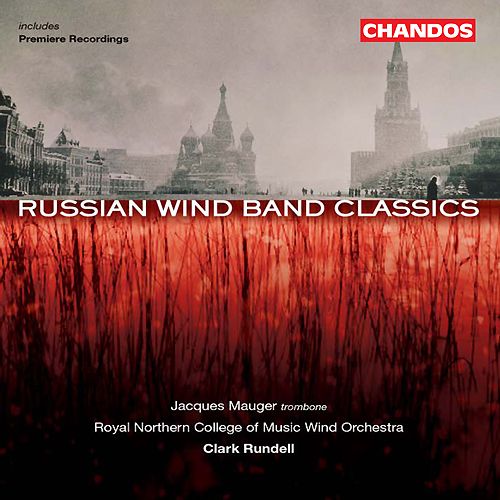
Music by (see above)
Played by the Royal Northern College of Music Wind Orchestra
With Jacques Mauger (trombone)
Conducted by Clark Rundell
"The band sound truly stunning in the best moments of the score, even through the more
hard-driven sections, and on the whole the performances on this disc are highly recommendable.
They possess a more transparent and flexible sound than the Stockholm band under Rozhdestvensky,
and their trademark lightness (especially noteworthy in the percussion) and crisp articulation
give this programme a wonderful shine. If your tolerance for marches and Socialist Realist
music is high enough, this could be an enjoyable excursion after all."
DSCH Journal
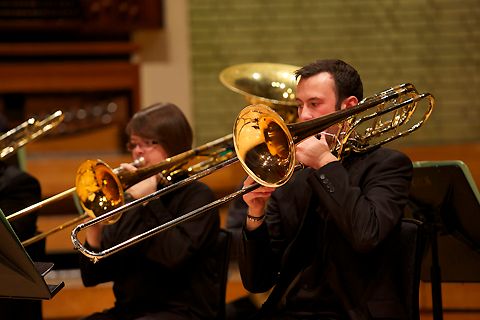
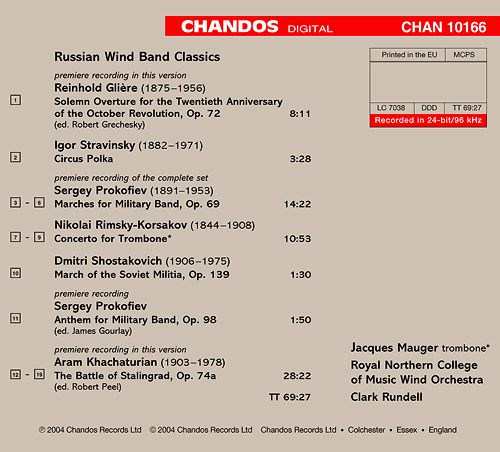
Source: Chandos Records CD (my rip!)
Formats: FLAC(RAR), DDD Stereo, mp3(320)
File Sizes: 281 MB / 159 MB (FLAC version incl. covers & booklet)
The FLAC link has now expired. No more requests for this, please!
mp3 version -
https://mega.co.nz/#!LF011QDY!zV5F7eoMHsR7rF6JqZFG_gJrM29VAauXYWCAk7H OKqI
Enjoy! Don't share! Buy the original! And please click on "Like" if you downloaded this album! :)
jofagobe
03-26-2015, 07:36 PM
wimpel69, thank you very much for all the music you've shared.
I hadn't really listened to classical music outside of some of the classics (such as Beethoven, Mozart, Stravinsky and some others), and your postings have made me appreciate much more of this world.
kumpa
03-26-2015, 09:20 PM
thank you
---------- Post added at 09:20 PM ---------- Previous post was at 08:59 PM ----------
thank you
Inntel
03-26-2015, 09:34 PM
Thank you so much for sharing all this wonderful music. It is rare to see such a variety of modern classical. There's a lot to discover and I very much appreciate you sharing.
wimpel69
03-31-2015, 11:17 AM
No.735
Born in Shanghai, now resident in Greater New York, Ge Gan-Ru is one of
China’s foremost composers. Very different from his previous exploration of the
Western avant-garde, Shanghai Reminiscences is a warm and affecting evocation
of “the street scenes and sounds” of Gan-ru’s childhood in pre-Cultural Revolution
Shanghai, viewed through the lens of his adopted American traditions. Butterfly
Overture is the composer’s symphonic tribute to a beloved teacher from his
Shanghai Conservatory days. International Record Review described Ge Gan-ru’s
string quartets (8.570603) as “Nothing short of contemporary masterpieces”.
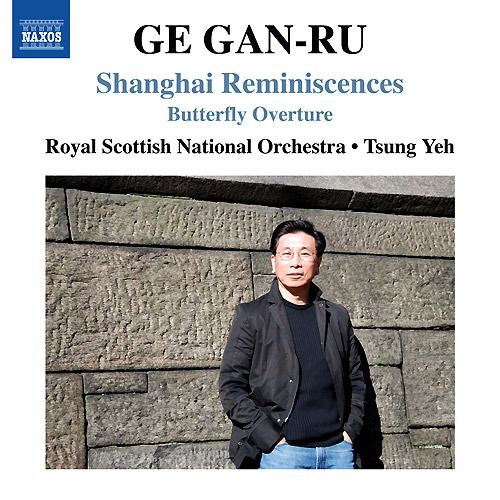
Music Composed by Ge Gan-Ru
Played by the Royal Scottish National Orchestra
Conducted by Tsung Yeh
"Shanghai Reminiscences” shows the major instrumental effort straining to reproduce
a sort of imaginative autobiography in music of Ge Gan-Ru: we listen to the sound
of the first lessons on the violin, the sound of bell bike and the rhythm of pedaling
through to the sounds of the local markets and then the evocation of the Buddhist
temples and proto-military marches. We are in territories far from the frescoes of
Yi Feng, Fu or Fall of Baghdad, but this time the prevalence of western elements
is indispensable to cause the strong state empathy for urban sounds and sounds in
the past of the composer: Ge Gan-Ru has created a kind of “concrete” dialogue
among the instruments, with a powerful glue set towards a revival of classical
and romantic genre (which eventually becomes exotic)."
Percorsi Musicali
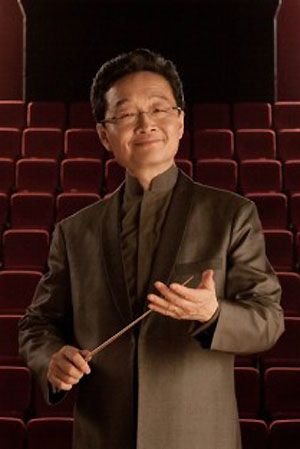
Conductor Tsung Yeh.
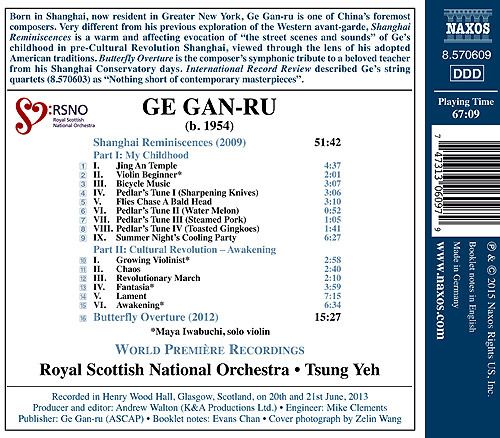
Source: Naxos CD (my rip!)
Formats: FLAC(RAR), DDD Stereo, mp3(320)
File Sizes: 353 MB / 170 MB (FLAC version incl. covers & booklet)
The FLAC link has now expired. No more requests for this, please!
mp3 version -
https://mega.co.nz/#!CMklBZSB!_MsigMVStS4Nb9_bpS84hjUyts0g57MDriqNgWp zqFg
Enjoy! Don't share! Buy the original! And please click on "Like" if you downloaded this album! :)
wimpel69
04-01-2015, 12:30 PM
No.736
During the 1940s, American composer Hubert Klyne Headley (1906-1995) became internationally known
as a composer, concert pianist, and conductor. Given the former popularity of Headley’s music – Howard Hanson
described the California Suite as a “brilliant score” – and its immediate emotional accessibility, its
disappearance from the concert hall is to be greatly regretted. Throughout all of Headley’s compositions one
can sense beneath the veneer of romantic impressionism an undercurrent of greater depths that leads the
listener to, as Headley himself put it, “The way I have always felt inside.” A fitting tribute to a uniquely
talented American composer, this recording of four major works brings Headley’s music back from
undeserved obscurity.
Headley's d�but composition for the American concert repertoire was his California Suite, commissioned
by the Standard Oil Company for the 1939 opening of the Golden Gate Exposition in San Francisco. There
were many performances over the next decade. Pierre Monteux referred to Headley as "one of our best
California composers". Headley's music in general moves through smoothly linked series of emotionally
charged episodes rather than traditional movements. Especially notable is his dynamic use of the brass
choir, emerging already in "Golden Gate" from the California Suite, and reaching a high point in
the Symphony No.1 for Radio (1946). "Golden Gate" yields an impressionistic depiction of the
sights and sounds of San Francisco : the haunting calls of foghorns in the Bay, the ships, the celebrations
and the martial history. In Yosemite Headley invokes the peace and grandeur of California's famed
"Yosemite Valley," punctuated by a magnificent extended fanfare suggesting the emotional impact of
the great granite cliffs and domes. The final movement, "Fiesta," celebrates the festive life of the
State's varied cultural heritage.
The Piano Concerto No.1, subtitled "Argentango," was written under a grant from
Mrs Edward MacDowell and had its premi�re in 1941 on The Standard Hour with Henry Svederovsky
conducting. In 1942 Jos� Iturbi performed and conducted the work with the Rochester Philharmonic
in New York. Iturbi wrote "I can only express a very high opinion of the composer". After the fierce
rhythmic drive of "Argentango," the Second Piano Concerto marks a distinct change. By 1945
Headley was moving into an intensely personal style. According to Headley's wife Constance, the
composer dedicated the second concerto to the suffering and triumphs of oppressed peoples.
Here we now find deep spirituality, interrupted but not overcome by passages of severe conflict.
At one stunning moment the piano seems to battle with the brass section, bringing the music
to a momentary halt. The concerto ends with a triumphant affirmation of the
opening "spiritual" theme.
With the Symphony No.1 for Radio (1946) Headley reached a point of creative expression
truly symphonic in its intimations of pathos, tenderness, and grandeur. It is a remarkable score,
featuring solo instruments at times, and using the piano as a member of the orchestra alternately
with the harp. Comparisons are perhaps inappropriate for such an individualistic work, yet one
tends to hear the influence of the lean, wiry, economical orchestration of Sibelius combined
with the expansiveness of a Carl Nielsen.
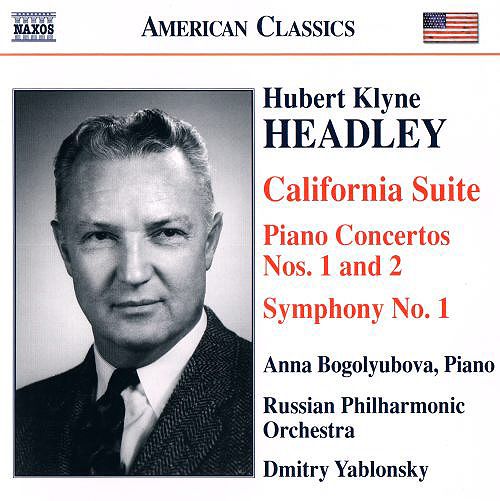
Music Composed by Hubert Klyne Headley
Played by the Russian Philharmonic Orchestra
With Anna Bogolyubova (piano)
Conducted by Dmitry Yablonsky
"This is really fun. Hubert Headley (1906–95) is a composer in the tradition of Gershwin,
Still, Gillis, and Moross—that is, stylish, pop-influenced (’30s and ’40s), and well-crafted.
Howard Hanson and Pierre Monteux had nice things to say about the colorful and extremely
enjoyable California Suite, and during the 1940s it enjoyed a measure of popularity. Similarly,
the concertos are brilliantly scored and full of good ideas. Both are single-movement works
lasting a mere 11 and 15 minutes, respectively. The First Symphony (1946) requires just
13 minutes, and it’s likewise colorful and cogent. Certainly there is no reason why this
music should not become popular again; likely it faded from view because Headley
essentially gave up symphonic composition after the 1940s in favor of large-scale choral
music, but then so much good tonal music vanished after the "serial interruption" that
began in the 1950s. The performances here are consistently exciting, with Anna
Bogolyubova a confident soloist in the two concertos, and Dmitry Yablonsky leading
an orchestra that sounds like it’s having a remarkably good time. You will too."
Classics Today

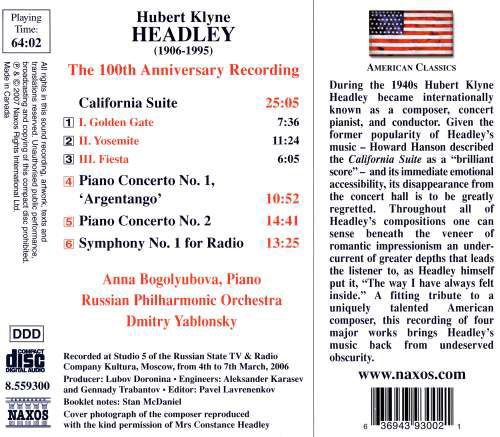
Source: Naxos CD (my rip!)
Formats: FLAC(RAR), DDD Stereo, mp3(320)
File Sizes: 272 MB / 145 MB (FLAC version incl. covers & booklet)
The FLAC link has now expired. No more requests for this, please!
mp3 version -
https://mega.co.nz/#!bRsATTYR!lIEHI8FErj5YrMkPC7NGv-OrnixHyjJQltucTQYWjOg
Enjoy! Don't share! Buy the original! And please click on "Like" if you downloaded this album! :)
wimpel69
04-01-2015, 05:40 PM
No.737
Edward MacDowell's orchestral music has been shamefully neglected by record companies, so it's
exciting that, as part of an ongoing relationship with the Library of Congress, Bridge Records has
gained access to the famous "Society for the Preservation of the American Musical Heritage" series of
recordings of these and other little-known pieces by American composers. There's nothing especially
"American" about MacDowell's music (except perhaps some of the tunes in his "Indian" Suite, not included
here). Rather, the influence is Liszt, especially in the tone poems. Actually, compared to his model,
MacDowell's orchestration is superior, as is much of his melodic invention. These performances date back
to 1966, and have been very well remastered for this release.
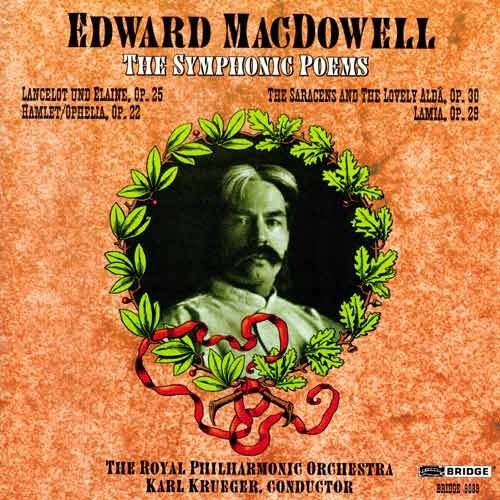
Music Composed by Edward MacDowell
Played by the Royal Philharmonic Orchestra
Conducted by Karl Krueger
"These are not brand new recordings. It's okay, because you can't tell it. Karl Kreuger leads
spirited and atmospheric performances. MacDowell can come across turgid at times, but these
performances don't. The pieces are well played and capture the varied moods involved. The
"two fragments from Song of Roland" - Saracens and Lovely Alda - are short and easy
listening, a little bigger than the miniatures MacDowell does so well, but still impressive.
Hamlet/Ophelia (opus 22, is a great pairing. The pieces don't represent specific scenes
from Shakespeare, but more aspects of the characters involved. "Lancelot and Elaine"
(based on Mallory, of course), and Lamia are of greater consequence. They are wonderfully
evocative pieces. For style, think something between Liszt and Tchaikovsky, with a little
Sibelius thrown in. The repertoire may not be well known, but here it sounds like major music."
Amazon Reviewer
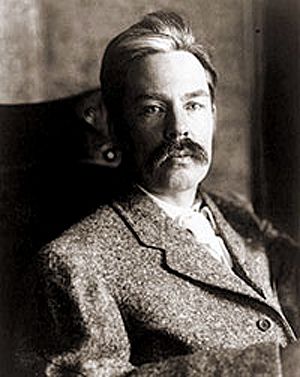
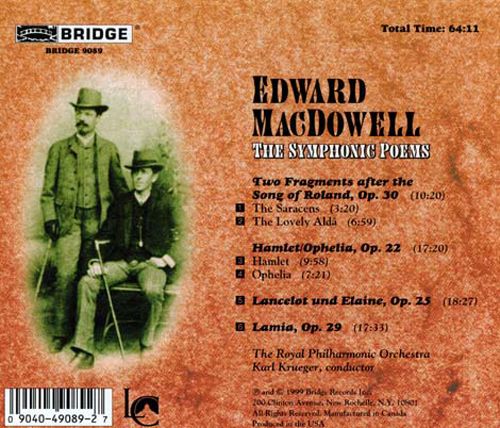
Source: Guild Records CD (my rip!)
Formats: FLAC(RAR), ADD Stereo, mp3(320)
File Sizes: 330 MB / 146 MB (FLAC version incl. covers & booklet)
The FLAC link has now expired. No more requests for this, please!
mp3 version -
https://mega.co.nz/#!fF1lVCCb!HBP0UROmMzrNVm26hwVbiYYOjRmW_er0BwvitRj MlG0
Enjoy! Don't share! Buy the original! And please click on "Like" if you downloaded this album! :)
booster-t
04-01-2015, 10:08 PM
I recommend the MacDowell and Headley CDs ... very listenable.
wimpel69
04-02-2015, 09:29 AM
No.738
Ottorino Respighi’s Sinfonia drammatica (1914) is a work of ambitious proportions:
epic in scale, it lasts just oven an hour, the first movement alone taking 25 minutes. Yet it
proves rich in incident and lavish in its orchestral colours and virtuosity; even if it is not organic
in conception or symphonic in the classical sense, it is an immensely worthwhile addition to the
catalogue. If you enjoy Richard Strauss' An Alpine Symphony, you should try this.
Although it was written almost immediately before the famous "Fountains of Rome," which
later became part of the Roman Trilogy (You can find it >here< (
http://forums.ffshrine.org/f92/wimpel69s-could-film-music-classical-corner-work-121898/#post2183595), together with another
attractive Respighi album), this is an unruly and gargantuan work in three movements
beginning with a 25-minute opener. The composition is diffuse and unruly in form, too easily
losing the thread of symphonic argument. There are some tremendously exciting and
effective things in it. It tends towards massive statements at the high points.
The performance under the late Edward Downes is easily the best available.
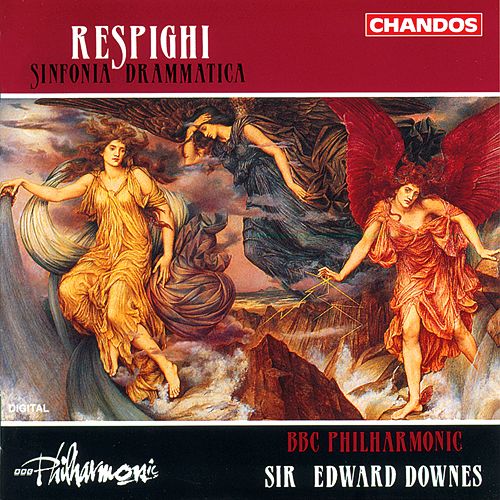
Music Composed by Ottorino Respighi
Played by the BBC Philharmonic Orchestra
Conducted by Sir Edward Downes
"This latest recording of Respighi's Sinfonia drammatica (the third so far) is by a long
way the best, and the consequence is that the work has never sounded more convincing.
Of course Respighi doesn't so much reveal his influences as flaunt them: there are
some moments which might almost be by Franck or Strauss, Rimsky-Korsakov or
Scriabin, until you try to locate where Respighi borrowed them from. Nor does he
make many bones about liking his own first movement so much that on finishing
his development section he launches with unabated vigour into another. In the
slow movement he's similarly so pleased with his adaptation of Franck's cyclic
principle that you're almost surprised when he stops. Only in the finale does his
ingenuity fail to disguise the fact that at one or two moments he hasn't much
idea of what to do next.
I have not felt like this about the work before, and I attribute it to Sir Edward
Downes's knack for jolting you into thinking again about pieces that are easy
to patronize. This is a stunning performance, intensely responsive to the work's
emotional core; it is most magnificently played and sumptuously recorded, and
has such conviction to it that the indulgent smile (''poor old Respighi!
Pretending to be a symphonist!'') is quite often wiped from one's face.'"
Gramophone
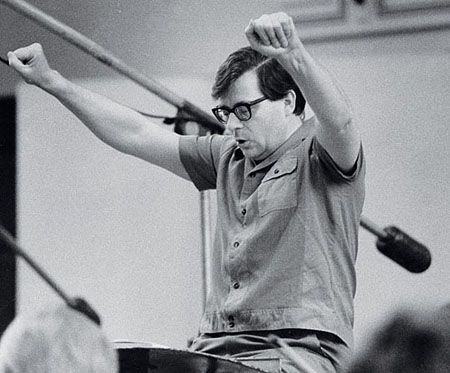
Edward Downes (1924-2009).
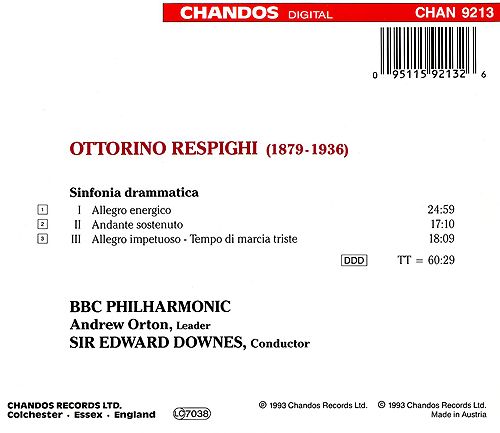
Source: Chandos Records CD (my rip!)
Formats: FLAC(RAR), ADD Stereo, mp3(320)
File Sizes: 228 MB / 147 MB (FLAC version incl. cover & booklet)
The FLAC link has now expired. No more requests for this, please!
mp3 version -
https://mega.co.nz/#!rF0CQT5B!N4OL6uLCBEfxcsVlyHyPOYnHDkPqyRkN3Mz_YY-u4Yw
Enjoy! Don't share! Buy the original! And please click on "Like" if you downloaded this album! :)
wimpel69
04-03-2015, 10:36 AM
No.739
During World War I Manuel de Falla (1876-1944) wrote a pantomime ballet in two scenes and called
it The Magistrate and the Miller's Wife (El corregidor y la molinera). The work was scored for a small
chamber orchestra and was first performed in 1917. Sergei Diaghilev of the Ballets Russes, saw the premiere
of El corregidor y la molinera and commissioned Falla to rewrite it. The outcome was a two-act ballet
scored for large orchestra called The Three-Cornered Hat (El sombrero de tres picos). This was first
performed in London at the Alhambra Theatre on 22 July 1919. The original version is scored for chamber
orchestra, but the basic story is the same: a magistrate infatuated with a miller's faithful wife attempts
to seduce her – derives from the novella by Pedro Antonio de Alarc�n.
Federico Garcia Lorca (1898-1936) was a Spanish poet, playwright, and theatre director. Garc�a Lorca
achieved international recognition as an emblematic member of the Generation of '27. He was executed
by Nationalist forces during the Spanish Civil War. Garcia Lorca was also a trained musician who set
his own Canciones Espanolas to music. The adaptations for chamber orchestra on this album were
provided by several musicians, including the conductor, Josep Pons.
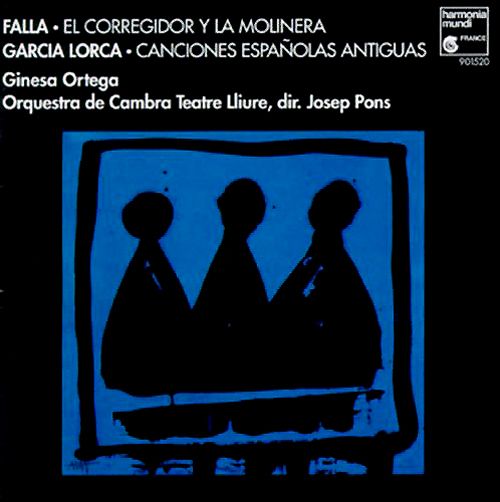
Music by Manuel de Falla & Federico Garcia Lorca
Played by the Orquestra de Cambra Teatre Lliure
With Ginesa Ortega (singer)
Conducted by Josep Pons
"This is a fascinating entry in Harmonia Mundi's series devoted to Falla, embracing the composer's
well-known works as well as a number of rarities. El corregidor y la muliner� (The Magistrate
and the Miller's Wife) is actually both, that is, it is the rarely heard first version of The Three-
Cornered Hat. The work dates from 1916 and is scored for a chamber orchestra of seventeen
instruments. This early version was written for pantomime rather than ballet and contains a
fairly large amount of music which simply underscores the plot. There is a roughness to the
orchestration that is quite attractive and occasionally even more fresh and inventive than the
setting for full orchestra. It is an enjoyable work, and those who know the later version well
will probably find a comparison of the two quite interesting.
The disc also contains eleven Spanish folk songs listed as being by Federico Garcia Lorca.
The great writer was, along with Falla, fascinated by Spanish folk songs and these are drawn
from those which he collected. The chamber orchestrations are by a number of different
arrangers including conductor Pons. All of the arrangements are colorful and adept and
some are quite striking, but none is as colorful or striking as the singer on this recording,
Gisela Ortega. Hers is in no way a pretty voice: it shouts, barks, vibrates, and moves
with great ease between the raucous and the gravelly. She is, in short, perfect for these
songs, bringing, at least to my ears, a ferocious authenticity."
Fanfare
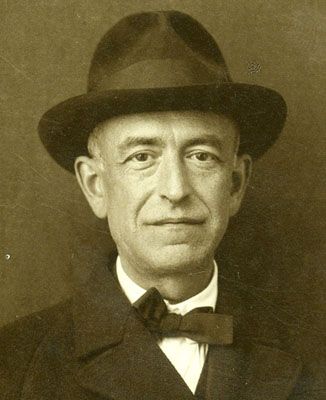
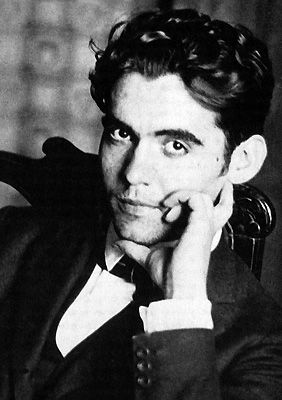
Source: Harmonia Mundi CD (my rip!)
Formats: FLAC(RAR), ADD Stereo, mp3(320)
File Sizes: 312 MB / 168 MB
The FLAC link has now expired. No more requests for this, please!
mp3 version -
https://mega.co.nz/#!uZknDAoR!nH9xxiHjZYKGgcNNBrJVXQemGTmRbkm17PAUni0 3hZc
Enjoy! Don't share! Buy the original! And please click on "Like" if you downloaded this album! :)
wimpel69
04-06-2015, 03:25 PM
No.740
The complete incidental music for William Shakespeare's The Merchant of Venice recorded here
for the first time. Aldo Ceccato conducts the Orquesta Filarm�nica de M�laga in a brilliant score
by the legendary Italian conductor Victor De Sabata. Although he was a composer and a violinist and
pianist of virtuoso caliber, De Sabata (1892-1967, born Vittorio) was best known as one of the world's leading
conductors, particularly of Italian opera. He studied at the Milan Conservatory, with counterpoint lessons
from Michele Saladino and composition from Giacomo Orefice. He earned his diploma with a Suite for
Orchestra. During the first few years of his career his concentrated on composition. His opera
Il macigno (The Rock) was premiered at La Scala in 1917 and was frequently played during the
next few years. Arturo Toscanini (who frequently performed de Sabata's tone poem Juventus of 1919)
encouraged de Sabata to consider a conducting career. He began to conduct in 1918, but continued
composing as his conducting career gathered steam. He wrote several other orchestral works, mainly
with an intriguing mixture of Romantic-era Italian lyricism and dramatic episodes - like this Shakespeare
score for choir and orchestra.
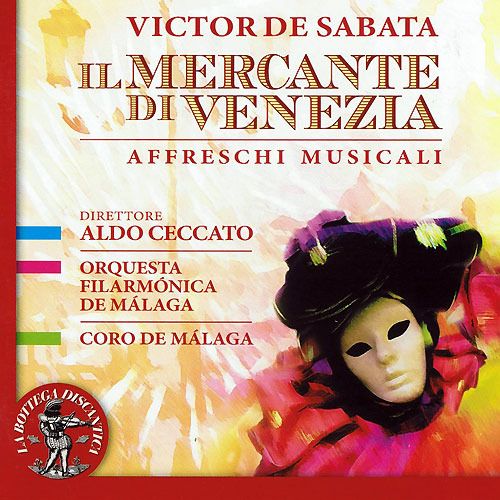
Music by Victor de Sabata
Played by the Orquesta Filarm�nica de M�laga
With the Coro de M�laga
Conducted by Aldo Ceccato
"Italian conductor Victor de Sabata (1892-1967) is best remembered today for
recording a classic account of Tosca with Maria Callas in 1953. He was also a
composer and collaborated with the German director Max Reinhardt on a spectacular
production of The Merchant of Venice in Venice in 1934. It’s a glorious, eclectic
mishmash of a score, with lush swathes of late-Romantic slush enlivened by passages
of astonishing, quirky invention. Hypnotic tolling bell sounds, unaccompanied choruses,
laughing trombone glissandi and harpsichord all feature. There’s a lovely use of
mandolins in an early scene, predating their appearance in Prokofiev’s Romeo and
Juliet, and an exquisite love scene played out on chiming celeste, glockenspiel and harp.
Things never become too kitsch, and de Sabata cunningly spices up his late-Romantic
palate with dissonant brass fanfares and aggressive, strident chorus writing. It’s all
wonderfully enjoyable, despite a production which slightly overdoes the sound effects.
Persuasive performance, too, from the youthful Mal�ga orchestra under Aldo Ceccato."
The Arts Desk
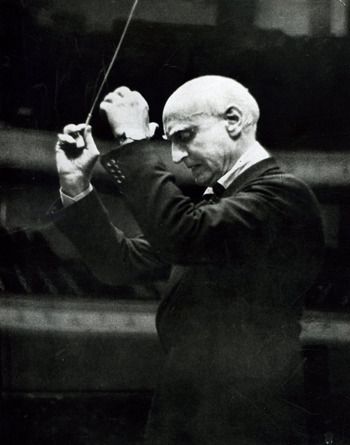
Source: Il Bottega Discantica CD (my rip!)
Formats: FLAC(RAR), ADD Stereo, mp3(320)
File Sizes: 234 MB / 135 MB (FLAC version incl. cover & composer bio)
The FLAC link has now expired. No more requests for this, please!
mp3 version -
https://mega.co.nz/#!DA9VHC4I!0ruJOQWrOAY9WDp0X1RxXgUrnKUlR8wZQ9Zy-iLlueo
Enjoy! Don't share! Buy the original! And please click on "Like" if you downloaded this album! :)
bohuslav
04-06-2015, 04:28 PM
Fantastic, many thanks. Have we the Hyperion CD
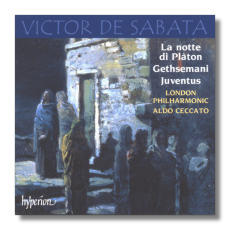
in this Forum? Its very nice too.
wimpel69
04-06-2015, 05:04 PM
Fantastic, many thanks. Have we the Hyperion CD in this forum too? Its very nice too.
Indeed it is:
http://forums.ffshrine.org/f92/wimpel69s-could-film-music-classical-corner-work-121898/4.html#post2195758
The FLAC links for posts Nos. 711-720 have now expired. No more requests for these, please!
wimpel69
04-07-2015, 10:53 AM
No.741
"The Circus Maximus of ancient Rome was a real place. The largest arena in the world, it entertained
over 300,000 spectators daily for nearly a thousand years. Chariot races, hunts and battles satisfied the
Roman public’s need for grander and wilder amusement as the Empire declined. The parallels between the
high decadence of Rome and our present time are obvious. Entertainment dominates our culture, and ever-
more-extreme ‘reality’ shows dominate our entertainment. Many of us have become as bemused by the
violence and humiliation that flood the 500-plus channels of our television screens as those mobs of imperial
Rome who considered the devouring of human beings by starving lions just another Sunday show. The
shape of Circus Maximus was built both to embody and comment on this massive and glamorous barbarity."
John Corigliano on his Symphony No.3, "Circus Maximus."
"Gazebo Dances was originally written as a set of fourhand pieces dedicated to certain of my pianist
friends. I later arranged the suite for orchestra and for concert band, and it is from the latter version
that the title is drawn. The title Gazebo Dances was suggested by the pavilions often seen on village
greens in towns throughout the American countryside, where public band concerts were given on summer
evenings early last century. The delights of that sort of entertainment are portrayed in this set of dances."
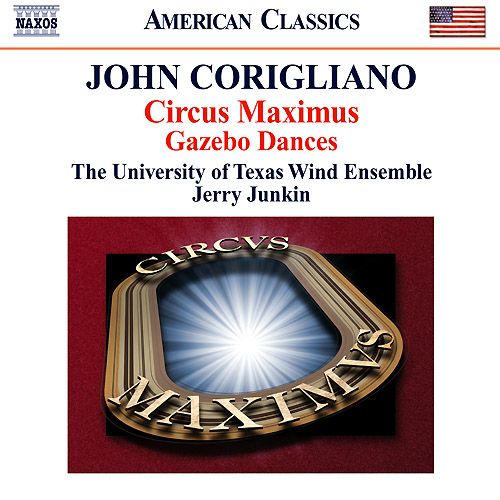
Music Composed by John Corigliano
Played by the University of Texas Wind Ensemble
Conducted by Jerry Junkin
"Full of fanfares, sound effects, and a band marching up and down the aisles, this music, like
Leonard Bernstein’s Mass, simply must have surround sound to be fully effective. The music is a
vision of Circus Maximus, where the Romans held chariot races and allowed humans to be
devoured by lions. “Just another Sunday show,” writes Corigliano in his program notes. Logistically
the piece involves a stage band, a surround band, and a marching band. The locations of these
and other instruments, such as the saxophone quartet and bass that are heard in the second
movement, “Screen/siren,” are provided on a chart laid out with clarity in the notes. Exotic
percussion instruments are the norm, and the work ends with a resounding gunshot. Being
surrounded by this immersive music is a lot of fun, and it’s a darned good demonstration piece
for your surround system. Be warned that the dynamic range of the recording is very wide:
hushed passages are barely audible, while the louder ones are of the lease-breaking variety.
Junkin’s readings are alert and precise, and he brings a sense of lyricism to the more melodic
Gazebo Dances that round out the disc."
Soundstage
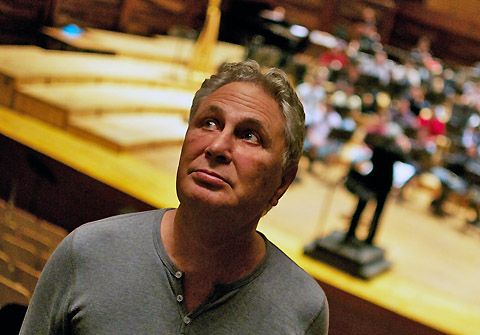
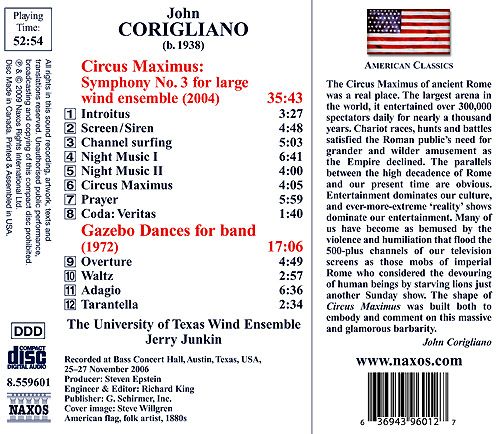
Source: Naxos CD (my rip!)
Formats: FLAC(RAR), ADD Stereo, mp3(320)
File Sizes: 202 MB / 126 MB (FLAC version incl. cover & booklet)
The FLAC link has now expired. No more requests for this, please!
mp3 version -
https://mega.co.nz/#!vdMX1JIS!6EzTeHWPsiHB17BZRfbLCb4JobV_S07CS6XsGDQ HHvk
Enjoy! Don't share! Buy the original! And please click on "Like" if you downloaded this album! :)
wimpel69
04-09-2015, 10:11 AM
No.742
The Dutton Epoch release of two substantial works for soloists and chamber orchestra, plus a major work for large
chamber group, brings the tally of John McCabe CDs so far for that year to three. John McCabe's innate sympathy
with the natural world stretches, in this CD, from high summer in England, via the deserts of Arabia, to the majestic
mysteries of the sub-tropical rainforests of Australia, with their buzzing insects and strange birdcalls. Les Martinets noirs
is the French name for swifts. McCabe describes them as "acrobatic Pucks of the air," adding that one of his annual
delights in summer is to watch them wheeling about in the stratosphere, and then swooping down around trees and
chimney pots. The swifts' screaming call, like children at a fairground, seems to suggest sheer joy in movement, and
it is a sad moment when summer begins to wane and one looks into the sky for the swifts only to find they are there
no more. Violin duo Retorica (Harriet Mackenzie and Philippa Mo) excel as the acrobatic swifts, while Angela
Whelan personifies the spirit of the rainforest in Rainforest II. In Rainforest I, a brilliant chamber group is
joined by John McCabe on piano in a large-scale work redolent of the sights and sounds of the rainforests of Queensland.
The CD is rounded off with the short string orchestra work, Caravan, inspired by the sight of a caravan approaching
in the Arabian desert.

Music Composed by John McCabe
Played by the Orchestra Nova of London
With "Retorica" & Angela Whelan (trumpet)
Conducted by George Vass
"Among John McCabe’s catalogue of concertos are several double concertos, the most recent
being Les martinets noirs (‘Swifts’, 2003), a helter-skelter three-in-one design for two
violins and strings inspired by these ‘Pucks of the air’ (to quote McCabe). Under George
Vass’s strong direction, the fine violin duo Retorica deliver a measured account, two minutes
longer than the Amsterdam Sinfonietta’s first performances but with no want of excitement
or virtuosity.
McCabe’s many admirers will welcome this release especially for providing – astonishingly –
the premiere recordings of the first two of his Rainforest series. The First (1984) is scored
for overlapping ensembles of string quartet, piano trio (with McCabe himself at the keyboard)
and a second trio of flute, clarinet and glockenspiel, which weave beguiling musical
developments and variations on the main material. Rainforest II (2007) is a gripping 23-
minute trumpet concerto in mostly moderate tempi. Angela Whelan is the commanding
and nimble-lipped soloist.
Orchestra Nova close out the disc alone with Caravan (2011), one of McCabe’s ‘Desert’
pieces, originally a single-span quartet movement for the Gabrieli’s 20th anniversary.
McCabe’s arrangement for the fuller body adds considerably to its dynamic depth of field,
opening at the edge of sight/hearing, closing in the full glare of the sun as the desert
train passes by. Dutton’s superb recording does the music full justice, as do the
performances, ably directed throughout by one of McCabe’s staunchest champions
of recent years. I hope Dutton explores the other concertos – such as the magnificent
Third for piano, one of the finest written by a British composer – and symphonies.
Until then, buy this disc to hear another side of one of the most purposeful and
original voices in British music."
Gramophone
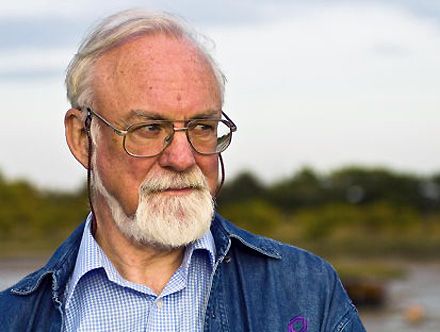
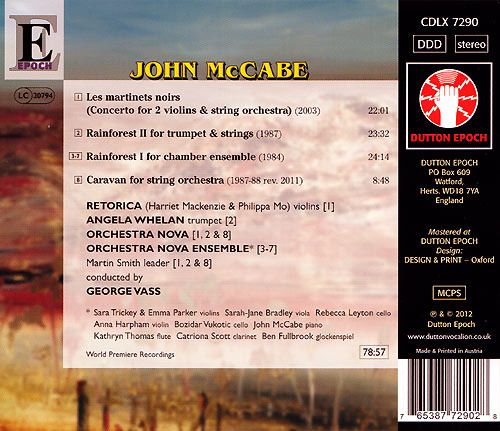
Source: Dutton Epoch CD (my rip!)
Formats: FLAC(RAR), ADD Stereo, mp3(320)
File Sizes: 400 MB / 181 MB (FLAC version incl. cover & booklet)
The FLAC link has now expired. No more requests for this, please!
mp3 version -
https://mega.co.nz/#!zdlXnICb!KkwXNRkeOtKedAfV-l7QvCTvdGCeXh-SDkQOta3vyXw
Enjoy! Don't share! Buy the original! And please click on "Like" if you downloaded this album! :)
wimpel69
04-12-2015, 05:57 PM
No.743
Walter Braunfels, who died in 1954, was one of the great twentieth-century
German composers who were temporarily eclipsed by the Nazi era and the 1950s
avant-garde. This second volume in Dutton Epoch’s survey of Braunfels’ memorable
orchestral music spans from his luxuriant early Symphonic Variations on a
French Children’s Song to the utterly delightful orchestral suite
The Glass Mountain (Der Gl�serne Berg) and the powerfully satisfying
Sinfonia Brevis.
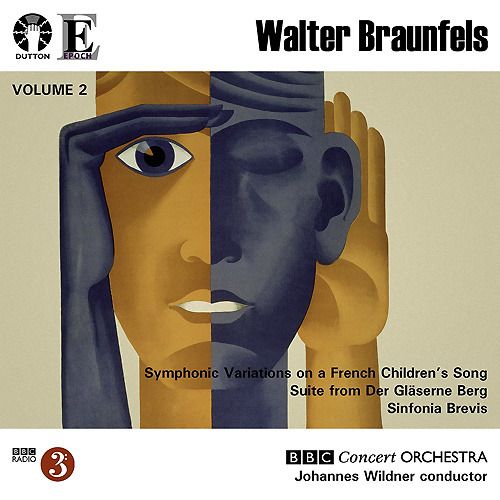
Music Composed by Walter Braunfels
Played by the BBC Concert Orchestra
Conducted by Johannes Wildner
"Walter Braunfels was one of those all-too-ubiquitous figures in the German musical world of the 1920s and
early '30s, who -- through no fault of his, and even less of his music -- managed to go from the center of
the musical world to near-complete-obscurity as a composer. And that obscurity lingered for decades after
his death in 1954, until the end of the twentieth century, when he was belatedly rediscovered. He was
born in Frankfurt in 1882, to a wealthy and artistically prominent family, and his mother, a great-niece
of Louis Spohr, was his first music teacher. He later studied at the Hoch Conservatory in Frankfurt,
although music had to compete with law and economics -- which he studied in Munich -- during his
late teen years. It was a performance of Richard Wagner's Tristan und Isolde, conducted by Felix Mottl,
that pushed him to cast his career lot with music. He studied piano with Theodor Leschetizky in Vienna,
and composition in Munich with Mottl and Ludwig Thuille. The strongest influence on his work, among
major established composers, was Berlioz, whose concert and stage works he saw performed, mostly
courtesy of Mottl. In terms of the practical life of a musician, Braunfels' piano skills were more than
sufficient to keep him as fully employed as he wished or needed, from the teens onward, but he was
active in other areas of music, as well. As a composer, Braunfels achieved some considerable prominence
in Germany in the immediate post-World War I era, where his music -- boldly experimental in key
respects, yet melodic and accessible enough to hold the listeners of the prior generation -- attracted
critical acclaim and an enthusiastic audience. His greatest success was his opera Die V�gel (1920),
based on Aristophanes' The Birds, which Alfred Einstein compared, following its Munich premiere
(conducted by Bruno Walter) to Pfitzner's Palestrina and Wagner's Meistersinger. His second opera,
Don Gil von der grunen hosen, dating from 1924, was also a success and saw numerous productions
in the German-speaking world of the 1920s following its premiere under Hans Knappertsbusch.
And his Te Deum, presented in Cologne, inspired the invitation of the city's mayor, Konrad Adenauer,
the establish the Academy of Music in that city in collaboration with Hermann Abendroth."
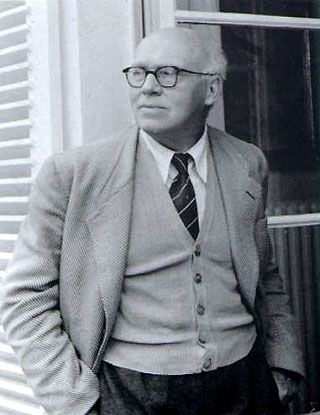
Source: Dutton Epoch CD (my rip!)
Formats: FLAC(RAR), DDD Stereo, mp3(320)
File Sizes: 319 MB / 178 MB (FLAC version incl. cover & booklet)
The FLAC link has now expired. No more requests for this, please!
mp3 version -
https://mega.co.nz/#!6V8SCQYJ!qVE_kKIBa-Hj0K_kAO3r-8WLsfzPlCjWFo9CW8pjfHw
Enjoy! Don't share! Buy the original! And please click on "Like" if you downloaded this album! :)
bohuslav
04-12-2015, 06:27 PM
Wonderful share, more of Braunfels please. Many thanks wimpel69.
booster-t
04-12-2015, 07:32 PM
I echo bouslav ... this is very nice music
wimpel69
04-13-2015, 01:20 PM
No.744
A native of Huang County, Shandong Province, Wang Yun-Jie (1911-1996) was a famous Chinese composer.
When he was young he successively studied the piano and composition at Shanghai Xinhua School of Arts, Music
Department of University of Humane Arts, and Shanghai School of Music. As a member of Haixing Singing Ensemble
led by the prominent composer Xian Xinghai, he once devoted himself to the composition of songs appealing for
national salvation. In 1947 he joined Shanghai Kunlun Film Studio and transferred to film scoring. After the founding
of the People's Republic of China, he began to work at Music Office of China Central Film Bureau. In 1955 he was
transferred to Shanghai Film Studio as a scorer. His main works include two symphonies, string quintet Prelude and
Fugue, and over forty film scores.
Composed in celebration of the tenth anniversary of the rounding of the People's Republic of China, the symphony
The Anti-Japanese War vividly expresses the touching scenes of the Chinese people striving for the victory of
the War of Resistance against Japan (1937-1945) - as the title suggests ever so subtly. This is agit prop music of the
very first degree, and entirely characteristic of Mao-era propagandistic symphonic music.
With symphonic techniques, Capriccio on a Xinjiang Folk Theme lays stress on the expression of the unity of
the different nationalities of Xinjian, an autonomous region of the minority nationalities in northwest China, as
members of the great family of Chinese nationalities. Besides, the music also expresses their pursuit for the future
and for minority nationalities in northwest China, as members of the great family of Chinese nationalities.

Music Composed by Wang Yun-Yie
Played by the Shanghai Philharmonic Orchestra
Conducted by Cao Peng
"Cao Peng is one of the most distinguished conductors in China. He was born in Jiangyin, Jiangsu in 1925.
In 1946, he entered the Arts Department of Shandong University. In 1950 he was principal conductor
of both the Shanghai Film Studio Orchestra and the Beijing Film Studio Orchestra. In 1955, he went to
Russia to study at the Moscow Tchaikovsky Conservatory under the celebrated conductor Leo Ginsberg.
Cao Peng was appointed resident conductor of the Shanghai Symphony Orchestra after his return in
1961. He is now artistic director and principal conductor of the Shanghai Philharmonic Orchestra,
artistic director of the Marco Polo Symphony Orchestra, music advisor and resident conductor of the
Shanghai Symphony Orchestra, and music director and principal conductor of the Shanghai Chamber
Orchestra."


Source: Marco Polo "Yellow River" CD (my rip!)
Formats: FLAC(RAR), DDD Stereo, mp3(320)
File Sizes: 259 MB / 136 MB (FLAC version incl. cover & liner notes)
The FLAC link has now expired. No more requests for this, please!
mp3 version -
https://mega.co.nz/#!HZFklJyJ!ry4FA4CUOGbrwsOMLCzLWPjQ8wz1p5HmlM6h1yW 20aw
Enjoy! Don't share! Buy the original! And please click on "Like" if you downloaded this album! :)
wimpel69
04-16-2015, 11:19 AM
No.745
Over the last decade the music of the Puerto Rican composer Roberto Sierra has become internationally
admired, and this has led to prestigious commissions and performances around the world. Fandangos was
heard at the BBC Proms in London and employs a harpsichord work attributed to Antonio Soler as a departure
for a richly inventive orchestral fantasy. The dramatic Sinfon�a No.4 was described by ArtsNowNashville as
‘a textbook example of how this composer breathes new life into old forms. The piece is basically a classic
Germanic symphony imbued with Spanish sensibilities and reinvigorated with new harmonies and rhythms.’
Robert Schumann is subtly evoked in Carnaval, five character pieces that explore mythical creatures,
both menacing and serene.
The first three of Sierra's Sinfonias can be found >here< (
http://forums.ffshrine.org/f92/wimpel69s-could-film-music-classical-corner-work-121898/53.html#post2802454), an album with concertos >here< (
http://forums.ffshrine.org/f92/wimpel69-concerto-collection-flac-work-progress-130729/2.html#post2324276).
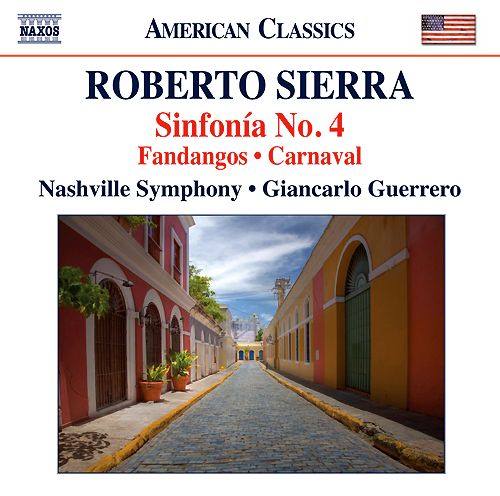
Music Composed by Roberto Sierra
Played by the Nashville Symphony Orchestra
Conducted by Giancarlo Guerrero
"Roberto Sierra’s music is fun. However self-conscious his Spanishisms may be (he hails from Puerto Rico),
he has forged a personal style at once original, and approachable. Fandangos borrows music by Boccherini,
Soler, and Scarlatti and uses it to create a colorful contemporary take on the Fandango of old. If you know
the pieces to which Sierra refers, you will enjoy the music all the more, but you certainly don’t need to
know anything at all to get the full experience.
Symphony No. 4 has four brief movements lasting a bit less than 25 minutes. There are fewer overtly
Spanish references here, though the use of color and rhythm has a Latin flair. The third movement is
marked “Tempo de bolero”, but the nifty thing about Sierra’s music is his use of avant-garde playing
techniques and textures in handling mostly traditionally tonal material. In this respect he resembles
Leonardo Balada, but his style is more direct, less obviously modernist in its gestural language.
Carnaval is a delightful suite illustrating five mythological creatures: Gargoyles, Sphinxes, Unicorns,
Dragons, and The Phoenix. The juxtaposition of the last two may look like an item from a Chinese
restaurant menu, but the actual music makes reference to Schumann’s Carnaval, as well as Papillons.
It’s all done with good taste and a light touch, and as with the other two works the performances
by the Nashville Symphony under Giancarlo Guerrero sound very confident.
The engineering captures Sierra’s brilliant scoring while maintaining good balances and textural clarity."
Classics Today
http://i1164.photobucket.com/albums/q574/taliskerstorm/p9r9_zpsiiuzs08c.gif
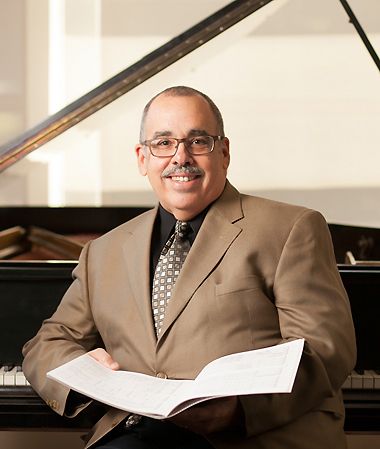
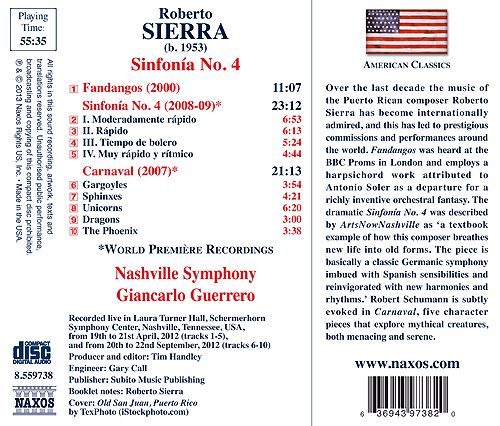
Source: Naxos CD (my rip!)
Formats: FLAC(RAR), DDD Stereo, mp3(320)
File Sizes: 252 MB / 135 MB (FLAC version incl. covers & booklet)
The FLAC link has now expired. No more requests for this, please!
mp3 version -
https://mega.co.nz/#!jBkTHCyR!MIOAQPqgCpGQVxbyWGNK0-9DEhch1ydUUybDqMNQAGs
Enjoy! Don't share! Buy the original! And please click on "Like" if you downloaded this album! :)
wimpel69
04-17-2015, 10:56 AM
No.746
Myroslav Skoryk holds the title of People’s Artist of Ukraine and is one of his country’s
outstanding composers. Both the Cello Concerto and the Seventh Violin Concerto combine
bittersweet lyricism with explosive dynamic contrasts. With its swinging rhythms and folk-music
pungency the Carpathian Concerto is one of Skoryk’s most engaging and popular works. The
pensive Melody for strings propelled him to the forefront of Ukrainian music, while the
slapstick in his transcription of Paganini’s Caprice No. 19 reveals the composer’s humorous
side. These live recordings were made at Myroslav Skoryk’s 75th anniversary concerts in Odessa.
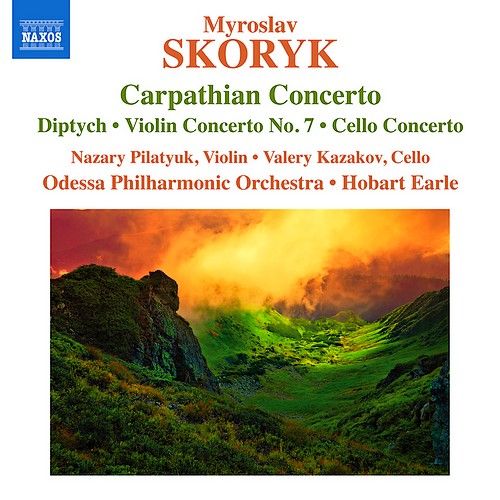
Music Composed by Myroslav Skoryk
Played by the Odessa Philharmonic Orchestra
With Nazary Pilatyuk (violin) & Valery Kazakov (cello)
Conducted by Hobart Earle
"A specialty item of a different sort, and also one packed with world-premi�re recordings,
is a new Naxos CD featuring music by Ukrainian composer Myroslav Skoryk (born 1938).
Six of the eight works here have never been recorded before – in particular, both Skoryk’s
Violin Concerto No. 7 (2009) and his Cello Concerto (1983) get their first recorded readings
here. These two works show Skoryk’s personal style quite clearly: his is music of dramatic
and often unexpected contrasts, with intensity and dynamism suddenly turning into or
following passages of lyricism and even sweetness – although, more usually, the tone is
bittersweet. Nazary Pilatyuk and Valery Kazakov make fine soloists in the concertos, and
the Odessa Philharmonic Orchestra under Hobart Earle performs admirably in support
and throughout this recording, which was made during live performances marking
Skoryk’s 75th birthday in 2013. The other world premi�res here are of shorter works:
Diptych (1993), the humorous Caprice No. 19 from “24 Paganini Caprices” (2003),
the quietly thoughtful Melody (1981), and the Spanish Dance from “The Stone Host Suite”
(1973). The two pieces here that have been recorded in the past are the short “Childhood”
from the “Hutsul Triptych” (1965) and the particularly approachable Carpathian Concerto
for Orchestra (1972). This last work’s combination of rhythmic clarity and folk-music
elements makes it unusually accessible for a work of its time. Skoryk may not have all
the incisiveness and appeal of other composers from the region, but he does have a
distinctive voice that emerges in music that is quite well-crafted."
Infodad

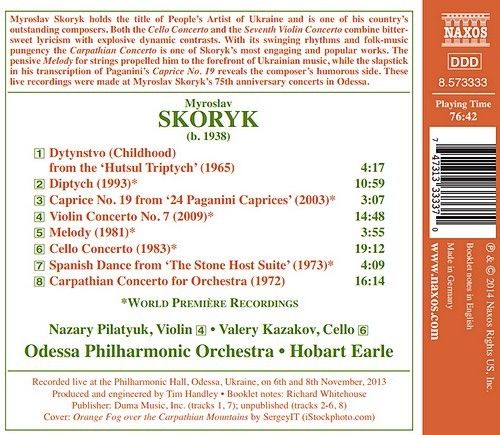
Source: Naxos CD (my rip!)
Formats: FLAC(RAR), DDD Stereo, mp3(320)
File Sizes: 269 MB / 182 MB (FLAC version incl. covers & booklet)
The FLAC link has now expired. No more requests for this, please!
mp3 version -
https://mega.co.nz/#!jZMVkLBB!epEn4Rd01dMT7gl5mYGEYg1cT84TcvZcEj7Oc_B jvTU
Enjoy! Don't share! Buy the original! And please click on "Like" if you downloaded this album! :)
wimpel69
04-18-2015, 10:32 AM
No.747
The Symphony No.3 by Aram Khachaturian, subtitled "Symphony–Poem," was composed in 1947 for
the 30th anniversary of the Russian Revolution, and premiered on Leningrad on December 13 by the Leningrad
Philharmonic conducted by Evgeny Mravinsky. It was his last contribution to the genre. Originally conceived as a
symphonic poem, it is a single movement symphony featuring an organ solo and fifteen trumpets conceived as a
hymn of praise of the Soviet Union, with Khachaturian saying that he "wanted this work to express the Soviet
people’s joy and pride in their great and mighty country". However, the work's raw and strident style, which has
been related to the 1920s Soviet constructivist avantgarde, and unorthodox structure and instrumentation
dissatisfied the Stalinist cultural authorities, and it was condemned as formalistic in the 1948 Zhdanov decree.
It has been suggested that the Triumphal Poem, lasting just short of 20 minutes yet packed with incident,
is a successor to the "Symphony-Poem," though without its bizarre qualities. The work offers themes of a more
traditional cut, stylistically working within the officially approved tradition of Glinka and Rimsky-Korsakov; there’s
even a whiff of Rachmaninov’s rich romantic style, particularly in a slow noble theme played by the strings, and
also some wistful themes akin to Khachaturian’s ballet Spartacus which he was also composing at that time.
Yet the final impression is not a dutiful conservatism, but one of the most lively and eventful of Khachaturian’s
works – a crowd-pleaser akin to Elgar’s Cockaigne Overture.
Mikhail Ippolitov-Ivanov (1859-1935) is far from being the only composer in musical history to remembered
almost entirely on the basis of just one of his many works. Nevertheless, on those very few occasions that Ippolitov-
Ivanov's name is mentioned at all, it is almost invariably in connection with his Caucasian Sketches (1894);
even then, a lone movement, the glittering festive tableau "Procession of the Sardar," is often singled out. A student
of Rimsky-Korsakov, whose distinctive flair for exotic orchestration he inherited, Ippolitov-Ivanov graduated from
the St. Petersburg Conservatory in 1882, quickly securing the directorship of the orchestra and conservatory of
Tbilisi (Tiflis), the Georgian capital. During the seven years he spent in this remote mountainous region, Ippolitov-
Ivanov undertook a detailed study of indigenous Georgian folk music, whose distinctive melodies and sonorities,
now decked out in extravagant orchestral colors, are a central presence in Caucasian Sketches.
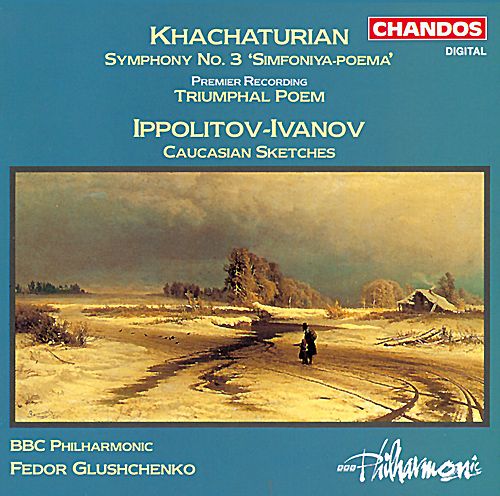
Music by Aram Khachaturian & Mikhail Ippolitov-Ivanov
Played by the BBC Philharmonic Orchestra
Conducted by Fedor Glushchenko
"To judge Aram Khachaturian’s musical personality from the two works on this disc would be
impossible. The Third Symphony and the Triumphal Poem between them have tentacles reaching
into every possible musical camp: bombast, Schmaltz, ear-piercing Soviet modernity, twittering
tunefulness – you name it, it’s there. The symphony is a particularly bizarre concoction, with a
rampaging organ commentary and a cheerless fanfare for 15 extra trumpets that repeats ad
nauseam throughout most of the piece. It’s quite impressive – the recording is wonderfully clear
and powerful – but the overall impression is a long way from the ‘apotheosis of joy’ of the symphony’s
subtitle. More like terror really. The Triumphal Poem is similarly misnamed. After an opening flourish
it is dominated by two tunes, the first light and chirpy with a sense of pastoral merry-making, the
second a lovely cantabile melody that falls into clear stanzas and cries out for words of the long-
lost-lover-over-the-hills variety. Both get a fuller, more triumphal, treatment later in the piece but
in each case the glittery orchestration rides roughshod over tunes that are simple and unaffected.
Ippolitov-Ivanov’s Caucasian Sketches are charming miniatures that use the orchestra with
restraint and sensitivity, something one could not really say of Khachaturian. The BBC
Philharmonic handles both composers skilfully, balancing the extremes of one against the
reticence of the other and making the most of the big tunes when they come round."
BBC Music Magazine
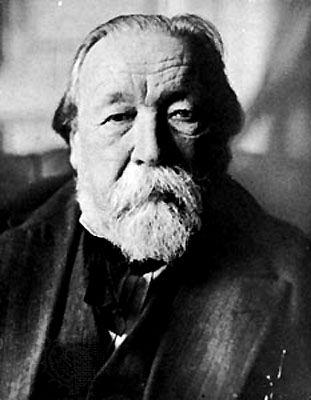
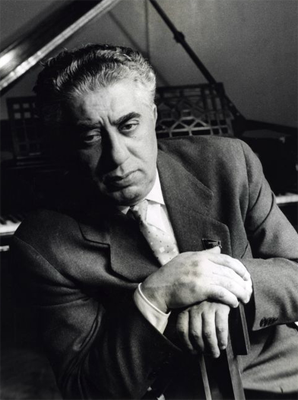
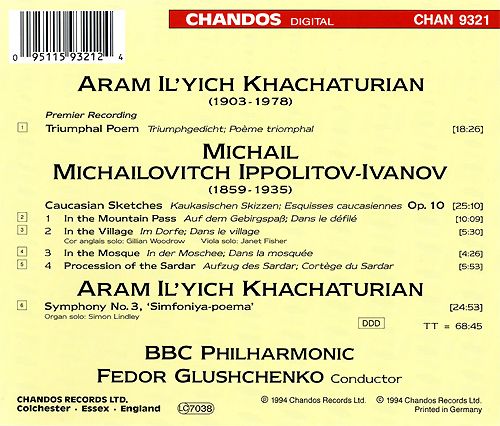
Source: Chandos CD (my rip!)
Formats: FLAC(RAR), DDD Stereo, mp3(320)
File Sizes: 326 MB / 158 MB (FLAC version incl. cover & booklet)
The FLAC link has now expired. No more requests for this, please!
mp3 version -
https://mega.co.nz/#!HRsB0SKL!EY8sJIjiJyp0xDChXokmJ8rkchj32mLs_PRfNFM LpSE
Enjoy! Don't share! Buy the original! And please click on "Like" if you downloaded this album! :)
chasey1
04-18-2015, 06:10 PM
Thanks wimpel69! You can't get more cinematic than Khachaturian's 3rd symphony. I unreservedly love it!
wimpel69
04-19-2015, 02:15 PM
No.748
Polish composer Sir Andrzej Panufnik (1914-1991) was noted for, among other things, exercising tight
control over his musical materials and often restricting them to minimal musical cells. But this habit did not
result in "minimalist" music. Instead, he showed in such works as the Katyn Epitaph that his self-imposed
restrictions could produce deeply felt, highly communicative music. The influence of this somber, reflective,
and grief-stricken piece on later Eastern European composers (such as P�rt and Kancheli) becomes obvious
on first hearing. Katyn Epitaph also represented Panufnik's return to active opposition to the ruling Polish
Communist Party. It s dedicated "to the memory of 15,000 defenseless Polish prisoners-of-war bestially murdered
in Katyn Forest in Russia during the second world war, by undiscovered and unpunished hands." However, Polish
underground figures knew quite well that Josef Stalin was responsible and that it happened while Germany
occupied Poland from the West and Russia from the East, pursuant to their cynical "peace treaty" of 1939.
Panufnik conceived the Heroic Overture in a burst of patriotism as the Polish army began to resist the
sudden invasion of Hitler's German forces in September, 1939. He immediately began working on it as a tribute
to his nation's soldiers, and planned a victorious conclusion. The power and speed of the German Blitzkrieg
ended those plans and Panufnik set the work aside. In 1952 he took the work up again. By now the Germans
had been expelled, Poland was reestablished as an independent state, but, with the presence of the occupying
Red Army, a communist party government thoroughly controlled from Moscow had eliminated most meaningful
civil liberties. "This time the nature of our invasion was more psychological than physical, but the need to assert
defiance and faith in our future was greater than ever," the composer explained.
The thought of writing a Tragic Overture came to Panufnik's mind in 1939, when the obvious inevitability
of Poland's military defeat at the hands of invading Nazi and Soviet troops became clear. He wrote it in 1942.
He had decided to explore one single four-note melodic cell "to the very limit." As such it is an astonishing
example of pure compositional technique, augmenting, diminishing, inverting, transposing and juxtaposing
the single motive with superb technical control and imagination.
The 15-minute Harmony is a very impressive, albeit severe, composition. This work was the result of
a sudden increase of interest in Panufnik's music in the United States during the last decade of his life.
The Boston Symphony Orchestra started this interest with the successful world premiere of Panufnik's
Sinfonia Votiva in its centenary celebrations of 1982. The new piece was commissioned by American
conductor Gerard Schwarz for his New York 92nd Mostly Mozart festival. In his very brief notes for the
premiere, Panufnik wrote that the title "...refers to the vertical sound (harmony based on eight- and
nine-note scales), horizontal sound (melodic lines constructed on three-note cells), "harmonious" use
of meters 4/4 and 3/4, and the balance of orchestral colour...." The orchestration is antiphonally
(stereophonically) conceived.
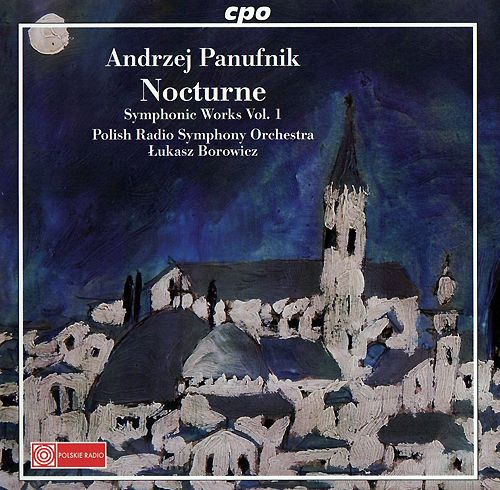
Music Composed by Andrzej Panufnik
Played by the Polish National Radio Symphony Orchestra
Conducted by Lukasz Borowicz
"The six pieces on this program have not been recorded often. Prior to the release of
this disc, the Heroic Overture had three recordings; the Nocturne had two; the Tragic
Overture, the Katyn Epitaph, and Harmony had one recording apiece; and A Procession
for Peace has never been recorded before. But all of them are magnificently played here.
Lukasz Borowicz and the Polish Radio Symphony Orchestra give everything they've got
to the music, and the result is not only wholly compelling from start to finish, it easily
outclasses virtually all previous performances of these pieces. Each work here, while
characteristic of the composer, is distinctive. The Tragic Overture is stark and relentless,
the Nocturne is dark and sinister, the Heroic Overture is mighty and majestic, the Katyn
Epitaph is harsh and demanding, and Harmony is smooth, sleek and silky, while the
world-premiere A Procession for Peace turns out to be a powerful tonal march with
brass and percussion well to the fore. Thus, any fan of Panufnik should by all means
try this disc, and any fan of postwar modernism probably should, too. CPO's digital
sound is cool but clear."
All Music
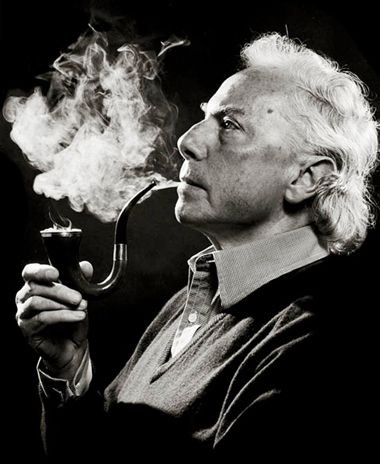
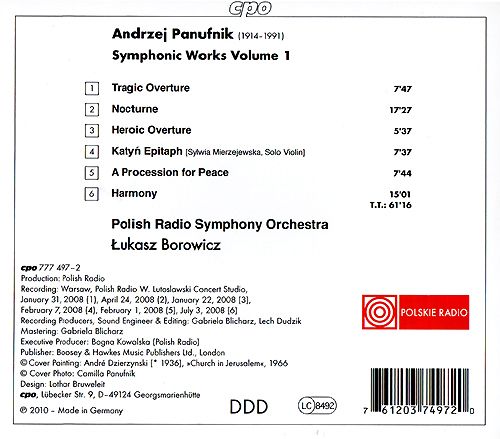
Source: CPO Records CD (my rip!)
Formats: FLAC(RAR), DDD Stereo, mp3(320)
File Sizes: 271 MB / 141 MB (FLAC version incl. cover & booklet)
The FLAC link has now expired. No more requests for this, please!
mp3 version -
https://mega.co.nz/#!TcV1kBRY!6QiROY8AgWd8ySWHrh7eErVf_IJ5VA9cIUvT8T8 ZIhw
Enjoy! Don't share! Buy the original! And please click on "Like" if you downloaded this album! :)
Inntel
04-20-2015, 12:07 AM
These are among the best posts on the forum. I can't thank you enough for making me discover so many interesting composers. I very much appreciate you sharing this excellent music with us.
markcope1961
04-20-2015, 05:27 PM
The journey through the complex, multi layered terrain of the classical repertoire, is transformed into a magical, sensorial delight, by virtue of the cultured, insightful selections, from a man who has been “touched” by the spirit of music.
wimpel69
04-21-2015, 05:31 PM
No.749
"I like contrasts," Jacques Ibert was fond of saying. All six works on this CD show his absolute
mastery of orchestral writing, each one of quite different form and inspiration. The uproarious
Divertissement is Ibert’s most popular work while the highly coloured Escales (Ports of
Call), an overnight sensation after its first performance, brings together impressions brought back from
a long journey through the Mediterranean. The fiery scherzo, Bacchanale, with its dazzling colours
and rhythms is a virtuoso showpiece. Of primary interest here, though, is a rare recording of Ibert's
Symphonie marine, which is actually a suite from a film score.

Music Composed by Jacques Ibert
Played by the Concerts Lamoureux Orchestra
Conducted by Yutaka Sado
"This would appear to be a very welcome issue, for this colorful and fastidious music has
much appeal, and there is no other orchestra which has a greater affinity with Ibert's music
than the Lamoureux, which actually gave the world premieres of both the Symphonie marine
in 1963 under Charles Munch-a posthumous premiere, for Ibert had died the previous year-
and Escales under Paul Paray in 1924."
International Record Review

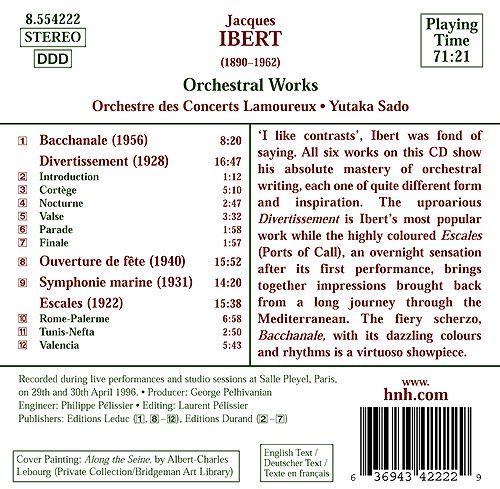
Source: Naxos CD (my rip!)
Formats: FLAC(RAR), DDD Stereo, mp3(320)
File Sizes: 307 MB / 166 MB (FLAC version incl. cover & booklet)
The FLAC link has now expired. No more requests for this, please!
mp3 version -
https://mega.co.nz/#!SAEU1CzB!NKJLxinRinqTSKqm3cEDEBL3HWgKtnUcVMQArMh BLIw
Enjoy! Don't share! Buy the original! And please click on "Like" if you downloaded this album! :)
wimpel69
04-22-2015, 11:48 AM
No.750 (by request)
Paul Graener (1872-1944) was a German composer and conductor. Graener was born in Berlin and
orphaned as a young child. A boy soprano, he taught himself composition and in 1896 moved to London,
where he gave private lessons and served briefly as conductor at the Haymarket Theatre. Before the move,
he had married Maria Elisabeth Hauschild, who was to bear him three children in London. Graener is recorded
in the United Kingdom Census of 1901 as a "musical director (theatre)" living at 3 Poplar Grove in Hammersmith
together with Maria (born in Kiel), their first two children (Heinz and Paul, aged 4 and 2) and Graener's author
cousin, George. In around 1910 Graener moved to Vienna, where he took up a teaching post at the Neues
Wiener Konservatorium. He moved several times in the 1910s, living in Salzburg, Dresden, and Munich,
eventually accepting the position of professor of composition at the Leipzig University of Music and Theatre
which had previously been held by Max Reger. In 1925 he quit the post in order to focus on composition.
Returning to Berlin in 1930, he directed the Stern'sches Konservatorium and, from 1935 to 1941, served
as vice-president of the Reichsmusikkammer. This position, previously held by Wilhelm Furtw�ngler, was
a major governmental post within an arm of the Nazi Propaganda Ministry, although the extent to which
Graener sympathized with Nazi ideals may be a subject of debate. In the late 1920s Graener had joined
the Militant League for German Culture and on 1 April 1933 he became a member of the Nazi Party.
During World War II, Graener's Berlin apartment was bombed and he moved with his family to, successively,
Wiesbaden, Munich, Vienna, and Salzburg. Graener died in Salzburg at the age of 72 in 1944.
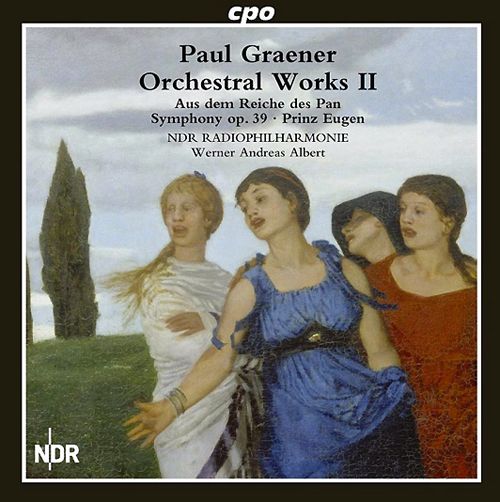
Music Composed by Paul Graener
Played by the Radio-Philharmonie Hannover des NDR
Conducted by Werner Andreas Albert
"Volume 2 starts with a half-hour Symphony (Sorrow the Blacksmith) in three movements. The big
opening Larghetto is starrily dreamy and emotionally in turmoil. It comes close to sounding like
Brahms and Elgar with a dash of Richard Strauss. The writing for the violins is especially striking.
The pensive Adagio is no stranger to storms; even anger. The finale is an Allegro Energico with a
Brucknerian theme that is determined, distinctive and positive. This romping theme goes through
various transformations towards steadily glowing serenity and peace. This work together with the
Symphonietta for Strings and the symphonic poem From Valleys and Heights owes its existence to
the tragic death of Graener’s eight year-old son in London during the composer’s sojourn there
as a theatre conductor.
The op. 108 Variations take as their subject the German folksong Prinz Eugen, der edle Ritter.
This 16-minute work is given in a single track and indeed plays uninterrupted and without
obvious seams. The music is reminiscent of Strauss again - this time the dreamier aspects of
Rosenkavalier. There is also some aggressive melodrama as at 9:55 with the assertive rattling
of the side-drum, a fugal element and some discomfiting militaristic bombast towards the end.
The Variationen uber Prinz Eugen and the Feierliche Stunde were written for the Reich Music
Festivals of 1938 and 1939.
Crudely characterised, you can hear this music as a German impressionistic mix with Bantock’s
idyllic Mediterranean classical era works such as Sappho Fragments, Pagan Symphony and
Aphrodite in Crete. The Pan tanzt movement has a strong Straussian accent but with the sort
of light-footed quality you find in Bax’s Spring Fire and Dance in the Sunlight. The sun
permeates the melancholy reflections of the final movement which is longer than the other
three movements put together. It ends roundedly in a long sustained breath."
Musicweb
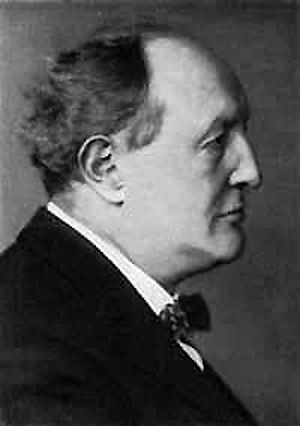
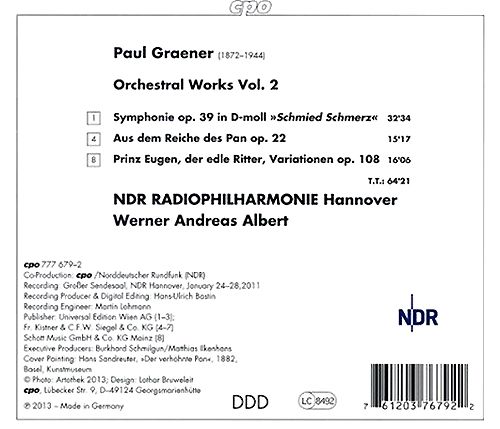
Source: CPO Records CD (my rip!)
Formats: FLAC(RAR), DDD Stereo, mp3(320)
File Sizes: 305 MB / 150 MB
The FLAC link has now expired. No more requests for this, please!
mp3 version -
https://mega.co.nz/#!CJlE0KLD!p3eVRYceP7VkYN7pN1KC9UNnC78Z92SiRH3esq7 wpYI
Enjoy! Don't share! Buy the original! And please click on "Like" if you downloaded this album! :)
janoscar
04-23-2015, 12:41 PM
This is music at its best, unbelievable that music of that calibre quality could hide from me for such a long time. Thanks wimpel69 and thanks to whoever requested this best discovery for this year!! It's obviously just politics that kept his music from a wider audience, definitely not because of a lack of quality. But politics are like sex, you don't need any intelligence to enjoy either!!
wimpel69
04-23-2015, 04:20 PM
No.751
Aubert Lemeland, born in Normandy in 1932, has composed extensively for voice, chamber ensemble and
symphony orchestra. His music is now part of the fabric of the current European concert scene. The
Symphony No.8, subtitled "In Memoriam" is in one movement. Composed in 1994, it is dedicated to
the victims of WW2. Lemeland acknowledges debts to Barber and Copland. Indeed, the orchestration and
ambience of this symphony is like the Barber's Symphony No.1 without Barber’s extensive use of melody.
Lemeland’s melodic fragments are uttered by plangent woodwinds amidst strng and percussion background,
later to be taken up in full measure by the string section. The overall tone of the symphony is elegiac, not
unlike the Barber Adagio.
The 9th Symphony was completed in 1997. For Lemeland, “It is the most tonal of my symphonies.”
The first movement “Piaccevole” (Pleasing) is propulsive. One encounters robust snatches of melody, polytonality,
abundant energy.The Largo is lyrical, sunny in disposition. A vivace finale is good humored- almost
Mendelssohnian. This Symphony is c. emeland20 minutes of intense and vibrant music.
The selection In ricordi Arturo Toscanini for string orchestra is a five minute tribute to the great Italian
Maestro. The piece is inspired by the composer’s visit to Milan, specifically the Largo Toscanini Square, in
which is a plaque commemorating the conductor. This is worshipful music.
Five Battle Pieces refer to an American Civil War collection of poems by Herman Melville. Lemeland,
however, uses texts written by American soldiers from 1942-45. Scored for string orchestra and piano, ideas
derived from Ives populate the first of these pieces. Contemplative, ranging from agitation to longing, these
are fine hewn anti-war statements.

Music Composed by Aubert Lemeland
Played by the Orquestra Nacional do Porto
Conducted by Mark Tardue
"Much of Aubert Lemeland's prolific output is solemn and commemorative in nature, particularly
of war and its victims; at least two of this disc's selections are profoundly concerned with this
tragic theme. The Symphony No. 8, Op. 166, "In Memoriam," and Battle Pieces, Op. 174 deal
directly -- even brutally -- with the machinery and violence of war, yet also with the human
suffering and heroism; so Lemeland's evocations, while at times just as grim and fierce as
Shostakovich's "requiem" symphonies, are perhaps less bleak and despairing and more
touchingly elegiac and hopeful. The fairly neo-Classical Symphony No. 9, Op. 168, and the
short tribute for string orchestra, ...in ricordo Arturo Toscanini..., Op. 183b, are more abstract
in approach and less obvious in intention, though both have a decidedly reflective and poignant
tone that seems a constant in Lemeland's late works. The Orquestra Nacional do Porto,
conducted by Marc Tardue, and with pianist Jean-Pierre Ferey in Battle Pieces, plays with
passion, strength, and considerable force, especially in the last work's Assai vivo, and
Skarbo's sound quality is consistently clear and vibrant throughout the album."
All Music
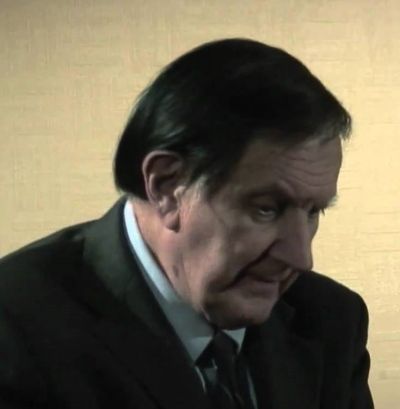
Source: Skarbo Records CD (my rip!)
Formats: FLAC(RAR), DDD Stereo, mp3(320)
File Sizes: 321 MB / 141 MB (FLAC version incl. cover & booklet)
The FLAC link has now expired. No more requests for this, please!
mp3 version -
https://mega.co.nz/#!2dUxna4K!2GkCeVzxz1tFMpwZlrqTMacl3HXPKjR1mc-pFUC6wig
Enjoy! Don't share! Buy the original! And please click on "Like" if you downloaded this album! :)
wimpel69
04-23-2015, 05:26 PM
No.752
Imagine an Austrian composer with Bax’s mystical sensitivity to nature, Schreker’s gift for orchestration,
and Magnard’s subtle sense of architecture. Throw in a strong enthusiasm for Debussy and a distinctive
melodic profile, and you have Joseph Marx (1882–1964). Far from being the dried-up pedant
portrayed by contemporary serialists [Who themselves may often be qualified "dried up"!], Marx was a
strikingly imaginative composer who combined great lyrical gifts with an ability to manipulate large
orchestral structures creatively.
The premiere recording here is that of Feste im Herbst (Autumn Festivals), a re-orchestration
by the composer of the fourth and concluding movement of his magnum opus, Herbstsinfonie.
Marx wanted to get public exposure for his works at a time when modern tonal music was being
increasingly marginalized on the musical landscape, and thought that the best way to do so was to
take this movement and launch it on a career of its own. Sadly, it received scant attention, because
it is a fetching piece on its own, a demonstration of the late German Romantic symphonic form at
its most imaginative and aurally seductive.
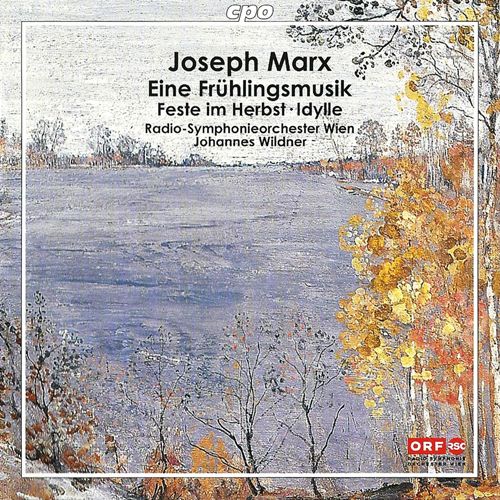
Music Composed by Joseph Marx
Played by the ORF-Sinfonieorchester
Conducted by Johannes Wildner
"Times may be tough but they’re good for the Marx collector. This latest entrant to the lists
does valuable work in giving us three major statements. Feste Im Herbst derives from a
Marxian revamping of the last movement of his vast Herbstsymphonie and in stand-alone
1946 form it sounds well. It opens with harvest-heavy teem – one is sometimes tempted
to lard the Hopkins compounds when discussing some of Marx’s orchestral works – and
continues in much the same vein. Peasant song and heavy booted country corn richly
imbue the writing; intensely lyrical its sing-songery verdant, bucolic, but well structured,
often irresistible. The quiet affirmative ending is a closure of surety and repose. It’s
played with warmly balanced appreciation of its essential lyricism.
Eine Fr�hlingsmusik dates from 1925. Powerfully chromatic, bespeaking Debussy -
one of the most obvious influences – this is again, as one would expect richly infused
with nature writing of sensuous power and great expressivity. The surging and singing
strings reach a pitch of effulgence, with Marx reserving the most audible appearance
of the brass for some intriguing sinewy blocks. This is writing of concentrated
generosity embodying a personal nature vision very much Marx’s own.
The Idylle was composed in the same year as Eine Fr�hlingsmusik. It too bears
the stamp of Debussy – his Prelude. It’s slow and luxuriant and sports some
quivering wind lines and scurrying harp as well as torpid, quietly luminous strings.
One senses the undergrowth gently teem."
Musicweb
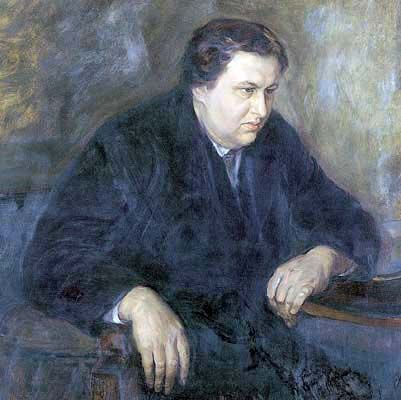
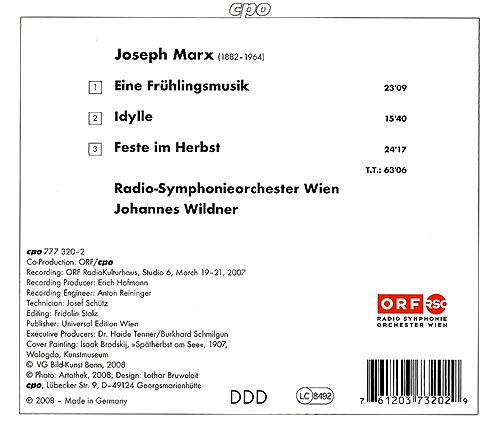
Source: CPO Records CD (my rip!)
Formats: FLAC(RAR), DDD Stereo, mp3(320)
File Sizes: 292 MB / 147 MB (FLAC version incl. covers)
The FLAC link has now expired. No more requests for this, please!
mp3 version -
https://mega.co.nz/#!PNVX3DxB!SGWpTm_D0EgAQzdYCxfEt663Ug0tewahjJB-2LqKCAY
Enjoy! Don't share! Buy the original! And please click on "Like" if you downloaded this album! :)
calvertus
04-24-2015, 05:11 AM
Joseph Marx� music is simply wonderful. It makes me sad, that he is such a neglected artist :(
booster-t
04-24-2015, 10:50 PM
So I'm sitting here marking my final exams for the semester and I figured it would be a good opportunity to listen to some new music. I can heartily recommend three of the last four offerings: Ibert, Marx and Graener. The last one is *interesting* but I am too much of a romanic period aficionado to get comfortable with Lemeland's music. still, a tip of the hat to our host for making such opportunities available. I am constantly amazed at the variety and breadth of the repertoire. Thank you.
wimpel69
04-25-2015, 10:49 AM
but I am too much of a romantic period aficionado to get comfortable with Lemeland's music.
While I listen to Korngold, Strauss and the three romantics above, too (and to music composed after 1800) I must say I'm most attracted to the so-called "klassische Moderne" (there is no term in English for this, but composers like Bart�k, Shostakovich and Stravinsky are among those composers - tonal, with a high level of dissonance). Thus, I prefer Lemeland to the other three.
wimpel69
04-25-2015, 01:38 PM
No.753
Ture Rangstr�m (1884-1947) during his day was considered to belong to the young generation of Swedish
composers of around 1910 who tried to introduce modernism into their music, and something of this spirit of
discovery lies within these pieces. His music comes as something of a revelation: powerful, sweeping and ecstatic
are all words that could be used to describe it. Sibelius considered Rangstr�m "head and shoulders above any
other Swedish composer." The patriotic Second Symphony opens very much like a Scandinavian Vaughan
Williams. The Nork�ping orchestra captures the drama of the first movement well, and throughout one is astounded
at the many felicitous touches of scoring. The coupling for this disc is the Intermezzo drammatico, and Orientally
influenced piece with a "Notturno" movement of magically veiled half-lights.
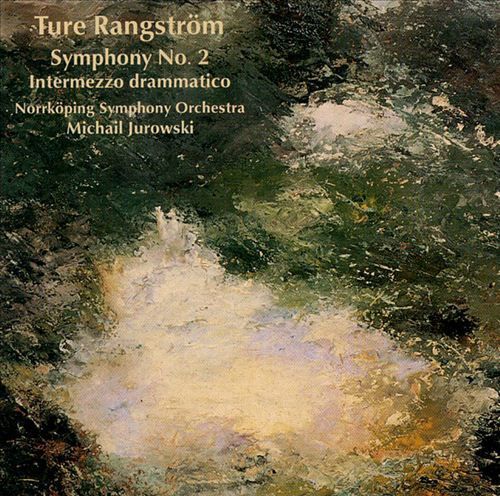
Music Composed by Ture Rangstr�m
Played by the Norrk�ping Symphony Orchestra
Conducted by Mikhail Jurowski
"Symphony No. 2, subtitled "My Country," followed in 1919. Each of its three movements
are likewise subtitled: "The Fairy Tale," "The Forest, the Wave, the Summer Night," and
"The Dream." Tunes may not be as memorable as Smetana's, who was the first to call a
symphonic work "My Country," but Rangstr�m's spirit is no less patriotic or impassioned.
You don't have to be Swedish to be stirred."
Classical CD Review

Source: CPO Records CD (my rip!)
Formats: FLAC(RAR), DDD Stereo, mp3(320)
File Sizes: 233 MB / 125 MB
The FLAC link has now expired. No more requests for this, please!
mp3 version -
https://mega.co.nz/#!zQ9wwLSJ!OwxKCvbIrn-HnkD7maXqnmXElFCnR4Kgkp9TezPj-e0
Enjoy! Don't share! Buy the original! And please click on "Like" if you downloaded this album! :)
wimpel69
04-25-2015, 02:40 PM
No.754
Another delightful collection of "British Light Music Premieres." This latest release is something of a
curiosity in combining items from various recording sessions between 1998 and 2004 with one track
(the theme from television’s The Pallisers) that was recorded in 1974. Happily one would scarcely
know the varied sources from the well-blended finish. Perhaps the pieces most obviously in the old
British light music idiom are the two by Carlo Martelli (the music director for Hammer Films for
some years), comprising a rousing Jubilee March and a fantasy on the Cock Linnet song (‘My
old man said follow the van’) that along the way incorporates Bizet’s ‘Toreador Song’ in counterpoint.
Among the rest, the two charming items by Philip Lane especially grab the ear for their piano contribution,
with the composer as soloist as well as producer of the sessions.

Music by various composers
Played by various orchestras
Conducted by Gavin Sutherland & Marcus Dods
"All the composers here are living, the senior representatives being nonagenarian Geoffrey Wright
with his three varied Neapolitan Dances, and John Fox, who turned 80 in 2004 and who contributes a set
of six portraits of characters from fairy tales plus the attractively fresh Strings in 3/4. At the other end of
the age range, Adam Langston was only 16 or 17 when his truly delightful Gentle Rains (composed for
his A level practical examination) was recorded in 1999. It’s intriguing to contemplate what we may
expect from him in the future.
There is much music of considerable charm here, and as ever all is stylishly played. Regular
collectors of the ASV series will be happy to know that the British light music baton seems to
have passed to safe hands."
Gramophone

Source: Dutton Epoch CD (my rip!)
Formats: FLAC(RAR), DDD Stereo, mp3(320)
File Sizes: 327 MB / 160 MB
The FLAC link has now expired. No more requests for this, please!
mp3 version (re-up) -
https://mega.nz/#!F3IQTYzB!OLkOKWGDkLG890Nebmhi0tPbe4ub5LlVdoWGvQTUPGo
Enjoy! Don't share! Buy the original! And please click on "Like" if you downloaded this album! :)
bohuslav
04-25-2015, 04:36 PM
@ Rangstr�m. Fantastic recording, the whole series is great. I am looking forward for alternative versions by Stig Westerberg or others. Rare to find...
chasey1
04-26-2015, 08:12 AM
"klassische Moderne" (there is no term in English for this, but composers like Bart�k, Shostakovich and Stravinsky are among those composers - tonal, with a high level of dissonance).
It's not an exact match, but the term "Neoclassicism" represents a similar idea - a return to traditional forms/structures (e.g. sonatas, fugues, rondos), but with the addition of a new, expanded tonality. It was an early 20th century reaction against the formless bloat, endless chromatic modulations, and "I can hit a C minor chord louder than you can" excesses of late 19th century romanticism*. Bart�k, Shostakovich, and Stravinsky were all major proponents.
Compared to "classical" period music, neoclassicism offers more chord possibilities, more dissonance, more interesting sound possibilities. Plus cool new rhythmic stuff that would have given Salieri an aneurysm.
I'm ecumenical. Any school/style of classical music has plenty that's both good and bad. If a composer's music speaks to me, everything else is of secondary importance.
*I know that there are fans of late romanticism who wish it had continued forever, and who view 20th century classical music as one long detour from "real" music. But they're ignoring the reality that romanticism was reaching an aesthetic dead end by the end of the 19th century. Once Wagner/Mahler opened the doors to "you can modulate to any key, whenever you want, as often as you want," there was nowhere left to go harmonically. Arnold Schoenberg realized this pretty early on, which is why he decided to branch out into atonality.
Schoenberg was wrong about the popular appeal of atonal music, but I don't fault him for experimenting. It opened doors. Later composers, such as almost any horror movie film score composer of the past 50 years, have used 20th century innovations like atonality. The difference is that most of them have used atonality as one tool amongst many, rather than relying on it as the "serialists" did.
elinita
04-26-2015, 11:28 AM
Anyway,I think that late romantic music never should die because it�s in the inner nature of human�s feeling
wimpel69
04-26-2015, 01:54 PM
No.755
Four suites of "Chinese light music" orchestral works based on regional folk songs
by the composer of the Son of the People Symphony (which you can find >here< (
http://forums.ffshrine.org/f92/wimpel69s-could-film-music-classical-corner-work-121898/44.html#post2586190)).
Bao Yuankai is a Chinese composer and educator. Bao studied the flute and composition
in the affiliated Middle School of the Central Conservatory of Music in China and graduated
from the conservatory in 1967 with a BA in Composition and Composition Theory. Bao has
been writing music of various genres including symphony, chamber music, cantatas, musicals,
movie and television sound tracks. The most important piece of his work is entitled Rhapsody
of China. It includes seven chapters of symphonic music based on Chinese traditional themes
and motifs (of which this is a part). It was performed in forty countries from 1991 to 2001.
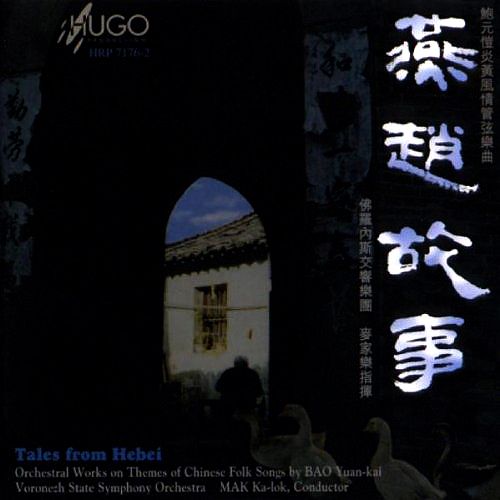
Music Composed by Bao Yuan-Kai
Played by the Voronezh State Symphony Orchestra
Conducted by Mak Ka-Lok
"It was in 1990 when I began to restudy various Chinese folk songs, dance music,
ballad music, traditional operas, and instrumental music. My plan was to compose
orchestral works based on the best tunes selected from our musical tradition in order
to make the colorful and charming Chinese folk of traditional music to be enjoyable
for all people in the present world. I supposed that the new works should be both
“symphonic” in form. and “Chinese” in essence ….
To combine Chinese folk or traditional music with Western modern symphonic forms
is a practical way to break up the isolation of Chinese music and bring it to the
world’s stage. Symphonic music is one of the most expressive and capable musical
types developed by European musicians in keeping pace with the Industrial Revolution.
With the blending of different musical traditions, a large number of symphonic works,
which reflect varied social life and aesthetic demands in varied styles, have been
produced in the past by composers from countries outside Europe. Originated in
religious music, European professional music is highly developed with strict notation,
systematized harmony, dynamic part writing, and logical structure. Chinese traditional
music, on the contrary, implies verve in the facets of simple events. The difference
provides us with a good opportunity to show our creativity."
Bao Yuan-Kai

Source: Hugo Classics CD (my rip!)
Formats: FLAC(RAR), DDD Stereo, mp3(320)
File Sizes: 348 MB / 165 MB
The FLAC link has now expired. No more requests for this, please!
mp3 version -
https://mega.co.nz/#!vd1hjaxJ!yFXHdQIY2wvESTV76TvBRNKc2-1Fg9JIHdtFsWvS6TQ
Enjoy! Don't share! Buy the original! And please click on "Like" if you downloaded this album! :)
No more updates for the next ten days.
ArtRock
04-26-2015, 02:00 PM
"No more updates for the next ten days..."
A good moment then to say thank you so very much for all your shares in this and related threads!
booster-t
04-26-2015, 07:40 PM
*I know that there are fans of late romanticism who wish it had continued forever, and who view 20th century classical music as one long detour from "real" music. But they're ignoring the reality that romanticism was reaching an aesthetic dead end by the end of the 19th century. Once Wagner/Mahler opened the doors to "you can modulate to any key, whenever you want, as often as you want," there was nowhere left to go harmonically. Arnold Schoenberg realized this pretty early on, which is why he decided to branch out into atonality.
Schoenberg was wrong about the popular appeal of atonal music, but I don't fault him for experimenting. It opened doors. Later composers, such as almost any horror movie film score composer of the past 50 years, have used 20th century innovations like atonality. The difference is that most of them have used atonality as one tool amongst many, rather than relying on it as the "serialists" did.
I agree with you, especially with respect to Schoenberg. I agree that the horror movies owe a large debt to 20th century composers. I also would agree that Mahler and Bruckner were the apex of 19th century romanticism and that yes, the approach was a dead end. But I would suggest also that many of the soundtrack composers of the last 30 years are the "heirs" of the romantic period. Jerry Goldsmith, James Newton Howard, Alan Silvestri, James Horner, John Debney, Danny Elfman, the list goes on and on. For example, right now I am listening to Trevor Rabin's "Remember the Titans". It is hard to ignore the romanticism of the music.
I think the best way to put it is a quote from Victor Hugo: �Music expresses that which cannot be put into words and that which cannot remain silent� ... we all see music in a way that touches us individually.
elinita
04-26-2015, 08:06 PM
I agree with Booster completely,and please don�t forget the great masters of the golden era of soundtracks like:Max Steiner.Erich Korngold,Victor Young.Alfred Newman,Franz Waxman,Hugo Friedhofer,Miklos Rozsa,Dmitri Tiomkin,Alex North,Bernard Herrmann,John Scott,Leigh Harline,David Raksin,Roy Webb,John Williams and a lot of italian and french composers.Long Life to the Romantics!
gpdlt2000
04-27-2015, 04:29 PM
If I am not mistaken, there was a recording of Floating World in the late 60s conducted by Kostelanetz and released by American Columbia, but it is always nice to have another version of this almost-unknown Hovhaness piece. Thanks for the share, wimpel!
wimpel69
04-27-2015, 06:31 PM

I'll take a sec out of my busy holiday (see above) to weigh in on this debate: the reason that I prefer tonal but highly dissonant music like Bartok and Shosty is that I think that the STRUGGLE for happiness and peace must eventually fail, and that, thus, music that contains melody and dissonance best describes the human condition. In many ways all early to mid 20th century arts, in literature and painting e.g., try to come to grips with that same struggle. Back to beer. :)
booster-t
04-27-2015, 07:08 PM
Looks interesting! Beer is a science all its own! My son and a buddy of his are working their way through the more than 400 beers offered my Taco Max in Atlanta.
As for your comment, see ... that's where we differ. I am a romantic in all senses of the word and while I share your view that music expresses the struggle for happiness and peace, I believe that happiness must prevail. If not, then the human condition is naught but a sad journey and beauty is an illusion.
I would also argue that the desire to depict the human condition and the struggle therein is not a new goal. Haydn did it, Beethoven did it, Berlioz did it, and Liszt did it. But then, so did Shostakovich, Prokofiev and other Russian composers of the mid 20th century. Shostakovich's 5th Symphony reaches out to me as an example of the struggle. But so does his 2nd Piano concerto, especially the second movement, as an example of romanticism. So does his Suite from which Andre Rieu made famous the Second Waltz.
I think the issue is what we look for in music. Your comment that "I prefer tonal but highly dissonant music like Bartok and Shosty is that I think that the STRUGGLE for happiness and peace must eventually fail, and that, thus, music that contains melody and dissonance best describes the human condition." is personal and describes what you want to hear or see. Me, I want to walk away with a "smile on my face and a song in my heart" — as corny as it sounds. In a sense, I think the key is that we seek out music that resonates with our view of the world.
elinita
04-27-2015, 08:56 PM
I�m sorry but I think that the "romantic" means not merely the sentimental feelings,the love,the sweetness things.The romantic spirit includes the anguish for the human condition,the certain dead,the loneliness ,the unconscious ,even the horror and the weird stories.Remember that the begin of the romantic period in music just called "sturm und drang" ,so that was the mood of this style of music.By the way about the tension and dissonances Mahler is a good example to hear it (the terrific chord of his 10 symphony for example)and in the other side the "elan" of the beauty adagios .I think that the romantic spirit is the best way to resemble the human nature and it�s live today.The rest are only variations around this theme,(even schoenberg was a romantic !)
wimpel69
05-05-2015, 05:54 PM
No.756
It was Frank Sinatra, no less, who in 1962 dubbed Robert Farnon (1917-2005) "The Guv'nor", when the two men
first came together in London to work on an album. It was a phrase which instantly 'stuck', but it really did no more than
sum up what most people had long since known - that the name of Robert Farnon was synonymous with the highest
standards of craftsmanship across the widest spectrum of music-making. Farnon as a composer of light classical and
"mood music," is a rival to figure such as Eric Coates, David Rose, and Percy Faith. He has also been notably successful
in the field of film music since the 1940's. His score for the Gregory Peck starrer Captain Horation Hornblower RN
is popular among swashbuckling fans, and it saw no less than three professional recordings (two by Farnon himself).
Farnon went on to compose several dozens of film scores, of which Shalako and Bear Island are among the best known.
Farnon has remained a top composer in his field for 50 years. In addition to his film scores, his popular instruments
include "How Beautiful Is Night," "Journey Into Melody," "Pictures in the Fire," "Westminster Waltz," and "A Promise of
Spring." In addition to its melodic content, Farnon's music is noted for its deceptively complex internal structure, which
makes it as interesting as it is attractive. A quiet, self-effacing man, without the gift for self-promotion that rivals such
as Percy Faith or David Rose ever showed, Farnon has never had a high-visibility creative role, preferring to work
quietly and show himself through his work.

Music Composed by Robert Farnon
Played by the Slovak Radio Symphony Orchestra
Conducted by Adrian Leaper
"Farnon’s quirky rhythmic numbers, Portrait of a Flirt, Peanut Polka and Jumping Bean, have much in
common with Leroy Anderson in their instant memorability; their counterpart is a series of gentler
orchestral watercolours, usually featuring a wistful flute solo amid gentle washes of violins. A la claire
fontaine is the most familiar. Then there is the film music, of which the Colditz March is rightly famous,
and the very British genre pieces, written in the 1950s. All this is played by this excellent Slovak
orchestra with warmth, polish and a remarkable naturalness of idiomatic feeling. The recording is
splendid, vivid, with the orchestra set back convincingly in a concert-hall acoustic."
Penguin Classical Guide
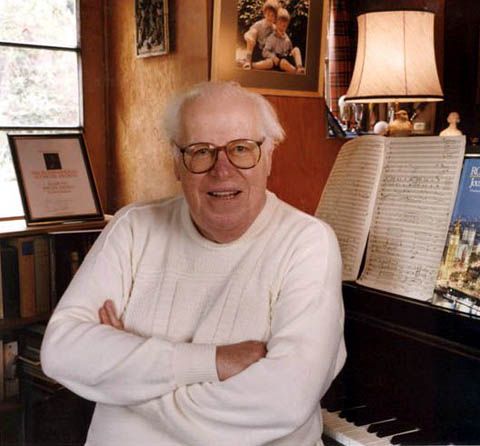
Source: Marco Polo CD (my rip!)
Formats: FLAC(RAR), DDD Stereo, mp3(320)
File Sizes: 289 MB / 152 MB (FLAC version incl. cover & booklet)
The FLAC link has now expired. No more requests for this, please!
mp3 version -
https://mega.co.nz/#!GcF0jKLB!_cthS36GO_6N21cCu_yVkzb9UmSm6X6q4TWnh6P VhRk
Enjoy! Don't share! Buy the original! And please click on "Like" if you downloaded this album! :)
janoscar
05-05-2015, 06:57 PM
Hi wimpel69!
Welcome back....you were dearly missed!
siusiak09
05-06-2015, 07:36 AM
Maestro69 ! I hope all is fine ? Janoscar is right...and you are our music guru !!!
gpdlt2000
05-06-2015, 03:41 PM
Nice to have you back, wimpel!
calvertus
05-07-2015, 05:23 AM
Welcome back, my dearest wimpel69
wimpel69
05-07-2015, 09:04 AM
No.757
Paul Hindemith's symphony Harmonie der Welt (Music of the Spheres) is drawn from an opera about
Johannes Kepler, the great astronomer who deduced the laws of orbital motion. Kepler was looking for the exact,
perfect geometrical forms -- circles, squares, equilateral triangles, and the like, that he believed must describe
planetary motion. He called the concept "The Harmony of the Universe, ". Ironically, he discovered that there are
no such relationships concerning spacing of the planets, and also that they move not in circular but in elliptical
orbits, and not even at constant speeds. The symphony has three movements, "Machine Music, " "Human Music,"
and "World Music." The three movements progressively seek to illuminate higher and higher spheres of
musical/astrological imagery and musical purity. The music itself is high-minded and seeks to be free from
human passions (except the passion for enlightenment), and seems at times to glow with an inner radiance.
Hindemith wrote the Pittsburgh Symphony, his sixth and final symphony, at the request of the Pittsburgh
Symphony Orchestra's then-music director William Steinberg in 1958 to celebrate the 200th anniversary of the
founding of the city. To accomplish this musical celebration, Hindemith included two songs associated with the
city in the fabric of his work, the Pennsylvania Dutch folk song Hab lumbedruwwel mit me lumbeschatz in the
central portion of the central movement and the contemporary folk song "Pittsburgh Is a Great Old Town" by
Woody Guthrie and Pete Seeger in the final portion of the closing movement. The opening movement, Molto
energico, is a mono-thematic movement that has elements of both sonata form and three-part form in its
structure. The outer sections are the exposition and recapitulation of sonata form, but the central section,
Piu calmo, is more of a quiet interlude between the stormy outer section rather than a development section
proper. The central movement is actually three movements in one: a slow march led by the oboe and then
taken up by the strings in a series of variations, an Allegro assai central section that treats the Pennsylvania
Dutch folk song as a symphonic scherzo, and a closing section that unites the slow march and the scherzo
in one structure. The closing movement, Ostinato Allegro moderato, is -- like so many of Hindemith's
symphonic finales -- a passacaglia. The movement and the work reaches a climax in the statement
of Guthrie and Seeger's song as a cantus firmus in the horns that drives the work to its powerful
conclusion. It is interesting to note that, for all his stated antipathy to atonal and serial music,
Hindemith found a way to integrate a quotation from Webern's symphony in the finale
of the Pittsburgh Symphony.
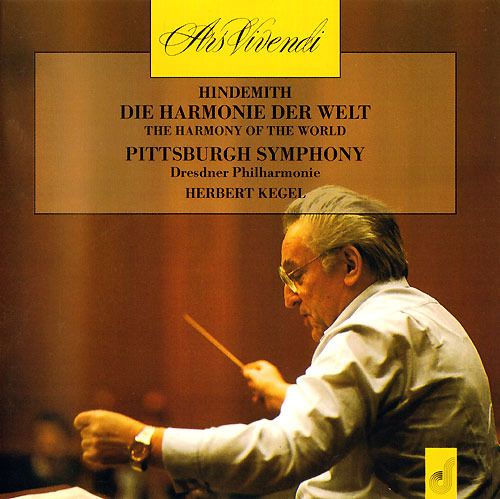
Music Composed by Paul Hindemith
Played by the Dresdner Philharmoniker
Conducted by Herbert Kegel
"[Here] we encounter the Harmonie der Welt Symphony written for the Minneapolis Orchestra.
This is another big-scaled work based on an opera on the life of the astronomer Johannes Kepler.
This is a fine performance with an especially affective middle movement, Musica Humana. If you
want to hear an even more heatedly emotional reading then do try to track down the Mravinsky/
Leningrad performance on B MG-Melodiya. The Harmonie symphony is followed by the strenuous
heroics of the 1958 Pittsburgh Symphony in a hearty recording from the 1980s; as is the
Harmonie der Welt. The long central Slow March movement again taps Hindemith's gift for
sincere and thoughtful music. It's superbly done by Kegel. Hindemith was often at his best
when tackling adagios and andantes. His faster music was prone to a certain hardness of heart."
Musicweb
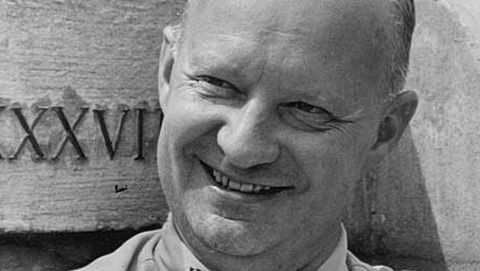
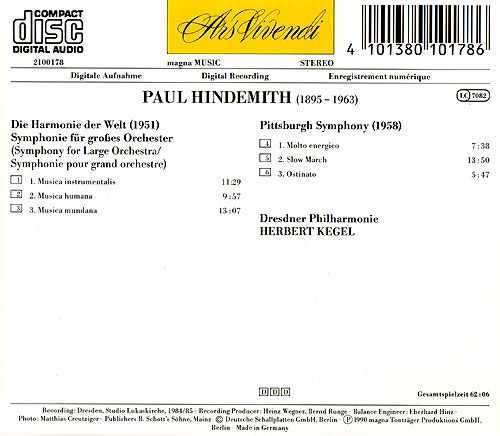
Source: Ars Vivendi/EdelCD (my rip!)
Formats: FLAC(RAR), DDD Stereo, mp3(320)
File Sizes: 245 MB / 142 MB
The FLAC link has now expired. No more requests for this, please!
mp3 version -
https://mega.co.nz/#!WAUVwTaC!kpGtwcRmGFFvQdUhfT-e7KMHNnxkaT3mGZNHTkZ9xnQ
Enjoy! Don't share! Buy the original! And please click on "Like" if you downloaded this album! :)
wimpel69
05-07-2015, 10:41 AM
No.758
Ignatz Waghalter (1881-1949) rose from an impoverished childhood in Poland to become
conductor at the newly founded Deutsches Opernhaus in Berlin in 1912. Here, the first performance
of his youthful comic opera Mandragola, attended by luminaries such as Richard Strauss, Busoni,
and Humperdinck, won him huge acclaim: the "Overture and Intermezzo" reveal his orchestral mastery.
With the rise of Nazism Waghalter left Europe for America where he strongly identified with the Afro-
American cause, and began work on the New World Suite, ten short movements of rich melodic
imagination that illustrate his constant desire to write approachable and lively music. While in America
he launched an orchestra of African Americans, an attempt at social engineering that was largely
unwelcomed by the establishment and found no outside support. He died unexpectedly at the age
of 68, remembered by the �migr� community in 1949 and honoured with a lengthy obituary in the
New York Times.

Music Composed by Ignatz Waghalter
Played by the State Symphony Orchestra "Novaya Rossiya"
Conducted by Alexander Walker
"In happier times Waghalter had become known as an opera conductor, giving many German
premieres, including Puccini’s Girl of the Golden West, while his own operas were very well
received. The year 1914 saw the first performance of his comic opera Mandagola being presented
before a very distinguished audience. The newspaper reviews were ecstatic, and you only have
to listen to the two gorgeous excepts on this disc to understand that response. Go forward
twenty-five years and stylistically nothing had changed in the New World Suite, a score only
discovered in 2013. It was still in the same light, frothy and happy mode, though I could find
little relationship between the music and some of the titles of the ten sections. When I reached
the Hymn and Variations, which sounded rather like an off-shoot of the popular song The last
time I say Paris, I gave up trying and sat back to enjoy a work that has passing relationships
with Shostakovich’s excursions into light music. The disc ends in military band fashion with the
stirring, Masaryk’s Peace March, composed in 1935 in honour of the Czech president.
Throughout the New Russia State Symphony Orchestra play superbly in capturing the mood
of the music, Alexander Walker keeping the tempos moving forward with admirable zest
and fun. Top drawer sound quality."
David’s Review Corner
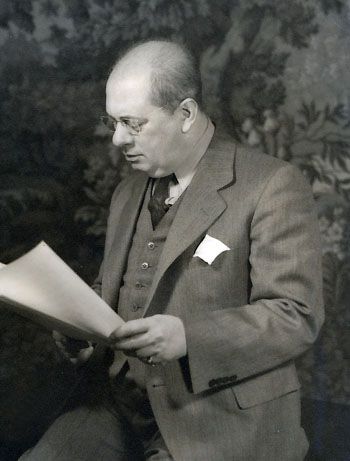
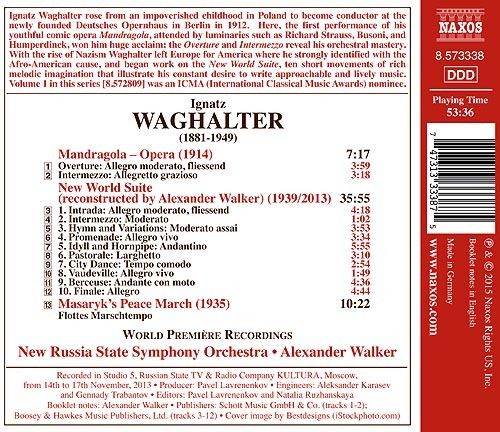
Source: Naxos CD (my rip!)
Formats: FLAC(RAR), DDD Stereo, mp3(320)
File Sizes: 286 MB / 148 MB (FLAC version incl. covers & liner notes)
The FLAC link has now expired. No more requests for this, please!
mp3 version -
https://mega.co.nz/#!KBtn0YpJ!IlQ46kPGXAiMf8OctqGdVSaqgHJhxnMlfryg-kxqjNs
Enjoy! Don't share! Buy the original! And please click on "Like" if you downloaded this album! :)
bohuslav
05-07-2015, 05:39 PM
Who the hell was Ignatz Waghalter? Never heard this name. Many thanks for get to know, wimpel69.
booster-t
05-08-2015, 12:26 AM
I sort of feel like bohuslav, except I wouldn't say it :-) ... however, after listening to the CD, I have to say it is worth getting. A nice hour's worth of light music ... recommended. Thanks for the enlightenment, wimpel69
Darius Freebooter
05-08-2015, 12:09 PM
Link received for Farnon, many thanks.
wimpel69
05-09-2015, 11:59 AM
The FLAC links for posts Nos. 721-740 have now expired. No more requests for these (or eralier) FLAC links, please!
wimpel69
05-10-2015, 02:08 PM
No.759
Carl Nielsen (1865-1931) is world famous for his six symphonies and his two operas Saul and David
and Maskerade. In addition he wrote programme music and incidental music for the theatre, thereby
creating some of his most popular works. This release features some of his finest pieces for orchestra, displaying
the composer’s sharp sense of the refined, playful and humorous. This compilation differs from the Chandos
album under Gennady Rozhdestevsnky which I posted earlier in that it includes a suite from Snefrid,
written in 1893, just after the Symphony No.1 from the previous year. He had so to speak just made his
entry on the stage as a composer, achieved his breakthrough, and was only now finding his own style. For that
reason there is a kind of lustre of originality over the pieces from Snefrid, especially in the slow -lyrical passages.
Of the third of the pieces, the love music, Carl Nielsen wrote in a letter that he had played it for an acquaintance:
"he simply blushed at the sensual character of the music ..." However, we can also find words from the up-
and-coming young composer saying quite the opposite: he claimed that the high, great music he wanted to
write would be the opposite of sensuality. Snefrid is thus the expression of a duality in the period. On the
one hand it reached outwards towards the sensual, on the other it aspires upwards towards the high ideals.

Music Composed by Carl Nielsen
Played by the Danish National Symphony Orchestra
Conducted by Thomas Dausgaard
"Talk about a slam-dunk! This is without doubt the finest collection of Nielsen’s short orchestral
works currently available. It is perfectly played, brilliantly conducted, and superbly recorded in
stereo and SACD formats. You won’t hear a more ebullient performance of the Maskerade Overture
anywhere. Thomas Dausgaard keeps the tension mounting right through the quiet central episode,
and the coda is beyond exciting. The manic eruptions in both An Imaginary Journey to the Faroe
Islands and Pan and Syrinx rage with uninhibited impact, but the poetry in the soft passages isn’t
ever slighted, particularly in the latter. The Prelude to Act 2 of Saul and David sounds suitably
imposing, while a rousing, joyous account of the Helios Overture closes the program in the most
satisfying and contented fashion imaginable.
What makes this disc even more satisfying is the presence of some very rare examples of Nielsen’s
extensive output of incidental music. Usually we only get to hear Aladdin, or very occasionally the
overture to Love and the Poet (but not as well played as here). Willemoes is only a charming couple
of minutes long, but the Snefrid Suite and the Hr. Oluf Hand Rider Prelude are more substantial.
The former dates from the period of the First Symphony (early 1890s) and finds the composer
discovering his personal voice, particularly in terms of harmony. The latter dates from the same
period as Maskerade (around 1906), and it’s a fully characteristic gem. In all of this music the
playing of the orchestra reveals proprietary pride without a trace of complacency or routine.
Everything sounds fresh and new, and if you don’t love this disc, then–well, never mind. It’s just
plain irresistible. Might there be a sequel in the offing, with Aladdin, Saga-Drom, and the remaining
shorter orchestral works? We can only hope."
Classics Today
http://i1164.photobucket.com/albums/q574/taliskerstorm/p10s10_zpsqbbdrtzi.gif
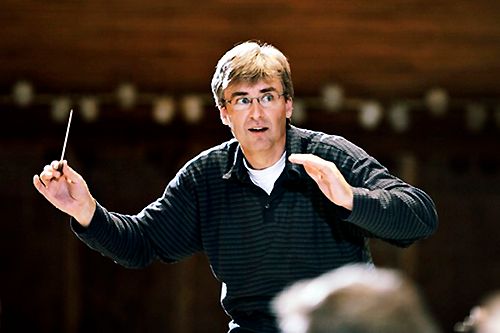
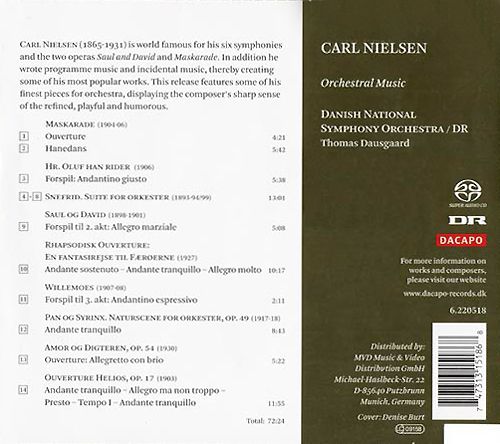
Source: Dacapo Records CD (my rip!)
Formats: FLAC(RAR), DDD Stereo, mp3(320)
File Sizes: 323 MB / 166 MB (FLAC version incl. cover & liner notes)
The FLAC link has now expired. No more requests for this, please!
mp3 version -
https://mega.co.nz/#!CRVxXASC!Mbg0iGaEpV9tjnqxkjAS02GEeiIL6T4pDuYq_r_ DHzM
Enjoy! Don't share! Buy the original! And please click on "Like" if you downloaded this album! :)
booster-t
05-10-2015, 05:03 PM
Anyone who likes Nielsen MUST get this. A great recording. Thanks wimpel69
swkirby
05-10-2015, 08:56 PM
Thanks for this, as always... scott
wimpel69
05-11-2015, 03:34 PM
No.760
Elisabetta Brusa (*1954) has always been strongly interested in and influenced by all the arts, in particular
by the constraints of differing forms and genres imposed upon composers wishing to express original ideas in
their music. After writing a handful of brief works during her early years, she turned to Classical sonata form
for her First Symphony (1988–1990). This was her first work for large orchestra, following her graduation
from the Milan Conservatory in 1980 with a Diploma in Composition. On first hearing, Symphony No.1 leaves
an overwhelming impression of sheer volume of sound, and of immense orchestration alternating monumental
instrumental blocks with contrasting moments of pure lyricism.
Mythology, literature, art and travel have always played a strong role in Elisabetta Brusa’s life. Her symphonic
poem Merlin, written in 2004, tells the story (or rather emotionally describes) of Merlin, one of history’s
best-loved legendary figures and and one for whom she has long had a fascination. In contrast to her first
symphony, Merlin is a work free from the constraints of a traditional musical form, rather being a musically
programmatic reflection of the character. As creator of the Round Table, Merlin’s magic enabled Uther Pendragon
and Ygraine to conceive King Arthur, who was then raised by Merlin until his accession to the throne of Camelot.
In Brusa’s symphonic poem an incessant rhythm, passed around the various instrumental sections and
percussion (note the unusual yet pertinent presence of the anvil), provides the backdrop to a
large-intervalled melody.
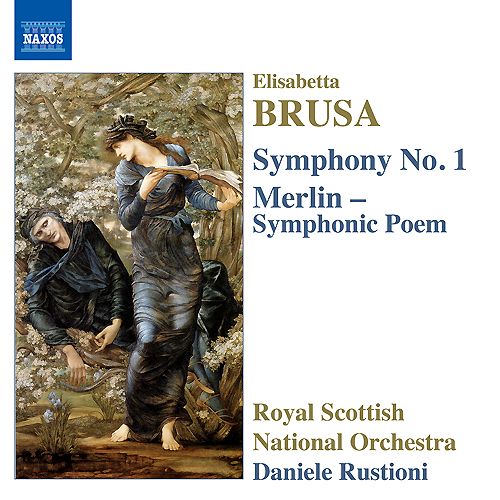
Music Composed by Elisabetta Brusa
Played by the Royal Scottish National Orchestra
Conducted by Daniele Rustioni
"Thirteen years ago Naxos issued two discs of music by the major Italian composer, Elisabetta
Brusa, when I describe them as ‘Lutosławski without the catchy tunes’. Born in Italy in 1954, Brusa
was educated at the Milan Conservatorio, furthering her compositional studies in England and the
USA where she was then to spend much of her time. Composing almost exclusively for orchestra,
her music has been performed in many parts of the world, and since 1980 she has shared her time
between composition and teaching at the Milan Conservatorio. For the First Symphony, completed
in 1990, I would now have to add that the orchestration recalls Shostakovitch’s Fourth Symphony,
the pungency contained within the general realms of tonality, and while the first movement conveys
both weight and impact, it often gives way to sections of tender lyrical beauty. Largely revolving
around the following Adagio, which stylistically turns the clock back a generation, its quiet nature
is interrupted by one climatic moment. The scherzo is qualified by the tempo marking ‘moderato’,
the jagged rhythms emphasised by timpani, its mood of latent energy continuing into a finale
that drives forward to a noisy and hectic conclusion. Merlin, completed in 2004, is a graphic
picture of the mythical person, full of primary orchestral colours, and if you, for instance, enjoy
Sallinen’s music you will certainly enjoy this. For the Scottish orchestra the whole disc must
have been a challenge, yet, under the much acclaimed young Italian conductor, Daniele Rustioni,
they provide the security, passion and commitment for which they have become known. The
recording is from the premiere league, and I much commend the disc to you."
David's Review Corner
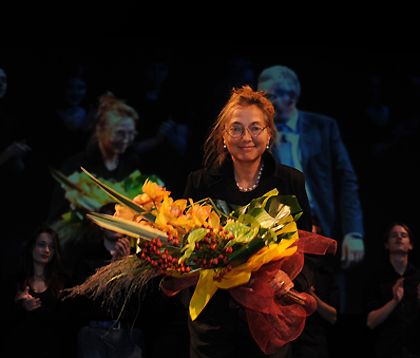
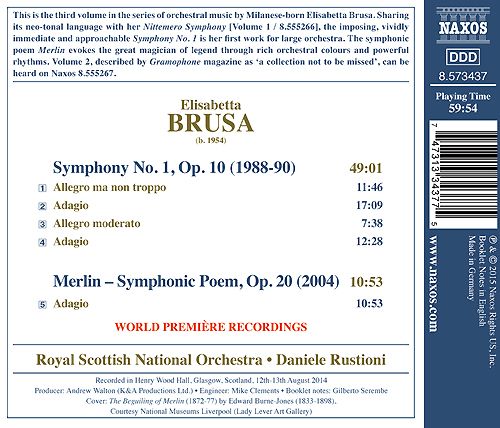
Source: Naxos Records CD (my rip!)
Formats: FLAC(RAR), DDD Stereo, mp3(320)
File Sizes: 289 MB / 144 MB (FLAC version incl. covers & booklet)
The FLAC link has now expired. No more requests for this, please!
mp3 version -
https://mega.co.nz/#!6RFBFC6T!Ph_lLtqkI3cPts18e0NsYBbDCxo_0AaPI8SaCaO aSg8
Enjoy! Don't share! Buy the original! And please click on "Like" if you downloaded this album! :)
bohuslav
05-11-2015, 07:39 PM
The orchestral works Messidor and Florestan from Brusa are in my playlist...nice to find this recording here. Many thanks wimpel69.
wimpel69
05-12-2015, 12:09 PM
No.761
Since British light music is so popular with the FFShrine crowd, here's another delightful collection of familiar
and less familiar items, conducted by one of the great advocates for English music, the late Vernon Handley.
British light music’s remarkable rehabilitation must surely be complete when a new collection not only finds a
place in Classic fM’s first batch of CD releases but has the dreaded ‘Essential’ tag to boot. The concentration
here is on numbers that have served as signature tunes for radio and television programmes such as Desert
Island Discs, The Archers, Children’s Favourites and Dr Finlay’s Casebook, though numbers such as The
grasshoppers’ dance and Nights of gladness take us back to the early years of the century. Vernon Handley
adopts a generally more forthright, full speed ahead approach than Ronald Corp in his two Hyperion collections.

Music by [various, see back cover]
Played by the BBC Concert Orchestra
Conducted by Vernon Handley
"I've long admired Vernon Handley's interpretations of more 'serious' music and the way he
champions his native shore, so it's fascinating to hear his thoughts on these lighter pieces.
These are lively, committed performances, the tempi occasionally not quite steady within items,
but the affection and sensitivity never in doubt. In itself this is a most recommendable collection
but it's unfortunate that its issue just postdated a number of other excellent CDs carrying much
the same repertoire."
Amazon Reviewer

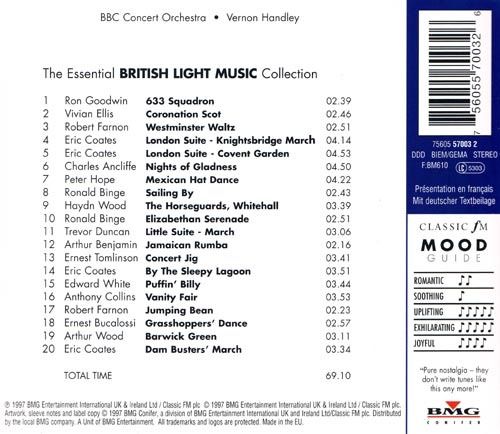
Source: Classic FM/RCA-BMG CD (my rip!)
Formats: FLAC(RAR), DDD Stereo, mp3(320)
File Sizes: 292 MB / 159 MB
The FLAC link has now expired. No more requests for this, please!
mp3 version -
https://mega.co.nz/#!DAdzxKbY!Pk3GR9PCMCTflxmN3flYsqjov14sywAgRc_MmRg QkhA
Enjoy! Don't share! Buy the original! And please click on "Like" if you downloaded this album! :)
gpdlt2000
05-12-2015, 03:34 PM
Another great collection of light music!
Thanks,wimpel!
bohuslav
05-12-2015, 03:56 PM
Yes, marvelous collection, Vernon forever. Many thanks wimpel69.
Tsobanian
05-12-2015, 06:11 PM
wimpel, do you have by any chance Macal conducting Gliere?
Macal Conducts Gliere | Delos Productions, Inc. - The Great American Label | Outstanding Classical Recordings for over 40 Years! (
http://delosmusic.com/tag/macal-conducts-gliere/)
Macal Conducts Gli�re - Zdenek M�cal | Songs, Reviews, Credits, Awards | AllMusic (
http://www.allmusic.com/album/macal-conducts-gli%C3%A9re-mw0001940851)
Or Andre Anichanov conducting Gliere?
Gli�re: Orchestral Works - Andr� Anichanov,St. Petersburg State Symphony Orchestra | Release Information, Reviews and Credits | AllMusic (
http://www.allmusic.com/album/release/gli%C3%A8re-orchestral-works-mr0002704496)
wimpel69
05-13-2015, 11:30 AM
No.762
Although Reinhold Gli�re's Symphony No.2 has never attained the popularity of his Third (subtitled
"Ill'ya Muromets", see >here< (
http://forums.ffshrine.org/f92/wimpel69s-could-film-music-classical-corner-work-121898/3.html#post2192981)), it is nevertheless one of the composer's more important
works. Cast in four large movements, it exudes Gli�re's characteristic Russian style
and conservative expressive language.
The first movement is marked Allegro pesante and opens dramatically with an epic theme of absolute Russian
character, played at a more deliberate tempo than the marking would normally suggest. A passionate, almost
Rachmaninovian alternate theme provides ample contrast amid the surrounding muscular, heroic, and more
animated music. The development section builds to a dramatic climax, and the return of the main theme near
the close adds to the epic sweep of the movement, despite the quiet ending.
The ensuing Scherzo, marked Allegro giocoso, is playful and lively in its outer sections, Romantic and mostly
relaxed in its central Trio. As in the other movements, Gli�re's masterful scoring here enhances the colorful
Russian character of the music. The Andante third movement is a theme and variations, the main theme
richly Romantic, sounding like a mixture of Borodin and Rachmaninov. The variations that fill out the
movement contrast moods -- the lively and colorful with the soaring and passionate, the playful and
fleet with the serenely beautiful.
The finale, marked Allegro vivace, may contain the most Russian-sounding music of all: the chipper
folkish main theme, driving rhythms, and active tambourine, along with the composer's deft orchestration,
impart a strong sense of both Russian fantasy (not unlike some of Rimsky-Korsakov's more colorful scores)
and peasant festivity. The brief middle section features an exotic melody related to the main theme;
it is followed by music even more celebratory than that heard at the outset. Soon, however, the mood
develops a more epic character and the alternate theme appears in a stately, heroic guise to
triumphantly crown the work.
For notes on (and a complete version of) The Red Poppy, click >here< (
http://forums.ffshrine.org/f92/wimpel69s-could-film-music-classical-corner-work-121898/31.html#post2397536).
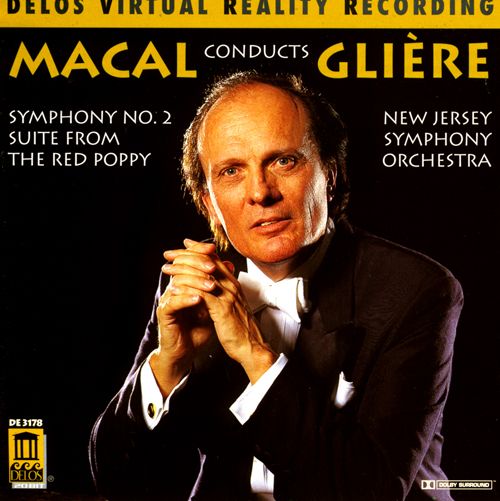
Music Composed by Reinhold Gli�re
Played by the New Jersey Symphony Orchestra
Conducted by Zdenek M�cal
"Delos make a big pitch about their ‘Virtual Reality’ recording quality. Ultimately destined for
Surround Sound Home Theatre reproduction, it involves, amongst other things, a careful choice
of venue, slightly more than usual spatial separation of the players in the hall, and a pragmatic
approach to multi-miking. Gliere’s colourful late-romantic Second Symphony is a fine choice for
the first issue in the series. Just occasionally I thought the woodwind detail too good to be true,
but otherwise the results are extremely satisfying.
In general Macal takes much the same view of the piece as Sir Edward Downes – the timings
are very close indeed – though Macal coaxes slightly more suave phrasing from his musicians."
Gramophone

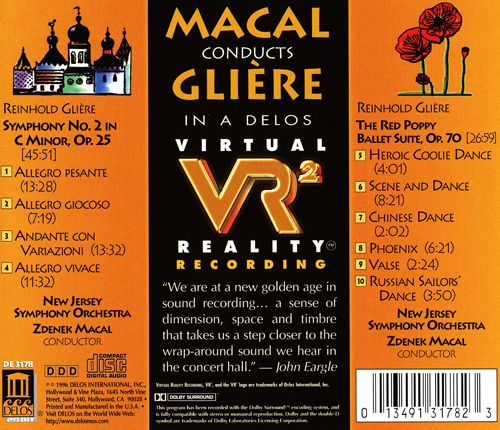
Source: Delos CD (my rip!)
Formats: FLAC(RAR), DDD Stereo, mp3(320)
File Sizes: 362 MB / 179 MB (FLAC version incl. covers)
The FLAC link has now expired. No more requests for this, please!
mp3 version -
https://mega.co.nz/#!fIE3WZxI!pyDkauAEa2XsKsE3oJXLPxYJ8elpLjp5driV41Z YJyo
Enjoy! Don't share! Buy the original! And please click on "Like" if you downloaded this album! :)
In the future, please request albums by PM! Tsobanian, I think I've told you that explicitly before.
booster-t
05-13-2015, 12:38 PM
This is a general comment for the thread. I was first introduced to classical music by my parents who took me to see Young Peoples Concerts put on by the Montreal Symphony Orchestra (as it was then called) in the late 1950s. The conductor was Wilfrid Pelletier, for whom Place des Arts in Montreal names their performance hall. More than 50 years on, classical is still my favourite genre. But as you can see from my posts, I am a romantic at heart. It is so nice to learn about other musical styles. Thank you.
wimpel69
05-14-2015, 03:27 PM
No.763
"Towards 1933, I grew more interested in the cinema," French composer Charles Koechlin said. "Until then I had
shown considerable disdain for it because of its too often vulgar and demagogic nature. But I confess without
shame that on getting to know this very uneven art-form better, I could not fail to appreciate the spiritual grace
or the 'insolent beauty' of certain Stars...This led to my Seven Stars Symphony." From this diffident and
rather disingenuous acknowledgement one would hardly guess Koechlin's obsession with film divas or the creative
renewal they prompted. The 1920s had seen a slowing of composition as Koechlin's faltering finances necessitated
lecturing, journalistic work, and the writing of treatises on harmony, fugue, and the chorale to supplement his
dwindling fortune. His inner life through that decade centered on work with his student, Catherine Urner, who
became something of a soror mystica to his master alchemist. With her return to the United States in the early
'30s, he was adrift. A viewing of The Blue Angel with Marlene Dietrich and Emil Jannings on June 29, 1933, began
the habit of regular moviegoing. His response was immediate and potent -- as he completed the tone poem
Sur les flots lointains (based on a song by Catherine Urner), composed over July/August 1933, he plunged
into the composition of the Seven Stars Symphony (title in English) in July, completing it in September, and
finishing the orchestration in October. Its seven movements form a suite rather than a symphony, each with its
specific references and distinct character. The first movement celebrates Douglas Fairbanks Sr. in The Thief of
Bagdad in "a little oriental improvisation." Lillian Harvey (a menuet fugu�), Greta Garbo (choral pa�en), and
Clara Bow are each allotted a movement, though Koechlin is responding to photographs -- he had yet to see
any of the three in films. Dietrich is graced with a set of variations on a theme formed, by cipher, from the
letters of her name, while the movement bearing Jannings' name is frankly subtitled "Choral pour le r�pos de
l'�me du Professeur Rath (du film L'Ange bleu)." But Chaplin takes the cake -- his movement, playing over a
quarter of an hour, is another variation set recalling elements of his creation, Charlot, in The Gold Rush, The
Circus, and City Lights. The Fairbanks, Garbo, and Chaplin movements were premiered by the French
Radio Orchestra, led by Manuel Rosenthal, on December 14, 1944; the entire work was heard on November
16, 1969, with Norman del Mar conducting the London Philharmonic.
Koechlin's music is like no other -- it is an art of suggestion, allusion, nuance, attenuation, luminosity,
rendering an aura of the immemorial, fantastic, legendary, and archetypal with an art nouveau sensibility
akin to the pictures of Maxfield Parrish or the "Poictesme fantasies" of James Branch Cabell. Koechlin never
wrote a concerto, though he was lavish with music for neglected instruments, such as the bassoon, viola
d'amore, and ondes martenot. The symphonic poems and symphonies never meet the expectations mustered
by those titles -- one receives both more and less. The Ballade for piano and orchestra - the closest
Koechlin came to a concerto -- is a primary example.
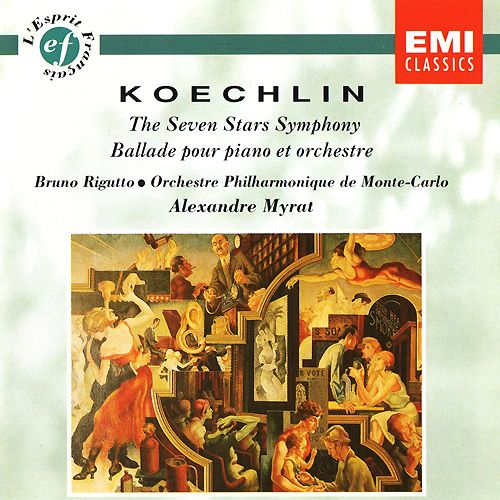
Music Composed by Charles Koechlin
Played by the Orchestre Philharmonique de Monte-Carlo
With Fancoise Pellet (ondes martenot)
And Bruno Rigutto (piano)
Conducted by Alexandre Myrat
"Recorded in 1982, the fact that [this album is] reentering the catalog suggests a select appeal
which makes competition unlikely in the foreseeable future, thus [it enters] the Hall of Fame, if not
- quite - by default (these are strong performances in better than average sound), less as outstanding
sonic or interpretive artifacts and a great deal more on the strength of their artistic and musical import.
As Paul Snook took pains to note of The Seven Stars Symphony (in Fanfare 7:3) when this recording
surfaced on vinyl, the provocative title "arouse[s] superficial and irrelevant expectations in the unprepared
listener which are sure to be disappointed. This is not a set of slick and meretricious symphonic tableaux � la
Ferde Gr�f� but a leisurely paced succession of unrelated miniature tone poems, constituting a suite of very
subjective, very poetic, and very elusive character-sketches, or, more accurately, meditations, on the screen
imagery of vedettes such as Fairbanks, Sr., Garbo, Dietrich, and Jannings as filtered through the allusively
mythologizing atmosphere of a nostalgic aural dream." Got that? Well get it: he's on the money. Oddly,
the compact disc has been processed from analog masters—the exemplary vinyl issue was digital: prominent
tape hiss in the Ballade has been reduced but hardly banished from the symphony. Despite that, detail and
timbrai play are more keenly served on silver, as is one's wish to return again to certain oddments, moments,
and entire movements until this miragelike play of tone, texture, and color has been savored and assimilated."
Fanfare
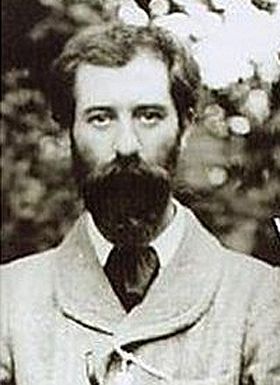
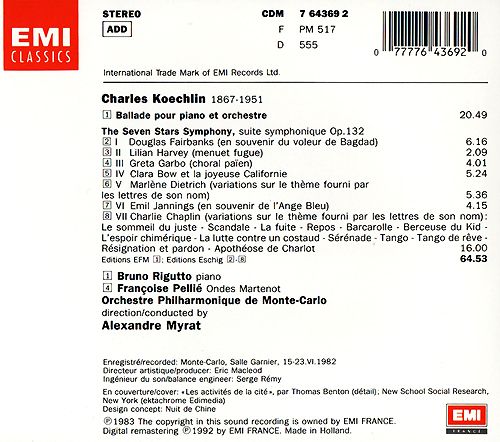
Source: EMI France CD (my rip!)
Formats: FLAC(RAR), DDD Stereo, mp3(320)
File Sizes: 238 MB / 160 MB (FLAC version incl. cover & booklet)
The FLAC link has now expired. No more requests for this, please!
mp3 version -
https://mega.co.nz/#!vJFkCDpR!CXIQYwG6KaKPaS84ufAo-iLTKM6ERAmhrtazPS3-8Go
Enjoy! Don't share! Buy the original! And please click on "Like" if you downloaded this album! :)
wimpel69
05-15-2015, 11:50 AM
Strange. I would have thought the Koechlin would be more popular,
because of its movie context and since it contains ***much*** better music
than the Gli�re. ;)
No.764
Wolfgang Rihm (*1952) could have become a poet or an artist. He felt the need to express himself
creatively from an early age and always had a skill for abstract thought. In the end he became a composer,
expressing himself through music. Rihm is a larger than life phenomenon – in terms of both his encyclopaedic
knowledge and his creative output, which also has something encyclopaedic, something all-embracing about
it. The same is true of his activities as a teacher (he is a professor of composition at Karlsruhe University of
Music), as a writer (he has published several volumes of written works, including interviews), as a lecturer
(he is a charismatic speaker) and as a representative of his craft in public bodies, including the German
performing rights society, GEMA.
Rihm was commissioned by the Lucerne Symphony Orchestra to write pendants to each of Brahms's four
symphonies, and after they were performed, he assembled the set into a symphony of his own, adding
to the sequence an orchestration of an early song for baritone based on a Goethe poem also set by Brahms.
The subtitle, N�he Fern ("distant closeness"), exactly describes the feel of the orchestral movements,
which never quote directly from the Brahms symphonies but seem constantly haunted by them – in their
harmonic tints and textures, and in the melodic shapes that wander elusively through them. The relationship
becomes clearer as the work goes on – allusions to Brahms's First Symphony in the opening movement
seem far more oblique than those to the Fourth in the concluding one – but nothing is too obvious.
Typically, Rihm seems empowered rather than restricted by the weight of tradition.
The movements, one of which includes a baritone solo, are rhapsodic in character, thus much of this sounds
like harmonically advanced film music.
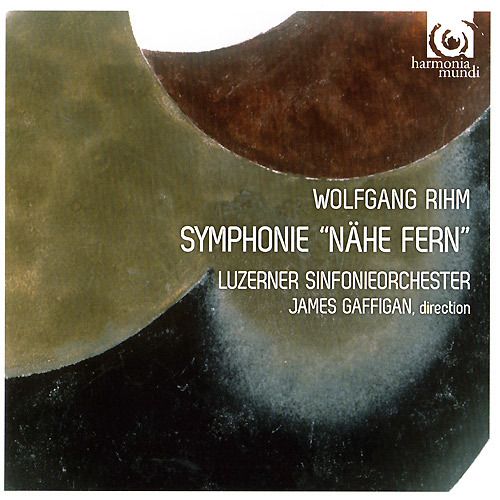
Music Composed by Wolfgang Rihm
Played by the Luzerner Sinfonieorchester
With Hans Christoph Begemann (baritone)
Conducted by James Gaffigan
"So this is expansive, judiciously grand, orchestral music. It is never overwhelming and never
pretentious or too concerned with sound and impression. Neither is it at all derivative or fussy.
It's eloquent and self-assured symphonic writing never lacking in direction or purpose. It is
sonically intriguing and delightful.
The acoustic is spacious, responsive and conducive to best hearing of this music. The
accompanying notes in French, English and German provide useful background as well
as Goethe's text.
Rihm is a composer well worth exploring. His music appeals on so many levels that it's
hard to imagine anyone not finding something here. Whilst not being, perhaps, the most
typical of the composer's style, the Symphony "N�he Fern" is a good indication of one
important direction taken by the latest of Rihm's over 400 completed works. Played
convincingly, the approachable music on this CD makes it well worth a try."
Musicweb
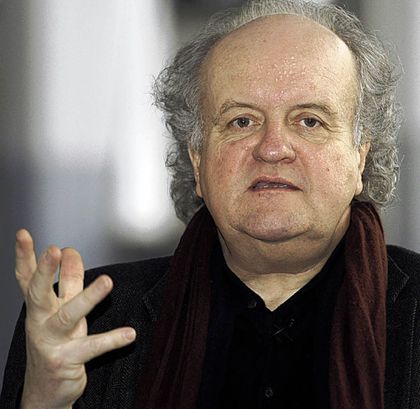
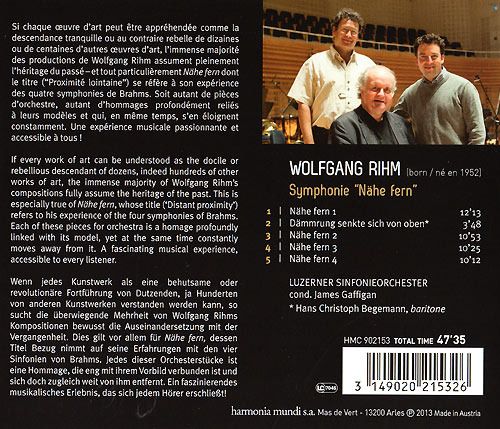
Source: Harmonia Mundi CD (my rip!)
Formats: FLAC(RAR), DDD Stereo, mp3(320)
File Sizes: 270 MB / 134 MB (FLAC version incl. cover & booklet)
The FLAC link has now expired. No more requests for this, please!
mp3 version -
https://mega.co.nz/#!TAEGmYSS!6iQj0hfkuBC6-oJCfAPw9ilnwo9XfakG3ibLKr6aAeY
Enjoy! Don't share! Buy the original! And please click on "Like" if you downloaded this album! :)
swkirby
05-16-2015, 09:33 PM
I'll give the Koechlin a try, but I think the Gliere Second Symphony is a very good piece of music. Thanks for both... scott
wimpel69
05-18-2015, 03:59 PM
No.765
Takashi Yoshimatsu comments on the works on this album: "[The Second Symphony] was composed between the
springs of 1991 and 1992 and was commissioned by the Japan Symphony Foundation. This is my second symphony,
following my Kamui-Chikap Symphony which was completed in 1990. The subtitle ‘At terra’ is a kind of
signature, rather like writing ‘at Tokyo’ at the end of a letter. It is based on my attempt to think about humans and the
earth and the fact that I mixed up and put together sound materials from Asia to Africa. There are three movements each of which
has a requiem in the Asian, European and African style.
The ‘Pegasus Effect’ is the transformation which occurs when an earthly bound horse is given wings and made
into a heavenly horse. This piece is part of the transformed bird series and is a kind of prologue to the subject
of transformation. (‘Temma’ is a horse with wings in Japanese folklore.) The Guitar Concerto has three parts as in concerto
form in the classical style.
The toki is an internationally protected bird which inhabits only Japan and parts of China. In 1971, the last remaining toki on Japan’s
main island, Honshu, died in captivity on Noto peninsula. It was then that I saw for the first time a picture of the toki traversing the blue
sky, a sight so beautiful as to bring tears. Since then I have been haunted by the feeling that somewhere in the heavens the lamenting
cry of these ashen-white birds resounds. The delicate perishes, and the callous survives – that seems to be a natural law. We
glibly explain how that which has beauty as its only attribute dies out in extinction, but can we live in a world without the toki?"
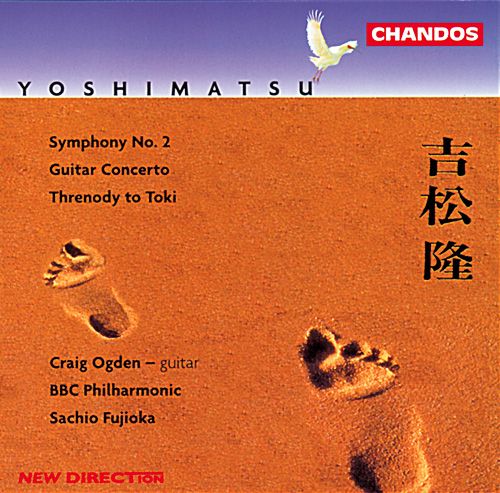
Music Composed by Takashi Yoshimatsu
Played by the BBC Philharmonic Orchestra
With Craig Ogden (guitar)
Conducted by Sachio Fujioka
"This is an intelligently programmed CD, reversing the traditional concert sequence of
overture-concerto-symphony as have other Chandos discs (for instance of Hindemith –
including the Symphony in E flat, 10/92 – and Kaipainen, 2/96). Prior to encountering
the present recording, I had heard only one piece by Takashi Yoshimatsu (b. 1953),
who is not otherwise represented in The Gramophone Classical Catalogue. He strikes
me as a sort of oriental Hovhaness, who looks to North (and Latin) America for exotic
inspiration. His accomplished, brightly coloured music is never less than engaging, if
occasionally prolix, though I doubt whether an innocent ear would identify it as Japanese.
Much as I enjoyed At terra (1991-2), I wish the composer had not called it a symphony.
It is a very effective and exciting suite, and might have made a fine concerto for the
cello, which has several important solos (exquisitely delivered by Peter Dixon), but
by no stretch of the imagination is it a symphony. The Guitar Concerto (1981) is a
welcome addition to a still meagre repertoire, the ecologically minded Threnody to
Toki (mourning the extinction in the wild of a rare bird) rather less compelling.
Sound and performance quality are uniformly excellent; a very enjoyable disc.'"
Gramophone
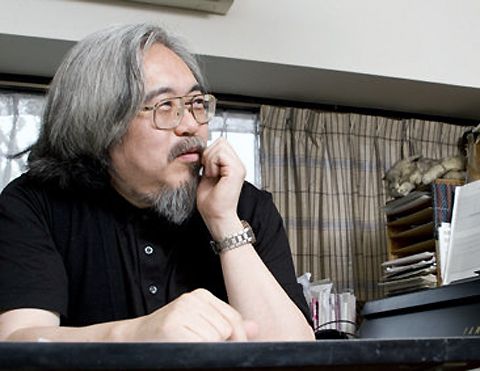

Source: Chandos Records CD (my rip!)
Formats: FLAC(RAR), DDD Stereo, mp3(320)
File Sizes: 243 MB / 158 MB (FLAC version incl. cover & booklet)
The FLAC link has now expired. No more requests for this, please!
mp3 version -
https://mega.co.nz/#!OV1hkDwb!e3QKjwe8DbUbtsBJ0EB28iL_Zi_IrWcTDMRapgN fRQ4
Enjoy! Don't share! Buy the original! And please click on "Like" if you downloaded this album! :)
wimpel69
05-26-2015, 02:25 PM
No.766
Li Huan-Zhi’s (1919-2000) First Symphony was composed between 1958 and 1960 as an expression
of the composer’s deep affection for his ancestral home, Egret Island, in Xiamen, Fujian. The conception was of the
winds of the heavens stirring the surge of the waves, represented through the use of folk-tunes from the region as
characteristic musical material. In the first movement, The Call of the Sea, the introduction is set against the
background of the sea. From the bright blue sky above a melody floats down, suggesting the nanqu (south melodies)
folk-music popular in the south of Fujian and in Taiwan. The main part of the movement is structured as modified
sonata form, with primary section, secondary section, development and recapitulation. In the coda the melody
of the introduction is echoed and the movement ends with the faint sound of xiaojiaoluo (small shouting gong)
from South Fujian folk-music. The second movement, Fine Horses and Young Boys, in scherzo style, uses the
South Fujian nanqu folk-melody Eight Fine Horses. The material associated with the horses and that with the
image of boys singing of the spring are used in alternation. The third movement, The Feeling of Plum Blossom,
is a lyrical slow movement, with the well-known Plum Blossom melody of nanqu used to express the depth of
the composer's emotions. In the final movement, Song of Praise, the thematic material of the earlier movements
is brought together in praise of the composer’s home-town in its new guise.
The Spring Festival is an important date in the Chinese calendar. After the New Yangge (Seedling Folk-Dance)
Movement in Yanan in 1943, it became a festival during which artists in Yanan joined with the people in singing
and dancing, an occasion for reinforcing revolutionary morale by the meeting together of Communist Party and
government officials, soldiers and civilians. Spring Festival Suite was composed in 1955 and 1956, a
crystalization of the composer’s own experience of the Spring Festival in Yanan. In four movements, the suite
shows the people in this centre of the revolution, celebrating the Festival and greeting each other in brotherly unity.
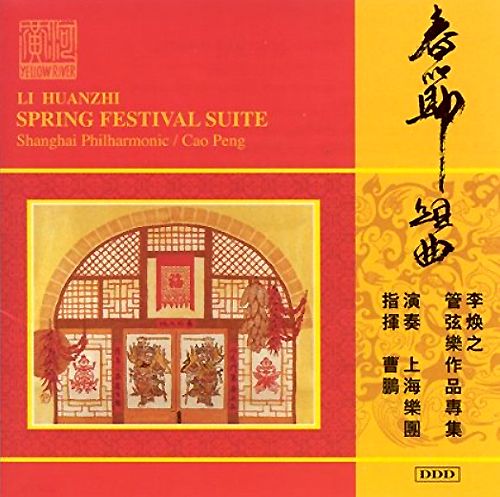
Music Composed by Li Huan-Zhi
Played by the Shanghai Philharmonic Orchestra
Conducted by Cao Peng
"The Shanghai Philharmonic Orchestra is one of the best known such organizations in China. It was
established in 1962 as the East China Music Troupe, directed by the well-known composer He Luting,
who was followed by Huang Yijun and Situ Han. The present artistic director is the well-known
conductor Cao Peng. In the past forty years the orchestra has given more than three thousand
concerts, often in collaboration with leading international performers. The Shanghai Philharmonic
Orchestra frequently appears in broadcasts and television performances, and in film and recording
studios."
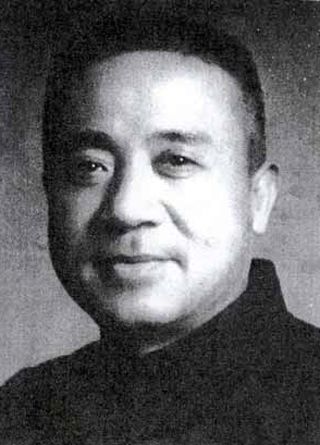
Source: Naxos "Yellow River" CD (my rip!)
Formats: FLAC(RAR), DDD Stereo, mp3(320)
File Sizes: 309 MB / 154 MB (FLAC version incl. liner notes)
The FLAC link has now expired. No more requests for this, please!
mp3 version -
https://mega.co.nz/#!qFUSXahb!bMsHosmWWbQ4FnMB3znmG3_PZIKmVsRACya9Icv 11nk
Enjoy! Don't share! Buy the original! And please click on "Like" if you downloaded this album! :)
wimpel69
05-28-2015, 03:59 PM
No.767
Delos continued its long-standing recording relationship with James DePreist and the
Oregon Symphony and commitment to American Music with American Contrasts.
DePreist himself was a composition student of Persichetti's.
Contrasts, indeed: Benjamin Lees, a student of Ingolf Dahl, wrote rather orthodox, but very serious and
expertly polished orchestral works. He never subscribed to any particular school, but if one were to
characterize the refined Passacaglia for Orchestra - consisting of a theme, nineteen variations and
a code, one could say that it is Stravinsky-an to a degree.
Vincent Persichetti was a successful teacher and symphonist in the US, a long time professor at Juilliard.
His Fourth Symphony (1951), cast in the traditional four movements, employs elements of Americana
and Hindemith-ian counterpoint in a finely woven web of orchestral tapestry.
Subtlety may not be the strong suit of Michael Daugherty, but he sure knows how to let er' rip.
Sundown on South Street, the first movement to his symphony Philadelphia Stories, and the
independent piece Hell's Angels (scored for four bassoons!and orchestra) throw in everything
but the kitchen sink and constitute hugely entertaining, colorful extravaganzas of post-modern sensibility.

Music by Benjamin Lees, Vincent Persichetti & Michael Daughtery
Played by The Oregon Symphony
Conducted by James DePreist
"Benjamin Lees’s catalog contains a number of short and punchy orchestral pieces—
Profile, Spectrum, Concertante breve, Mobiles, and Borealis among others—which
should be especially useful for opening or filling out concert programs. Surprisingly
enough, this premiere release of his Passacaglia for Orchestra of 1976 is the first such
work of his ever to be recorded, and it is without doubt one of the best. Utilizing the
format of theme, 19 variations, and a coda, this 12-minute showpiece exploits orchestral
resources in the composer’s typically wiry and muscular fashion. Because an infusion of
aggressive tension linked to a laconic economy of means have been constants in Lees’s
music from his earliest scores of the 1950s, this Passacaglia not only moves along at
a very unpedantic clip, but also generates a tremendous charge of pent-up energy.
DePreist gives a solid and sensible account of the score’s gradually intensifying torque,
but he seems to be holding back a bit on the degree of acceleration this listener hears
in an aircheck by the Detroit Symphony under Werner Torkanowsky (a much underrated
conductor and composer, by the way).
The dynamic Persichetti Fourth Symphony is one of his more genial and even laid-back
essays in the form, with its attractive blend of Yankee assertiveness and urbane neo-
Classicism. Its second movement opens with an especially beguiling and amiable theme,
a kind of hesitant pavanne, that the composer works up into a variety of delectable
shapes and meters. Although not as dramatically expressive as some of the later
symphonies, such as the ferocious Fifth for string orchestra or the massive Seventh
(which remains inexplicably unrecorded to this day), every measure of the Fourth
testifies to Persichetti’s civilized intelligence and intuitive sense of proportion in shaping
phrases, movements, and whole structures.
This nicely varied program closes with two samples of the work of Michael Daughterty
(b. 1954), who is fast becoming one of the most conspicuous and prolific proponents of
the new pop-classical “crossover” school. The evocative third movement from his
Philadelphia Stories (a not-so-veiled reference to the Tom Hanks AIDS film?)—”Sundown
on South Street”—exemplifies Daugherty’s unerring instinct for synthesizing the full
panoply of American pre-rock pop idioms from Percy Faith to Stan Kenton. DePreist
certainly manages to convey a most positive account of this clever and brilliantly
trashy stuff. And it’s good to see Delos once again bringing out some interesting
repertoire, highlighted by their customary precise and spacious sonics."
Fanfare


Source: Delos CD (my rip!)
Formats: FLAC(RAR), DDD Stereo, mp3(320)
File Sizes: 251 MB / 141 MB (FLAC version incl. cover)
The FLAC link has now expired. No more requests for this, please!
mp3 version -
https://mega.co.nz/#!LZ8xnCbJ!nZtVFN3raEQo_sTq4HidZAAKsywY8T6TcXe0kpa EyMg
Enjoy! Don't share! Buy the original! And please click on "Like" if you downloaded this album! :)
abatt0ir
06-01-2015, 06:31 AM
Thanks!
wimpel69
06-02-2015, 04:11 PM
No.768
The Wasps is incidental music written by the British composer Ralph Vaughan Williams in 1909.
It was composed for a production of Aristophanes' The Wasps at Trinity College, Cambridge, and was Vaughan
Williams' first of only three forays into incidental music. A later performance of the work was one of only a small
number of performances conducted by Williams that was committed to a recording. It was scored for baritone
solo voices, a chorus of tenors and baritones (in two parts each), and orchestra. The complete incidental music is
about 1 hour and 45 minutes and not often performed. This is its first (and, so far, only) recording. The year before
he wrote The Wasps, Vaughan Williams spent three months in Paris studying orchestration with Maurice Ravel.
Although The Wasps may reflect something of Ravel, it is quintessential Vaughan Williams. Except for the opening
buzzing, the piece has little to do with wasps or with ancient Greece.
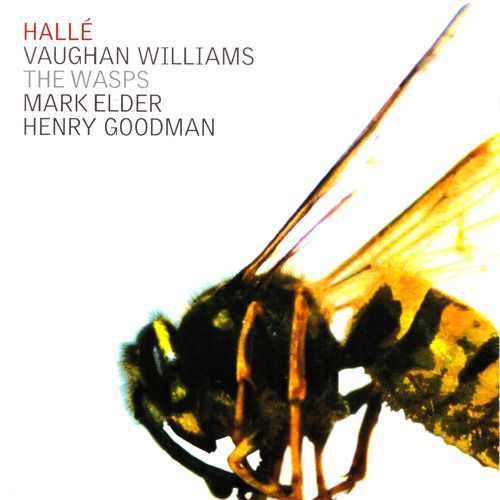
Music Composed by Ralph Vaughan Williams
Played by the Hall� Orchestra
With Henry Goodman (narrator)
And the Hall� Chorus
Conducted by Sir Mark Elder
"Since the work's premiere by the Cambridge University Greek Club in 1909, there have been exactly
two complete performances of Vaughan Williams' incidental music in context for Aristophanes' The
Wasps: a radio broadcast in 1972 and this performance also taken from a radio broadcast in 2005.
One can readily understand why. The score is, relatively speaking, early Vaughan Williams. Just back
from his three-month trip to study with Ravel, the 38-year-old composer had yet to turn out much
music that was characteristic, much less much music that was often performed. But after Ravel's
tutelage, Vaughan Williams was at last ready to embark on his career as a composer and the score
for The Wasps was one of his first fully representative works. Fans of English music probably already
know the work's Overture, a bright and buzzing number with a broad melody at its center, and fans
of Vaughan Williams probably already know the suite the composer extracted from score. But no
one, unless they were listening to the radio in 1972, is likely to know the complete score. Recorded
here with Mark Elder leading an excellent chamber ensemble drawn from the Hall� Orchestra plus
the superb Hall� chorus and gifted character actor Henry Goodman, The Wasps proves to be a score
full of wit -- listen to the musical quotations from composers as disparate as Leh�r and Debussy
-- full of humor -- listen to the musical jokes from bleats to bleeps to blasts -- and, amazingly
enough for a bawdy comedy, full of pathos -- listen to the choral writing in the Parabasis at the
end of Act II: does it not anticipate Vaughan Williams' later Serenade to Music? For dedicated
listeners, this two-disc set will be a joy. BBC Radio 3's sound is crisp, round, and full."
All Music
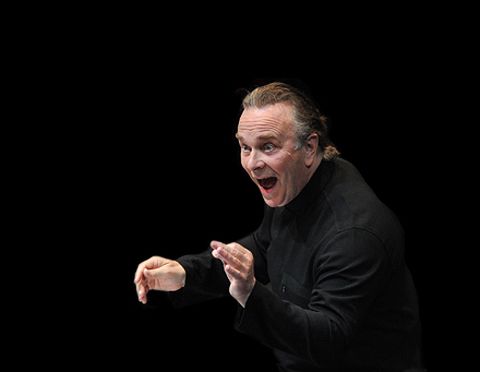
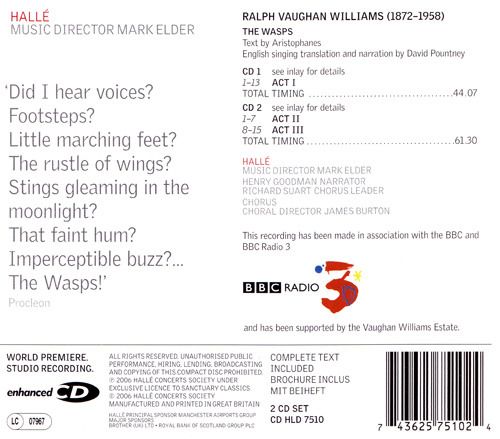
Source: Hall� CD (my rip!)
Formats: FLAC(RAR), DDD Stereo, mp3(320)
File Sizes: 417 MB / 243 MB (FLAC version incl. covers & booklet)
The FLAC link has now expired. No more requests for this, please!
mp3 version -
https://mega.co.nz/#!7M0BRTRL!NUFXlpg0IfADLyN8XCix-Pak6ilhQnqxtqM75pe7w0E
Enjoy! Don't share! Buy the original! And please click on "Like" if you downloaded this album! :)
janoscar
06-02-2015, 10:50 PM
Finally something really vulgar...just love it!
wimpel69
06-04-2015, 05:12 PM
No.769
Many artists have paid their personal respects to the victims of the attacks on September 11, 2001, and to
some extent, their creative tributes should be appreciated in the context of that grim event. Wojciech Kilar
was moved to compose his September Symphony partly as a public remembrance, but also as a means of
working out his private emotions in a form that had long challenged him. Whether or not this work touches the
emotions or provokes thoughts on the tragedy, it is also important to recognize its value as music, and not excuse
its faults for the composer's good intentions. Put simply, Kilar's music works best when it is most serious and elegiac,
as in the two expansive Largos.
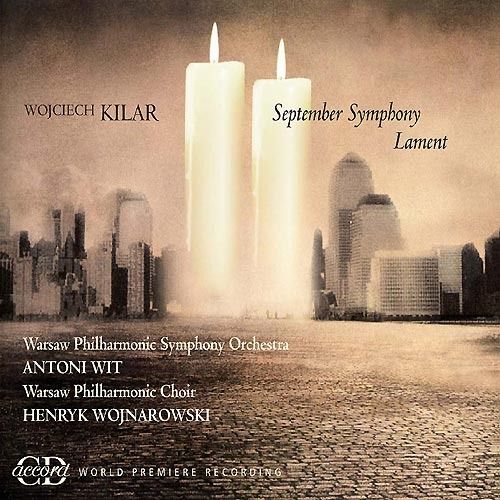
Music Composed by Wojciech Kilar
Played by the Warsaw Philharmonic Symphony Orchestra
With the Warsaw Philharmonic Choir
Conducted by Antoni Wit
"The Symphony is dedicated to 'my friend Antoni Wit' fulfilling a longstanding promise.
It is Kilar's Third Symphony but he has disowned the other two as student works
uncharacteristic of his true voice.
Two sincere works with aspirations to eternity and with the expressed capacity for
eloquence. The modest applause at the end of the Symphony surely echoes poignant
quietude rather than disappointment."
Musicweb
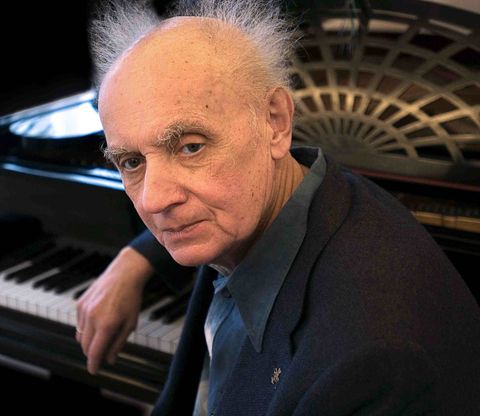
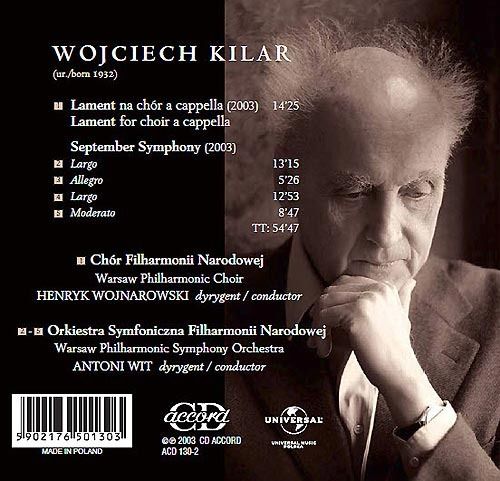
Source: CD Accord CD (my rip!)
Formats: FLAC(RAR), DDD Stereo, mp3(320)
File Sizes: 230 MB / 129 MB (FLAC version incl. cover)
The FLAC link has now expired. No more requests for this, please!
mp3 version -
https://mega.co.nz/#!adk32YDa!40CnhRUKKQMujxeKhdHWJsxYI6-Ixe7O1KIAD4phzGY
Enjoy! Don't share! Buy the original! And please click on "Like" if you downloaded this album! :)
bohuslav
06-04-2015, 09:28 PM
Very emotional music, Kilar was a master of feelings. I own this CD but cannot hear it so often. Sad memories....
LePanda
06-05-2015, 12:46 PM
Witty
thehappyforest
06-06-2015, 05:14 AM
Kilar gets 9/11. He captures the scene from the first responders to the sadness and the confusion. Well done. Thanks Wimpel.
reptar
06-07-2015, 04:24 PM
Such an outstanding thread -- thanks as always!
wimpel69
06-10-2015, 10:04 AM
No.770
The ballet The Drumming of Japan is characteristic of composer Akira Ifukube's personal style:
A musical language derived from Stravinsky, mixed with Ancient Japanese modes, and full of slow processional,
percussion-driven passages alternating with impressionistic writing for winds. If you like his Gojira scores,
you will like this ballet, too.
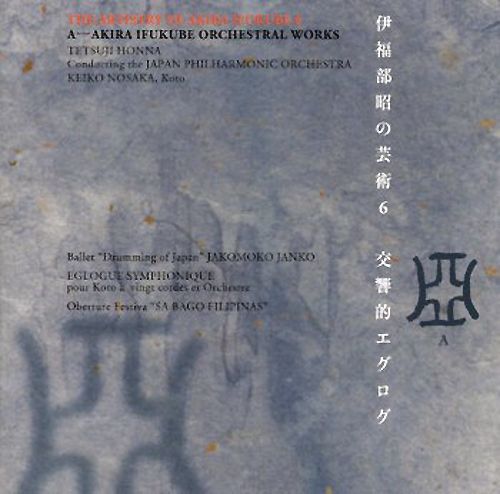
Music Composed by Akira Ifukube
Played by the Japan Philharmonic Orchestra
Conducted by Tetsuji Honna
"This is a very good sounding CD and a pleasure to listen to. The Japan Philharmonic Orchestra
conducted by Tetsuji Honna does an excellent job. The recordings were done in August and
September of 2003. How I wish we had some live concerts of Ifukube material here in the U.S.
that I could attend. This Volume 6 is really packed. With a running time of over 75 minutes
this is one of the longer discs in the series. The music itself varies in tempo. Some is fast
and some is slow but the overall mix is wonderful and never bores you. This CD is a great
addition to anyone's Akira Ifukube collection."
Godzillamusic
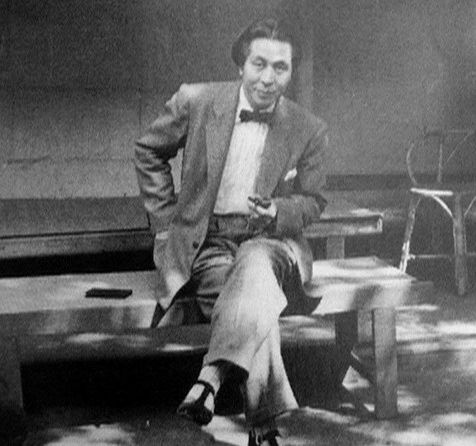
Source: King Records CD (my rip!)
Formats: FLAC(RAR), DDD Stereo, mp3(320)
File Sizes: 267 MB / 172 MB
The FLAC link has now expired. No more requests for this, please!
mp3 version -
https://mega.co.nz/#!GVtjAJpa!tLccUlfkBqCY-l8TDwzqqnfgxbVwaSEZQgQsqdvmLn8
Enjoy! Don't share! Buy the original! And please click on "Like" if you downloaded this album! :)
wimpel69
06-14-2015, 11:48 AM
No.771
Villem Kapp (1913-1964) was an Estonian composer of the neo-romantic, nationalist school.
His work is characterized by a wealth of attractive melodic material, he completed his Symphony No.2
(his final symphony) in 1955, nine years before his untimely death. It is a sweeping, often dramatic
work in the tradition of the "Nordic" symphony.
Though the two never met, Arvo P�rt was profoundly saddened by the death of English composer
Benjamin Britten in 1976. "I had just discovered Britten for myself," recalled P�rt. "Just before his death I
began to appreciate the unusual purity of his music -- I had had the impression of the same kind of purity
in the ballads of Guillaume de Machaut." In his musical memorial to Britten, Cantus in memoriam Benjamin
Britten (1977), P�rt demonstrates the kind of purity of concept to which he aspires in his own music.
Although written during some of Estonia's darkest days, Eduard Tubin's Third Symphony is a majestic,
energetic, proud and self-confident work. It is one of the many excellent works out there by composers who
for whatever reason have never been known to wide audiences. Tubin (1905 - 1982) was one of the first
composers to emerge after Estonia won its independence from Russia after World War I. With his first
symphony (1931 - 1934) he showed natural aptitude for music in the symphonic tradition. The audience
understood that the symphony expressed the idea of personal conquest of despair and hopelessness. It
rapidly gained the nickname "Heroic." This was at first an unofficial subtitle, not invented by the composer.
But by the 1950s Tubin, by then in exile in Sweden, adopted the title when he drew up a list of his works.
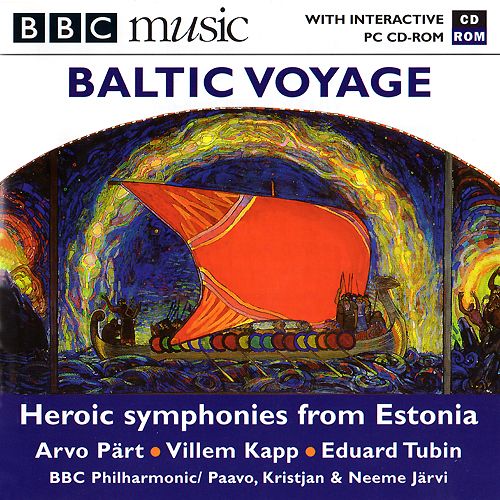
Music by Villem Kapp, Arvo P�rt & Eduard Tubin
Played by the BBC Philharmonic Orchestra
Conducted by Neeme, Paavo and Kristjan J�rvi
"The five stars are for the enterprise and the performances but the works themselves are fine,
rough-hewn traditional four movement symphonies, each with a strongly individual voice. Both
were unknown to me and I'm very glad I invested in the disc blind. The Kapp is the more romantic,
with overtones of early Sibelius: noble string writing and a melting Adagio which will bear repeated
listening, I'm sure. I even detect Elgar in there somewhere, though in an open-hearted, heart-on-
sleeve sort of way. The Tubin is very stirring stuff and I fully intend to explore further in these, for
me, uncharted waters.
Kristjan Jarvi directs a spacious, gracefully modulated performance (Kapp) and the BBC Philharmonic
respond with great passion and commitment in both symphonies. The disc is rounded off with
another Estonian delight, Arvo Part's homage to Britten, which is fairly well known but moving
nevertheless. Highly recommended, if you can get hold of it."
Amazon Reviewer
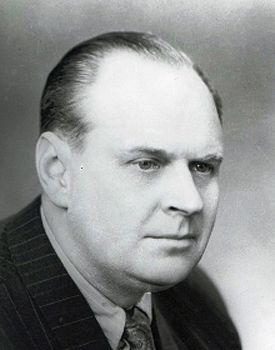

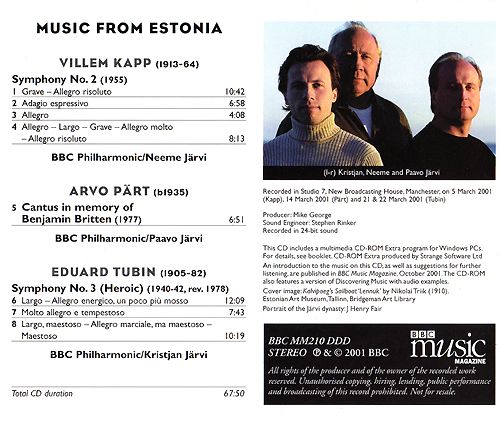
Source: BBC Music Magazine CD (my rip!)
Formats: FLAC(RAR), DDD Stereo, mp3(320)
File Sizes: 309 MB / 159 MB (FLAC version incl. artwork & booklet)
The FLAC link has now expired. No more requests for this, please!
mp3 version -
https://mega.co.nz/#!aJsEnZDQ!ZLfrq7pHKGGTsi4Rh1UEETk9VFQrnmFvKnwrHp1 POso
Enjoy! Don't share! Buy the original! And please click on "Like" if you downloaded this album! :)
wimpel69
06-15-2015, 10:49 AM
No.772
Victoria Borisova-Ollas (*1969) has written a fast-moving, minimalist-influenced piece,
Wings of the Wind. The aggressive opening gives way to some iridescent, tranquil music
which also dominates the work's end.
Daniele Gasparini's (*1975) Through the Looking Glass is based on episodes
from Lewis Carroll's tale. The music is a set of variations on a carillon, which is only heard
in full in the final section.
Stephen Hartke's (*1952) The Ascent of the Equestrian in a Balloon is a good-
humored, jazz-inflected piece, generally fast-moving, with a brief tranquil episode in the middle.
Andrew March's (*1973) picturesque tone poem Marine - � travers les arbres captures
the composer's impressions of a scenic bay in Guernsey. The orchestra is sometimes used to
create naturalistic sound effects.
Carl Vine's (*1954) Descent depicts the grim life of workers in the film Metropolis.
Bluesy laments are mixed with the stomp of the labourer on his tradmill.
The first of Zhou Long's (*1953) Two Poems from Tang depicts a monk in
meditative prayer, while the second is about "eight unruly, tipsy poets", mixing Chinese
folk influences with witty portrayals of insobriety.
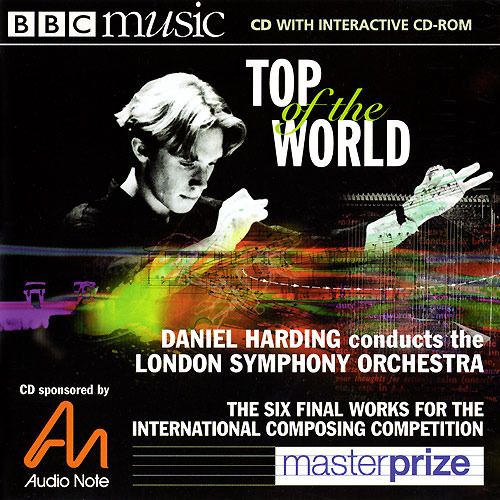
Music by [see above]
Played by the London Symphony Orchestra
Conducted by Daniel Harding
"The Masterprize Competition was a welcome and timely development, its stated aim to find ‘new works
for symphony orchestra that are truly original and have the power to communicate and engage a broad
range of music-lovers’. Fine sentiments, but does this disc of the six finalists add up to more than a
memento of a high-profile event?
Two Poems from Tang is by some distance the most resourceful and accomplished work here; intricate,
fastidious and, in the second poem, with a robust humour, it confirms AA’s recent endorsement of Zhou
Long’s chamber music (Cala, 3/98). Carl Vine’s Descent is as vividly descriptive as its soundtrack origins
would suggest, although its often cliched gestures do not represent this composer’s flamboyant orchestral
style at its most compulsive (for which turn to the first three symphonies (ABC Classics, 10/95). Even so,
it has more substance than Stephen Hartke’s brash and overcalculated show-piece or, for that matter,
Daniele Gasparini’s flashy Alice-inspired cameos, complete with ‘allusions’ of mind-numbing crassness.
Victoria Borisova-Ollas brings some welcome integrity to her engaging study, its assured technique
more than compensating for an (as yet) unfocused idiom. As for the winning entry, Andrew March
offers an attractive if diffuse seascape, its sincerity unquestionable.
Performances and recording mirror the all-round professionalism of the Masterprize concept. Do
buy this disc (you could, of course, obtain it as part of the March 1998 BBC Music Magazine for
less outlay). It sheds valuable light on the nature of present-day orchestral composition, as well
as the wider cultural conditions that can make it happen.'"
Gramophone
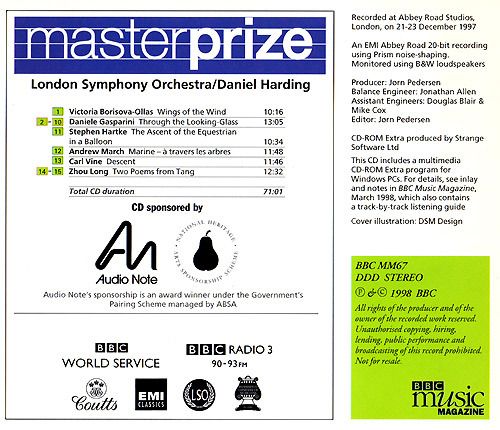
Source: BBC Music Magazine CD (my rip!)
Formats: FLAC(RAR), DDD Stereo, mp3(320)
File Sizes: 290 MB / 171 MB (FLAC version incl. artwork & booklet)
The FLAC link has now expired. No more requests for this, please!
mp3 version -
https://mega.co.nz/#!mREiAByY!ffWryIoTqL7Nb7-I2dcSgbODc_q-LRf5a5-KPDJjb4c
Enjoy! Don't share! Buy the original! And please click on "Like" if you downloaded this album! :)
wimpel69
06-15-2015, 12:03 PM
No.773
Peter Mennin (1923-1983) was one of the youngest of the group of American tonal symphonists
who emerged before the international fad for serial (i.e., twelve-tone) music resulted in their style being
considered out of date by classical music tastemakers. Their music, such as this concise but dramatic symphony,
saw a resurgence well before the end of the 20th century, but Mennin died in 1983, in time to see only the
glimmerings of that revival.
The Symphony No.5 begins with an somewhat self-consciously "important" statement, but this is
soon set off by a long melodic line. The movement is devoted to this line spinning itself into variants, which
then combine in counterpoint. The opening statement makes several appearances, breaking into this self-
developing theme. The second movement is a long melody with the strings predominating. Once again, after
the melody is well established the texture turns polyphonic. The texture thickens and the music grows to
the most intense point of the symphony. The opening calm returns to end the movement quietly.
The third movement is fast and linear: Mennin uses chords much less often than he lets the harmonies
be defined by the relationship of the individual melodic lines. Mostly, the movement is a canon that
constantly shifts its rhythmic basis and its mood. At the end the important-sounding opening of the
first movement is recalled, more by recapturing that mood than by any actual quotations.
Symphony No.6 begins quietly and darkly. The 2nd movement is indicated as Grave and so it sounds
with basses playing a significant role. It sounds like a troubling dream that can't end. This isn't melancholy.
This is doom. The 3rd and final movement is up tempo but not up mood. The despair continues unabated
and then intensifies with brass and timpani. Like Symphony 5, Mennin's Sixth is superbly crafted with no
loose ends apparent. He aims to produce a particular mood and gives the work the character that
successfully conveys it. Mennin is one of those modern composers that you want to explore because
their work is so finished and polished.
While Mennin was working on one symphony for the Louisville Orchestra and had an orchestral
commission pending from the Erie (Pennsylvania) Philharmonic, someone sent him a rough sketch of a
libretto to consider for setting as an opera. The libretto was an effort to capture Herman Melville's great
American novel, Moby Dick, on the musical stage. Reading over the libretto impelled the composer
to return to the original novel and reread it. Rather than stimulating his interest in writing an opera on
the subject, this exercise gave Mennin the subject for this 11-minute orchestral piece, a rare
programmatic piece in the output of this composer of primarily abstract music. There is little that is
specifically ocean-like or whale-like in the music. Careful listeners might liken a particular wind
theme in the Allegro section of the piece to a sea chantey. The piece begins with a sustained note
in the violins, against which the woodwinds play a mysterious chord progression. The chord
progression becomes the basis of a theme, which in turn forms the primary melodic idea of the
whole work. The piece is entitled "Concertato" because it is essentially a mini-concerto for orchestra.
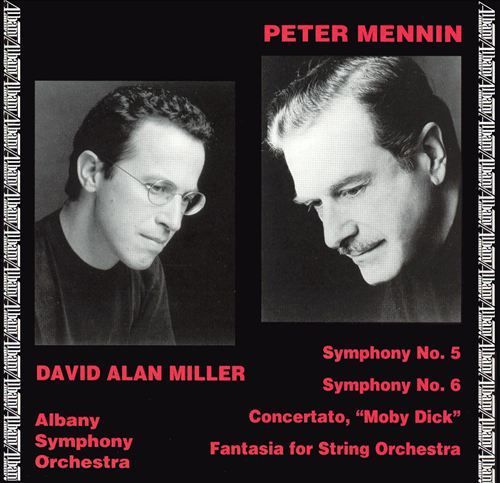
Music Composed by Peter Mennin
Played by the Albany Symphony Orchestra
Conducted by David Alan Miller
"Symphony No. 5 features prominently on one of Howard Hanson's famous Eastman recordings for
Mercury Living Presence, and the Concertato "Moby Dick" (inspired by, but not illustrating the novel)
has had a couple of previous outings on disc. David Alan Miller's performance of the symphony has
every bit as much thrust as Hanson's (timings are almost identical), and even more bravura, while this
is as fine a performance of the Concertato as any. He's especially effective at building those long,
arching lines of melody in both symphonies' central slow movements into intensely passionate
climaxes, and he similarly whips their allegros up into a fine lather. Make no mistake, Mennin's
music "speaks" emotionally, even if the themes aren't of the conventionally tuneful type. The
finale of the Sixth Symphony offers a perfect instance of the composer's ability to create instantly
memorable musical ideas whose development makes perfect logical sense and carries the listener
along however fast, dissonant, or otherwise complex the surrounding musical fabric. Mennin's
achievement has yet to be given the acclaim that is surely deserves, but there's not a note on
this disc that falls one millimeter below the highest standards of craftsmanship, sincerity, and
inspiration. Excellent, realistic sonics complete a very pleasing picture indeed. A must."
Classics Today

David Diamond, Samuel Barber, Peter Mennin, Aaron Copland.
Source: Albany Records CD (my rip!)
Formats: FLAC(RAR), DDD Stereo, mp3(320)
File Sizes: 161 MB (incl. cover & booklet)
Download Link - This album is not available in FLAC. Please click on "Like" when you download the mp3
mp3 version -
https://mega.co.nz/#!vAVhFBZZ!-51E8NH1siiJ3qreFdY_DAyt9iY1nrbGqrm4oZ8Dzc0
Enjoy! Don't share! Buy the original! And please click on "Like" if you downloaded this album! :)
swkirby
06-16-2015, 04:11 AM
Wow! Thanks for the Mennin, wimpel. You are amazing... scott
marinus
06-16-2015, 09:09 AM
Thanks Wimpel, as usual!
wimpel69
06-16-2015, 10:21 AM
I just added a POLL function in the first post of this thread. Please vote on your favorite style(s) - multiple options possible!
lalogrusinfoxfan65
06-16-2015, 07:25 PM
Thank You!
---------- Post added at 01:25 PM ---------- Previous post was at 01:18 PM ----------
Thanks!
wimpel69
06-17-2015, 11:17 AM
No.774
Modern: Neo-Tonal
Edward Gregson is one of Britain’s most versatile and prolific composers, his approachable
and engaging music having gained recognition worldwide. With the BBC Philharmonic, Bramwell
Tovey conducts works that take inspiration from an array of musical and extra-musical sources,
revealing the breadth of Gregson’s musical imagination.
The Horn Concerto, originally written in 1971 for soloist with brass band, is here heard in a recent
orchestral arrangement, played by Richard Watkins, a leading horn player of his generation. Each of
the Concerto’s three movements displays a different facet of the French horn’s character: serious, lyrical,
and playful. Aztec Dances began as a substantial piece for recorder and piano; it was reworked for
flute and piano at the request of Wissam Boustany, who here performs the final version, for flute and ensemble.
Its vivid colours and ritualistic character were inspired by a British Museum exhibition exploring Aztec culture.
Like Aztec Dances, the Concerto for Orchestra was revised twice. Its interim title, ‘Contrasts’, conveys
the essence of the work, varieties of character and orchestral colour being key to it. Dream Song was
commissioned to share a concert programme with Mahler’s Symphony No. 6. The essence of Mahler pervades
the whole of this work which aims to create a parallel musical world to that of the Symphony.
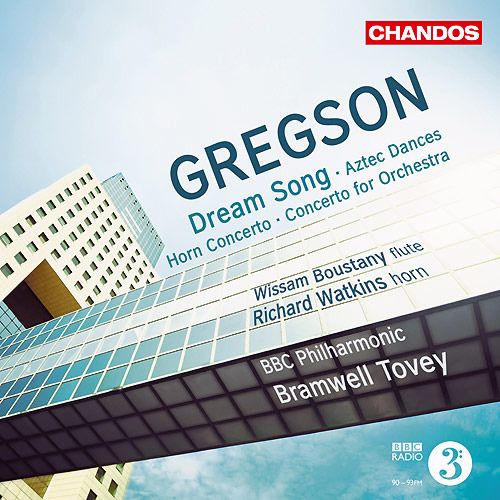
Music Composed by Edward Gregson
Played by the BBC Philharmonic Orchestra
With Richard Watkins (horn) & Wissam Boustany (flute)
Conducted by Bramwell Tovey
"Edward Gregson has a formidable standing as a brass band composer, and his links with
that world are writ large in the Horn Concerto composed with brass band accompaniment
in 1971 and only arranged for full orchestra two years ago. Written for the great Ifor James,
the Horn Concerto is technically virtuoso and substantial in length (over 17 minutes here),
a superior utterance to either of the (delightful) Arnold concertos and the finest British
example after those by Musgrave and McCabe.
Gregson’s style has many resonances of Malcolm Arnold’s style and there are passages in
Dream Song (2010) and the Concerto for Orchestra (1983, given here in its 2001 revision)
which might also have strayed from one of Arnold’s brighter scores – try the central
section of the latter’s opening ‘Intrada’, for instance. Gregson, however, remains his own
man for all that, the structure and internal processes of his works following their own
particular paths. This is most noticeable in Aztec Dances (2013), the most recent work
here, a fizzingly gripping chamber Flute Concerto that originated as a recorder-and-
piano duo in 2010, inspired by the British Museum’s splendid ‘Moctezuma: Aztec Ruler’
exhibition. Gregson was fired by the role of music in Aztec life and has succeeded in
imagining himself – from a 500-year distance – into Aztec ritual."
Gramophone


Source: Chandos Records CD (my rip!)
Formats: FLAC(RAR), DDD Stereo, mp3(320)
File Sizes: 315 MB / 187 MB (FLAC version incl. cover & booklet)
The FLAC link has now expired. No more requests for this, please!
mp3 version -
https://mega.co.nz/#!jRlzQbZS!ofcMHcGzEKtXiHnqB4tbDlTHxwwQ8Veda1JP5A9 dXPY
Enjoy! Don't share! Buy the original! And please click on "Like" if you downloaded this album! :)
wimpel69
06-17-2015, 04:46 PM
No.775
Modern: Avantgarde
Brian Elias (*1948) studied at London’s Royal College of Music with Humphrey Searle
and Bernard Stevens and privately with Elisabeth Lutyens. After five years working at a finance
company in New York he returned to London to re-establish a musical career. The development
of his language can be traced through his major orchestral works.
His bold and dazzlingly inventive The House That Jack Built – inspired by the
rumbustiousness, games and jeers of the playground – is coupled with the elaborate,
intense Doubles – a large orchestral work commissioned by the BBC Symphony
Orchestra; the recording is completed with A Talisman, for bass-baritone and small
orchestra, based upon Hebrew text inscribed on a silver 19th century amulet intended to
protect against the Evil Eye and was given to Elias's mother in 1969 by her uncle, whose
family emigrated from Kurdistan to Bombay in the middle of the 19th century.

Music Composed by Brian Elias
Played by the BBC Symphony Orchestra
With Tim Mirfin (bass)
Conducted by Sir Andrew Davis, Jir� Belohl�vek & Martyn Brabbins
"Though he's in his early 60s, Brian Elias's work list remains relatively modest –
less than 50 pieces, from a creative life of more than 40 years – with orchestral
scores accounting for nine of them. This collection brings together three of the most
recent, two of them BBC commissions heard in the recordings made of their premieres,
the third (A Talisman) a studio account from last year. Elias is a wonderfully accomplished
orchestral composer; every bar of these works has a sense of rightness, of every gesture
and every texture being heard exactly as the composer conceived it, and there's an
energy to much of the writing that gives it buoyancy and sparkle. I'm not sure that the
material of The House That Jack Built is substantial enough to sustain a 20-minute musical
span, but A Talisman, a setting of a Hebrew inscription on a 19th-century amulet, with
the bass voice often set against a solo trumpet, is strikingly intense, while the six sections
of the extrovert Doubles, the most recent of the three pieces, from 2009, are pithy
and perfectly judged."
The Guardian

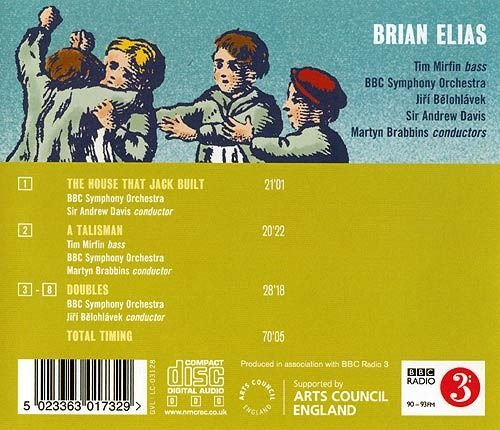
Source: NMC Records CD (my rip!)
Formats: FLAC(RAR), DDD Stereo, mp3(320)
File Sizes: 341 MB / 162 MB (FLAC version incl. cover & booklet)
The FLAC link has now expired. No more requests for this, please!
mp3 version -
https://mega.co.nz/#!WN9S2YLT!_oFlh0oBIyObGfcjEkHt3evmiQD-dfm6R6CUiA83F6Y
Enjoy! Don't share! Buy the original! And please click on "Like" if you downloaded this album! :)
thecornerofthisstreet
06-17-2015, 07:30 PM
Would it be possible to get a reup for Roy Harris's "The Great American Ninth"? Harris is a favorite and I'd love to hear it! Thank you so much for everything, this thread is the best!
wimpel69
06-18-2015, 10:27 AM
wimpel69
06-20-2015, 11:28 AM
No.776
Modern: pre-1945 tonal
"Gebrauchsmusik" is a German term, essentially meaning “utility music,” for music that exists not only
for its own sake, but which was composed for some specific, identifiable purpose. This purpose can be a
particular historical event, like a political rally or a military ceremony, or it can be more general, as with
music written to accompany dance, or music written for amateurs or students to perform. The better
translation would probably be "music for everyday use."
While composer Paul Hindemith is probably the figure most identified with this expression, it
seems to have been coined within the realm of musicology rather than composition. In the late 19th
and early 20th centuries, the modern academic discipline of musicology was formulated by a mainly
German group of scholars who were interested not only in formal development and biographical data,
but also to an extent in the sociopolitical position of music throughout history, and the relationship of
music and musicians to society at large.
The present album features some excellent examples of Hindemith's "Gebrauchsmusik", including
a suite from his silent film score Der Kampf mit dem Berge (here: In Sturm und Eis).
It was one of the first original silent film scores written by an important composer. Hindemith had
met director Arnold Fanck (well-known for his "Bergfilme", i.e. mountaineering melodramas, the
most famous of which is "Der Heilige Berg") by accident, was invited to a screening of the rushes
and offered to write the score. Also included are a Suite of French Dances, selections from music
composed for the Pl�ner Musiktage and, most ambitiously, the first of Hindemith's remarkable
Kammermusiken (No.1, op.24 No.1).
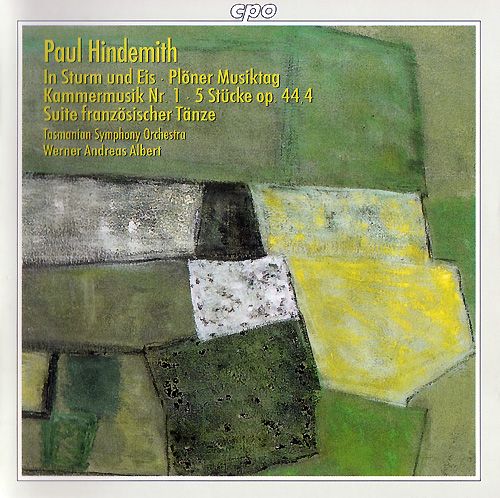
Music Composed by Paul Hindemith
Played by the Tasmanian Symphony Orchestra
Conducted by Werner Andreas Albert
"The 1920 hit film features spectacular images, shot during an ascent of the Lyskamm
mountain in the Pennine Alps and filmed with a handwheel camera at above 4000 metres.
Until recently the film only existed in a heavily edited black-and-white version with
altered intertitles. Fortunately it could be restored to its original length by
comparing Hindemith’s exactly synchronised music with handwritten notes of the
original intertitles in the margins of his 1921 score.
Hindemith’s score for small orchestra impressively documents the dawn of film music
history. The film's restoration and the recording were both made possible by a co-
production of the Friedrich Wilhelm Murnau Foundation, the Austrian Film Archive,
Hessischer Rundfunk and ZDF/ARTE in cooperation with the Hindemith Institute
Frankfurt and Schott Music."

Scene from "Im Kampf mit dem Berge."
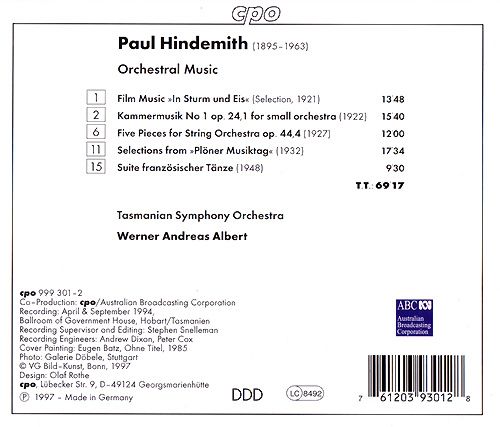
Source: CPO Records CD (my rip!)
Formats: FLAC(RAR), DDD Stereo, mp3(320)
File Sizes: 282 MB / 161 MB (FLAC version incl. covers & booklet)
The FLAC link has now expired. No more requests for this, please!
mp3 version -
https://mega.co.nz/#!DQ0ykC4T!jHbErps2LZT92ak1MNiK2htJhXxeWYgK4RiBc7s aE6Y
Enjoy! Don't share! Buy the original! And please click on "Like" if you downloaded this album! :)
thecornerofthisstreet
06-21-2015, 12:46 AM
Thanks so much for the Roy Harris, and thanks again for all your hard work on these incredible threads!
ansfelden
06-21-2015, 06:55 PM
Really great uploads this week ! Thank you very much for all your incredible work, wimpel69, especially for Mennin's symphonies ! :)
wimpel69
06-22-2015, 03:10 PM
No.777
Modern: Neo-Classical
An inspired collection of 20th century Italian neoclassical composers re-creating the
music of their Baroque forefathers in the advanced harmonic style of their own time.
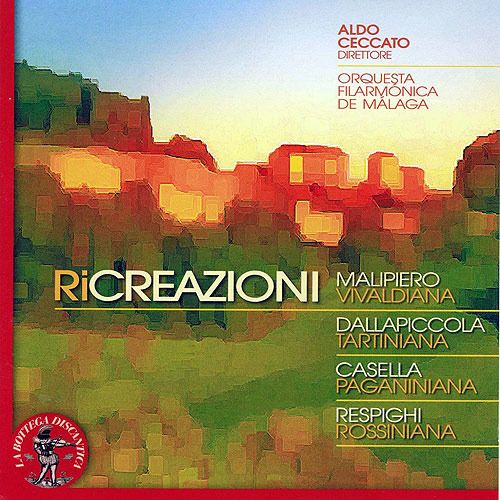
Music by Gian Francesco Malipiero & Luigi Dallapiccola
And Alfredo Casella & Ottorino Respighi
Played by the Orquesta Filarm�nica de M�laga
Conducted by Aldo Ceccato
"Born in Milan, Aldo Ceccato studied at the Conservatorio Giuseppe Verdi and perfected his art
of conducting at the Musikhochschule in Berlin. He then became assistant to Sergiu Celibidache,
with whom he also continued his studies. He is a member of the Accademia di Santa Cecilia, Rome,
and holds an honorary doctorate from Eastern Michigan University. He has been honoured with the
titles of both Commendatore and Grand' Ufficiale by successive Italian presidents, and Cavaliere
di Gran Croce, Italy's highest honour. He has also been awarded the Brahms Medal by the Senate
of Hamburg, one of the highest cultural accolades in Germany.
Aldo Ceccato has previously been Musical and Artistic Director of the Detroit Symphony Orchestra,
the Meadow Brook Festival, the State Philharmonic Orchestra in Hamburg, Norway's Bergen
Philharmonic, the NDR Orchestra in Hannover, the Italian Radio Symphony Orchestra in Turin,
the Spanish National Orchestra in Madrid and the Czech Philharmonic of Brno. He is currently
Music Director of the Foundation I Pomeriggi Musicali of Milan, one of the oldest orchestras in
Italy, succeeding many illustrious conductors over the years (Abbado, Bernstein, Celibidache,
Chailly, Dallapiccola, Giulini, Hindemith, Honegger, Maazel, Maderna, Muti and others). He is
also Conductor Laureate of the Czech State Philharmonic Orchestra of Brno with whom he has
performed at the Prague Spring Festival and toured Europe, including a prestigious visit to
Rome for a special concert in the Vatican for the Pope."
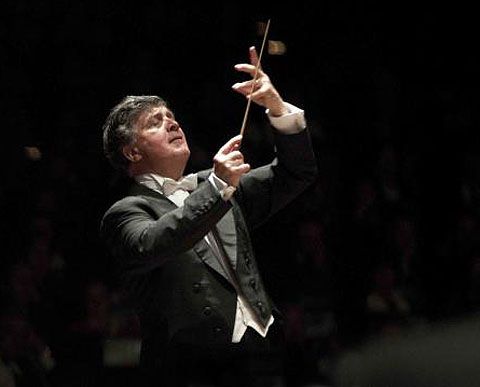
Source: La Bottega Discantica CD (my rip!)
Formats: FLAC(RAR), DDD Stereo, mp3(320)
File Sizes: 353 MB / 191 MB (FLAC version incl. cover)
The FLAC link has now expired. No more requests for this, please!
mp3 version -
https://mega.co.nz/#!DV8RhDKZ!V38LfR_sV8pViWuz36E5-Vkaosov_75M2FBiI95QKIc
Enjoy! Don't share! Buy the original! And please click on "Like" if you downloaded this album! :)
bohuslav
06-22-2015, 06:19 PM
What a nice program, never heard in a concert.
Apropos Ceccato: searching for this

since i heard it first. Have only Prince Holmsky on tape (what a fantastic drive more powerful than Svetlanov)...radio broadcast, what glorious radio times, bygone...
Big thanks for this gem wimpel69.
wimpel69
06-23-2015, 01:30 PM
No.778
Modern: pre-1945 tonal
From 2005 to 2011 the Orchestra of the Dresden State Operetta under Ernst Theis recorded a
body of works known as the Rundfunkmusiken. Almost all the German radio networks had commissioned
these compositions from the best-known contemporary composers toward the goal of developing works adapted
to the technical resources of the new mass medium. The generic boundaries within contemporary music from
the early days of radio were not fixed – as the names of the composers demonstrate: Kurt Weill, Paul Hindemith,
Pavel Haas, Ernst Toch, and Franz Schreker, who went into music history as important innovators
from that era, numbered among the intended circle of composers. The Rundfunkmusiken are like an interface
between popular music and all the many different trends in classical music during the Weimar Republic. They
display hardly known facets of a music created for radio audiences and deriving its strength from the innovations
of that particular period. These musical experiments written for live transmission over nothing more than a
single microphone know no musical boundaries. Dance and jazz occur side by side with classical symphonic
forms and the latest avant-garde innovations. You will hear remarkable radio suites and overtures
by Franz Schreker, Ernst Toch, Eduard K�nnecke, Mischa Spoliansky, Max Butting,
and Walter Braunfels.
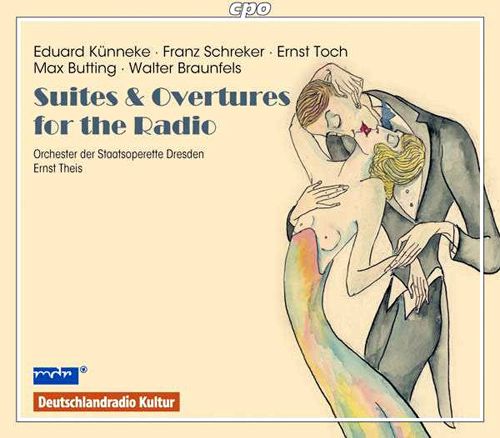
Music by [see above]
Played by the Orchester der Staatsoperette Dresden
Conducted by Ernst Theis
"During the late 1920s, the various newly established German broadcasting companies embraced
new music in particularly enterprising and innovative ways through commissioning some of the
country’s leading composers to write music specifically tailored to the medium. Since audio technology
was rather primitive at that time, it was something of a challenge to come up with substantial works
which also sounded effective on loudspeakers with a limited dynamic range.
Yet judging by the range of music featured in this fascinating collection, composers were inspired to
produce pieces that were both stimulating and attractive. Effectively what we get here is a
marvellous cross-section of the varied stylistic preoccupations that were in vogue during the
last years of the Weimar Republic. The most serious and musically substantial works, reflecting
an interesting cross-fertilisation between late-Romanticism and the so-called ‘new objectivity’,
are Franz Schreker’s resourcefully scored Kleine Suite and Walter Braunfels’s elegant Divertimento.
In contrast, Ernst Toch’s Bunte Suite and the two extended radio works by Max Butting are more
hard-edged, employing a dissonant musical language that is close to Hindemith. Lighter relief is
provided in the charming Charleston Caprice by Mischa Spoliansky and the T�nzerische Suite for
jazz band and orchestra by operetta composer Eduard K�nneke, a melodically appealing work
that proved so popular at the time that it was even commercially recorded by the Berlin
Philharmonic and released during the Nazi era.
Ernst Theis and the Orchestra of the Staatsoperette Dresden appear to be enjoying themselves
enormously throughout the K�nneke and deliver vibrant accounts of the rest of these works.
Strongly recommended."
BBC Music Magazine

At a German radio recording studio, 1920s.
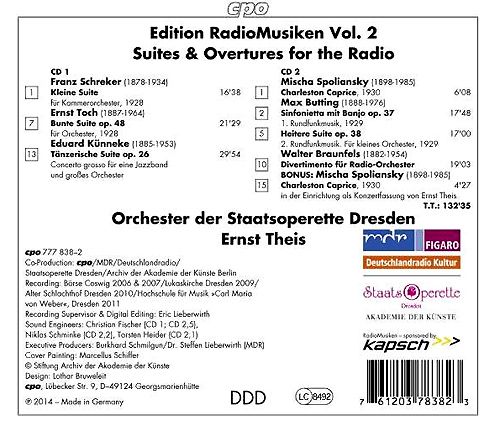
Source: CPO Records CD (my rip!)
Formats: FLAC(RAR), Level: 5 - mp3(320, CBR)
File Sizes: 626 MB / 337 MB
Download Link - The FLAC link has expired. No more requests, please!
mp3 version -
https://mega.co.nz/#!qNMGgY6b!QWy7eUSIZfcy3DbxFrDNFKCcp0hoBBlN9dk8n_P 0k4g
Enjoy! Don't share! Buy the original! And please click on "Like" if you downloaded this album! :)
wimpel69
06-24-2015, 01:59 PM
No.779
Modern: Light Music
Another delightful compilation of British light music lollipops, this time from the "grandmaster"
of the genre, known as "the British answer to Johann Strauss Jr" or simply "the man who wrote
tunes;" Eric Coates. And there's a whole barrel lot of those on this delightful album. See back cover for details.
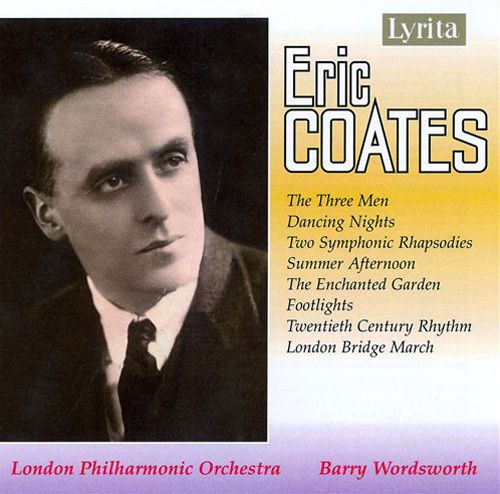
Music Composed by Eric Coates
Played by the London Philharmonic Orchestra
Conducted by Barry Wordsworth
"An entirely new collection delivered with polish and enthusiasm by the LPO under Barry Wordsworth.
I say "new" but it was in fact set down many moons ago (one of the tracks — the rollicking "The
Man from the Sea" from The Three Men suite — even made a tantalising appearance on a sampler
way back in 1993). Still, there can be no real grumbles with the production values (though I'd have
preferred a touch more ventilation and bloom), and Wordsworth directs proceedings with chipper ebullience.
Especially valuable here is the 1938 ballet The Enchanted Garden, Coates's biggest orchestral canvas,
opulently scored and full of the most warm-hearted invention. Other plums include the roistering
"20th Century Rhythm" from the 1941 Four Centuries suite, glittering concert waltz Footlights
(1939) and exuberant 1934 march London Bridge (the follow-up to the previous year's indelible
"Knightsbridge")."
Gramophone

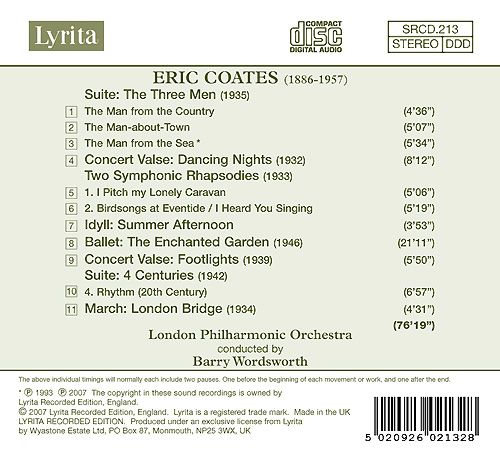
Source: Lyrita Records CD (my rip!)
Formats: FLAC(RAR), DDD Stereo, mp3(320)
File Sizes: 399 MB / 175 MB (FLAC version incl. covers & booklet)
The FLAC link has now expired. No more requests for this, please!
mp3 version -
https://mega.co.nz/#!WFF0iB5b!Yd7diwLn2Zz4nGNfqO72ENxx8Tajns2cykuhPVZ TnMg
Enjoy! Don't share! Buy the original! And please click on "Like" if you downloaded this album! :)
Guideff
06-25-2015, 12:54 AM
Link received for 'For the Radio (Schreker, Toch, K�nneke, Spoliansky, Butting, Braunfels)'. Varied and delightful. Many thanks.
Also thanks for 'Eric Coates: A Compilation'.
Greatly appreciated.
wimpel69
06-25-2015, 09:54 AM
No.780
Modern: Avantgarde
R.I.P. Gunther Schuller (1925-2015)
Gunther Schuller's Spectra takes several ideas that were in the air in the mid 1950s and
merges them into something that is different from the sum of its parts and strikingly original. It was
written for a large orchestra, subdivided into six chamber ensembles - Schuller devised a radically
different seating plan for the musicians that makes performance practical and possible. Each ensemble
can operate independently but also interacts with the others to create one collaborative identity -
what Schuller, in his original program note, called a "web of sound." At a time when stereo recording
was being developed Spectra is also about music experienced in a spatial context. The music creates
and moves across an aural landscape that Schuller delineates precisely. Several other 20th-century
devices appear - vast waves of color, as in Var�se, for example, and the use of changing strands of
color as form and structure. Spectra also synthesizes the opposing manners of Schoenberg and
Stravinsky, 12-tone procedures propelled by driving rhythms. The whole thing adds up to an
astonishing 20-minute firebomb. Adventurous conductors have taken Spectra up as a mid-
20th-century classic. Former BSO music director James Levine, for example, conducted a
student performance as far back as 1968; he later conducted and recorded it with the
Chicago Symphony Orchestra.
Completed in 1955 to fulfill a commission for the Louisville Orchestra, Elliott Carter's Variations
for Orchestra was first performed by that organization in April of 1956. While very much 1950s leading edge,
the work is nonetheless somewhat less severe than some of Carter's other works, some of which were swamped
with jangling and inarticulate percussion effects. Based upon three musical ideas, the work is a group of
nine variations on an introductory allegro theme, all of which resides within a logical structure. Because
variation occurs in time, pitch, and register, the relationship among them becomes mathematical and the
listener may encounter frustration in attempting to sort and count them. The composer's own descriptive
notes may or may not help: "Each variation has its own shape, too, as a mode of musical behavior,
helps define character."
Named after the circle of stars surrounding the sun, John Cage's magnificent Atlas Eclipticalis was
completed in 1961, while the composer was working at Wesleyan University. In the Wesleyan Observatory,
Cage discovered some Czechoslovakian star maps. Guided by chance procedures, Cage placed transparent
sheets over the charts and converted the stars into notes, eventually producing 86 individual instrumental
parts. The parts consist of four pages of five systems, each system lasting 60 seconds. Curiously, each part
is dedicated to a friend, colleague, or family member, including several composers and Cage's own parents
(the second trombone part). Aside from the used of untuned percussion and microtones, pitch is indicated
with traditional staff notation. Duration and loudness are shown graphically, by extended lines and the
size of the note heads, respectively. The general dynamic level is quiet; occasionally, though, notes
explode with great force.
Milton Babbitt's Correspondences is a striking example of the rigid serial (twelve-tone) style
of composition that was regarded as "progressive" in 1950s and 1960s. The music consists almost entirely
of isolated and unpredictable tones, durations, colors, and, dynamics -- momentary sparks and bursts
of sound-color. Surprisingly, if one does listen, without expecting the predictability of melodies, regular
rhythms or dramatic/emotional ideas, this ten-minute succession of tones is highly engaging, a freely
evolving mobile of sparks of musical color. To quote from Greg Sandow again (from another Village
Voice article) Babbitt "frees each note to dance with any partner it finds." There is unexpected joy in
listening to this process work out, particularly in hearing the many completely new combinations
of particular electronic sounds and string sonorities.
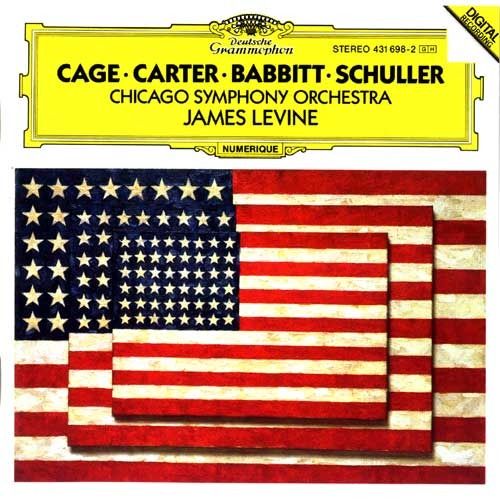
Music by [see above]
Played by the Chicago Symphony Orchestra
Conducted by James Levine
"Carter's Variations may be relatively early (1956), but there's still plenty of inventive energy and
fluctuating pace—in the central variations—to relate the discourse to the exploratory later works.
The general ambience is close to the Schoenberg of the Variations, or even Moses und Aron, but the
built-up tension and drama which explodes with the climactic trombone entry (21'20'') over attacks
on the timpani is reached in Carter's own way. At that point and in other respects this new recording
compares favourably with the old CBS on LP with the New Philharmonia under Prausnitz (7/69—nla),
which represented the Variations on record for many years. The work reflects the serious and
questing aspect of Carter rather than the unbuttoned Holiday Overture.
Another performance of Cage's Atlas Eclipticalis! In a single issue I reviewed no fewer than three
recordings—for three flutes (all Eberhard Blum on Hat Hut, through superimposition); for chamber
orchestra (The Barton Workshop on Etcetera) and for the full group (86 players) with the SEM
Ensemble (Wergo)—this is the work which flopped at a New York Philharmonic Concert in 1964.
Now players obviously relish the open experience of Cage, taking initiatives rather than fulfilling
routines. Perhaps the idea of a work based on star charts appeals. The result in this fourth
recorded realization, which has little connection with the others, is as authentically aimless as
the skies themselves. The playing is at a low dynamic level and there are silences: the timpani
take over from 6'18'' to 6'59'' and end the whole thing..."
Gramophone

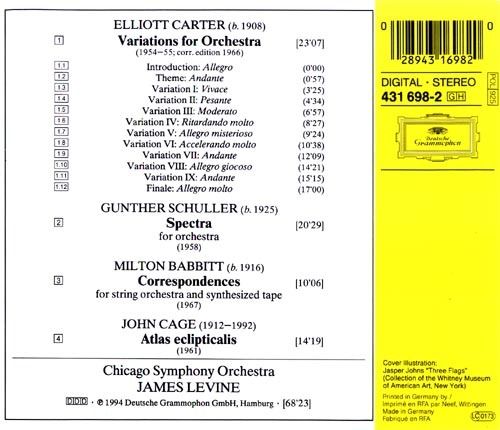
Source: Deutsche Grammophon CD (my rip!)
Formats: FLAC(RAR), DDD Stereo, mp3(320)
File Sizes: 295 MB / 156 MB (FLAC version incl. covers & booklet)
The FLAC link has now expired. No more requests for this, please!
mp3 version -
https://mega.co.nz/#!KUVGnIgB!em5eiox4dc1JE1Fv_x78PXUlcnOwxW4WXXdklKq 3W0c
Enjoy! Don't share! Buy the original! And please click on "Like" if you downloaded this album! :)
wimpel69
06-25-2015, 12:22 PM
No.781
Modern: pre-1945 tonal
If Karol Rathaus (1895-1954) and his symphonic works are largely unknown, it is primarily because
he himself kept them out of the repertoire, either from fear of criticism or from a deep need to keep his
music private. Perplexed by the storm of controversy surrounding the Frankfurt premiere of his dramatic
and harshly dissonant Symphony No.2 (1923), Rathaus withdrew it from performance, and the work
soon fell into obscurity. The tonal and lyrical Symphony No.3 (1942-1943) never entered the repertoire
because of Rathaus' increasing reticence about having any of his works performed. This 2004 release from
CPO presents Rathaus first as a conflicted artist whose worth was not properly appreciated in Europe, then
secondly, as a somewhat happier, though guarded, composer during his American sojourn. The first work
requires some preparation for its stringent modernism and patience for its rather slow pacing, but it is
no more provocative today than, say, a symphony by Shostakovich. The Symphony No.3, on the other
hand, is lush and largely serene, as accessible as any American populist work of the time, and somewhat
reflective of Rathaus' film music.
For another album with music by Karol Rathaus, see >No.71< (
http://forums.ffshrine.org/f92/wimpel69s-could-film-music-classical-corner-work-121898/5.html#post2197398).
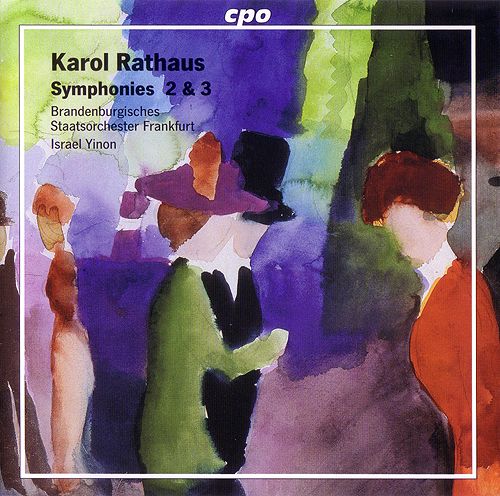
Music Composed by Karol Rathaus
Played by the Brandenburgisches Staatsorchester Frankfurt/Oder
Conducted by Israel Yinon
"Yinon and his Brandenburg Frankfurters seem to have this multilayered music well in hand, projecting
its visionary drama with force and conviction. Recording quality is up to cpo’s usual high standards.
Mention here should be made of recording supervisor and digital editor Horst Gobel, who passed
away not too long after these sessions. This writer corresponded with Herr Gobel—who was also an
excellent pianist deeply devoted to 20th-century repertoire—about our mutual admiration for the
works of Harald Genzmer, Heimo Erbse, and Eduard Erdmann. He was a very sophisticated
correspondent with a truly optimistic disposition; he will be sorely missed on the German recording
scene. Let us hope cpo goes on with his intention to record the stunning Erdmann Third Symphony
as well as their long-delayed integral symphonic cycle of the great Munich musician, Johann
Nepomuk David (1895–1977). Meanwhile, these two overwhelming Rathaus symphonies are
cause enough for general rejoicing right now. A Want List certainty."
Fanfare
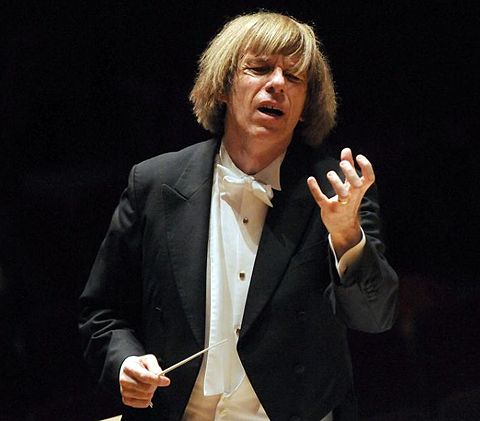
Israel Yinon (1956-2015).

Source: CPO Records CD (my rip!)
Formats: FLAC(RAR), DDD Stereo, mp3(320)
File Sizes: 362 MB / 179 MB (FLAC version incl. covers & booklet)
The FLAC link has now expired. No more requests for this, please!
mp3 version -
https://mega.co.nz/#!qd8kDAIY!dO7RkQDd3QyrNGIwlp_8C_ZvvEFD139MhIGj0T9 wMR4
Enjoy! Don't share! Buy the original! And please click on "Like" if you downloaded this album! :)
wimpel69
06-29-2015, 11:04 AM
No.782
Modern: Neo-tonal
Leonard Bernstein's Concerto for Orchestra, "Jubilee Games," represents an affirmation of the
composer’s Jewish faith. By 1986 Bernstein had certainly become one of the world’s most celebrated musicians.
That year the Israel Philharmonic celebrated its fiftieth anniversary with an extended tour of two continents.
On the programme was a new work in two movements entitled Jubilee Games, commissioned by the
orchestra the previous year. Bernstein commented that he hoped “one day to add another movement or two”.
Opening Prayer, for baritone solo and orchestra, was written to commemorate the gala reopening of Carnegie
Hall in December of the same year and was later appended to Jubilee Games. Bernstein was still not
satisfied and composed Seven Variations on an Octatonic Theme in early 1989. In the tradition of Bart�k’s
great work, Bernstein directed the first performance of his newly-titled Concerto for Orchestra, in four
movements, in Tel Aviv the following April.
The innovative first movement, "Free-Style Events," involves a greater degree of improvisation than in any
other Bernstein piece, and quotes the Old Testament, from Leviticus, in which Moses says: And Thou shalt
number seven Sabbaths of years unto thee, seven times seven years… shall be unto thee forty times nine
years… And ye shall hallow the fiftieth year, and proclaim Liberty throughout the land. Orchestral players
underscore the significance of the number seven (sheva in Hebrew) by whispering or shouting the number
seven times. Later, an exclamation of hamishim (fifty) is followed by fanfare signals from the brass, imitating
the motifs prescribed to the shofar, the traditional ram’s horn used to mark the fiftieth year as a holy year.
Several of these fanfares are heard on pre-recorded tapes. The theme and variation movement, smartly
titled "Mixed Doubles," is slow and sparse, contrasting tone colours with pairs of instruments invoking
the second movement of Bart�k’s work. Bernstein further utilised numerical association in "Diaspora Dances,"
opening in 18/8 time, and alluding to the practice of assigning numerical values to the Hebrew alphabet.
The word hai equals the number eighteen and, translated, means “life”. He said that this unique celebration
of the Hassidic spirit ranged “from the Middle East back to Central European ghettos and forward again to a
New York-ish kind of jazz”. The final movement, now with the title "Benediction," makes use of a melody
first employed nearly a half-century before, in one of Bernstein’s Anniversaries for piano solo.
Ned Rorem’s Violin Concerto was composed in Nantucket during a five-week period in August
1984. In his own words: ‘It could sensibly be called Concertino since it is small scale, or Variations since
each movement depends thematically on the others, or Suite since the six titled sections imply a narrative.
Certainly it is not conceived in so-called sonata form. I conceive all non-sung pieces as though they were
songs—like settings of words that aren’t there. Twilight is formed from a rambling prologue followed by a
slow melody for strings, over which the soloist weaves a countertune like lace or velvet. Toccata-Chaconne,
built on a 23-times-repeated timpani figuration, rises jaggedly from a purr to a thunderclap, then reverses
itself and fades back into a purr. Romance Without Words, the title borrowed from Mendelssohn, is literally
a song from which the text has been excised. Midnight, a microsonic variation, is itself a Theme and
Variations. Toccata-Rondo is in spirit a false waltz, that is, a waltz in 4/4. As to the story, if there is
one unfolded through the six sections, let the sound divulge it. Dawn recalls Twilight, one tone lower,
with the solo and orchestral r�les exchanged.’
An orchestral work by the American composer David Del Tredici (b. 1937), Tattoo was
premiered in 1987 by Myung-Whun Chung and the Royal Concertgebouw Orchestra in Amsterdam,
which commissioned the piece to commemorate the 250th anniversary of the F. van Lanschot Bank
of the Netherlands. Del Tredici's earlier compositions drew upon "Alice in Wonderland" for inspiration;
in 1980, he won the Pulitzer Prize for his "In Memory of a Summer Day" from "Child Alice". Tattoo
is a darker, more agitated work, as the composer explains in this program note: "Tattoo is not Alice.
Those earlier pieces - extravagant, ecstatic and, yes, innocent - are some distance from the darker,
more ominous tread of Tattoo. True, the elaborate orchestral apparatus is still enthusiastically in
place and the harmony remains richly tonal, though now, perhaps, it bears a more dissonant
burden. But what seems a new twist is the music's unrelenting rhythmic drive. Interestingly, a
recurrent image during composition was that of a juggernaut - the huge machine moving forward
with irresistible, terrible force. The orchestra is, after all, a kind of musical monster, with its more
than 100 independently moving parts, each of which, like tentacles, can be given its own life;
or all can be harnessed together to do a composer's bidding."
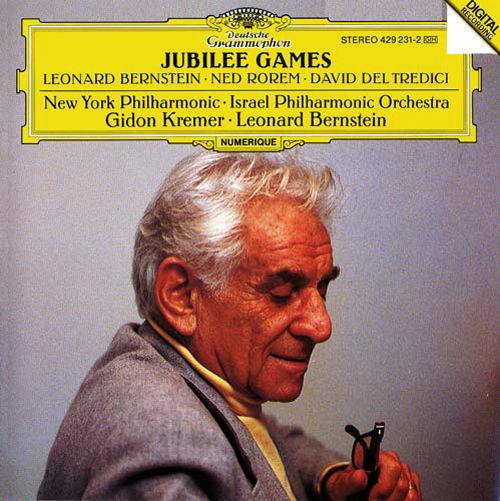
Music by Leonard Bernstein, David Del Tredici & Ned Rorem
Played by the New York & Israel Philharmonic Orchestras
With Gidon Kremer (violin)
Conducted by Leonard Bernstein
"These recordings from 1988 and 89 show that Leonard Bernstein was a vital force as a
composer and as a conductor of American music up until the end of his life. All the works
on this album were written in the 1980's. Del Tredici's Tattoo is a virtuoso showpiece with
a take on Paganini's 24th Caprice. It requires awesome conductorial technique and ears,
which Bernstein has. Rorem's Violin Concerto is a beautiful, meditative piece. I also have
Phillipe Quint's recording of it on Naxos, but Gidon Kremer inhabits the work to a greater
degree. Ned Rorem in his diaries voices his approval of this performance. These two works
feature the N.Y. Philharmonic in Avery Fisher Hall. It is notable how much better the
orchestra played for Bernstein at this time than it did for much of his tenure as its music
director. The sound engineering conveys the feeling of being in the hall to an unusual
degree. Bernstein's Jubilee Games features the Israel Philharmonic, for whom it was
written. It is a clever work, alternately vigorous and meditative, with some beautiful
mood painting in the softer passages. These recordings were not issued until after
Bernstein's death, and they form a fitting memorial to him."
Amazon Reviewer
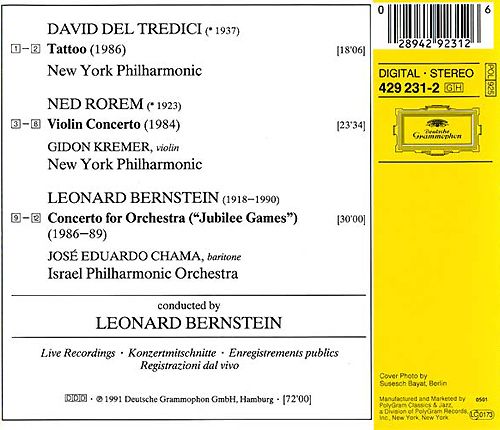
Source: Deutsche Grammophon CD (my rip!)
Formats: FLAC(RAR), DDD Stereo, mp3(320)
File Sizes: 319 MB / 167 MB (FLAC version incl. covers & booklet)
The FLAC link has now expired. No more requests for this, please!
mp3 version -
https://mega.co.nz/#!uJ0SUZQJ!FWacGHw5bsbmOCYq-xgSTwrRiGLbOMd-cY3S0-2Axfc
Enjoy! Don't share! Buy the original! And please click on "Like" if you downloaded this album! :)
wimpel69
06-29-2015, 12:42 PM
No.783
Late-Romantic
Richard Strauss’s own Fantasia from Die Frau ohne Schatten has three rival recordings in the catalogue,
as does Clemens Krauss’s Liebe der Danae ‘symphonic fragment’. But Karl Anton Rickenbacher’s own
extraction of music from Die �gyptische Helena is indeed a rarity. As, of course, is the opera itself, which
makes this an ideal means of exploring a rich vein of music from the Straussian mine. The music may not have
the immediate appeal and memorability of Die Frau or Danae. However, there is still plenty of engaging
melody and typical harmonic audacity displayed in the fragment’s 22 minutes, taken largely from extended
passages of Act I, including what a delightful typo in the booklet renders as a ‘duct between Helen and Menelaus’.
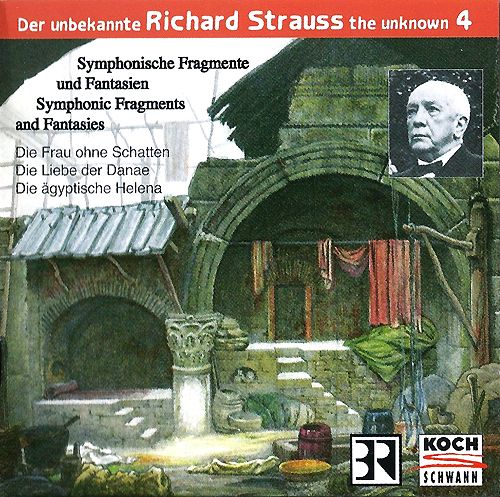
Music Composed by Richard Strauss
Played by the Bamberger Symphoniker
Conducted by Karl Anton Rickenbacher
"Rickenbacher draws full-bodied, committed playing from the Bamberg orchestra. The well-known
orchestral interludes from Die Frau have energy and tonal richness, while the 12-minute
encapsulation of Danae is at times quite overwhelming in its power and authority. The
recorded sound is admirably warm and enveloping."
BBC Music Magazine
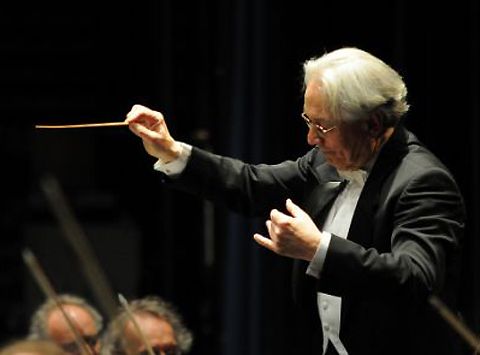
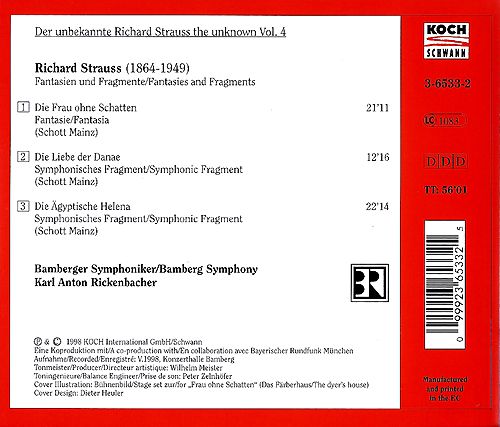
Source: Koch Schwann CD (my rip!)
Formats: FLAC(RAR), DDD Stereo, mp3(320)
File Sizes: 230 MB / 130 MB (FLAC version incl. covers & booklet)
The FLAC link has now expired. No more requests for this, please!
mp3 version -
https://mega.co.nz/#!WJ1mmbpC!XJZEzOeXYXFhQxQUdWsCq9qdViyKMHeCZV82iTm dlak
Enjoy! Don't share! Buy the original! And please click on "Like" if you downloaded this album! :)
gpdlt2000
06-29-2015, 02:22 PM
Lovely Coates! Can't get enough of these musical candies!
Many thanks, wimpel!
elinita
06-29-2015, 03:01 PM
Yes I agree with gpdlt2000,about Coates and his beatiful music.Man about town is glorious! and many more.
lalogrusinfoxfan65
06-30-2015, 06:45 AM
Thank You!
wimpel69
06-30-2015, 05:58 PM
No.784
Modern: Neo-tonal
Havergal Brian's (1876-1972) three-part symphonic poem In Memoriam was composed at Trentham,
Stoke-on-Trent, in 1910 and completed on 27 October of that year. Essentially an extended symphonic study in
the slow-march rhythms which fascinated the composer throughout his career, in the context of Brian’s early
achievement it is a major work. The first part has a six-bar introduction (headed Invocation in the manuscript),
starting with a funeral-march rhythm in solo timpani and swelling out to introduce most of the orchestra (a large
one, with triple woodwind, two harps, and organ). This is the first example of a species of opening Brian was to
use in several of his symphonies, such as Nos. 8, 10, and 13. This initial rhythm, and the nagging triplet figures
which immediately develop from it, have an important secondary r�le to play in the unfolding structure. After a
huge climax, the music gives way to the second part, Andante ma solenne e religioso. In the manuscript this was
in fact designated ‘Religious Scene’, and it begins quietly in muted strings—the four-part texture carries a hint
of choral singing—with an extended theme which appears to quote from the National Anthem.
Despite its original function as a symphonic finale, Festal Dance is in a ternary scherzo form, and is
notable for the ‘advanced’ nature of Brian’s scoring, particularly the use of the percussion ensemble. Although
there are Straussian aspects to this, the general orchestral style is very different, its fierce abandon suggesting
affinities perhaps with the works which Prokofiev was to write over a decade later, such as the ballet Chout.
Five decades and a radical metamorphosis of musical language separate Festal Dance and In Memoriam
from Brian’s Symphony No.17, composed at Shoreham-by-Sea, Sussex, in the last months of 1960 and
completed in early January 1961. Symphony No.17, in one movement, marked a change of emphasis from the
preceding four symphonies towards a relatively smaller scale and an orchestra of more orthodox size—though
Brian retains a large percussion body and pairs the tuba with a euphonium. At the age of nearly 85, he had
much to say, but said it tersely, in a swiftly-moving train of thought. Development is continuous, multitudinous
contrasts of mood and texture following each other with sometimes bewildering rapidity.
The Symphony No.32 in A flat, Brian’s last and indeed the last work of any kind that he completed, is
superficially far more orthodox in layout, in four movements with a slow movement and scherzo placed second
and third respectively. However, the last two movements play without a break and the overall effect is rather
of a structure in two large halves, the first moderately-paced and brooding, the second fast and energetic.
Brian composed this symphony in his final home, a council flat overlooking Shoreham Beach, at the age of 92.
In the way it continues to explore Brian’s inner world and find new landscapes of the mind, and in its characteristic
compound of dark, difficult thoughts and defiant affirmation, Symphony No.32 in the same key as the First
Symphony of Brian’s lifelong hero Elgar—represents a satisfying termination of his creative output.
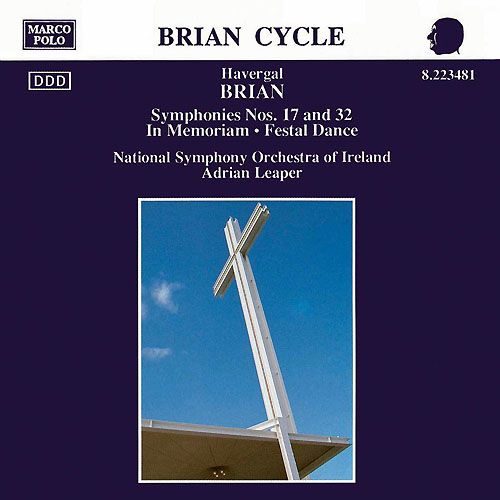
Music Composed by Havergal Brian
Played by the RT� National Symphony Orchestra of Ireland
Conducted by Adrian Leaper
"Originally released on Marco Polo, these fine performances make a welcome return on Naxos. In Memoriam
and Festal Dance are early Brian: tuneful, somewhat heavily scored, and in the latter (which is based on
the tune “Three Blind Mice”, or possibly “Here We Go ‘Round the Mulberry Bush”), quirkily humorous. The
two symphonies are quite different–with their abrupt contrasts, flashes of lyricism, heavy-footed marches,
and evocative bursts of color in strange places, they certainly won’t be to all tastes, but they have great
character and a distinctive voice (in a good way)."
Classics Today

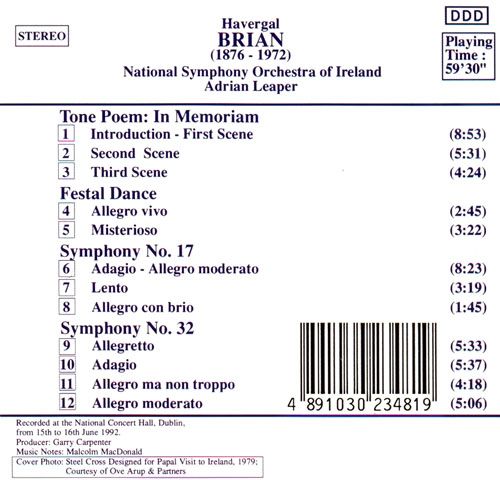
Source: Marco Polo CD (my rip!)
Formats: FLAC(RAR), DDD Stereo, mp3(320)
File Sizes: 253 MB / 136 MB (FLAC version incl. covers & booklet)
The FLAC link has now expired. No more requests for this, please!
mp3 version -
https://mega.co.nz/#!eA8BBRwD!SmFutSJgUBJXpTUn0X3h3Ww8AvbJ93QMEYV4aGP pt3Q
Enjoy! Don't share! Buy the original! And please click on "Like" if you downloaded this album! :)
wimpel69
07-01-2015, 11:09 AM
No.785
Modern: Light Music
The second volume of Dutton's enterprising series on British Light Music Premieres is an
even more colorful lot than the first. There are several odd men out here, some of them not even British.
John Field's Concertino for Flute and Small Orchestra is based on three piano pieces,
arranged and orchestrated by Philip Lane for the flutist Jennifer Stinton. Lane also
provided the arrangement of Rimsky-Korsakov's concert band-original of Variations on a
Theme of Glinka. Another foreigner's music, that of Georges Bizet, was arranged by
Leonard Salzedo for a ballet based on Bizet's Carmen.
Anthony Hedges, Carlo Martelli, Haydn Wood and Richard Addinsell
otoh are fairly well known purveyors of the genre, and are represented on the album by very
typical pieces - some slight, some more substantial. Hedges' work in particular though seems an odd
choice even among the other strange bedfellows. Performances recorded in London and Prague,
mostly under the familiar leadership of Gavin Sutherland.
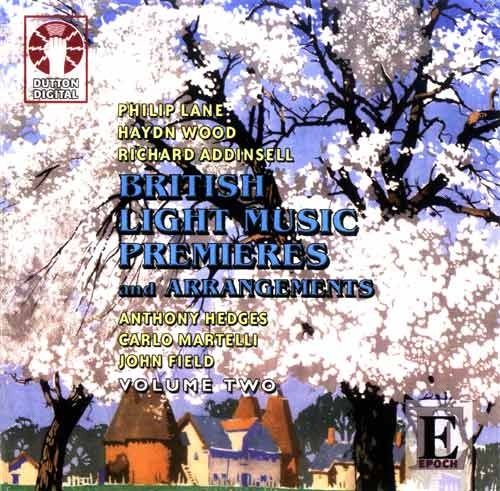
Music by [see above]
Played by the Royal Ballet Sinfonia & City of Prague Philharmonic Orchestra
Conducted by Gavin Sutherland & Julian Bigg
"Although Gavin Sutherland is at least nominally the principal orchestra leader here,
appearing with the Royal Ballet Sinfonia, three orchestra/conductor combinations are
utilized. Neil Thomson leads his own band in three petits riens by film composer Carlo
Martelli and Julian Bigg takes the City of Prague Philharmonic through Leonard Salzedo's
orchestration of the Pas de Deux from Georges Bizet's opera Carmen. Among other
arrangements, one finds Philip Lane's Concertino for flute and small orchestra, based
on three disconnected movements of John Field, which, though credited here to Field,
ends up sounding nothing like him. Lane also contributes an arrangement for oboe
and orchestra of Rimsky-Korsakov's Variations for oboe and military band in G minor
that likewise succeeds handsomely in not sounding anything like Rimsky-Korsakov.
As to the remainder, it is an arrangement that does grab the brass ring among the
pieces collected here, one for orchestra by conductor Sutherland of Richard Addinsell's
brief but thoroughly enchanting piano piece Harmony for False Lovers. Running only
2:40, this is the only work on British Light Music Premieres and Arrangements, Vol. 2,
that unequivocally qualifies as "British light music," and it is a gem, easily the best
thing on the disc. Haydn Wood's British Rhapsody and Lane's Overture on French
Carols are lightweight, but obviously serious in intent, and Anthony Hedges' biting
and largely bi-tonal Festival Dances, Op. 64, aren't "light" in the least."
All Music
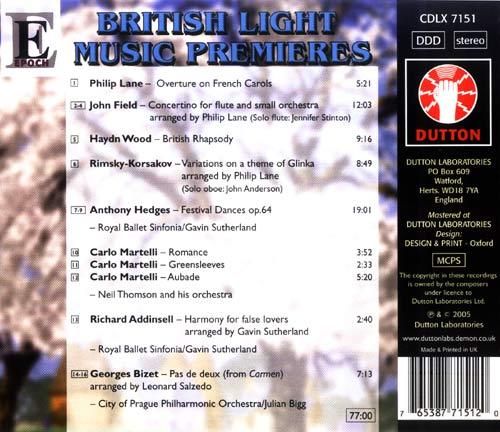
Source: Dutton Epoch CD (my rip!)
Formats: FLAC(RAR), DDD Stereo, mp3(320)
File Sizes: 378 MB / 175 MB (FLAC version incl. covers & booklet)
The FLAC link has now expired. No more requests for this, please!
mp3 version -
https://mega.co.nz/#!LRczkRbD!TOJHT3BnN9BUNDK2FwHniCmnSPEKMGLakHLEE4C FHo4
Enjoy! Don't share! Buy the original! And please click on "Like" if you downloaded this album! :)
booster-t
07-01-2015, 06:54 PM
Link received ... thanks ... the Coates disk is very pleasant music to work to as background
gpdlt2000
07-02-2015, 01:05 PM
Many thanks for the Suites & Overtures and British Light Music vol. 2 links, wimpel!!!
tehƧP@ƦKly�ANK� -Ⅲ�
07-06-2015, 07:58 PM
Everyone, please respect OP and keep politics out of this thread.
It's off topic to music downloading.
Petros, this isn't your thread. Please go to the General Discussion thread if you wish to discuss politics.
http://forums.ffshrine.org/general-discussion/
Further posts about politics will also be deleted.
Thank you for understanding.
elinita
07-06-2015, 09:32 PM
Mod Edit: Do not encourage off-topic discussions about politics, or religion or sports.
This is the downloading section.
You can discuss the music posted or things related to to it.
But you cannot go off-topic and talk about politics or religion or whatever you want.
This section of the forum has lacked a mod for some time but now I am helping.
No one will be spoiled any more.
Take the advice or take it somewhere else.
Any more off-topic or belligerent posts and you will get warnings.
tehƧP@ƦKly�ANK� -Ⅲ�
07-07-2015, 04:19 AM
I encourage members to use the report button if there are off-topic discussions about politics, religion or anything that can raise controversey.
I also implore you to not respond to anyone. It will only provoke more off-topic posts.
Things only need be said once. Leave it to the OP of the thread.
If you wish to convey support, use the "like" button or give reputation.
There's no need to reply and continue the chain of off-topic posts.
Thank you for understanding.
---------- Post added at 08:19 PM ---------- Previous post was at 08:18 PM ----------
This also includes disrespectful behaviour towards other members, including moderators.
elinita
07-07-2015, 04:48 AM
OK,no problem
wimpel69
07-13-2015, 04:22 PM
No.786
Modern: Pre-1945 Romantic
In a friendly competition with his Swedish colleague Natanael Berg, Kurt Atterberg (1887-1974) composed
his Fourth Symphony in 1918. They had decided that each should write a piece lasting no longer than twenty
minutes (a stipulation which neither of them managed to achieve. Atterberg’s symphony, full of humour and wit,
has proven popular and received many performances; its language is open and simple, almost neoclassical.
It also includes numerous quotations from Swedish folk music. The orchestration is attractive and
charming. Sinfonia piccola was first performed in Stockholm in March 1919.
Atterberg was well-established in Scandinavian musical circles when he wrote his Symphony No.6,
which came to be known as the Dollar Symphony because of the major prize it won. He was Principal
Clerk of Sweden's National Patent Office, in addition to his musical life as composer, cellist, critic, and
conductor. His knowledge of intellectual property law made him a leader in organizing the Swedish
copyright organization, STIM, as well as forming the Swedish Society of Composers. Atterberg began
sketching this work early in 1927 in open score. By November he decided to make it a symphony and
had written much of the first two movements. Then Atterberg learned that Columbia Records had
planned to mark the centenary of Franz Schubert's death with a competition to complete Schubert's
"Unfinished" Symphony. But complaints that it would be sacrilege to complete the divine symphonic
torso convinced Columbia to alter the terms of the competition to instead reward the best original
symphony "in the spirit of" Schubert, and had extended the entry deadline accordingly, allowing
Atterberg to enter the 33-minute symphony.
The opening movement, Moderato, is an earnest symphonic structure. The main theme is
lighthearted, but there is considerable musical drama. The movement's coda (written after
learning of the competition) is, if anything, even more conservative than the music of the rest
of the movement. The middle movement, Adagio, is in Atterberg's best vein of Swedish folk-
influenced music and contains a notable clarinet solo. The finale, Vivace, evidently originated as
an idea to write a piece based on an intentionally trivial theme. When Atterberg read the rules
of the competition (which were, as he wrote, practically "an incitement to reactionary music-
making"), and having in mind the pompous style of American advertising, he decided to use
this concept as the basis for a rather sarcastic conclusion.
In 1916, Atterberg was appointed conductor and composer at the Royal Dramatic Theatre
(Kungliga Dramatiska Teatern, or ‘Dramaten’) in Stockholm. In 1918 he was also asked to compose music
for a production at the Intimate Theatre (Intima Teatern, or ‘Intiman’) of Soeur B�atrice
(Sister Beatrice), a Miracle, or mystery play, by the Belgian Nobel Prize winning playwright
Maurice Maeterlinck. He only had space for three musicians, playing violin, viola, and harmonium.
Atterberg reworked his music in 1921 by replacing the harmonium with a string orchestra, and
known as Suite No.3 the work has become one of Atterberg’s most frequently
played compositions. It is a small masterpiece, notable for both its beauty and passion.

Music Composed by Kurt Atterberg
Played by the Gothenburg Symphony Orchestra
With Sara Trob�ck Hesselink (violin) & Per H�gberg (viola)
Conducted by Neeme J�rvi
"In all these performances Neeme J�rvi’s animated conducting style works to the advantage
of the music. His spirited account of the fast music is most exhilarating, but while he maintains
a urgent momentum he is always responsve to the many beauties and natural flow of the
slow sections of these works. It goes without saying that the playing of the Gothenburg
Symphony Orchestra for their Principal Conductor Emeritus is totally idiomatic throughout.
The engineers ... have achieved an open, clear and quite ravishing sound quality ... This
is a most successful release of unfamiliar Scandinavian music that can be wholeheartedly
recommended."
SACD Net
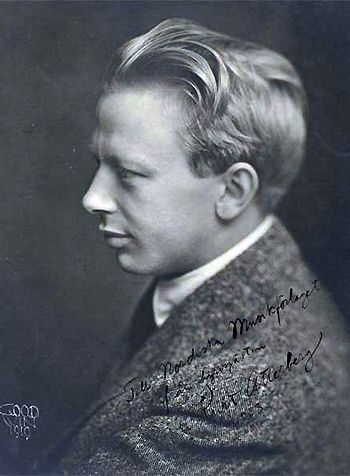
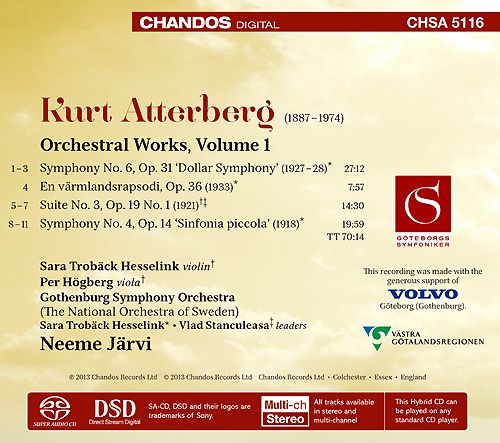
Source: Chandos Records CD (my rip!)
Formats: FLAC(RAR), DDD Stereo, mp3(320)
File Sizes: 318 MB / 177 MB (FLAC version incl. covers & booklet)
The FLAC link has now expired. No more requests for this, please!
mp3 version -
https://mega.co.nz/#!rE12nY4K!Ms_dPScPyDhVaqSyBwguwkofc1QolAKLeI0sk5a W5Fw
Enjoy! Don't share! Buy the original! And please click on "Like" if you downloaded this album! :)
bohuslav
07-13-2015, 05:39 PM
Atterberg and Neeme J�rvi a great symbiosis, hope he conducts all Symphonies in this series. I wait for vol. 3 with Sym. 1 + 5...
wimpel69
07-14-2015, 12:09 PM
No.787
Modern: Light Music
Ernest Tomlinson R.I.P. (1924-2015)
"Born in Lancashire in 1924, Ernest Tomlinson wrote light orchestral pieces which
became a well-loved fixture on radio, television and stage in the decades following World
War II. He had his first piece broadcast in 1949 and six years later, he formed the Ernest
Tomlinson Light Orchestra.
Tomlinson produced a wide range of works – including overtures, suites, rhapsodies and
miniatures. His Little Serenade and Suite of English Folk Dances - particularly the
movement titled Dick's Maggot - are regularly played on Classic FM. In the 1960s he
composed a number of pieces for the test card, including Stately Occasion and
Capability Brown .
“Ernest Tomlinson will be warmly remembered as long as people enjoy listening to
melodic music,” said Classic FM presenter Catherine Bott.
“Light music is all about melody and enjoyment, always beautifully crafted and full
of colour,” she said. “Ernest was among the very best of British light music composers,
his exceptional technical skills allied to a rare gift for melody.”
Tomlinson also composed several symphonic works in a jazz style. In 1966, when
he conducted his Symphony '65 in the Tchaikovsky Hall, Moscow, it was the first
time such a work had been heard in Russia.
"He was a good composer," conductor Iain Sutherland told Classic FM. "His gift of
melody and harmony was backed up by his brilliance as an orchestrator. His music
has been part of my professional life since I started broadcasting 45 years ago
right up to the present."Classic FM
You'll also find music by Ernest Tomlinson >here< (
http://forums.ffshrine.org/f92/wimpel69s-could-film-music-classical-corner-work-121898/9.html#post2212601).
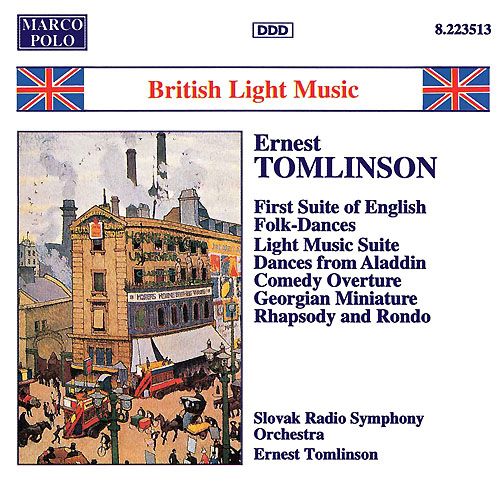

Music Composed and Conducted by Ernest Tomlinson
Played by the Slovak Radio Symphony Orchestra
"Marco Polo offers sound that is as bright, warm, spacious, detailed,
and precisely focused as the performances."
American Record Guide
"This release is one of this writer's particular favourites in a
cornucopia series which never seems to run out of steam."
Fanfare
"Ernest Tomlinson’s orchestral pieces charm by the frothy lightness of the scoring.
The winningly delicate Little Serenade, which opens the disc, is most famous, but
the gentle, evocative Kielder Water, the captivating Canzonet from the Silverthorne
Suite and the Nocturne are hardly less appealing. Love-in-a-mist is as intangible as
it sounds, with the most fragile of oboe solos, and it is not surprising that Sweet and
Dainty has been used for a TV commercial. There is robust writing, too, in the
Folk Dance Suite—but not too robust, although the jolly English Overture begins
with Here’s a Health unto His Majesty and certainly does not lack vitality. The
music is played with much grace and the lightest possible touch by the remarkably
versatile Slovak Radio Orchestra under the composer, and the vivid recording has
delightfully transparent textures, so vital in this repertoire."
Penguin Classical Guide
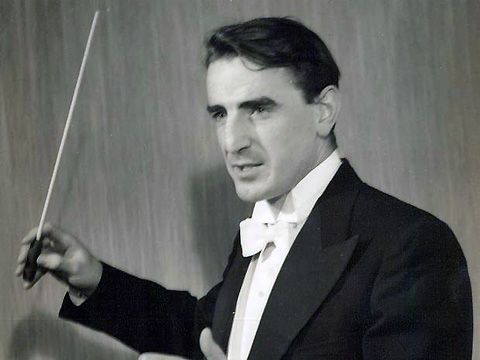
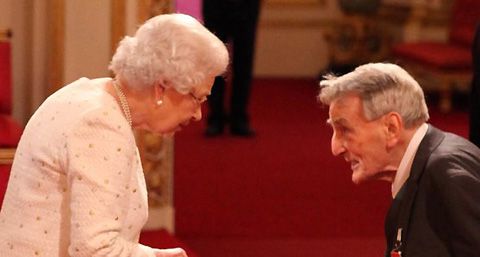
Source: Marco Polo CDs (my rip!)
Formats: FLAC(RAR), DDD Stereo, mp3(320)
File Sizes: 259 MB / 159 MB + 276 MB / 141 MB (FLAC versions incl. covers & booklets)
The FLAC links have now expired. No more requests for these, please!
mp3 versions - Volume 1:
https://mega.co.nz/#!iUMUASIS!zaMTGDMpD-sCUNPPz3mTwCfqluBPw1tUhxBO9Jq3z0I
Volume 2:
https://mega.co.nz/#!CZcSCBbL!9zq4TIIDHlWKEFWAWnAzoqd_eALPV08yqJ5v3ke zUSU
Enjoy! Don't share! Buy the original! And please click on "Like" if you downloaded this album! :)
wimpel69
07-15-2015, 03:03 PM
The FLAC links for uploads Nos. 741-760 have now expired. No more requests for these, please!
gpdlt2000
07-15-2015, 10:29 PM
I am sorry that Tomlinson has passed away. Together with Coates, he is one of the great British Light Music composers. RIP.
wimpel69
07-16-2015, 10:47 AM
No.788
Modern: Avantgarde/Neo-Tonal
Grammy Award-winning composer Michael Daugherty explores three icons of “The Greatest Generation”,
a turbulent period of adversity and achievement in the United States of America spanning the Great Depression
of the 1930s through the Second World War. Mount Rushmore is a dramatic oratorio inspired by the monumental
sculpture of four American presidents carved into the Black Hills of South Dakota. Radio City is a symphonic
fantasy on the legendary Arturo Toscanini, who conducted the NBC Symphony Orchestra in live radio broadcasts
heard by millions across America. The Gospel According to Sister Aimee is an organ concerto inspired by the
rise, fall and redemption of religious celebrity Aimee Semple McPherson.
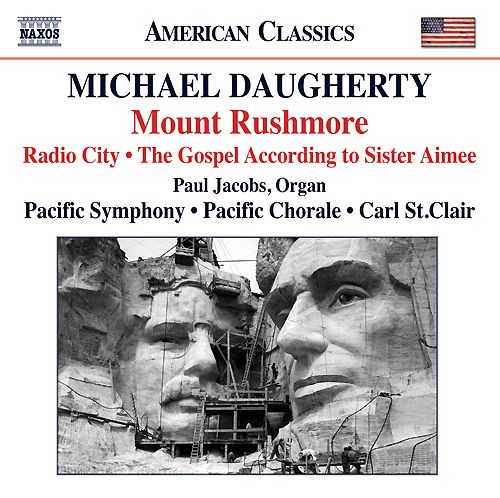
Music Composed by Michael Daugherty
Played by the Pacific Symphony Orchestra
With Paul Jacobs (organ)
And the Pacific Symphony Chorale
Conducted by Carl St. Clair
"Michael Daugherty was born in 1954 in the United States, the eldest of four musical brothers,
he shot to international fame in 1994 with his Metropolis Symphony. Rejecting influences that
emanated from the Second Viennese School, he is travelling down a path that is far more
congenial to audiences, yet is sufficiently progressive to generate new sonorities. The first
work on the disc pictures the sculpture of the four American presidents on Mount Rushmore
in a big and bold score lasting over half an hour and scored for chorus and orchestra, and
text based on the words of the great politicians. Almost as long is Radio City: Symphonic
Fantasy on Arturo Toscanini and the NBC Symphony Orchestra, a work recalling the legendary
live broadcasts that captivated the nation for almost twenty years from 1937, its three
movements using quotations from music he performed—though they are well ‘hidden’. The
final three tracks reflect The Gospel According to Sister Aimee, Aimee Semple McPherson
being a religious personality in the 1930s who, to some, fell from grace in her private life.
Calling on the orchestra for a considerable show of virtuosity, the Pacific Orchestra and its
conductor, Carl St.Clair, obviously relish the challenge. Paul Jacobs is the brilliant organist,
and the big, noisy and hard-hitting sound comes from the orchestra’s home in Costa Mesa,
California."
David's Review Corner
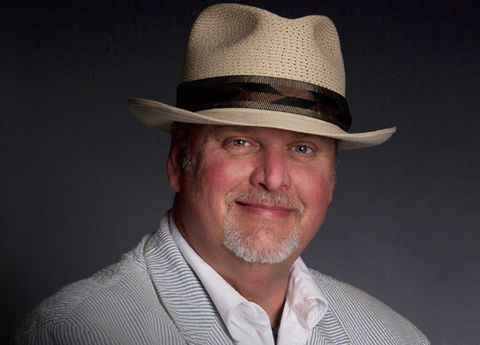
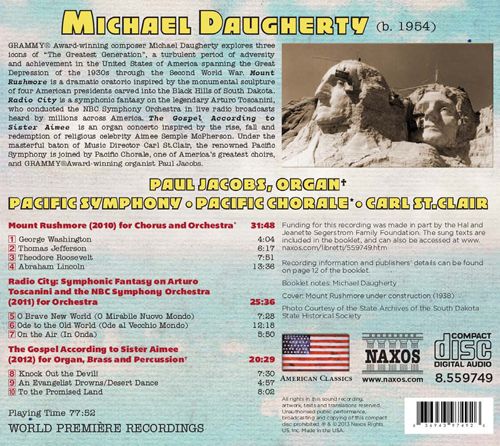
Source: Naxos CD (my rip!)
Formats: FLAC(RAR), DDD Stereo, mp3(320)
File Sizes: 380 MB / 178 MB (FLAC version incl. covers & booklet)
The FLAC link has now expired. No more requests for this, please!
mp3 version -
https://mega.co.nz/#!rF8jiZ7C!Uz5TsLvebv5GmBq6qAmDnhcX-wh6TETGagiKpPOhdQs
Enjoy! Don't share! Buy the original! And please click on "Like" if you downloaded this album! :)
wimpel69
07-16-2015, 02:07 PM
No.789
Late-Romantic
Unjustly neglected today by comparison with his contemporaries Debussy and Ravel, Vincent d’Indy (1851–1931)
nevertheless fully deserved Faur�’s title, ‘The Samson of Music’, for his multifarious and generous-minded work as a
composer, conductor, educationalist and propagandist, which greatly strengthened French musical culture. It was
probably his rabid anti-Semitism that caused the composer his posthumous reputation.
D’Indy had conceived his previous work in symphonic form, Symphonie sur un chant montagnard fran�ais,
Op.25, composed in 1886, as a hymn to the natural surroundings of his Ard�che region. By contrast, the
Second Symphony, of 1902–03, is highly ambitious both in its philosophical scope and in its reflection of
his pedagogical ideas, notably the symbolic importance of cyclic motives recurring across movements. In
accordance with his Roman Catholic beliefs, he deemed the concept of the classical-romantic four-movement
symphony to be analogous to the harmonious architectural structures of the great mediaeval Gothic cathedrals.
A stylistic conflict of tradition and innovation is played out in the symphony with superb musical character and flow.
A patriotic Frenchman as he undoubtedly was, d’Indy was at the same time a lover of the German speaking
world and its culture. Dedicated to his friend Jules Bordier (d’Angers), Tableaux de voyage – an orchestral
version from 1892 of six pieces drawn from the original set of thirteen for piano solo of 1889 – evoke his
impressions during hiking holidays in the Black Forest and Tyrol. Though seemingly simple, they are nevertheless
full of compositional sophistication. A particular feature is the characteristic romantic device of mediant
relationships – unrelated chords and keys a third apart – to create a sense of expansiveness and mystery.
D’Indy preserved three characterful pieces from his incidental music for the long forgotten play Karadec
by Andr� Alexandre in a charming Suite for small orchestra, made in 1890. The march-like ‘Pr�lude’, in G minor,
is based on a spikily rhythmic theme in folk style, the subdominant note raised to C sharp. A slower middle
section brings thematic contrast and reaches a powerful climax as the march tune reappears in augmentation,
in the remote tonality of B minor. The gentle E flat major flute melody of the ‘Chanson’ is treated to contrapuntal
elaboration before reappearing in the horns, violas and cellos. Finally, the theme of the ‘Pr�lude’ is heard in
augmentation, leading to a brisk five-bar coda.
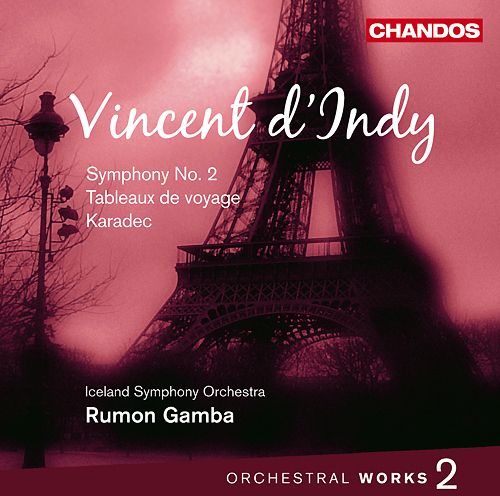
Music Composed by Vincent d'Indy
Played by the Iceland Symphony Orchestra
Conducted by Rumon Gamba
"In the new Chandos recording Rumon Gamba and the Iceland symphony Orchestra capture
d’Indy’s abstract sonic landscape very well, achieving a warmth considerably more
Mediterranean than the climate of Reykjavik. Gamba has a sure sense of how to treat
the work’s characteristic sound, in which d’Indy maintains the definition of individual
instruments or orchestral groups (such as threatening brass) while combining them with
an integrated, rounded blend, which the recorded acoustic fully conveys."
International Record Review
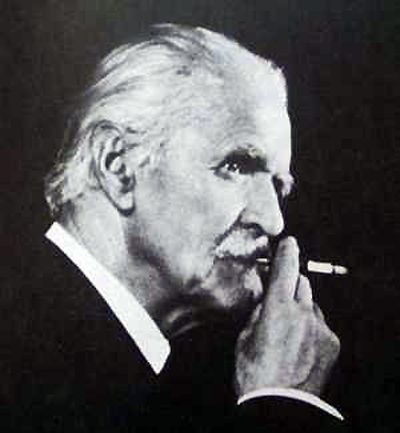
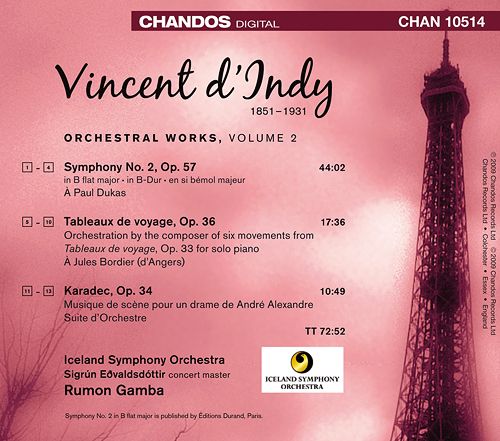
Source: Chandos Records CD (my rip!)
Formats: FLAC(RAR), DDD Stereo, mp3(320)
File Sizes: 266 MB / 167 MB (FLAC version incl. cover & booklet)
The FLAC link has now expired. No more requests for this, please!
mp3 version -
https://mega.co.nz/#!DdMhwSKB!-ZZTulKiFJIc934KX_0hAVOAYHuTMPxF-CXRs7It-fI
Enjoy! Don't share! Buy the original! And please click on "Like" if you downloaded this album! :)
bohuslav
07-16-2015, 03:31 PM
This is a great series. All orchestral pieces without french orchestras, what a shame for the french orchestra buisness. But the Iceland SO is in very good condition. Thanks Rumon.
dsch1956
07-16-2015, 05:32 PM
Akashi San
07-16-2015, 06:31 PM
I find the whole Belgium school of composers (Franck, d'Indy, Pierne, etc.) to be quite underrated - but perhaps for the chamber/solo music alone.
Anyone interested in dramatic chamber music might want to check out d'Indy's pupil Lekeu. I find his music to be even higher quality than those of his teacher's or Franck's (except Franck's violin sonata). Too bad Lekeu died so early... There's also Biarent who wrote one of the best piano quintets and cello sonatas I've heard. There's something immensely attractive about dramatic chromaticism and scale distilled into intimate chamber forms. Sturm und Drang with a distinct sense of longing? I don't know...
elinita
07-16-2015, 09:31 PM
I agree with Akashi about the Belgium School ,even in the symphonic works of Biarent,De Boeck,Benoit,Marsick,etc..Beautiful longing music...
Darius Freebooter
07-17-2015, 01:11 PM
Many thanks for the Atterberg/J�rvi, wimpel.
wimpel69
07-17-2015, 01:42 PM
No.790
Modern: Neo-Classical
The pairing of Francis Poulenc and Reynaldo Hahn on this album may seem contrived merely because
of biographical parallels between the two men, for their musical approaches and styles are quite different, if not at
odds. Poulenc's neo-Classical, dry, sarcastic wit of the Aubade are a world away from Hahn's pretty, even precious,
Romanticism, which is unabashedly on display in La bal de B�atrice d'Este. However, the discerning listener may
find in Poulenc streaks of Hahn's pensiveness and languor, which his comic antics never completely conceal; there is
in Hahn a buoyant, diatonic tunefulness that is readily found in Poulenc. (Interestingly, some of Poulenc's own adaptations
of Renaissance music bear a remarkable similarity to Hahn's antique pastiches in this ballet.) Furthermore, their
fondness for unusual chamber combinations is striking, and the transition from the Aubade to La bal de
B�atrice d'Este is not at all jarring because they both share the charm and ambience of the salon orchestra.
Coupled with Jacques Ibert's edgy Concerto for Cello and Winds and his colourful, brilliantly
scored symphonic suite Paris and the 5th Chamber Symphony by Darius Milhaud.

Music by [see above]
Played by the Harmonie Ensemble New York
With James Kreger (cello) & Ralph Votapek (piano)
Conducted by Steven Richman
"Harmoniemusik" is music for classical wind ensemble. Harmonie Ensemble New York is something
altogether larger and more diverse. Founded in 1979 by conductor and music director Steven Richman,
today the Ensemble encompasses every form of performance from chamber ensemble to symphony
and chamber orchestra. Harmonie Ensemble New York has a broad and highly eclectic repertoire that
not only ranges from classical to contemporary, but includes symphonic jazz, and spirituals as well.
The group's top-flight, highly versatile New York musicians are hand-picked from the classical and
jazz worlds by Maestro Richman.
The Ensemble's uniqueness derives in part from Richman's success at uncovering rare gems,
original orchestrations, lesser-known works and historic arrangements, including chamber and
symphonic works. The group also produces and performs the annual international Dvor�k Day
Concerts, and for many years presented the closing gala orchestral concerts at New York's
Lincoln Center Out-of-Doors Festival. The versatility of Harmonie Ensemble New York (HENY)
can be seen in the diversity of composers celebrated in the historic concerts which
it has performed."

Reynaldo Hahn.
Source: Music & Arts CD (my rip!)
Formats: FLAC(RAR), DDD Stereo, mp3(320)
File Sizes: 277 MB / 158 MB (FLAC version incl. cover)
The FLAC link has now expired. No more requests for this, please!
mp3 version -
https://mega.co.nz/#!vVFGQByR!6_Uyb6Faz8-SzXYdrKPqF-WTOehCEva3uEMOTV3NlSM
Enjoy! Don't share! Buy the original! And please click on "Like" if you downloaded this album! :)
wimpel69
07-17-2015, 04:33 PM
No.791
Modern: Neo-Tonal
Internationally renowned and award-winning composer Salvador Brotons brings classical music
into the here and now, depicting our contemporary world in his Fifth Symphony. Its first three movements
are musical representations of the more negative aspects of the human condition, before the slow, final
section offers a positive resolution. The Oboe Concerto brings out both lyrical expressiveness and
virtuoso thrills from the soloist, and the Four Pieces for String Orchestra was the prizewinning work
which brought acclaim and recognition to Brotons at the age of seventeen.
Brotons on his Symphony "Mundus Noster": "Composed during the summer of 2010 and
commissioned by the Orquestra Simf�nica de Barcelona Nacional de Catalunya, Symphony No 5
‘Mundus Noster’ has a form nearer to that of a symphonic poem than to pure music. With the intention
of establishing a closer communication with the listener, I have chosen to present situations of our
contemporary world in a musical context. In the first three movements I have sought to represent
objective realities and situations of our contemporary society. The last movement, however, is a more
personal vision on how to confront our surroundings from an individual perspective. Instead of labelling
the movements with Italian expressions of tempo, I have preferred to encapsulate the situations by
expressing them through specific titles."
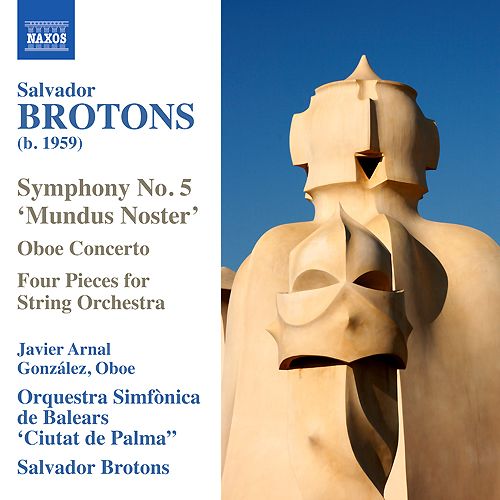
Music Composed and Conducted by Salvador Brotons
Played by the Orquestra Simf�nica de Balears ‘Ciutat de Palma’
With Javier Arnal Gonz�lez (oboe)
"Music from the Spanish composer and conductor, Salvador Brotons, in three world premiere
recordings of music written in the present decade. Born in 1959 into a musical family, he first
studied flute with his father, continuing his education at the Barcelona Conservatory with Xavier
Montsalvatge as his composition mentor. Though his works have received many awards, it has
been as a conductor, both in North America and Portugal, that he has become best known. The
opening movement of the Fifth Symphony marks out his world of modern tonality, far removed
from the dead-end road of Second Viennese School atonality. It is a work that looks at life in the
21st century, each section being given ‘meanings’, the brass of the first movement representing
‘power/wealth’, the waltz of the second movement points to ‘hypocrisy’, and so forth. The result
is highly descriptive, and if the hard-hitting style of Shostakovich appears, so do hints of Mahler
and Hollywood as we eventually reach ‘hope’. The composer writes that the Oboe Concerto
works equally well as an Sonata or as three individual pieces. Surrounded by a very active
opening movement and a brilliant final Tarantella, the sad central Berceuse has some French
ancestry. Only qualifying for inclusion as a 21st century classic by virtue of a recent revision,
the Four Pieces for String Orchestra was the work that brought Brotons to international
attention back in 1977. Again with descriptive titles, it is often a powerful and extremely
likeable score. With the composer conducting the fine orchestra from the city of Palma on
the Mediterranean island of Mallorca, we can take these as benchmark performances, the
very nimble soloist, Javier Arnal Gonzalez, being the orchestra’s principal oboist. Very
punchy sound."
David's Review Corner
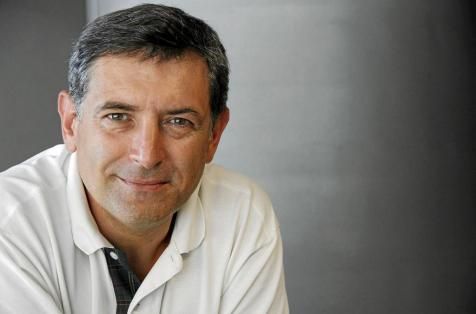
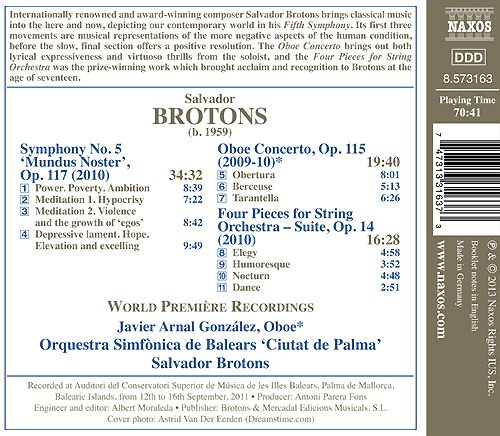
Source: Naxos CD (my rip!)
Formats: FLAC(RAR), DDD Stereo, mp3(320)
File Sizes: 293 MB / 163 MB (FLAC version incl. covers & booklet)
The FLAC link has now expired. No more requests for this, please!
mp3 version -
https://mega.co.nz/#!SEEyHIba!yiz7BtNBlvimcF4JwxFc9_MwnDjpVlLceWMiXNg Xhlg
Enjoy! Don't share! Buy the original! And please click on "Like" if you downloaded this album! :)
Guideff
07-17-2015, 05:40 PM
sorry to say, but 790 Salute to France (Hahn, Ibert, Poulenc, Milhaud) says 'Enter decryption key'.
By the way, a massive thanks for 787 'Ernest Tomlinson: Suites of Fok Dances, Comedy Overture, Aladdin, Light Suite, etc' and also for 785 British Light Music Premieres, Volume 2. Excellent.
wimpel69
07-17-2015, 05:48 PM
sorry to say, but 790 Salute to France (Hahn, Ibert, Poulenc, Milhaud) says 'Enter decryption key'.
Fixed.
wimpel69
07-20-2015, 03:47 PM
No.792
Modern: Light music
Archibald Joyce was known as ‘the English Waltz King’ and ran a very successful society
band playing for the very best balls and parties throughout the country in the years before
and after the First World War. He also composed many waltzes and other pieces that were extensively
played and recorded. Of the waltzes, Dreaming was the most popular, and a work like Song d’Automne
was even recorded by jazz legend, Sidney Bechet. Unlike his contemporaries Ket�lbey, Haydn Wood
and Eric Coates, however, he found it hard to adapt to the changing times and never wrote the suites
and characteristic pieces that would have enhanced his career. The waltz, A Thousand Kisses,
was so entitled following a remark by a friend at the sight of a beautiful woman coming into the
room - “she’s worth a thousand kisses!” The piece was obviously a known favourite of Charlie
Chaplin who included it in the music soundtrack he later added to his silent classic, The Gold Rush.
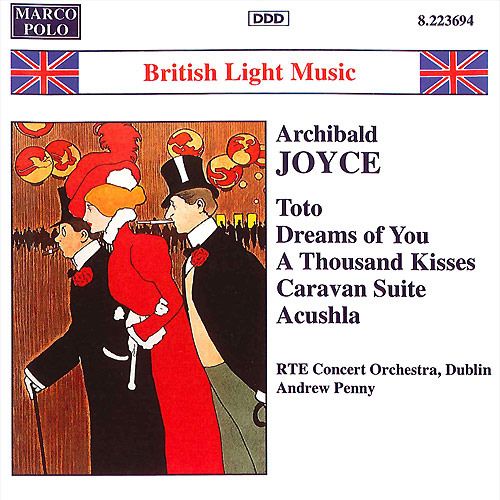
Music Composed by Archibald Joyce
Played by the RT� Concert Orchestra
Conducted by Andrew Penny
"Archibald Joyce’s fleeting international fame as ‘The English Waltz King’ link him almost
indissolubly with the Edwardian ballroom. The waltzes that particularly earned him his
reputation – Dreaming, Songe d’automne and A thousand kisses – form the cornerstone
of this Marco Polo collection, and it is the impression of the opulence of an Edwardian
orchestra and ballroom that makes this collection so enjoyable. Most of the pieces here
are in waltz-time, with just a few in other tempos. There is, for instance, the rousing
Prince of Wales march, the march two-step Brighton hike, and a quite delightful polka
Frou-Frou. For those whose memories go back as far as mine, these last two evoke
the recollection of the ‘old time dance orchestras’ of the 1940s and 1950s for which
they were evidently composed.
In more ambitious vein is the 1916 stage score, Toto, from which we have a selection
newly adapted by Philip Lane, and the three-part Caravan Suite of 1926. One way
and another I confess that I did not expect to enjoy this CD anything like as much
as I did. There is an irresistible innocence, grace and charm to the music that clearly
captivated Andrew Penny and the RTE Concert Orchestra, and which they in turn
succeed in capturing quite magically for the listener.'"
Gramophone

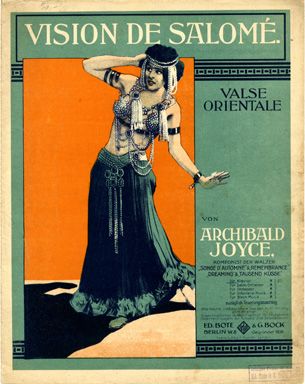

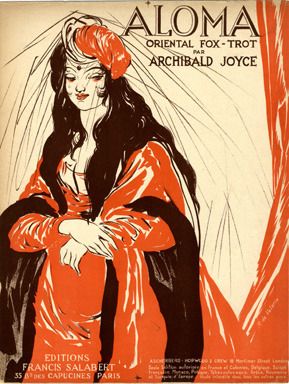
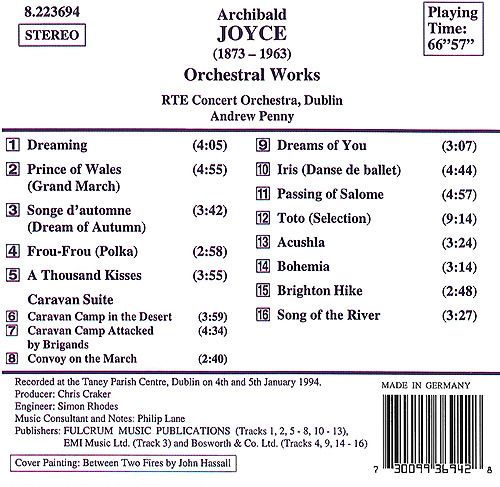
Source: Marco Polo CD (my rip!)
Formats: FLAC(RAR), DDD Stereo, mp3(320)
File Sizes: 319 MB / 152 MB (FLAC version incl. covers & booklet)
The FLAC link has now expired. No more requests for this, please!
mp3 version -
https://mega.co.nz/#!Xd10lKwT!RVebLxlZblTt2s9F4hmFvTWshMcmw9fscA5TmNR lb_A
Enjoy! Don't share! Buy the original! And please click on "Like" if you downloaded this album! :)
Inntel
07-24-2015, 11:31 PM
I haven't kept up so I've missed a few great posts. Keep up the good work, these are so fascinating. It's a wonder these aren't performed more often or more well known. Thank you for multiple albums over the past few months.
lalogrusinfoxfan65
07-26-2015, 07:03 PM
Thank You!
wimpel69
07-27-2015, 03:23 PM
No.793
Modern: Tonal
One of the most popular of Malcolm Arnold's nine symphonies, the Symphony No.3 was commissioned
by, and is dedicated to, the Royal Liverpool Philharmonic Society. John Pritchard conducted the Royal Liverpool
Philharmonic in the work's premiere performance at London's Royal Albert Hall on December 2, 1957. Arnold has
cited the music of Jean Sibelius as being an important influence on his own compositions, and the thematic relationships
between the three movements of Arnold's Third Symphony are reminiscent of similar processes in some of the
Finnish composer's larger works. The first movement of the symphony, starting at an Allegro tempo, opens with a lyrical
theme played by the violins and violas, with woodwind support and nervous pizzicati underneath. Ideas pass mercurially
from instrument to instrument. Then a lovely new theme is introduced by the oboe, followed by other solo winds. This
new theme is juxtaposed with the more anxious setting of the first, leading to the development section. These same
two themes reappear as the movement abruptly speeds to a stormy Vivace concluding section. The second movement,
marked Lento, has been described by the composer as "elegiac in character." It is a passacaglia, a set of 20 variations
on a slow, dissonant chorale-like theme. More overtly tuneful than either of its predecessors, the third-movement
finale opens with playful woodwinds and a humorous "oompah" accompaniment. Starting at a brisk Allegro con
brio, the music speeds to Presto for the forceful coda.
The Symphony No.4 is unusual in several respects: it features catchy, pop-oriented themes; its
scoring requires an exotic array of percussion instruments, including tom-toms, bongos, and marimbaphones;
and it has a genuine sense of humor, an element often missing from large orchestral scores from the latter
half of the twentieth century. Moreover, it is quite accessible for the listener throughout all of its 40-minute
or so length. The first movement, marked Allegro-Poco pi� mosso-Tempo primo, opens with ascending and
descending scales played in opposite motion, making up an important element here and later in the symphony.
The main theme is a leisurely, simple, somewhat Stravinskyian creation of neo-Classical character. A second
theme, lively and pop-like, is played to exotic, jazzy accompaniment. The central part of the movement
features imaginative thematic development and much conflict, with passages of rhythmic, jabbing brass
and insistent, pounding drums. There follows a reprise, but with considerable changes, and the movement
quietly ends. The ensuing Scherzo (Vivace ma no troppo) is largely subdued and lightly scored in its humorous,
often playfully menacing music. Lasting about five minutes, it is reminiscent of the spirit, though not style,
of the Scherzo of compatriot Vaughan Williams' war-era Symphony No. 5. The third movement, Andantino,
exudes a rich sense of lyricism in its two themes, but exoticism surfaces again in the percussion writing.
Tension accrues and the music works up to a powerful climax before returning to the generally serene
mood dominating the movement. The Rondo finale features a busy, playful fugal main theme and a slower,
more sedate alternate one. The ascending/descending scale from the first movement also reappears here.
After the themes are developed, a boisterous, somewhat Ivesian march seems to come out of nowhere to
disrupt the proceedings. But the fugal theme returns to triumphantly close out the symphony.
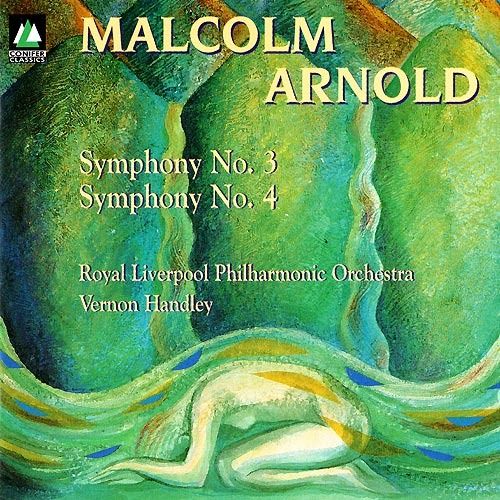
Music Composed by Malcolm Arnold
Played by the Royal Liverpool Philharmonic Orchestra
Conducted by Vernon Handley
"Sober, strong, and staid, Vernon Handley's conducting is a conduit through which the composer's
music flows. His Edward Elgar has honest, idealistic sentimentality. His Vaughan Williams has mystical,
humanistic integrity. And his Malcolm Arnold has power, depth, and irrepressible vitality. This doesn't
mean that Handley doesn't have a strong artistic personality. But Handley conducts with the musical
equivalent of a paucity of adjectives and especially adverbs. Handley is the Hemingway of conductors,
a conductor who lets the nouns and especially the verbs do the work.
In this recording of Arnold's Symphony No. 3 and No. 4 with the Royal Liverpool Philharmonic,
the results are sublime and ridiculous because the music is itself sublime and ridiculous. Arnold's
Third is as great an English symphony as has ever been composed and its power, depth, and ferocity
have never been better served in recordings. Anyone who loves great English music will love this work
and this recording. And then there's the Fourth, a work that does more then flirt with banality, it
embraces it with both arms and gives it a wet kiss. The Allegro's big tune is the ironic theme for an
imaginary Ealing comedy. The Vivace ma non troppo is a dumb show of subdued virtuosity. The
Andantino is a hootchie-kootchie show with Little Egypt hiding behind orchestral veils. The closing
Con fuoco fugue is a vulgar parody of all contrapuntal conventions climaxing in the gaudy panoply
of a Technicolor faux coronation. And yet in Handley's strong and sober conducting, even the banal
Fourth sounds like great music, banal music, true but nevertheless great music. Handley stoutly
resists temptations of sarcasm and irony and his unswerving belief compels listeners' belief.
Conifer's 1996 sound is warm and deep."
James Leonard, All Music
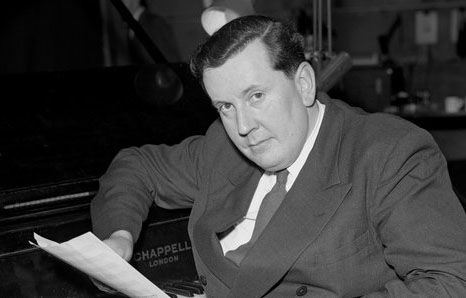

Source: Conifer/BMG CD (my rip!)
Formats: FLAC(RAR), DDD Stereo, mp3(320)
File Sizes: 336 MB / 158 MB (FLAC version incl. covers & booklet)
The FLAC link has now expired. No more requests for this, please!
mp3 version -
https://mega.co.nz/#!aI8hxCra!Wx2zUrh46ztNt0xxTgp-ncf0Fz5418AHkYSKXChFELs
Enjoy! Don't share! Buy the original! And please click on "Like" if you downloaded this album! :)
bohuslav
07-27-2015, 03:32 PM
Vernon Handley at his best, fantastic series. Folks listen to this.
Btw i missed the second Symphony from this series ;O(
wimpel69
07-27-2015, 04:07 PM
No.794
Modern: Neo-Classical/Tonal
The works included here are truly representative samples of a symphonic movement rather unknown
internationally and deserves special attention. Follet by Granados and Taltabull’s
Overture have remained unpublished until were recently published by� Trit� Editions. This
is the first label version of both works. Lamote de Grignon and Garreta, meanwhile, played a
decisive role in developing the Catalan symphonism because knew how to combine popular elements with the
classical tradition.
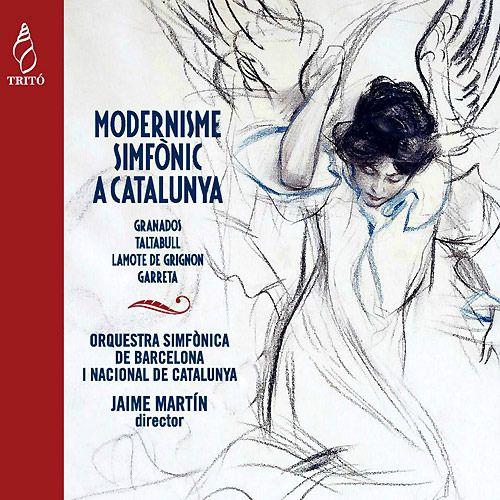
Music by Enrique Granados, Juli Garreta, Crist�for Taltabull & Joan Lamote de Grignon
Played by the Orquestra Simf�nica de Barcelona i Nacional de Catalunya
Conducted by Jaime Mart�n
"Aquest disc que Trit� edita s’afegeix a tota una s�rie de registres que componen
indiscutiblement la m�s decidida i clara contribuci� a la celebraci� d’un passat
musical que certament cal con�ixer m�s i millor."
Vicent Minguet, Sonograma
"Nos deja la posibilidad de escuchar obras poco conocidas, todo en una buena
versi�n de la OBC y Jaime Mart�n al podio."
Jorge da Persia, La Vanguardia
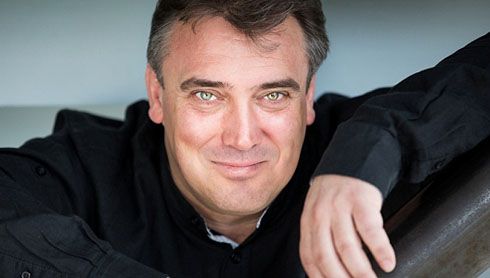
Jaime Mart�n.
Source: Trit� CD (my rip!)
Formats: FLAC(RAR), DDD Stereo, mp3(320)
File Sizes: 202 MB / 130 MB (FLAC version incl. cover)
The FLAC link has now expired. No more requests for this, please!
mp3 version -
https://mega.co.nz/#!LJkT1A7A!QCR7iq1oY26lc-N_Xe3xxnkrdH4ABghqej7WkMf-m3o
Enjoy! Don't share! Buy the original! And please click on "Like" if you downloaded this album! :)
gpdlt2000
07-28-2015, 02:11 PM
Thanks for sharing these unknown scores!
wimpel69
07-29-2015, 01:27 PM
No.795 (by request)
Modern: Neo-Romantic
Howard Hanson's Symphony No.7 "A Sea Symphony" was his last work in the genre. Its music, valedictorian
and celestial in character, and its texts, derived from Walt Whitman's Leaves of Grass, combine to clearly suggest a picture
of a life nearing its happy end. This view hardly assumes any element of controversy with the revelation that the composer
was in his 81st year when he wrote the symphony. The work is cast in three movements and generally lasts a bit less than
20 minutes. The opening panel, marked Largamente, begins quietly and mysteriously, the orchestra gradually swelling in
sound until the chorus intones the words "Lo, the unbounded sea," which comprise the subtitle for this movement. The
music then takes on an ethereal and somewhat triumphant character thereafter, striking the listener as more a choral
tone poem than a symphony. The second movement, at about four minutes, is the shortest of the three. Marked Adagio
and subtitled "The untold want," it clings to the same ethereal sense, but is somewhat bleak and much darker than the
opening panel. The finale begins briskly, with swirling energy from the orchestra (Allegro molto). Shortly after the
chorus enters with the words "Joy, shipmate, joy!" (again, the subtitle of the movement), the orchestra proclaims a
brief and grand quotation from the composer's Symphony No. 2 "Romantic." The music soon turns restless, then
grows quiet before majestically building as the chorus serenely and triumphantly sings about the voyage toward
"unknown shores." The ending is ecstatic, conveying a sense of both confidence and joy.
Written during 1925-6, Pan and the Priest is an intriguing symphonic poem, which introduces a new rhythmic
clarity to Hanson's compositional armoury. The opening idea sounds out mournfully, and appropriately, on cor anglais,
soon joined by clarinet and oboe, before strings add an atmospheric backdrop. The music grows more animated over
a steady pulse, reaching a short-lived climax, before solo wind effect a brooding return to the opening. Suddenly a
piano, marked obligato in the score, brings about a new impulsiveness, the music striding forward vigorously.
Lower strings introduce a new theme (6:28), which grows quickly in expressive ardour, while not neglecting the
more pensive mood heard earlier. The reappearance of the first idea presages the main climax, with both themes
passed excitedly around the full orchestra. The work closes in a mood of full-throated eloquence.
Rhythmic Variations on Two Ancient Hymns is one of Hanson's least known works, and was thought to be
lost until quite recently. The first hymn emerges sombrely and spaciously, before a solo violin (1:29) sounds forth
its successor, melancholy and with just a hint of the archaic, over a halting accompaniment. This is combined in
canon on full strings, before the texture opens out and the hymns combine to draw this short, evocative piece
to its expressive conclusion.

Music Composed and Conducted by Howard Hanson
Played by the International Youth Camp at Interlochen Orchestra & Choir
With the Lyric Arts Quartet
"All these pieces are recorded here in good sound and in a live performance from 1977 (they
were originally published on a semi-private Silver Crest NMC 1977-25 LP) by the so-called World
Youth Symphony Orchestra of Interlochen, the youth orchestra gathered every summer at the
Interlochen National Music Camp, Michigan. In fact the Symphony was written to commemorate
the Camp's 50th season and the Variations get here their premiere recording. A reviewer of another
Hanson-Interlochen release on Citadel 88110 has reviled the orchestra's reading of the Second
Symphony and Merry Mount Suite (see Howard Hanson Conducts Hanson). I don't have the
scores but I hear nothing offensive here.
The String Quartet was recorded in 1989. It is an early work from 1923, which makes its
passionate Romanticism more acceptable. The individual movements are not cued, but the
finale, starting at 13:57, has nice Ravelian overtones and the Quartet has at times an intensity
which announces Britten's First Quartet.
In sum, this disc should provide enjoyment to those who can never have enough of Vaughan
Williams, especially his Sea Symphony."
Amazon Reviewer
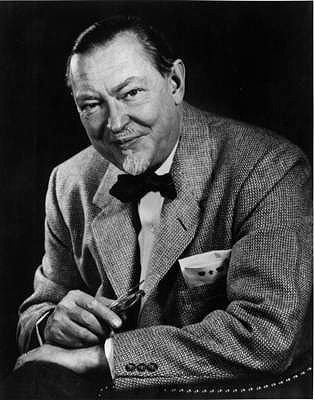
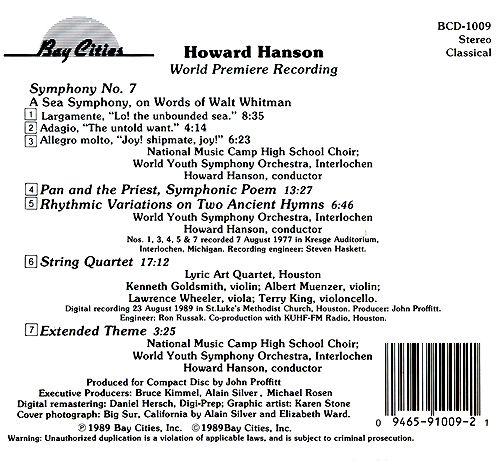
Source: Bay Cities CD (my rip!)
Formats: FLAC(RAR), ADD Stereo, mp3(320)
File Sizes: 282 MB / 139 MB (FLAC version incl. covers & booklet)
The FLAC link has now expired. No more requests for this, please!
mp3 version -
https://mega.co.nz/#!uZV0ADpQ!zwAPB-opHd2eM8DepkV-Q0NC4Jrzrdgi9_zd6EJ42xg
Enjoy! Don't share! Buy the original! And please click on "Like" if you downloaded this album! :)
wimpel69
07-29-2015, 02:48 PM
No.796
Modern: Avantgarde
On his father's side a descendant of the Tokugawa Shogun family, who ruled over Japan from the 17th
to the 19th century, and on his mother's from the Fujiwara family, who were the most powerful Japanese
court nobility from the 7th to the 12th century, Yoritsune Matsudaira (1907-2001) went on to become
one of the greatest Japanese composers of the 20th century. His music won the respect of Messiaen and
Takemitsu, and has been performed in Europe by many distinguished musicians. Matsudaira developed a
distinctive, modern style of his own based on the ancient Japanese court music, Gagaku, in which
various musical elements, including dance music (Bugaku) from Japan, China and Korea are brought
together. Written in the late 1950s, U-Mai (Right Dance), Sa-Mai (Left Dance) and Danza
Rituale e Finale, are presented on this recording in the form of a suite, following ancient Japanese
tradition. In these works Matsudaira attempts to integrate Gagaku with the avant-garde techniques of
Stockhausen and Boulez.
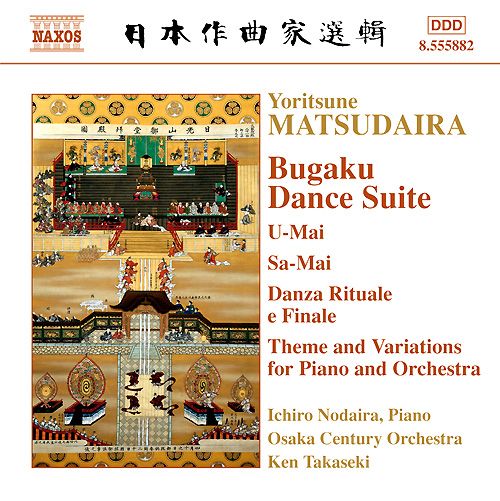
Music Composed by Yoritsune Matsudaira
Played by the Osaka Century Orchestra
With Ichiro Nodaira (piano)
Conducted by Ken Takaseki
"On this disc the opening Theme and Variations for Piano and Orchestra represents the tail end of his
first period when French neo-classical influence was still evident. This contrasts greatly in style
with the other, later works on the disc. The theme for this work is taken from Gagaku and played
unadorned only by the orchestra. The piano enters with a solo marked andante at the beginning
of the first of six variations which are seamlessly constructed. The writing becomes increasingly
animated during the second and third variations. In the latter, the music is dodecaphonic and the
influence of jazz rhythms evident. The fourth variation is a lyrical nocturne and is followed by two
rhythmic allegros with the final variation marked Toccata meccanica. The final section of this
variation adopts a slower tempo and ultimately the music comes to a natural, unforced conclusion.
During the 1950s the Theme and Variations was performed by Herbert von Karajan, both in Europe
and Japan. It is hard to imagine Karajan conducting the works which follow. Apparently written
separately, together the four works constitute a Bugaku or Dance Suite. Framed by relatively
short Ritual Dances (Enbou to open and Chogeishi to finish) are the more substantial Sa-Mai (Left
Dance) and U-Mai (Right Dance) in five and three sections respectively. The instrumentation
varies somewhat between the works but is essentially based around woodwinds and percussion.
The Enbou is very unusual. The purpose of this dance is to purify the stage and Matsudaira does
this in three sections. The first, Preludietto, consists of 13 very brief fragments (the shortest is
11 seconds and longest 15 seconds) interspersed with several seconds of silence in between
each one. In the central Preludio the music is continuous for two whole minutes before the
coda reprises some of the fragments. It is hard to describe the effect and not easy to appreciate
how this could be danced. The rest of the works offer a more integrated listening experience
but none of it is easy on the ear. During the Chogeishi the audience is meant to leave but I
suspect that some Western audiences wouldn’t get that far.
Since this disc is going to be an educational experience for most listeners (at least outside
Japan), the documentation is a particularly important consideration. Fortunately, this is
excellent, consisting mainly of a detailed and well-written essay in English by Morihide
Katayama (with a German translation). There are also brief notes on the performers. Being
unfamiliar with much of the musical idiom, I feel unqualified to comment on their
performances and certainly found nothing to criticize. The sound quality is very good.
After an opener which admirers of Milhaud should enjoy, this music is not for the faint-
hearted. Nevertheless, this seems to be an important disc for anyone interested in
20th century Japanese music."
Musicweb

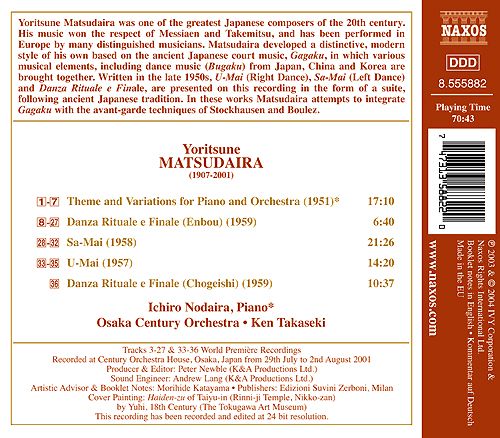
Source: Naxos CD (my rip!)
Formats: FLAC(RAR), DDD Stereo, mp3(320)
File Sizes: 263 MB / 168 MB (FLAC version incl. cover & booklet)
The FLAC link has now expired. No more requests for this, please!
mp3 version -
https://mega.co.nz/#!DNsUlI7L!57Ki2Cc4q0skZyhCAaIuu5i0WJkGr0UnHNM3Oqn rakU
Enjoy! Don't share! Buy the original! And please click on "Like" if you downloaded this album! :)
astrapot
07-29-2015, 07:08 PM
thank you very much, dear Wimpel, for that "Salvador Brotons" another great discovery for me ! !
Expedient
07-31-2015, 07:37 AM
Vernon Handley at his best, fantastic series. Folks listen to this.
Btw i missed the second Symphony from this series ;O(
bohuslav, the second symphony is aviable at What.CD :)
I'm missing No. 9 :(
wimpel69
07-31-2015, 01:56 PM
No.797
Modern: Neo-Romantic
Nicolas Flagello’s traditional late romantic musical values and powerfully emotional and spiritual
expressiveness are explored deeply in this program, from the grimly funereal Odyssey to his intensely
somber and turbulent Symphony No.2 and a new arrangement of the dark and tempestuous Concerto
Sinfonico, his last completed work. Transcribed for saxophones, Valse Noire was originally a test piece
for accordion. Arnold Rosner’s superbly crafted and highly individual works draw on archaic models,
the Symphony No.8 ("Trinity") engaging us from a position of meditative devotion and majestic mysticism.
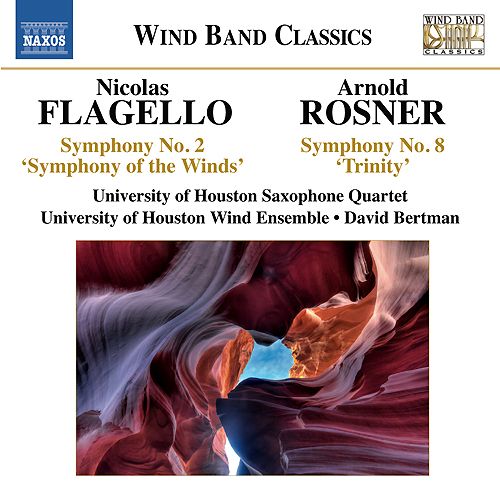
Music by Nicolas Flagello & Arnold Rosner
Played by the University of Houston Wind Ensemble
With the University of Houston Saxophone Quartet
Conducted by David Bertman
"The [two] composers featured here, although stylistically diverse, have quite a lot in common.
[Both] have a sense of theatre and drama. Nicolas Flagello (1928–1994) embodied the
postromantic traditions of his fellow American Samuel Barber, and his exceptional gifts as an
orchestral, instrumental and vocal composer clearly also extend to the medium of wind
orchestra, for which he composed a number of pieces later in his career. The nine-minute tone
poem Odyssey (1981) is a typically condensed, tightly wrought work of pent-up energy, as is
Symphony No. 2, subtitled ‘Symphony of the Winds’ (1970). Here the composer takes us on
a journey into darkly illuminated, El Greco-like landscapes. The sadness of the ‘trauerode’
of the middle movement is in no way redeemed by the ironic fugal finale. The Concerto Sinfonico
for saxophone quartet and winds (1984), Flagello’s last completed work, was written when
he was already under the shadow of a devastating disease of his nervous system which left
him unable to compose for the last decade of his life. There is a powerful sense of leave-
taking, but the mood is more of anger than resignation and there is no let-up in the intensity
of Flagello’s emotional energy in his last music. The medium of saxophone quartet, wind band,
percussion and harp weave a rich and elegiac tapestry, magnificently played by this excellent
ensemble.
Arnold Rosner (b. 1945) is a master of colour and epic grandeur, and his music evokes
processions of caparisoned horses, medieval cathedrals and triumphant ceremonial.
Symphony No. 8 ‘Trinity’ (1988) indeed harks backwards, the theatrical drama of its endless
carillons and fanfares imparting a timelessness that is liberating and uplifting. As in the
music of his mentor Alan Hovhaness, the hymns and chorales of Rosner’s music are a
celebration of the created universe, to be enjoyed in all its splendour."
Tempo

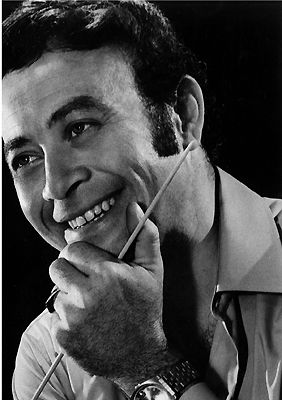
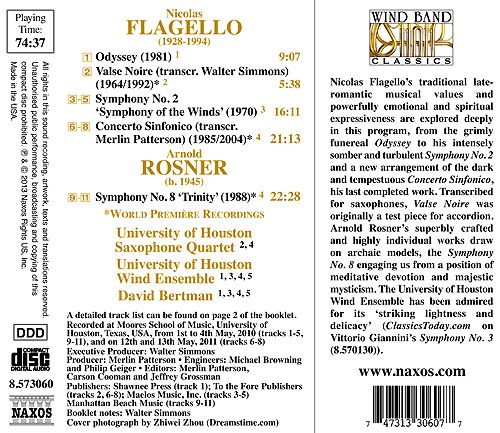
Source: Naxos CD (my rip!)
Formats: FLAC(RAR), DDD Stereo, mp3(320)
File Sizes: 312 MB / 177 MB (FLAC version incl. covers & liner notes)
The FLAC link has now expired. No more requests for this, please!
mp3 version -
https://mega.co.nz/#!yRdViBhK!91nCNVxGbnP4kw7C3aDyp-mhTZ8a4aLFpUX-HedtQSY
Enjoy! Don't share! Buy the original! And please click on "Like" if you downloaded this album! :)
bohuslav
07-31-2015, 03:42 PM
bohuslav, the second symphony is aviable at What.CD :)
I'm missing No. 9 :(
Many thanks for the tip, load it now but the ninth i missed too. I thought I had it in the collection...grmpf!
swkirby
07-31-2015, 08:37 PM
Thanks for this. I really liked the first Flagello/Rosner pairing, so am looking forward to this one... scott
wimpel69
08-02-2015, 12:30 PM
No.798
Modern: Tonal
The Belgian composer Marcel Poot, born in Vilvoorde, Brussels on 7 May 1901. From 1939, he held various
positions at the Royal Conservatory in Brussels, heading that institution from 1949 until 1966. He was one of
the most remarkable musical personalities of his generation of Belgian composers, and left behind an extensive
selection of mainly instrumental works for orchestra and chamber ensembles. He died in 1988.
Marcel Poot’s lively and spirited style of composition reveals youthful mischievousness and an uninhibited lust
for life, expressed in lively rhythms and often short melodic themes. Poot’s music is seldom backed by deep
thoughts, but the refined musical taste of the composer protects him from superficiality by an innate sense of
balance in the formal build-up of his works, which as a rule are classical in structure. Poot’s modernism was
never dogmatic, but a spontaneous synthesis of old and new, averse to systems and experiments. This is why
Poot is in many ways a neo-classicist, even though he never admitted to this or any other style of composition.
His preference for classically from schemes is derived from his respect for the important traditions of West
European art-music of the past, while the pulse of his own age beats in clearly chiseled and tersely formulated
themes. Thematic work and motivistic analysis of these often starkly contrasting elements dictates to him a
logical extension of the musical idea, brusquely expressed in biting rhythms and muscular ostinatos.
Marcel Poot wrote seven symphonies, at different periods of his career. From the moment that the first three
symphonies were composed, however, it appears that the young composer handled the symphonic genre
with some hesitation and prudence, while the last four symphonies clearly show that the retired, older Poot
felt himself fundamentally attracted to the symphonic form. The First Symphony (1929) is more looked
upon as a sort of exercise, in which the young composer follows the example of Ravel, Stravinsky and Richard
Strauss, seasoned with the new sounds of the roaring twenties, as they sounded when played by cinema
pianists and jazz musicians. The Second (1938) and most surely the Third Symphony (1952),
written after an interval of nine and fourteen years respectively, point to an emotional change and a deeper
feeling. Poot’s language has become more dramatic and also more romantic, a trend that is no longer found
in the last four symphonies. After eighteen years, the Fourth Symphony (1970) heralded a consecutive
series of mature symphonic works, a Fifth (1974), a Sixth (1978) and a Seventh Symphony (1980).
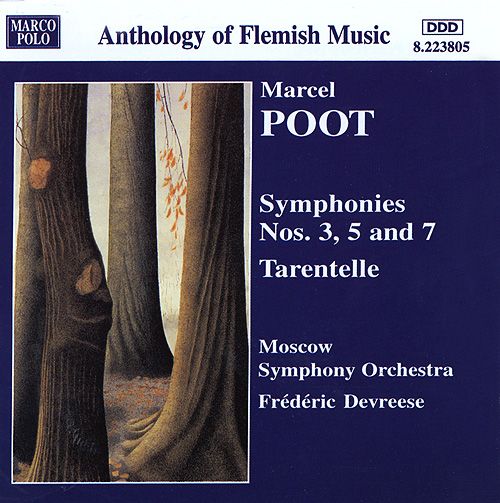
Music Composed by Marcel Poot
Played by the Moscow Symphony Orchestra
Conducted by Fr�d�ric Devreese
"Marcel Poot (1901-1988) was one of the most central Belgian composers of his generation and
a relatively prolific composer. The music is generally lively and diverting, not particularly profound
but always tasteful and wellcrafted. The style is based on classical forms and the harmonic
language is modern but firmly rooted in tonality. Much of the music has a certain machine-like,
driven quality, and there is plenty of momentum and spirited rhythms.
He wrote seven symphonies, and the third dates from 1952, apparently representing a turn
toward a more dramatic and romantic language. It's opening Lento gives way to an Allegro
Impetuous in truncated sonata form, based on a rhythmical idea, characterized by sinewy
energy and hammered force. It is rather appealing, though the following, elegiac Andante
funerale is a little meandering. The Finale combines material from the previous two movements,
and does so rather successfully by contrasting the obsessive rhythms of the opening movement
with mournful and relatively simple melody.
The fifth symphony (1974) opens with a series of thematic fragments - rhythmic and melodic
pieces that are gradually put together as the movement unfolds in a manner that rather
effectively combines energy with discursive classicism. The Adagio is plaintive but builds up
to an impressive climax, and the final Vivace gives a slightly baroque-inspired treatment of
rhythm (rather than melody). There are some good ideas in this one, and it hangs together
better than the third.
The Marco Polo gives the composition date of the seventh as 1990, but given that Poot was
dead at the time I assume that it is the date of the first performance. In any case, the seventh
and last symphony is a very late work. The material is more organically unified this time
around, and the scoring is more colorful. The opening movement is busy and exciting,
although the second movement strikes me as somewhat meandering (again). The finale,
Allegro impetuoso, imaginatively builds its way to a relatively impressive climax."
Amazon Reviewer
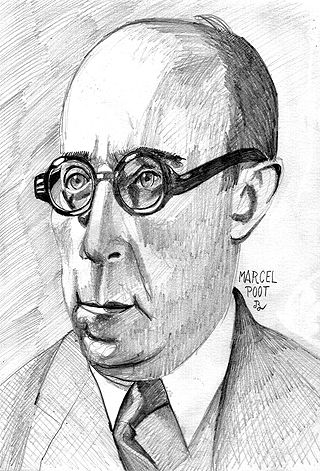

Source: Marco Polo CD (my rip!)
Formats: FLAC(RAR), DDD Stereo, mp3(320)
File Sizes: 212 MB / 148 MB (FLAC version incl. covers & liner notes)
The FLAC link has now expired. No more requests for this, please!
mp3 version -
https://mega.co.nz/#!WZUjFYYS!xjmLKFdpbNXliG3DnsT27QczJJCx55fTQoKO64a qiNw
Enjoy! Don't share! Buy the original! And please click on "Like" if you downloaded this album! :)
wimpel69
08-02-2015, 01:31 PM
No.799
Modern: Neo-Classical
Walter Piston (1894-1976) continues to be damned with faint praise more than a quarter-century
after his death. While acknowledging his extraordinary ear for orchestra timbre, his consummate contrapuntal
skills and his overall lifelong employment of classical forms, commentators have for too long dismissed him
as an academic, as if intellectual rigor and the acceptance of historical models was a bad thing. Even his
remarkably clear notation of scores and his early background in engineering reinforces the notion of a fastidious
craftsman, which he certainly was in the best sense, rather than a creative artist. An even casual reflection
on music history shows that the pantheon of truly great composers is peopled by such conservatives as Bach,
Mendelssohn and Brahms, all three content to build upon and find vitality in musical structures created by
their forebears. Likewise, Walter Piston combines an uncommon rigor with a tone-poet’s sensitivity.
In 1950, the University of Minnesota commissioned Piston to compose what became his Symphony No.4
for the hundredth anniversary of the school the following year. Antal Dorati conducted the premi�re with the
Minneapolis Symphony Orchestra on 30th March, 1951. Piston’s eight symphonies cover a broad spectrum of
twentieth century styles. The sixth, for example, was unabashedly tonal, while the eighth was pointedly
dodecaphonic. Nos. 1, 2, 5, 7 and 8 are all in three movements; No. 4 is in the traditional four-movement format.
The composer described his fourth symphony as "melodic and expressive and perhaps nearer than my other
works to the solution of the problem of balance between expression and formal design". As such, he would
have undoubtedly found himself in the spiritual company of Brahms, whose own symphonies amply fit that
description. Marked piacevole (pleasant), the first movement posits a long, flowing and somewhat rustic main
theme with a more contained and subdued secondary melody introduced by the clarinet. Exulting in a succession
of changing meters, the ensuing Ballando (dancing) movement pays homage to both the urban waltz and to
unbuttoned country fiddling. In contrast, the third movement, marked Contemplativo, a "continuous Adagio,"
opens with the clarinet quietly intoning a fairly atonal theme that is taken up and varied by the violas and
French horn before mounting to an impressive climax broadcast by the brass. The Energico finale, in sonata
form, opens with a terse but rhythmically insistent theme that is answered by a comparatively lyrica
l secondary tune entrusted to the oboe. A short development and recapitulation in which the second theme
has been appropriated by the violins yield to a final climax based on the primary theme.
Three New England Sketches was commissioned by the Worcester (Massachusetts) County Musical
Association and given its first performance by Paul Paray and the Detroit Symphony on 23rd October, 1959.
It is but one of a handful of pieces by Piston with a programme. (Here, too, Piston resembled the classical
orientation of Brahms in essentially sticking to "absolute" musical compositions.) The composer was not
entirely at ease attaching a storyline or specific scenes to his music. In any case, "Seaside," an atmospheric
Adagio, evokes the ever-changing surface of the ocean. The ensuing "Summer Evening," with its flitting
tremolos vivify the cumulative background murmur of countless insects hovering in aestival splendor. The
concluding "Mountains" states its case with granite certainty in its bedrock C-major chordal tonality.
Its massive strength is complemented by an extended fugal section in hushed dynamics before the return
of the Maestoso opening.
If any work sets aright Piston’s reputation as an academic composer, it is his Capriccio for Harp and
String Orchestra, which moves through its paces with unforced grace, perhaps recalling the composer’s
youthful days in the Navy band. The work resulted from a commission from Broadcast Music, Inc. (BMI) in
1963 and was dedicated to renowned Spanish harpist Nicanor Zabaleta, who gave the premi�re performance
in Madrid on 19th October, 1964. In one movement, the Capriccio abounds in delectable syncopation,
clever contrapuntal exchanges between the solo and the strings, and slower sections that are by turns
dreamy and sensuous.
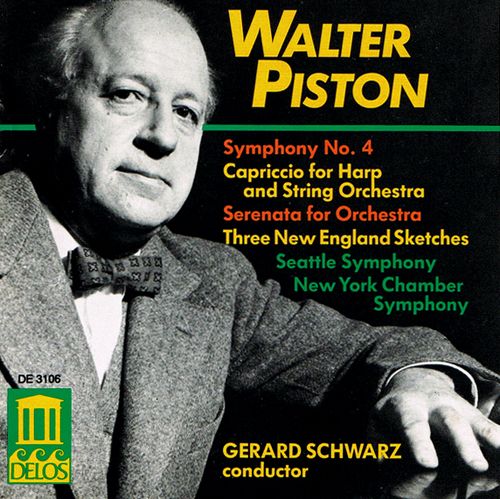
Music Composed by Walter Piston
Played by The Seattle Symphony & the New York Chamber Symphony
With Theresa Elder Wunrow (harp)
Conducted by Gerard Schwarz
"The Fourth is Piston’s most radiant and appealing symphony, one of the masterpieces of American—
and not only American—symphonic writing. This and the three New England Sketches are among
the composer’s strongest and most attractive scores, and they come here in outstanding performances
under Gerard Schwarz, originally issued on the Delos label, and here made doubly attractive at sup
er-bargain price. The four movements of the Symphony are all strongly characterized, with the gentle
piacevole opening of the first movement leading to tough counterpoint, strongly syncopated, and the
second movement Ballando rather like a hoe-down, vigorous open-air music with the evocative slow
movement leading to a jaggedly rhythmic finale. The New England Sketches are more specifically
evocative, set in contrast like a symphony, with a delicate picture of a Summer Evening placed
between the opening picture of the seaside and the final rugged picture of Mountains. Even so,
the musical argument is cogent, and although the Capriccio is less tautly constructed, it has an
element of fantasy beautifully realized here by the excellent harpist, Therese Elder Wunrow.
First-rate sound."
Penguin Classical Guide (****)
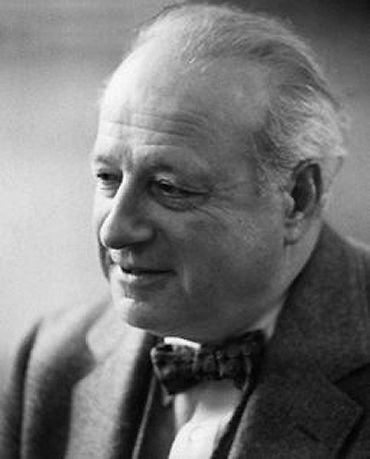
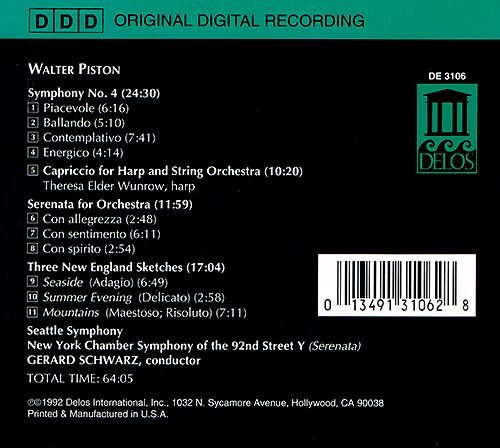
Source: Delos CD (my rip!)
Formats: FLAC(RAR), DDD Stereo, mp3(320)
File Sizes: 204 MB / 151 MB (FLAC version incl. liner notes)
The FLAC link has now expired. No more requests for this, please!
mp3 version -
https://mega.co.nz/#!vVcgTB6C!qryZtqXAUc8-JCAWY2WSYB2PtF449pxoVyRBQOwwO8E
Enjoy! Don't share! Buy the original! And please click on "Like" if you downloaded this album! :)
bohuslav
08-02-2015, 02:17 PM
Superb CD, lovely played. Is this one on Naxos too now? Many thanks wimpel69.
wimpel69
08-02-2015, 04:25 PM
The Naxos disc omits the Serenata for Orchestra.
No.800
Modern: Minimalism, Gamelan
Lou Harrison (1917-2003) was one of the most inventive and individual of American composers. His music
is noted for its pervasive integration of Native American and Asian musical influences and its emphasis on melody
and rhythm, often avoiding harmony altogether. His family moved from Oregon when he was nine, and continued to
move frequently around the San Francisco Bay area. The very diverse musical atmosphere of San Francisco was the
primary formative force in his life. He could hear Cantonese opera; Gregorian chant; Spanish, Mexican, and Native-
American music; and jazz and classical music. The San Francisco Public Library, with its strong music department,
enabled him to take armloads of music home to study. He studied jazz piano, Gregorian chant, and conducting
while in high school. He took Henry Cowell's course on "Music of the World's Peoples," further studying counterpoint
and composition with Cowell.
He and John Cage both wrote percussion-dominated music and found new percussion instruments in automobile
junkyards and import shops; one of their discoveries was the wonderful pitched ringing sound produced by brake
drums. Harrison eventually went to the University of California at Los Angeles to work with its dance department.
While there, he was a composition pupil of Arnold Schoenberg. Harrison had already developed a love of
Renaissance and earlier music. He adopted the old dance form "estampie," a word he translates as "stampede"
for his own stamping, highly rhythmic fast movements.
In 1943, he moved to New York where he worked as a musician and writer. It was the unhappiest period of his
life; he did not like the place, and found it difficult to make a living, although he did write some 300 music reviews
for the Herald Tribune from 1944 to 1947. He developed a stomach ulcer and finally had a nervous breakdown.
During this period, he made the acquaintance of Charles Ives and assisted the aged composer by editing and
preparing for performance Ives' Third Symphony, which Harrison conducted at its premiere. Ives assisted Harrison
financially when needed and, when the Third Symphony won the Pulitzer Prize in Music, Ives gave Harrison
half the money.
The 1947 nervous breakdown resulted in Harrison deciding to change his compositional style. He began to
imitate the sounds of gamelan orchestra, which he had first heard at the 1939 Golden Gate Exposition.
He studied Harry Partch's theoretical book Genesis of a Music (a gift from Virgil Thomson) and was convinced
to adopt various forms of just-intonation rather than the standard 12-note scale. (He says he wishes musicians
were numerically trained, so that he could say, for instance, "Cellos, you gave me a 10/9 there; please give
me a 9/8 instead.")
Harrison subsequently resumed his high productivity, returned to the West coast in 1951 to settle for life in
Aptos, California and continued to write music sounding primarily "Pan-Pacific" in style, often for unusual
combinations of instruments. He first visited Asia in 1961 at a world music symposium, afterward, he became
interested in establishing gamelan orchestras in North America, and devised an "American gamelan" made
by his partner William Colvig from readily obtainable materials. He went on to write hundreds of compositions,
and his works are often recorded. Harrison developed a system of musical organization based around melodic
shapes he calls "melodicles" and analogous rhythmic patterns ("rhythmicals") and durations ("icti controls").
Lou Harrison died in 2003 en route to an Ohio festival dedicated to performances of his works.
Works included in this box are:
Symphony No.3
Seven Pastorales
New First Suite for Strings
Suite from the ballet "Solstice"
Suite from "Marriage at the Eiffel Tower"
Grand Duo for Violin and Piano
Homage to Pacifica
Philemon and Baukis
Cornish Lancaran
Gending Alexander
A Summerfield Set
Ariadne
Canticle No.3, etc
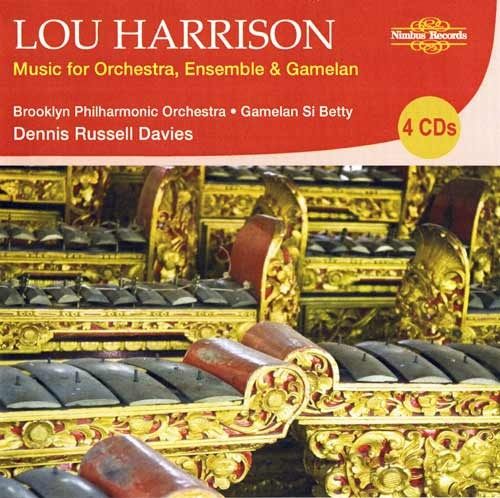
Music Composed by Lou Harrison
Played by the Brooklyn Philharmonic & Cabrillo Music Festival Orchestras
And the Gamelan SI Betty
With Lou Harrison (narrator) & Virgil Thomson (narrator)
And Jody Diamond and the Lou Harrison Gamelan Group
And Romuald Tecco (violin)
Conducted by Dennis Russell Davies
"If ever a composer lived whose music was vital and elemental, whose vision was that of a seer,
whose outlook was worldwide, who communicated and wrote music which spoke directly to the
senses, that man was Lou Harrison. Never have I received something for review which has given
me more pleasure at just the mere thought of it. In the pantheon of composers, Lou Harrison is
one of the very few who deserves the epithet great.
I had the great, good, fortune to meet Harrison when he came to London for the 1985 Almeida
Festival. He was a big man in every way, his build, his personality and, I remember it so well,
his laughter. He laughed as lot when he spoke. It seemed that nothing was to be taken seriously.
I enjoyed the all too short time I was able to spend with him, and I shall never forget it.
Not only was Harrison a great composer but he had become part of musical history for a very
different reason – he conducted the first performance of Charles Ives’s 3rd Symphony, The Camp
Meeting, in 1946. The following year, the Symphony won, for Ives, the Pulitzer Prize for Music.
The composer gave half the prize money to Harrison, saying "prizes are for boys, and I'm all grown up".
So what of the music offered in these four CDs? Quite frankly, as far as I am concerned as the
four CDs contain music by Lou Harrison, that is recommendation enough. But, perhaps a few
pointers might be welcome for those not acquainted with this work. Harrison’s style is basically
tonal, but the tonality is expanded and richer than one would expect. His forms hark back to
the baroque and just as he marries together east and west, in his work the old meets the new.
These four CDs comprise the complete recordings of Harrison’s music made by the MusicMasters
label and we must be grateful to Nimbus for bringing them back into the catalogue, and in such
marvellous sound. The notes are very good indeed – 20 pages of them – and they are a real
help to someone just starting to investigate this very interesting composer. This is one of the
most exciting and interesting items I have had the pleasure of reviewing all year, I hope that it
will be enjoyed by as many people as possible for it shows a side of American music so removed
from the music we know from that country – Copland, Barber, Rorem. Also, it’s very good music.
Please, on no account, should you miss this very special issue."
Musicweb International
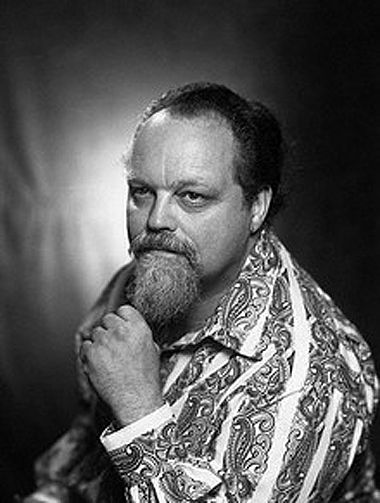

Source: Nimbus CDs (Originally on Music Masters) (my rip!)
Formats: FLAC(RAR), DDD Stereo, mp3(320)
File Sizes: 1.2 GB / 736 MB (incl. covers & booklet)
The FLAC link has now expired. No more requests for this, please!
mp3 version -
https://mega.co.nz/#!LMthVLYQ!E-ypSlvsFzcccEefOQNPmTxvpH8tHKNjdpic1LmTfQE
Enjoy! Don't share! Buy the original! And please click on "Like" if you downloaded this album! :)
wimpel69
08-04-2015, 09:59 AM
No.801
Modern: Tonal/Americana
Spanning the traditional boundaries separating “serious” and “popular” music, Morton Gould wrote
prodigiously across a wide range of forms, from concert works to musicals and film scores. The Concerto
Grosso was described by the composer as “a transformation of hoedown tunes…[the soloists] play, in
the first and last movements, like a bat out of hell.” Gould’s work for film and television ranged from the
movie travelogue Cinerama Holiday to the poignant Holocaust, via the ironic dances of
World War I. The jazzy "Pavane" contrasts with the atmospheric "Interlude," while the
Formation Suite is an original take on marching bands.
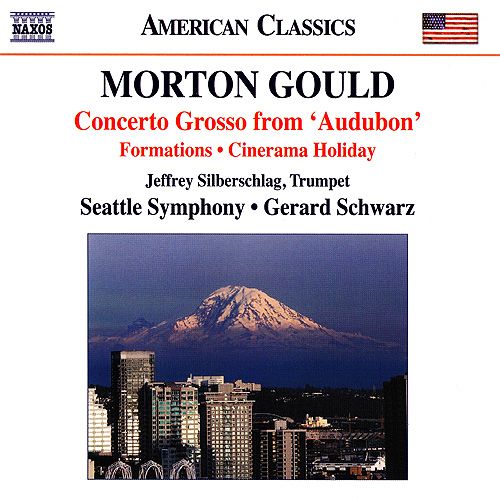
Music Composed by Morton Gould
Played by The Seattle Symphony
With Jeffrey Silberschlag (trumpet)
Conducted by Gerard Schwarz
"This superb Morton Gould collection recorded in 1994, originally issued on Delos (3166),
now returns at modest price, a most welcome reissue. Gould (1913-1996) is a gem among
American composers and wrote numerous light pieces that are imaginative and beautifully
scored. Among his favorites are American Salute, Latin American Symphonette amd
Symphonette No. 2. His ventures into more serious repertory produced Spirituals for Orchestra
and Fall River Legend. This disk features delightful lighter works beginning with Gould's most
famous work, Pavane which actually is the second movement of his Symphonette No.2.
Featured is the superb trumpet of Jeffrey Silberschlag, who also is heard in a number of
the other works. Schwarz and his fine orchestra are in top form, audio is rich and satisfying.
A real charmer!"
Classical CD Review
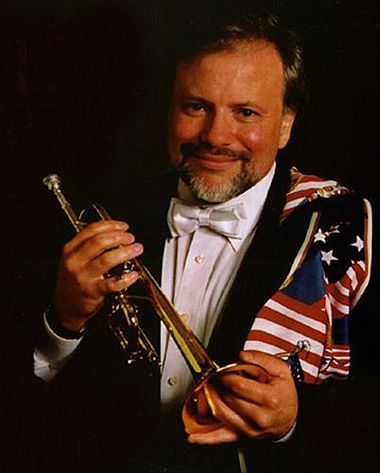
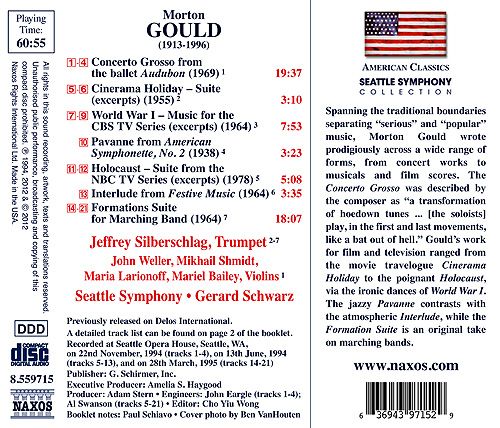
Source: Naxos CD (my rip!)
Formats: FLAC(RAR), DDD Stereo, mp3(320)
File Sizes: 252 MB / 140 MB (FLAC version incl. covers & booklet)
The FLAC link has now expired. No more requests for this, please!
mp3 version -
https://mega.co.nz/#!Tcl2WSJA!OxspnMGWLW4fKZ59ty02Q9QTemxIsxK2sl4aJ3H vJeQ
Enjoy! Don't share! Buy the original! And please click on "Like" if you downloaded this album! :)
bohuslav
08-04-2015, 02:09 PM
Great CD, i own the original Delos CD, with a little bit different tracking list.
wimpel69
08-05-2015, 01:23 PM
No.802
Modern: Light Music
Of Russian-Jewish origin, Sydney Torch (1908-1990) established himself in England as a talented conductor
of popular classics, notably with the BBC Concert Orchestra, and as a gifted composer and arranger,
making imaginative and often novel use of the resources of the symphony orchestra. Torch started his music
career as a pianist playing the cinema organ in the British picture palaces in the 1920s. He realised on time that
the days of the cinema organ as he knew it were numbered, so he turned to light orchestral composing,
arranging and conducting, where he quickly established himself through his radio broadcasts and commercial
recordings. He wrote the catchy signature-tune for the famous BBC Radio series "Much Binding In The Marsh",
and also discovered that his composing talents were ideally suited to the requirements of the production music
(mood music) publishers, that were rapidly establishing libraries in London.
Sidney Torch's music is still remembered by the many admirers of the cinema organ and light music, and by
the many for his weekly broadcast 'Friday Night is Music Night' [1953-1972] with the BBC Concert Orchestra.
His own compositions and arrangements are still regularly performed by 'his' BBC Concert Orchestra [as done here].
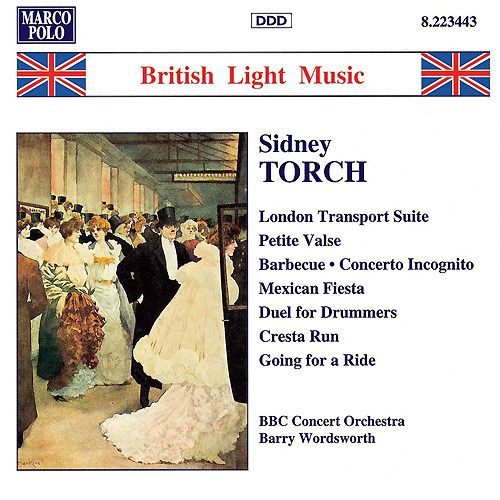
Music Composed by Sidney Torch
Played by the BBC Concert Orchestra
Conducted by Barry Wordsworth
"Sydney Torch worked frequently with the BBC Concert Orchestra (the orchestra on this CD),
and for many he is remembered for his weekly broadcast ‘Friday Night is Music Night’. The London
Transport Suite was commissioned by the BBC for their Light Music festival of 1957 and was inspired by
the withdrawal of the ‘Brighton Belle’ on the London-to- Brighton railway service. Each of its three
movements represents a mode of transport: The Hanson Cab, Rosie, the Red Omnibus and The 5:52
from Waterloo. All the music here is tuneful, at times wistful and nostalgic, at others bright and breezy—
All Strings and Fancy free is both. Barbecue sounds like a Scottish snap, while the Trapeze Waltz is
reminiscent of the circus music of Satie. The Concerto Incognito is very much in the Warsaw Concerto
mould, and the Petite Valse (also with piano) is more robust than its little suggests. The Mexican
Fiesta and Samba Sud produce some fine local colour and are very jolly, while the Slavonic Rhapsody
(with two piano) is more robust than its title suggests. The Mexican Fiesta and Samba Sud produce
some fine local colour and are very jolly, while the Slavonic Rhapsody (with two pianos) is a fun work,
drawing on the music of Rimsky-Korsakov, Tchaikovsky, Knipper, Borodin and Khachaturian, to form
an entertaining if outrageous pastiche. The longest work is the Duel for Drummers, which as its title
suggests, is a tour de force for the percussion department; it has some ideas which are reminiscent
of Eric Coates and a new surprises, including a cockerel crowing, and a desert-island storm in the
central movement. It ends with a lively galop. Barry Wordsworth conducts with flair, and the
recording is excellent."
Penguin Classical Guide (***)
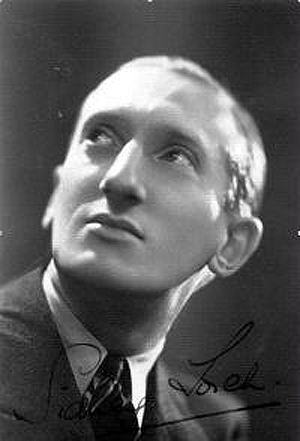

Source: Marco Polo CD (my rip!)
Formats: FLAC(RAR), DDD Stereo, mp3(320)
File Sizes: 333 MB / 179 MB (FLAC version incl. covers & liner notes)
The FLAC link has now expired. No more requests for this, please!
mp3 version -
https://mega.co.nz/#!nN8BBKyR!ohgN3l01gg3xTpvTPCYkM7vICKxWem4jIrH-3cgDrA8
Enjoy! Don't share! Buy the original! And please click on "Like" if you downloaded this album! :)
Darius Freebooter
08-05-2015, 05:29 PM
Poot received -nice; thanks wimpel!
wimpel69
08-05-2015, 08:31 PM
No updates and links being sent for the next 10 days, folks!
wimpel69
08-19-2015, 11:32 AM
No.803
Modern: Tonal
A Mid-Western native (WI, MN), composer Marga Richter (*1926) earned her Bachelor's and Master's
degrees in composition at The Juilliard School where she studied piano with Rosalyn Tureck and majored in
composition with William Bergsma and Vincent Persichetti. She has written over 150 works, encompassing
virtually every genre. Her orchestral music has been played by over 50 orchestras.
"Except for one early piece using a 12-tone row (String Quartet #1, 1950), I have never employed any
prescribed theory or system or style of composition. Melodic contour and propelling metric and harmonic
rhythms, rather than any formula for tonality or serialization, are the fundamental elements in my music.
The continuous line from the beginning to the end of a piece is what determines its form. Thematic and
rhythmic relationships often occur subconsciously. When I try to develop new sections by manipulating
themes, chords and rhythms I often destroy the work. I have to throw out these constructions and go
back to allowing the music to come from its own mysterious source. Composing music is my response
to a constant desire to transform my perceptions and emotions into music." (Marga Richter)
POETIC IMAGES BEYOND POETRY includes three of Richter’s works for orchestra, each of which present a tonal
and moving representation of their various influences: Out of Shadows and Solitude, inspired by the
flight of a condor over clouded mountaintops; Quantum Quirks of a Quick Quaint Quark, based on Richter’s
early dance music and boogie-woogie; and Spectral Chimes: Enshrouded Hills, permeated with imagery
from Hardy’s Tess of the D’Urbervilles. POETIC IMAGES BEYOND POETRY features performances by the Seattle
Symphony Orchestra and the Czech Radio Symphony Orchestra, both under conductor Gerard Schwarz.
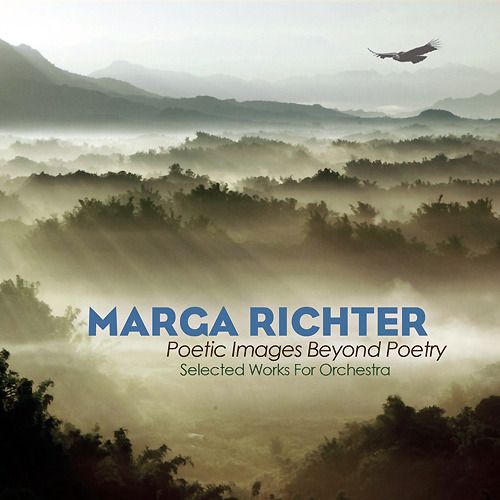
Music Composed by Marga Richter
Played by the Seattle Symphony and the Czech Radio Symphony
Conducted by Gerard Schwarz
"The three works by American composer Marga Richter heard here are what used to be called
tone poems: distinctively scored single-movement orchestral works illustrative of specific external
scenes or ideas. The recordings were made in the mid-'90s, in two different and not particularly
sonically compatible locations in Seattle and Prague. The conductor throughout is Gerard Schwarz,
who gets his name only in very small print but who has a real gift for this kind of thing. Richter's
music is notable for its orchestration and for the variety of moods that follow from that orchestration.
It may bring to mind what might have happened if Mahler had lived a long time and begun writing
the edgier type of film music; critic Mark Lehman, quoted in Richter's own sleeve notes, compares
the humorous-grotesque Quantum Quirks of a Quick Quaint Quark (1992) to Nino Rota's music for
Fellini's films. Richter's music is a good deal less tonal, but the comparison is apt, and the opening
piccolo-contrabassoon sonority is a stroke of genius. The other two works, much longer, are also
programmatic in inspiration, and they gain something if you refer to Richter's notes. The final piece,
Spectral Chimes: Enshrouded Hills, may not sound like those things at first, but once you learn
that it's inspired by images from Thomas Hardy's novel Tess of the d'Urbervilles, it makes more
sense, and its extremely unusual scoring -- string, woodwind, and brass quintets, with orchestra
-- begins to approximate as few other works have the sensation of reading a complex novel with
shifting groups of characters. Recommended, not just for those with an interest in this particular
composer, but for anyone interested in the narrative possibilities of contemporary orchestral writing."
James Manheim, All Music
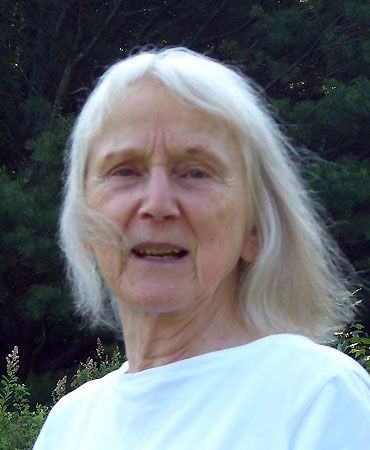
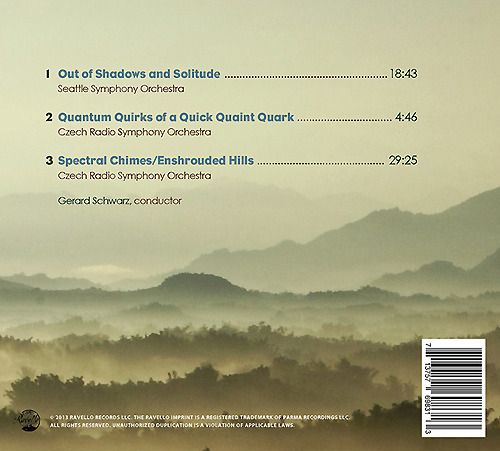
Source: Ravello Records CD (my rip!)
Formats: FLAC(RAR), DDD Stereo, mp3(320)
File Sizes: 275 MB / 121 MB (FLAC version incl. covers & bio)
[B]The FLAC link has now expired. No more requests for this, please!
mp3 version -
https://mega.nz/#!aIERmDJL!xigUoNb6PZPLzFJrv8nhVmR2CGaMS0a2OrSvGHNCeGo
Enjoy! Don't share! Buy the original! And please click on "Like" if you downloaded this album! :)
ArtRock
08-19-2015, 11:48 AM
Good to see you post again. Looks like a very interesting disc.
wimpel69
08-19-2015, 02:56 PM
The FLAC links for uploads Nos. 761-780 have now expired. No more requests for these, please!
calvertus
08-20-2015, 04:55 AM
Welcome back, dear Wimpel!
I�ve missed your postings of these, partial, very neglected music
Thank you for coming back :)
LePanda
08-20-2015, 12:19 PM
wimpel69
08-21-2015, 01:08 PM
No.804
Modern: Avantgarde/Tonal
Mason Bates's Mothership is an energetic opener that imagines the wind ensemble
as a mothership that is ‘docked’ by several visiting soloists, who offer brief but virtuosic riffs on
the work’s thematic material over action-packed electro-acoustic orchestral figuration.
The piece follows the form of a scherzo with double trio (as found in, for example, the Schumann
Symphony No.2). Symphonic scherzos historically play with dance rhythms in a high-energy
and appealing manner, with the ‘trio’ sections temporarily exploring new rhythmic areas. Mothership
shares a formal connection with the symphonic scherzo but is brought to life by thrilling sounds of the
21st Century — the rhythms of modern-day techno in place of waltz rhythms, for example.
Recorded by the London Symphony Orchestra under Michael Tilson Thomas, Mothership received
its world premiere at the Sydney Opera House and the YouTube Symphony on March 20, 2011,
and it was viewed by almost two million people live on YouTube. This is the composer's re-working for
wind ensemble and electronics.
Composer Joel Puckett on his The Shadow of Sirius: "In the winter of 2009, my wife and
I experienced a heartbreak that left me unsure of how to even breathe, let alone grieve. On March 1st,
2009, I found a copy of W.S. Merwin’s, The Shadow of Sirius, and I began to feel myself heal. I have
almost no idea what most of this poetry means. But I know that it fills me with a profound sadness that
is, at the same time, brimming with hope. A friend once said to me, “many concerti explore a virtuosity
of technique but not many explore a virtuosity of expression.” It was with that thought in mind that
I began work on my, The Shadow of Sirius, for solo flute and wind orchestra. Each movement
offers my reflection on a single Merwin poem from the collection. Although the work is played without
pause, the soloist plays unaccompanied solos to separates the individual movements."
Robert Moran (*1937) is an American composer of operas and ballets as well as numerous
orchestral, vocal, chamber and dance works. A native of Denver, Moran studied twelve-tone music
privately with Hans Apostel in Vienna and completed his Masters Degree in 1963 at Mills College in
Oakland, California, where he studied with Darius Milhaud and Luciano Berio (Ruppenthal and
Patterson 2001). After having lived for periods ranging from a few months to a couple of years
in various locales, from Vienna, Berlin, NYC, and Milan to Portland and San Francisco, he has
made Philadelphia his home since 1984.
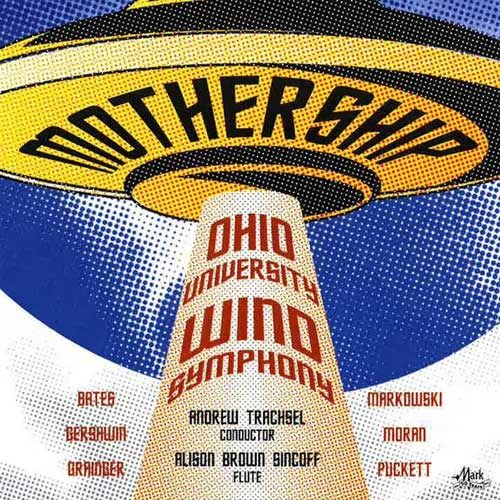
Music by [see above] and George Gershwin, Percy Grainger & Mike Markowski
Played by the Ohio State University Wind Symphony
With Alison Brown Sincoff (flute)
Conducted by Andrew Trachsel
"Conducted by Dr. Russel Mikkelson, the Ohio State University Wind Symphony is widely
recognized as one of the country’s elite wind bands. It is populated by the most accoplished
brass, woodwind and percussion musicians in the School of Music. Committed to the creation
of new music for winds, this ensemble has commissioned music by composers including
David Maslanka, Eric Stokes, Dan Welcher, David Gillingham, John Stevens, Donald Crockett,
Daniel Godfrey, Charles Rochester Young, William Bolcom and Aaron Jay Kernis.
One of the goals of the Wind Symphony is to provide students opportunity to interact with
some of the leading composers and musical minds of our time. Visitors have included such
notable musicians as John Corigliano, Lukas Foss, Krzysztof Penderecki, Gunther Schuller,
Joseph Schwantner, Jennifer Higdon, Frank Ticheli, Augusta Read Thomas, John Mackey,
John Stevens, Steven Bryant, David Gillingham, Jonathan Newman, Roger Cichy and Percy
Grainger biographer John Bird. Graduates of the Wind Symphony hold positions as
professional orchestral musicians, soloists, conductors, members of the Washington-based
military bands, university professors, and some of the world's leading music educators.
Since 2000 the Wind Symphony has recorded five compact discs including Sounds, Shapes
and Symbols (Mark Records 2001), Jubilare! (Mark Records 2003), Winds of Nagual
(Naxos 2007), Southern Harmony (Naxos 2009) and Rest (Naxos 2012). The Wind
Symphony has performed at the 2003 College Band Directors National Association
Convention, the Ohio Music Educators Association Conference six times (2001, 2004,
2006, 2008, 2011, 2013), with BalletMet Columbus (2003, 2011), and presents
numerous performances both on and off campus."

Mason Bates.

Source: Mark Records CD (my rip!)
Formats: FLAC(RAR), DDD Stereo, mp3(320)
File Sizes: 310 MB / 155 MB (FLAC version incl. covers & booklet)
The FLAC link has now expired. No more requests for this, please!
mp3 version -
https://mega.nz/#!3EsHiYyB!pJ575Ig0YsNABCLRpea2VQbd07eFzwuQvAjeyBpryTs
Enjoy! Don't share! Buy the original! And please click on "Like" if you downloaded this album! :)
wimpel69
08-21-2015, 02:33 PM
No.805
Modern: Neo-Classical
There is nothing small about Alexandre Tansman's Sinfonia piccola (1951 –52) which merits this title only
in comparison with symphonic behemoths by Bruckner or Mahler, or Tansman’s own massive composition from the same time,
the oratorio Isa�e le Proph�te (1950). The Sinfonia was commissioned by the French Ministry of Education and dedicated to a
famous surgeon, Dr Jean-Louis Lortat-Jacob (1908 –1992). It adheres to the standard four-part outline of a classical symphony.
It is one of the most enjoyable orchestral works in Tansman’s œuvre and in the entire symphonic repertoire of the period.
Its sparkling beauty could be fully appreciated only in the post-modern era, after the compulsion to write pieces with
pervasively angular motives and dissonant sonorities had passed.
The two sinfoniettas span Tansman’s entire career, Sinfonietta No. 1 dating back to 1924. Written for the Lyon ensemble
Trigintuor, the four-movement Sinfonietta No.1 was first performed in a version for two pianos at a concert given by
the Soci�t� musicale ind�pendante in Paris in January 1925. . The work was Tansman’s introduction as the Polish member
of the group of composers known as the �cole de Paris, which included the Czech Bohuslav Martinů, Romanian Marcel
Mihalovici, Hungarian Tibor Hars�nyi and Russian Alexandre Tcherepnin.
The Sinfonietta No.2 was commissioned by Polish Radio and premiered in Warsaw during the celebrated
return of the composer to his homeland. Grateful for the devotion of a small group of musicians who had promoted
his music in his home country, Tansman dedicated the Sinfonietta to the conductor Renard Czajkowski, whom he
described as ‘the only Polish conductor who knows that I exist (or existed)’5 and who conducted and recorded
the Sinfonietta in Warsaw.
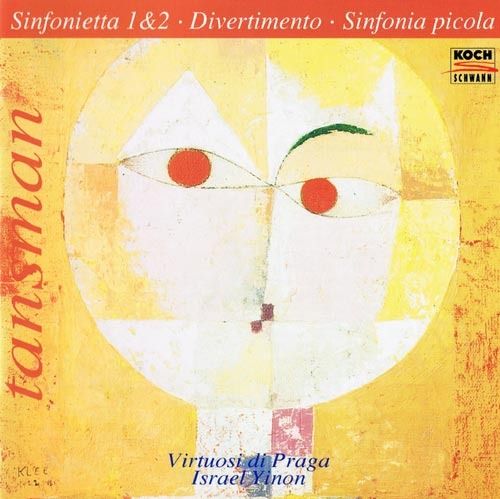
Music Composed by Alexandre Tansman
Played by the Virtuosi di Praga
Conducted by Israel Yinon
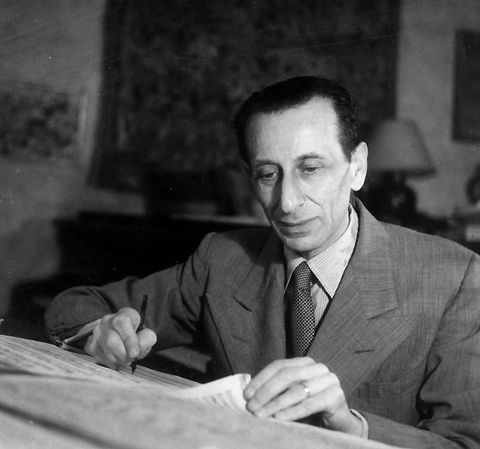
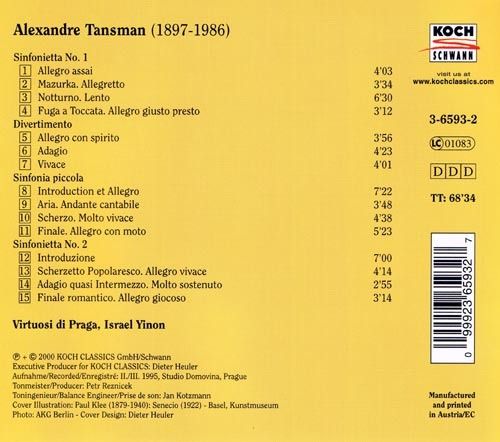
Source: Koch Schwann CD (my rip!)
Formats: FLAC(RAR), DDD Stereo, mp3(320)
File Sizes: 265 MB / 156 MB
The FLAC link has now expired. No more requests for this, please!
mp3 version -
https://mega.nz/#!eUsgFARZ!sq6CFhtIikrZ9Cmgw0Bh_ccaQnpEXUtbxYGB6PRQ0H4
Enjoy! Don't share! Buy the original! And please click on "Like" if you downloaded this album! :)
bohuslav
08-21-2015, 09:39 PM
Great recording, many thanks wimpel69.
wimpel69
08-22-2015, 04:15 PM
No.806
Late Romantic/Light Music
A native of Luxembourg, Lou Koster was largely self-taught as a composer,
flourishing in the interwar period as a pianist whose activities included
accompanying silent films. Orchestrated from piano originals, pieces such as
Lore-Lore and Moseltr�ume were radio hits in the 1930s, and Koster
became renowned for subtle, sensuous light music filled with unexpected turns
and emotional nuances.
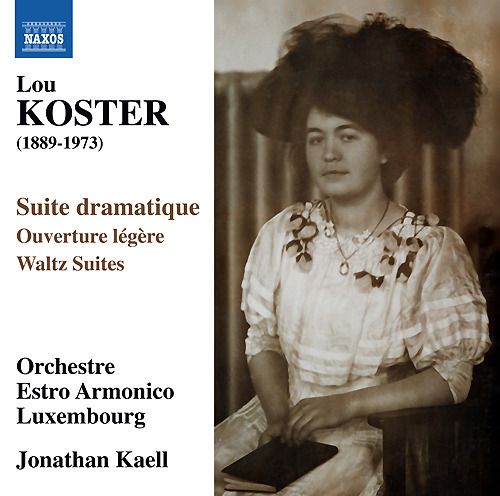
Music Composed by Lou Koster
Played by the Estro Armonico Luxembourg Chamber Orchestra
Conducted by Jonathan Kaell
"One of the most difficult aspects of researching early film music from the Silent Film era is knowing just who wrote
what if the music even survives. Often, movie house pianists, or organists, played from a preset collection of
Classical musical themes with some dramatic musical gestures occasionally credited with a composer. American
film music fans tend to forget that other country’s movie houses often featured local composers writing music for
the silent screen, much of which has also been lost. All of this serves to help provide a bit of context into which
we can now discuss Lou Koster (1889-1973).
Koster played in local palm court salons, movie houses, cafes and elsewhere honing in musical talent, but it was
as a composer that she began to feel more pulled artistically. It was between the two word wars that Koster
began finding opportunities to publish her songs and other piano works in Luxembourg. She would provide a
large variety of light orchestral music of waltzes, marches, overtures, etc. Most of her music survives in
autograph form with very little annotation about when they were composed. The bulk of the pieces on this new
Naxos release, all world premiere recordings, list most of these as being from the 1920s. Thus they lend us a
window on Luxembourg’s musical life. It is worth noting that Koster’s music was quite popular throughout her
lifetime being recorded well into the 1950s, and performed by radio orchestras well into the 1960s. Many of
her orchestral pieces are believed to have been put together from some of her silent film music and many
were performed by salon orchestras at the time. Sometimes she would create fuller orchestrations which
were then performed by the Radio Luxembourg orchestra. Much of her work is believed “lost” or yet to be
rediscovered, but some 250 pieces (!), itself a phenomenal accomplishment, are currently available at the
Lou Koster archive at Cid-Fraen an Gender (Cid-Femmes - Frauen in Politik, Kultur und Gesellschaft (
http://www.cid-femmes.lu)).
For this program, conductor Jonathan Kaell has selected seven works. Two of these, “Lore-Lore” and
“Moseltraume” (both waltz suites), were performed over 111 times during World War II. At the center is
a brief Suite Dramatique. The program begins though with the Overture Legere. The music is a perfect
example of the 1920s orchestral lighter music somewhat like a a French operetta overture with delightful
melodies and fun little touches in the orchestra. The shape allows for returning thematic material to tie
things together. Koster’s harmonic language is also moving into unexpected places. One could certainly
feel transported to the premiere of a new film with this music setting the stage for its beginning. Her
language falls into place with late Strauss family, Gade, and perhaps comes closest to Victor Herbert
when all is said and done—and that is some great company to be in! We are back in the dance salon for
the beautifully rich “waltz-suite” Lore-Lore, Op. 13. Composed around 1914, it still hearkens back to
the end of the 19th Century (as did Eduard Strauss’ work). The melodic writing is always engaging here
and it makes this music quite delightful. The same can be said for the ideas heard in Heideland from
the next decade.
At the center of the program is a collection of three little pieces into the Suite dramatique. These may
be taken from some of Koster’s film piano scores as one can hear how smaller segments of the music
recur immediately and then set the stage before moving on to another idea. Each of the movements
is strikingly evocative music with her catchy melodic phrases, orchestral coloring, and harmonic turns.
The program then concludes with three sets of waltzes, Unter bluhenden Linden, (with nods to Johann
Strauss, Jr.), her popular Moseltraume, and concluding with Toute vie.
Kaell and the Luxembourg players give their all in this performance with wonderfully-shaped playing
that really allows Koster’s orchestral style to be well represented here. The music is treated with the
sort of respect it truly deserves and with a little luck, perhaps more from the Koster archive can, or
is on the way, to being made available. Simply wonderful music representing the lighter side of the
inter-war period."
Cinemusical
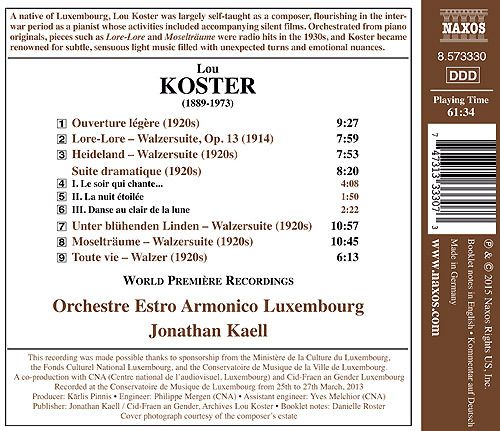
Source: Naxos CD (my rip!)
Formats: FLAC(RAR), DDD Stereo, mp3(320)
File Sizes: 273 MB / 148 MB (FLAC version incl. covers & booklet)
The FLAC link has now expired. No more requests for this, please!
mp3 version -
https://mega.nz/#!6Q9BlDLJ!NdoEcqtkQlYkZA96nbbK_6PrmFk4qchSA6S-gc4LM4A
/>
Enjoy! Don't share! Buy the original! And please click on "Like" if you downloaded this album! :)
---------- Post added at 05:15 PM ---------- Previous post was at 04:30 PM ----------
No.807
Late Romantic
The second CD in PENTATONE’s dance music series lets you savour the famously vibrant compositions from
the German-speaking countries. Connected by the power of music, inspired by fin de si�cle, this CD glorifies
the influential ballet/theatre/opera music from the interwar period. These are vigorous performances of famous
works and the Orchestre de la Suisse Romande is in top form. The music is familiar, yet there is always
room for conductor Kazuki Yamada and the orchestra to approach it with verve, inviting listeners to
remember what they enjoyed so much about it in the first place. This is a wonderful collection of late romantic
music connected with "the dance" in some for or other.
Includes:
Richard Strauss: Dance of the Seven Veils from "Salom�"
Ferenc Liszt: Two Episodes from Lenau’s Faust
Erich Wolfgang Korngold: Straussiana
Ferruccio Busoni: Tanzwalzer
Franz Schreker: Ein Tanzspiel
Richard Strauss: Rosenkavalier - First Waltz Suite
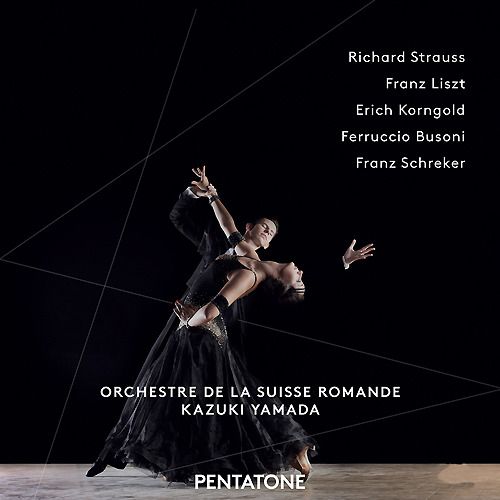
Music by Franz Schreker, Richard Strauss, E.W. Korngold, Ferruccio Busoni & Ferenc Liszt
Played by the Orchestre de la Suisse Romande
Conducted by Kazuki Yamada
"This varied collection of music associated with 'The Dance' is what record companies used to call a 'sonic
spectacular' – a description well suited to this SACD. 65 minutes of captivating music, executed with style
and flare, and recorded in state-of-the-art sound will be for many a no-brainer."
SACD Net
"It’s a dramatic and dynamic recording in 5.0 surround, and well- designed to get listeners engaged.
Many of the pieces performed will already reside in many collectors’ collections, but the performance
and recording are noteworthy enough to give this disc more than a passing listen."
The Audiophile Edition
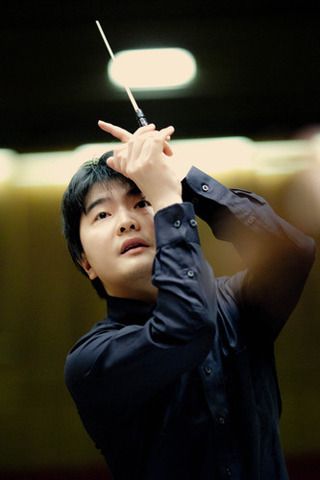
Source: Pentatone Classics CD (my rip!)
Formats: FLAC(RAR), DDD Stereo, mp3(320)
File Sizes: 294 MB / 155 MB (FLAC version incl. cover & booklet)
The FLAC link has now expired. No more requests for this, please!
mp3 version -
https://mega.nz/#!qIFg1DYb!GoyTospcPqct25qPby4ioSt2kME0ToP2ZXOMwrP00Vo
Enjoy! Don't share! Buy the original! And please click on "Like" if you downloaded this album! :)
booster-t
08-22-2015, 08:00 PM
Thanks for Sidney Torch: Light Orchestral Works ... these CDs of light orchestral British music are a treat.
Lukas70
08-23-2015, 12:59 PM
Thanks a lot for Atterberg! I will wait for Volumes 2 and 3....
gpdlt2000
08-23-2015, 01:24 PM
Many thanks for the very interesting Lou Koster.
You're a champ, wimpel!
wimpel69
08-23-2015, 02:30 PM
No.808
Modern: Neo-Classical
Joly Braga Santos was born in Lisbon in 1924 and died there in 1988, at the height of his musical
creativity. Although he composed only six symphonies, he was undoubtedly the leading Portuguese
symphonist of the century and, in a way, of all time. Apart from an innate sense for good orchestration,
his musical language is based on a strong sense of musical architecture as well as drama, with long
melodic lines and a natural instinct for structural development as well as formal coherence. Having studied
violin and composition at the Conservatory in Lisbon, he became a disciple of Lu�s de Freitas Branco
(1980–1955), the leading Portuguese composer of the preceding generation. Although he was not
particularly interested in the Portuguese folklore, studying and composing at the country home of his
mentor, in the rural south of Portugal, the Alentejo, he willingly accepted the influence of local folk
songs that he considered “of mesmerizing originality and grandeur”.
The Concerto in D is dedicated to the Academy of Chamber Instruments of the Portuguese Radio,
which gave the work its world premi�re. The modal writing (Phrygian mode) is immediately apparent
in the initial theme, which is the basis for the slow introduction, marked Largamente maestoso. One
also notices, following the opening tutti, another characteristic of Braga Santos’ writing: the use of
instrumental solos, in this case, the solo violin, viola and cello, contrasting with the tutti. The Allegro
which follows is based on two themes: the first one, with an incisive rhythm, is like a fast version of
the initial theme, while the second one, lyrical in character, is played by the violins with the cellos
and basses in imitation. The movement follows the traditional sonata form of exposition, development,
recapitulation and coda. The second movement, slow, with the direction Adagio non troppo, also
tripartite in structure, with the central section in marked contrast, is one of the most expressive
movements by Braga Santos. It is certainly not a coincidence that I conducted it at the request
of the composer’s widow during the Mass at the funeral of Braga Santos in 1988. The third
movement, Allegro ben marcato, has the character of a popular dance in 514. It is a rondo with
a coda in triple metre.
The Sinfonietta for string orchestra, composed in 1963, is dedicated to Alvaro Cassuto
and the Gulbenkian Chamber Orchestra. I conducted its premi�re in 1963. Scored for twelve
solo strings, four first and three second violins, two violas, two cellos and one double bass, the
work has three movements. The first of these has a slow introduction, marked Adagio, in which
the first solo violin plays a leading role immediately after the initial unison. Following freely
sonata form, although without a recapitulation, the Allegro has a first theme played by the strings
in which the twelve solo instruments are treated like an orchestral tutti, while the second theme,
influenced by Portuguese folk-music, is lyrical, being entrusted to two solo violins with a pizzicato
accompaniment by the remaining strings. The second movement Adagio has an introduction in
which Braga Santos explores tone colours which, to a certain extent, reflect the influence of the
Second Viennese School of Schoenberg and his disciples Alban Berg and Anton Webern. The
central part of the movement is a long melodic line in the first violins in unison. The coda of this
movement is performed by the solo violin with an accompaniment of sustained notes by the
remaining eleven players, each one of whom plays a different note. In the last bars, Braga
Santos shows clearly that he did not eschew the influence of tone clusters of the avant-garde
of the 1960s. The third movement, with the direction Allegro ben marcato, ma non troppo,
is in free sonata form. The first theme has an incisive character while the second lyrical theme
is played by four solo instruments, two violins, one viola and one cello. Before the final coda,
the movement is interrupted by a Largo in which the first solo violin is accompanied by the
remaining strings in a fashion which is similar to that of the coda of the second movement.
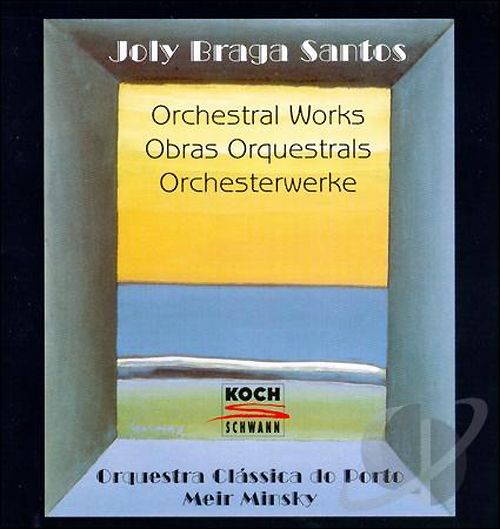
Music Composed by Joly Braga Santos
Played by the Orquestra Cl�ssica do Porto
Conducted by Meir Minsky
"It is always a source of joy and excitement to introduce a composer of world-class stature
whose origins are somewhat outside the boundaries of the mainstream, and the Portuguese
Joly Braga Santos (1924-88) fully qualifies. Although Portugal played a role in the musical life
of the pre-Baroque era, its subsequent eclipse was not dissipated until the early years of this
century when Luiz de Freitas Branco (1890—1955) re-established a connection with late-
Romantic and early-impressionist developments on the continent. Although the older and
de Falla-like Fernando Lopes-Graca (b. 1906) was the first of de Freitas's many pupils to
make an independent name for himself. There's no argument about Santos being the mos
t talented of his students from the younger generation. Over the past fifteen years or so the
Portuguese have been issuing a distinguished series of compact discs documenting the
accomplishments of this school. Unfortunately these have not received wide distribution
here: only Records International of Goleta. California has imported them on a regular basis.
So this Koch-Schwann is the first appearance - a trial balloon perhaps?- of any music by
Santos under the auspices of a large international distributor.During the close to four
decades of his creative activity, Santos's style underwent a dramatically irresistible
evolution from the eloquent medieval modalisms (which have many points in common
with the modal idioms of Vaughan Williams, Bloch. and Kod�ly) as couched in lucid neo-
Baroque forms, heard especially in the 1951 Concerto in D here and somewhat modified
in the later 1963 Sinfonietta. to a highly charged. more densely rhapsodic chromaticism
which occasionally verged on the atonal. (Incidentally, the producer's overall designation
of this program as "orchestral" is strictly speaking misleading as all except the relatively
brief opening and closing works here are written for string orchestra alone—which was in
fact one of Santos's favorite and most characteristic mediums.)"
Fanfare

Source: Koch Schwann CD (my rip!)
Formats: FLAC(RAR), DDD Stereo, mp3(320)
File Sizes: 276 MB / 141 MB
The FLAC link has now expired. No more requests for this, please!
mp3 version -
https://mega.nz/#!iE8WDTRa!2c2Uctt2_n2DaJ-f7pqU--yrExHMFBNljw1inc5BSFE
/>
Enjoy! Don't share! Buy the original! And please click on "Like" if you downloaded this album! :)
booster-t
08-23-2015, 03:25 PM
Thanks also for the Lou Koster CD ... very pleasant and a worthy addition to the collection.
Darius Freebooter
08-24-2015, 12:18 PM
Many thanks for the Tansman, wimpel.
wimpel69
08-25-2015, 05:01 PM
No.809
Modern: Romantic
He was an immediate contemporary of Shostakovich, Kabalevsky, and Khachaturian, but in contrast to
them his name is forgotten today (unless we know that his conductor-grandson bears the same name):
Vladimir Michailovich Jurowski (1915-1972). Like the composers named above, Jurowski studied with
Myaskovsky. Beginning in 1938 he worked as an independent composer. He occupied himself with a wide
range of genres, from the opera and the symphony, through chamber music and vocal works, to music
for many feature films and cartoons. Jurowski was a master at capturing the popular tone. His music is
dazzlingly instrumented and always melodious and stirring. His son Michail Jurowski, to whom cpo
owes many wonderful interpretations, wanted to have some of his father’s compositions made available in
audio form. The seven symphonic pictures of the Russian Painters in particular form a cycle reflecting
the pictorial world of each of the artists concerned in rich contrasts and with incredible impressiveness.
Just remember: it was only a few years ago that only a couple of insiders had heard of Jurowski’s
contemporary Mieczyslaw Weinberg!

Music Composed by Vladimir Michailovich Jurowski
Played by the Norrk�ping Symphony Orchestra
Conducted by Michail Jurowski
"Not to be confused with his conductor grandson Vladimir Mikhailovich, or with his son Michail Vladimirovich
who conducts on the present disc, Vladimir Mikhailovich Jurovski (as on the booklet cover) or Jurowski (as
in the booklet essay) or Yurovsky (as in the reference books) senior was a Ukrainian-born composer, the
last of whose five symphonies, here recorded, was completed in December 1971, barely a month before his
death at the age of 56. The CD marks the centenary of his birth.
As might be expected of a pupil of Myaskovsky, the musical construction is solid and traditional, in three
movements lasting some 45 minutes. The style is eclectic, ranging from Tchaikovsky, Rachmaninov and
Myaskovsky himself, through Prokofiev (Symphony No 6) and Shostakovich (Symphonies No 6 and 10, the
Hamlet film score), and the construction somewhat loose-limbed, especially as regards the 21-minute
first movement. An organ entry signals the grand conclusion – ‘aiming at empty pathos’ according to the
English version of the booklet-notes, though ‘targeted at’ would be a more precise translation.
The seven ‘symphonic pictures’ that make up the cycle Russian Painters resulted from a 1956 Moscow
exhibition of artworks on loan from Leningrad; six of the seven paintings are reproduced in black-and
-white in the booklet, and all may be found in colour on the web. Like them, the music covers a gamut
of appealing traditional Russian idioms, in a kind of latter-day Pictures at an Exhibition.
Devoted performances and excellent recording make this an attractive disc for anyone interested
in the relatively conservative side of Russian music of the Soviet era."
Gramophone
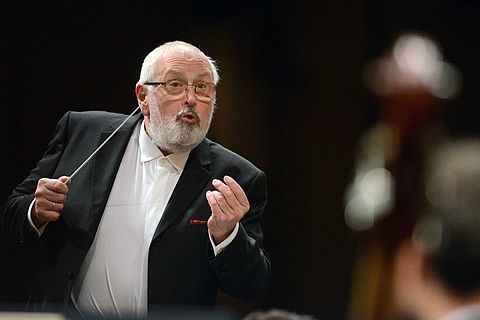
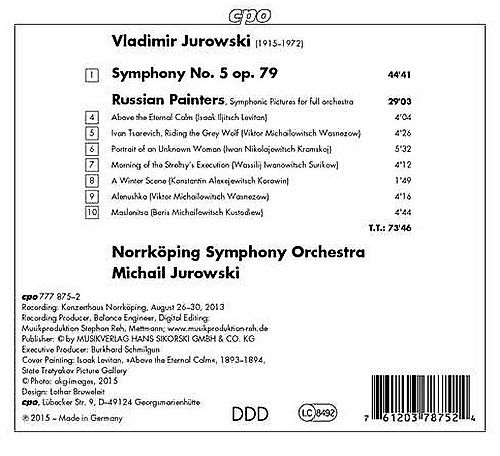
Source: CPO Records CD (my rip!)
Formats: FLAC(RAR), DDD Stereo, mp3(320)
File Sizes: 477 MB / 199 MB (FLAC version incl. covers & booklet)
The FLAC link has now expired. No more requests for this, please!
mp3 version -
https://mega.nz/#!nB9DjZIR!Swvb-daY0o4wOgCVKA3w29mQtk03LAQNZFHwBcKvE5M
/>
Enjoy! Don't share! Buy the original! And please click on "Like" if you downloaded this album! :)
bohuslav
08-25-2015, 05:15 PM
Never heard from this composer. Let give me a try. Many thanks wimpel69.
wimpel69
08-28-2015, 11:20 AM
No.810
Modern: Avantgarde/Neo-Tonal
Alan Hovhaness’s remarkable legacy of 67 symphonies and hundreds of other
works stands as a testimony to one of the most individual musical voices of the
20th century. Written when Hovhaness was 25, the Prelude and Quadruple Fugue
represents not only his mastery of counterpoint but in its sweeping climactic form
is also one of his most exciting works. The Soprano Saxophone Concerto is
like a melodic tone poem or aria, and considered the most Romantic concerto Hovhaness
ever wrote. “Inspired by the wonders and mysteries of astronomy” and appearing
here in its premi�re recording, the Symphony No. 48 ‘Vision of Andromeda’
expresses the vastness of this galaxy through giant melodies, shimmering
orchestral colors and a transcendent apotheosis.
A different recording of Hovhaness's Saxophone Concerto, made by the same
soloist(!), can be found >here< (
http://forums.ffshrine.org/f92/wimpel69-concerto-collection-flac-work-progress-130729/5.html#post2373892).
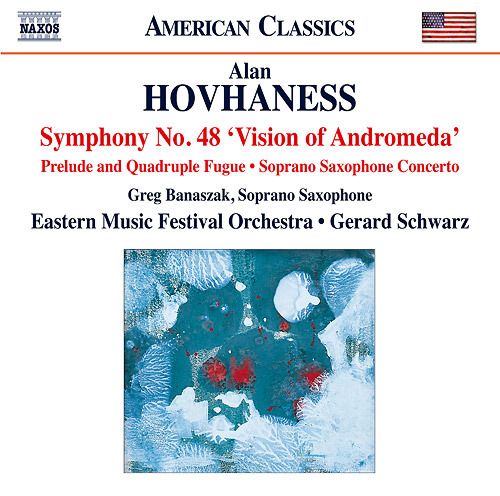
Music Composed by Alan Hovhaness
Played by the Eastern Music Festival Orchestra
With Greg Banaszak (saxophone)
Conducted by Gerard Schwarz
"Alan Hovhaness’ Symphony No. 48 is subtitled “Vision of Andromeda”, and anyone who has
seen the Hubble photos of our neighboring galaxy knows just how gorgeous that must be. For years
I used one of those magnificent vistas as my computer’s screen saver. This four-movement symphony,
lasting just under half an hour, is typical Hovhaness. There are lovely, modal fugues in the second
movement and finale; evocative, vaguely oriental melodies all over the place; luscious string chorales,
and interludes for bells and tam-tam. Check out the opening of the finale (sound clip). Fabulous,
isn’t it? Does it do justice to Hovhaness’ “vision”? It’s plausible.
The truth is, Hovhaness always has had his detractors. Bernstein rather maliciously called his First
Symphony “ghetto music” (which would be a compliment today), and his 67 symphonies and other
works can sound rather the same–but then, so does a lot of Bach. For me anyway, there’s something
disarming about his childlike joy in consonant harmony, in the fluidity of his fugal writing, and his utter
unconsciousness of the fact that his melodies often tread dangerously close to kitsch. Say what you
will, his music is unfailingly honest. It is what it is.
There are also moments where it achieves an astonishing, passionate intensity. The Prelude and
Quadruple Fugue is, in its way, a masterpiece in considering the means by which it accumulates
energy as each distinctively-wrought fugue subject enters and gets combined with its predecessors.
It’s so clear, so easy to follow, and so much fun that you entirely forget the sophisticated contrapuntal
mind at work behind the scenes. And that is as it should be.
The Concerto for Soprano Saxophone and Strings also sounds vividly tuneful and unfailingly attractive.
When Hovhaness calls the finale, perhaps naively, Let The Living and The Celestial Sing, it’s easy to
scoff, but the music is just so bloody pretty. Greg Banaszak plays the solo part with the suave timbre
that the work requires, especially in the Adagio espressivo at the start of the second movement, while
Hovhaness specialist Gerard Schwarz does his usual fine job with all three works, galvanizing the
players of the Eastern Music Festival Orchestra to a welcome degree of corporate integrity. It helps,
of course, that Hovhaness’ music is as straightforward to play as it is to hear. Beautiful."
Dave Hurwitz, Classics Today
http://i1164.photobucket.com/albums/q574/taliskerstorm/p10s10_zpslom0ycnb.gif
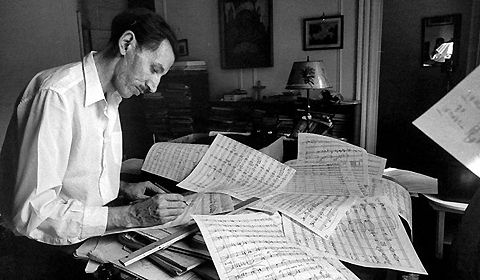
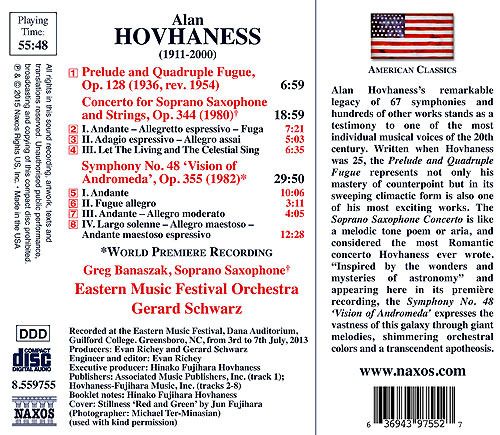
Source: Naxos CD (my rip!)
Formats: FLAC(RAR), DDD Stereo, mp3(320)
File Sizes: 226 MB / 128 MB (FLAC version incl. cover & booklet)
The FLAC link has now expired. No more requests for this, please!
mp3 version -
https://mega.nz/#!3Ys3QZrb!1abdPR7io0Uz2L12YxgTn2mZxPst0Yigu2TQnunrYJw
Enjoy! Don't share! Buy the original! And please click on "Like" if you downloaded this album! :)
---------- Post added at 12:20 PM ---------- Previous post was at 11:22 AM ----------
PLEASE NOTE
There were three releases that didn't have either FLAC or mp3 links left (in the short phase when I switched to limited-time-FLAC without providing mp3 links).
I have now made mp3/320k versions of these three albums available. They are:
No.563 - Giannini: Concerto Grosso, Prelude and Fugue - Flagello: Serenata - Gould: Harvest
http://forums.ffshrine.org/f92/wimpel69s-could-film-music-classical-corner-work-121898/47.html#post2634391
No.564 - Paul Chihara: Forever Escher, Shinju, Windsong
http://forums.ffshrine.org/f92/wimpel69s-could-film-music-classical-corner-work-121898/47.html#post2638502
No.566 - Berkeley, Crossley-Holland, Seiber, Crosse, Manduell: Music for Strings
http://forums.ffshrine.org/f92/wimpel69s-could-film-music-classical-corner-work-121898/48.html#post2651093
wimpel69
08-31-2015, 10:45 AM
No.811
Modern: Tonal
The Viola Concertino, op.14 is an early, but quite characteristic work, in which Rawsthorne’s influence
may still briefly surface, but which manages to be already quite individual in tone and design. The composer
already displays his life-long liking for palindromic structures, as well as his instrumental and orchestral flair.
The title of the work may be a bit misleading, for neither the musical substance nor the actual size really justify
such a diminutive title. In fact, this is a substantial work scored for small orchestra, so that the soloist is never
drowned by the orchestra and the instrument may thus sing in its most eloquent register.
Hoddinott’s slow movements, either in his symphonies or in his concertos, are very often cast as nocturnes.
He also composed an orchestral work titled Night Music Op.48. By the way, the first movement of the Viola
Concertino is a nocturne too. No wonder that his first cello concerto was titled Nocturnes and Cadenzas, op.62,
thus perfectly summing-up the work’s global structure consisting of three nocturnes interspersed by two cadenzas
functioning as bridge passages. The work as a whole is structured as a large-scale arch-form, one of the composer’s
favourite designs. As already hinted earlier in this review, the scoring is masterly, carefully balanced so that the
orchestra never competes with the soloist. The scoring also emphasises a characteristic of Hoddinott’s mature
orchestral writing in the subtle and telling use of percussion. This is one of Hoddinott’s most impressive
masterpieces, and I welcome its return to the current catalogue.
The choral works are quite contrasted, although obviously from the same pen. Dives and Lazarus, op.39 was
commissioned by the Farnham Festival for the combined forces of Aldershot High School and Farnborough
Grammar School, with two adults soloists (soprano and baritone). The music is somewhat simpler and more
straightforward, although the composer never writes down to suit amateur musicians. The work is strongly
structured and tightly knit through the use of recurring germ cells, while the vocal parts are eminently grateful
to the voices.
Sinfonia Fidei, op.95 is a large-scale piece for soloists, chorus and large orchestra, at once a work
clearly devised for professionals and one of Hoddinott’s most direct public statements.
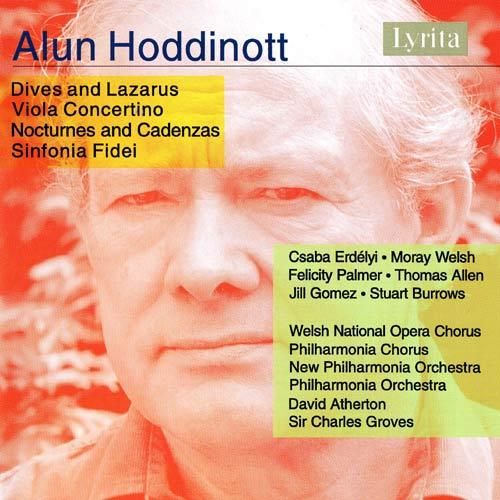
Music Composed by Alun Hoddinott
Played by the New Philharmonia Orchestra
With Felicity Palmer (soprano) & Thomas Allen (baritone)
And Csaba Erd�lyi (viola) & Moray Welsh (cello)
And the Welsh National Opera and Philharmonia Choruses
Conducted by Sir Charles Groves & David Atherton
"An excellent companion to the three Hoddinott symphonies reviewed above. As reissued on
a single, generously filled CD this collection even has a characteristically Hoddinottian 'reflecting
panels' structure: Dives and Lazarus, a cantata for schools that sensibly recognizes that there are
elements of traditional choral writing that might just as well be reused because they are idiomatic,
finds a striking reflection and apotheosis in the Sinfonia Fidei, where traditional harmony becomes
by turns radiant, solemn and majestic. And yet it does not really sound like a revival of the Great
British Choral Tradition; it has a hieratic, ritual quality (Geraint Lewis in his accompanying note
calls it "Byzantine") that I suspect John Tavener would recognize more readily than Sir Hubert
Parry, and why it has not become hugely popular is beyond me.
I feel more at home, even so, with the two intervening pieces, especially Nocturnes and Cadenzas,
an ideal work to try if you want to find out whether Hoddinott is for you: its three nocturnes
(darkly glinting and calmly peaceful on either side of what I hear as a storm-nocturne with a hush
at its centre) are finely coloured and quite characteristic, and the linking cadenzas have both
clear structural function and expressive weight. The Concertino for viola has a particularly
eloquent finale (no doubt significantly it is an early example of Hoddinott's use of an arch-like
form) and both of these concertante pieces are extremely well played. So are the others (how
fortunate Hoddinott has been in his soloists), and the recordings still sound well."
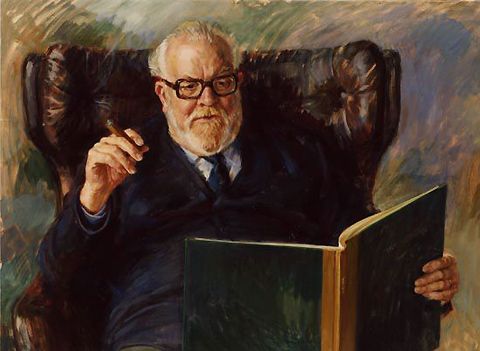
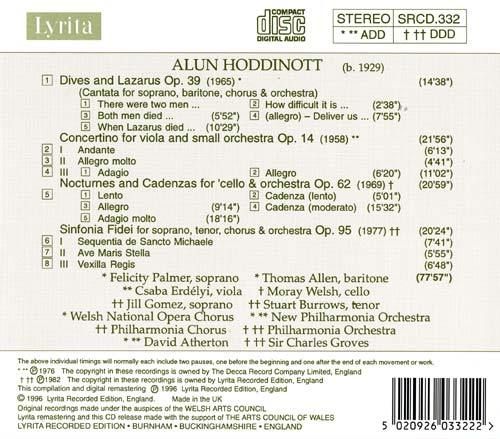
Source: Lyrita Records CD (my rip!)
Formats: FLAC(RAR), ADD/DDD Stereo, mp3(320)
File Sizes: 362 MB / 217MB (incl. covers & booklet)
The FLAC link has now expired. No more requests for this, please!
mp3 version -
https://mega.nz/#!YNMFhaCC!_jAWn6lpQncqe-ZXdlU1ubdvTkfrrNV0Sco374HwpGk
/>
Enjoy! Don't share! Buy the original! And please click on "Like" if you downloaded this album! :)
wimpel69
08-31-2015, 11:54 AM
No.812
Modern: Neo-Classical
Alberto Ginastera’s dazzling Glosses on Themes of Pablo Casals, heard here in both its original
version for string quintet and string orchestra and its later fully-orchestrated version, pays tribute to his
close friend, the legendary cellist (and composer) on the occasion of the centenary of Casals’s birth.
The Variaciones concertantes places a variety of instruments in the limelight with featured solos,
culminating in a virtuosic malambo, the archetypical gaucho ‘jousting’ dance whose vertiginous motion
engenders frenetic enthusiasm among both participants and onlookers.
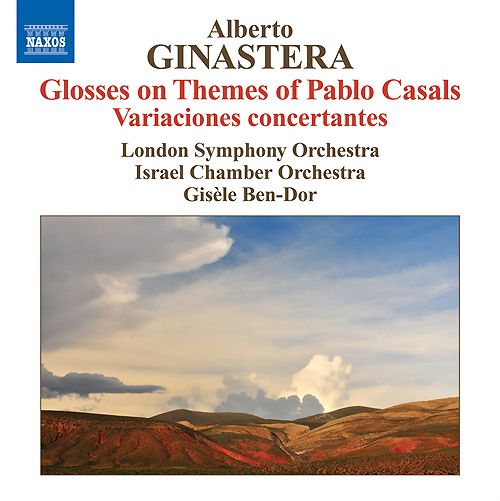
Music Composed by Alberto Ginastera
Played by the London Symphony & Israel Chamber Orchestras
Conducted by Gis�le Ben-Dor
"I highly recommended Naxos’s release of Ginastera’s ballets, Panambi and Estancia, from
Gisele Ben-Dor and the London Symphony Orchestra (8.557582), and they now continue the
series with more outstanding performances. Though born and educated in Argentina, Ginastera
moved to the States to further his education in his late twenties, and afterwards spent time
in a number of locations. Recordings of his music are still few, the present disc invaluable in
offering both the original version of Glosses for string quartet and string orchestra and the
later reworking for large orchestra. The first was completed in 1976 to mark the birthday
centenary of the famous cellist, Pablo Casals. Then Rostropovich asked Ginastera to write a
work for his National Symphony Orchestra in Washington D.C. and they agreed that the
original Glosses should be expanded to a work that almost overflows with colour. In doing
so he changed the fundamental nature of the score so that the two works can sit happily
next to one another and to be enjoyed on very different levels, the string version intense,
while the orchestral score is full of brio. Here they are separated by the 1953 score,
Variaciones concertantes. In twelve sections and scored for a modest sized ensemble,
it uses all the various orchestral principals as soloists, from the harp to the trombone,
the viola given a particularly difficult time. He then brings everyone together for a final
Rondo. Excellently performed by the Israel Chamber Orchestra, the LSO’s overt
showmanship is ideal for Glosses. The recording, which made a brief appearance a
few years back on the Koch label, is of demonstration quality."
David's Review Corner
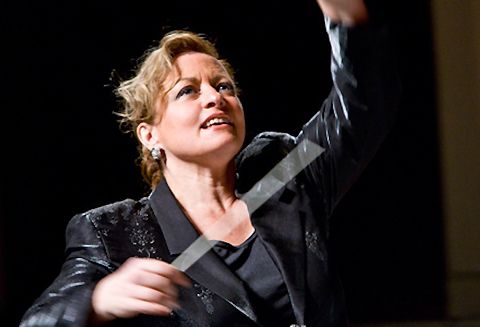
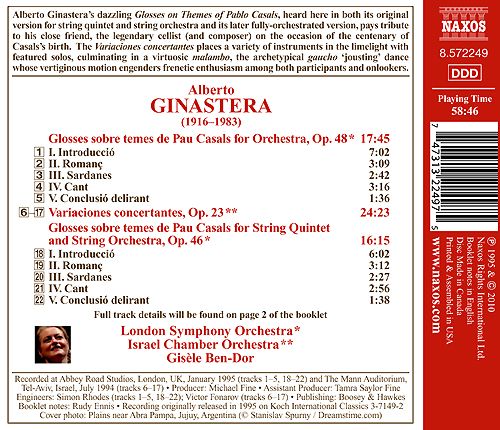
Source: Naxos CD (my rip!)
Formats: FLAC(RAR), DDD Stereo, mp3(320)
File Sizes: 222 MB / 134 MB (FLAC version incl. cover & booklet)
The FLAC link has now expired. No more requests for this, please!
mp3 version -
https://mega.nz/#!TU1yHTxY!OHrq_H6fVNPprrxngA_ZAdiPBgyVtvrYXU_x1YRtqfo
Enjoy! Don't share! Buy the original! And please click on "Like" if you downloaded this album! :)
wimpel69
09-01-2015, 09:25 AM
No.813
Late-Romantic
The countries bordering on or dominated by Russia provided an ample source of exoticism for composers, both
under the old regime and in the changed circumstances after 1917. Alexander Glazunov turned to Finland
for material in his C major Finnish Fantasy, Opus 88, written in Helsinki in 1909. The work makes imaginative
use of a simple folk-song, making a modest appearance, to be gradually developed. A dramatic interruption leads
to material of greater menace, to be followed by a strongly romantic passage. This in turn gives way to a well-
known Lutheran chorale, principally for the brass, with an urgent string accompaniment, and moving forward to
the dramatic conclusion of the Fantasy, based on elements of the chorale and earlier thematic material.
Three years later there followed Finnish Sketches, Opus 89, with its first movement drawing on the great
Finnish epic, the Kalevala. This last deals, in some fifty cantos, with the conflict between Kalevala, the country of
the Finns, and Pohjola, the North Country .The epic is traditionally sung to a so-called Kalevala melody, which
itself has regional variants. It is, however, normally syllabic, eight notes long, to fit the eight-syllable trochaic
tetrameters of the verse, with the last two, identical notes prolonged. Glazunov makes use of this ending in the
theme of the first of his Sketches, creating a miniature musical epic from the material, varying the melodic
formula and adding other accompanying elements. The second sketch, Solemn Procession, is based once
again on a simple theme, repeated with insistence, suggesting the progress of a solemn ritual procession and
leading to the brief appearance of the Lutheran hymn Ein' teste Burg ist unser Gott (A firm stronghold our
God is still), soon replaced by the final march motif.
Glazunov's Karelian Legend, Opus 99, was written in 1916, shortly before the composer's Second Piano
Concerto, which closes a stage in his career. In this work he turns to the disputed border region of Karelia
which had already drawn the attention of Sibelius, associated as he was with those determined to end Russian
domination of Finland. Glazunov's work, imaginatively scored, makes use of elements of folk-song in a colourful
work, dedicated to the Latvian composer Joseph Wihtol, a pupil of Rimsky-Korsakov and for a number of years
a member of the staff of the St Petersburg Conservatory, before he established himself in Riga, after 1918.
The Karelian Legend opens with an idyllic picture, but the music grows in excitement and intensity, as
the story unfolds, leading to a rhythmic dance and an exciting and triumphant episode, before it finally
dies away.
The Ouverture Solennelle, Opus 73, was written in 1900 and is highly characteristic of its composer,
combining, as it does, sureness of technique in orchestration and construction with the mood proclaimed
in its title. It finds a place for attractive and colourful melodic writing and mounting intensity in sequence
after imitative sequence, much of it based on a transformed and much repeated motif.
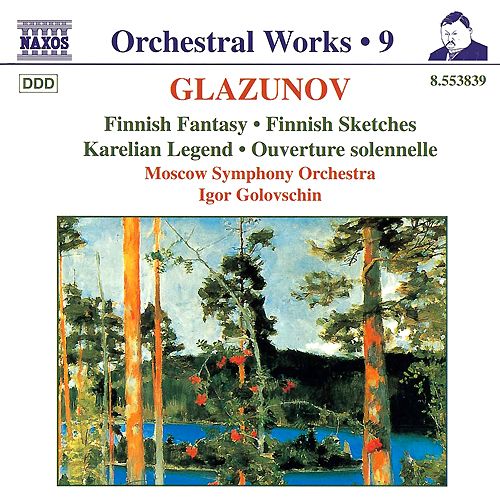
Music Composed by Alexander Glazunov
Played by the Moscow Symphony Orchestra
Conducted by Igor Golovschin
"The compositions on this disc represent a stab at "multiculturalism" (always an issue in imperial
politics) a century or so before the term came into use. Russia owned Finland, having acquired it
from Sweden in the eighteenth century under Peter the Great, and did not relinquish dominion until
until the abdication of the last Romanov in 1917. Even then Lenin and the Bolsheviks tried to keep
Finland in Mother Russia's fold, fomenting an attempt in Helsinki to stage a repetition of the St.
Petersburg coup-d'etat and otherwise trying to export their revolution. The Finns rallied against
their internal communist insurgency and gained independence after a bitter civil war. Ten years
earlier, Alexander Glazunov (1865-1936) had written the first of a number of orchestral works
celebrating the (then) Grand Duchy of Finland, one of which, the "Finnish Fantasy" (1909),
extends the hand of friendship to His Majesty's imperial subjects as far as quoting Luther's
hymn "Ein Feste Burg." (The Finns were predominantly Lutheran, having formerly been subjects
of the Swedish crown, their land in those days bearing the name of "Finnmark.") It is an effective
work, full of Karelian melodies not unlike those in Sibelius or Madetoja (both technically Russian
crown-subjects until 1917). The two "Finnish Sketches" mine the same Karelian vein and so
does the extensive "Karelian Fantasy," written in the very year when Finland at last became
Finland. Despite the Suomian material, it sounds (of course) like Glazunov: Brilliantly
orchestrated, competently joined, reasonably exciting. I have been fond of the "Finnish Fantasy"
since it appeared thirty years ago on an Angel-Melodiya LP conducted, I think, by Svetlanov.
Here Igor Golovschin leads the Moscow Symphony Orchestra, closing the program with the
suitably pompous "Overture Solennelle" and the delightful "Wedding March," both from
around the turn of the century. Ultimately, the Finns wanted Finns to celebrate them musically
("Give us Finlandia!"), but we are far enough removed from that rancorous debate to take
the music on its own lovely terms."
Amazon Reviewer
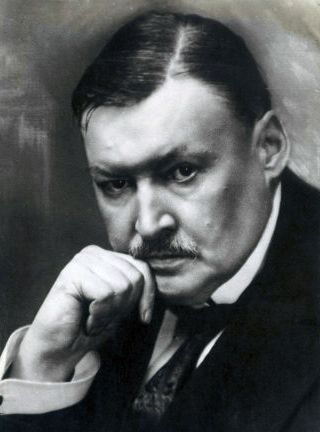
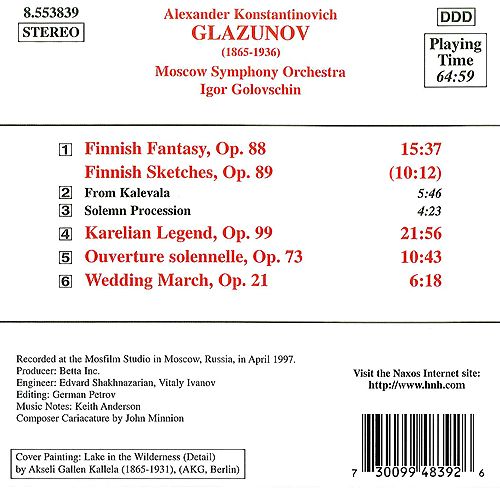
Source: Naxos CD (my rip!)
Formats: FLAC(RAR), DDD Stereo, mp3(320)
File Sizes: 260 MB / 150 MB (FLAC version incl. covers & booklet)
The FLAC link has now expired. No more requests for this, please!
mp3 version -
https://mega.nz/#!nYUx0A4S!4bEkf8-5O3_Oc5UhQf58FszDCG5WAh8FlfvM37JqTNo
/>
Enjoy! Don't share! Buy the original! And please click on "Like" if you downloaded this album! :)
booster-t
09-01-2015, 05:19 PM
Glazunov is a treat to listen to ... he has often been called a first rate second tier composer ... if you like Russian romanticism, get the whole Naxos series.
thehappyforest
09-02-2015, 05:33 AM
Huge thanks for the Hovhaness, been waiting to hear these works. Wimpel strikes again!
wimpel69
09-02-2015, 11:57 AM
No.814
Late Romantic
Alfredo Catalani (1854-1893) is best known today for his opera La Wally, but he
also experimented with a number of orchestral works, including three symphonies. Ero
e Leandro, Catalani’s last orchestral work, evokes the dramatic tragedy of the
Greek mythological lovers Hero and Leander who lived on either side of the Hellespont
(the modern Dardanelles). The brief Scherzo is a sparkling piece while the Andantino
is noteworthy for its fluid melodic line. The bel canto lyricism of Contemplazione contrasts
with Il Mattino, a single-movement Romantic symphony divided into several clearly
distinguishable sections.
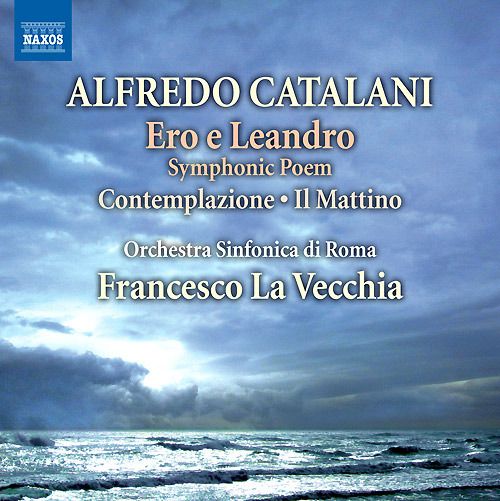
Music Composed by Alfredo Catalani
Played by the Orchestra Sinfonica di Roma
Conducted by Francesco La Vecchia
"All of these works are exquisite. Each piece is entirely original and doesn’t sound like
anything Italian I’ve ever heard. I’ve listened to this several times, and discovering these
works has not only been a real pleasure, but I feel I’ve missed out on some wonderful
music all these years. The orchestra plays beautifully under La Vecchia’s sympathetic
leadership."
The American Record Guide
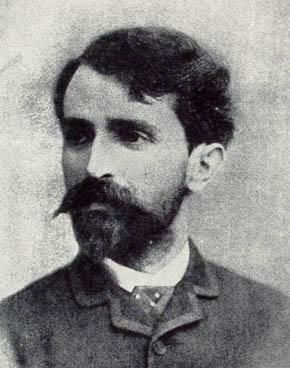
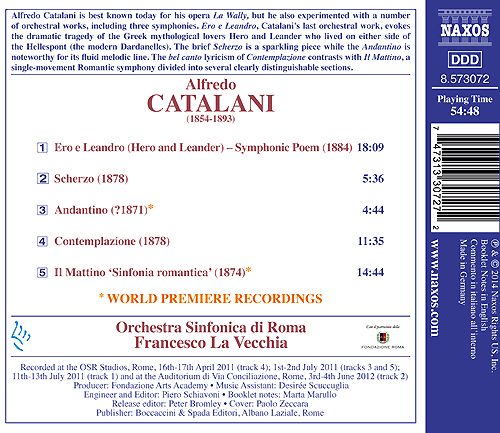
Source: Naxos CD (my rip!)
Formats: FLAC(RAR), DDD Stereo, mp3(320)
File Sizes: 255 MB / 129 MB (FLAC version incl. covers & booklet)
The FLAC link has now expired. No more requests for this, please!
mp3 version -
https://mega.nz/#!6JtlDQjR!3DC50BSVgpU1LPtlJRzwb2shrxH5tuqCzRSmQL4n9so
Enjoy! Don't share! Buy the original! And please click on "Like" if you downloaded this album! :)
wimpel69
09-03-2015, 10:06 AM
No.815
Modern: British Light Music
Trevor Duncan (real name Leonard Charles Trebilco) was born in Camberwell, London, England,
on 27 February 1924. By the age of twelve he could play by ear, but two years later he wanted to learn
to read music and study a technical analysis of what he was doing by instinct. He gained this knowledge
at Streatham Library where he found books by academics, and full scores to examine. For a year he
attended the Trinity College of Music for an external course on violin, harmony and counterpoint.
Although the violin study helped him later in scoring for strings, he was very disappointed by the
other aspects of the course. Like many of his contemporaries working in the same musical spheres,
he was to discover that practical experience would ultimately prove to be the best tutor.
When he reached eighteen, Duncan joined the British Broadcasting Corporation assisting in radio plays
by doing sound effects and playing discs of incidental music. His post-war years at the BBC allowed
him to experiment with microphone placings, often to the annoyance of producers, but the musicians
appreciated that he was merely trying to ensure that their music was heard to the best advantage, and
composer-conductors willingly answered his frequent questions on aspects of scoring. Together with
studying the scores of Rimsky- Korsakov, Duncan learned at first hand what certain combinations of
instruments could or could not successfully achieve; if a certain passage of music sounded particularly
effective in the sound control room, he would dash into the studio to study the relevant manuscripts—
perfect self tuition.
Trevor Duncan credits the late Ray Martin for giving him the necessary encouragement to explore
his talent in orchestration. For some while he had been balancing Martin’s Melody-From-The-Sky
programmes, and he eventually plucked up courage to show him the piano score of Vision in Velvet.
Seeing a favourable reaction from the maestro, Duncan asked that Martin might consider orchestrating
it for a subsequent broadcast performance with his orchestra. The refusal was instant: “No, you do it,
it’s all there already in your piano part.” A few weeks later a complete score was duly delivered to Ray
Martin, and for the first time Duncan heard one of his works performed by a large orchestra. Martin
suggested the title Morning Star for the broadcast, and this was also to be the first occasion that
‘Trevor Duncan’ became a recognized composer.
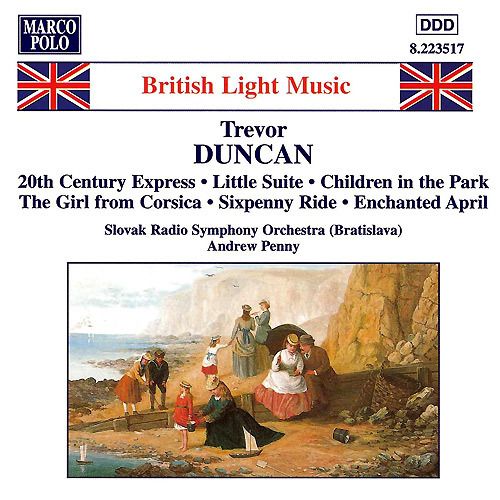
Music Composed by Trevor Duncan
Played by the Slovak Radio Symphony Orchestra
Conducted by Andrew Penny
"I have always enjoyed the music of Trevor Duncan. Best-known for his A Little Suite
from which the well-known ‘March’ was used as the theme tune of the original Dr. Finlay’s
Casebook, starring Andrew Cruikshank and Bill Simpson. However Duncan’s catalogue is vast.
He specialised in ‘mood music’ that could be used for newsreels and documentaries. Yet he
produced scores for the movies –Joe Macbeth, The Intimate Strangers. Duncan could rise to
an almost impressionistic height with his St. Boniface Down. His deeply romantic The Girl
from Corsica is one of the loveliest musical portraits in the genre.
Children in the Park was composed in 1954 and features the composer writing innocent
music with the backward glance from man for whom these activities are but a pleasant but
ever present memory. However there is nothing innocent or childish about the quality of
the music. They are diminutive masterpieces.
The first movement is ‘Dancing for Joy.’ Perhaps for ‘dancing’ we can read ‘running wild.’
There are echoes of half-remembered tunes in this short musical portrait that sounds like
something that could have been written for a chase scene in a Carry On film. The second
movement is a wistful little mediation about being ‘At the Pool.’ For those of us who were
alive in the fifties and sixties we can still recall model yachts launched by retired naval
gentlemen making their way across the water in the lakes in Regents Park in London or
Heaton Park in Manchester. So rare to see these days: I wonder where all the model boats
have gone? And then there is the opportunity to watch the duck and drakes feeding in
the shallows. Lasting just over two minutes this delicious piece is a complete portrait of
this magical location. The last movement reflects all the hustle and bustle of a traditional
game of hide and seek. Duncan makes characteristic use of woodwind to suggest chases
in and out of the trees.
One cannot listen to this music without being aware that simple as these three pieces
may appear, there is a poise that is largely classical: there is no doubt that a master’s
hand is at work in these miniatures. They achieve what ‘light music’ does best. They are
enjoyable, but also encourage the listener to sentimentalise about a lost way of life. What
chance model yachts in the age of xbox, Twitter and iPhones?"
Lands of Lost Content

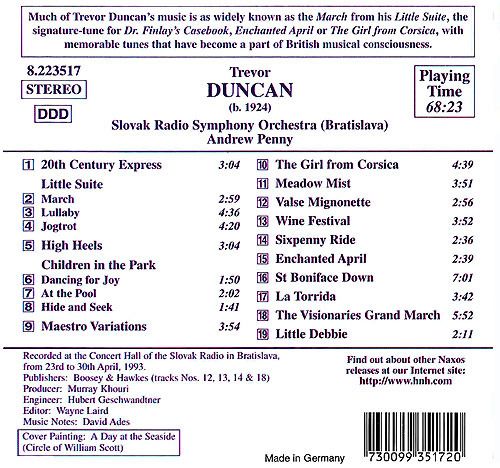
Source: Marco Polo CD (my rip!)
Formats: FLAC(RAR), DDD Stereo, mp3(320)
File Sizes: 312 MB / 156 MB (FLAC version incl. covers & booklet)
The FLAC link has now expired. No more requests for this, please!
mp3 version -
https://mega.nz/#!WN03CDTZ!K5uaKaQynX_-4vsg0N2C3d2oyq1vkwlsbYkjNrBOgIY
/>
Enjoy! Don't share! Buy the original! And please click on "Like" if you downloaded this album! :)
---------- Post added at 11:06 AM ---------- Previous post was at 10:59 AM ----------
The FLAC links for uploads Nos. 781-790 have now expired. No more requests for these, please!
javerystephens
09-04-2015, 04:40 AM
I know you have been told this countless times, but you are amazing, Wimpel!
wimpel69
09-04-2015, 09:24 AM
No.816
20th Century: Marches
Britain witnessed four coronations in the 20th century. Four new monarchs came to the throne whose
praises were played and sung throughout the land, indeed throughout the world. The 11 marches
recorded here display an excitement and grandeur appropriate to an important state and religious
occasion. They also highlight some of the finest ceremonial music composed in the 20th century,
while reflecting the changing styles in music over the years. Some of these marches have never
been recorded by a concert band before despite transcriptions being made soon after their
composition, and our CD shows how, in times past, the public would have first heard these pieces.
Includes:
March - Imperial Edward (Edward VII 1901), John Phlip Sousa
Coronation March Op. 117 (Edward VII 1902), Camille Saint-Sa�ns (arr. M. Retford)
Coronation March (Edward VII 1902), Sir Alexander Mackenzie (arr. J. Mackenzie-Rogan)
Coronation March (Edward VII 1902), Percy Godfrey (arr. Charles Godfrey)
Coronation March Op. 65 (George V 1911), Sir Edward Elgar (arr. Tom Higgins)
Coronation March (George V 1911), Sir Edward German (arr. Dan Godfrey)
The Crown of India Op. 66 (George V 1912), Sir Edward Elgar (arr. Frank Winterbottom)
Crown Imperial (George VI 1937), Sir William Walton (arr. W.J. Duthoit)
Orb and Sceptre (Elizabeth II 1953), Sir William Walton (arr. Norman Richardson)
Coronation March (Elizabeth II 1953), Sir Arnold Bax (arr. George Pollen)
Welcome the Queen (Elizabeth II 1954), Sir Arthur Bliss (arr. W.J. Duthoit)
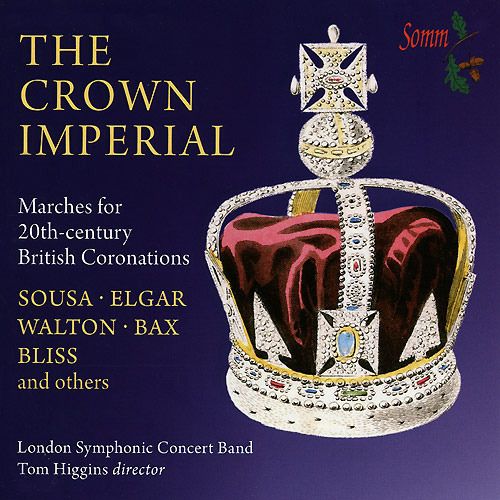
Music by [see above]
Played by The London Symphonic Concert Band
Conducted by Tom Higgins
"This is an interesting and imaginative concept, a mix of celebrated and little known and/or
forgotten pieces composed for 20th century coronations. The mix shows commendable
variety too in that the ear does not tire from an overindulgence of pomp.
The newly formed London Symphonic Concert Band of some fifty musicians has been
assembled from leading symphony orchestras and concert and armed services bands.
This is its first recording. All pieces except the Sousa March have been arranged for
wind band.
A most interesting and adventurous collection."
Musicweb
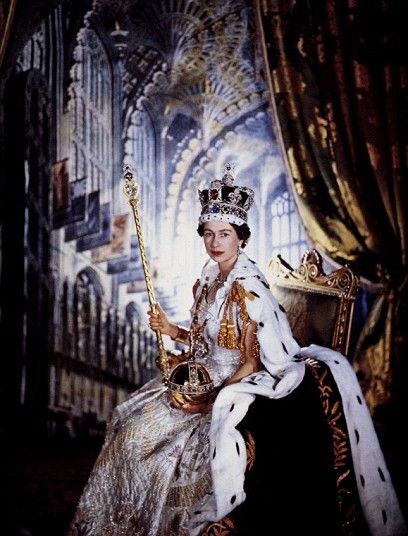
Source: Somm Recordings CD (my rip!)
Formats: FLAC(RAR), DDD Stereo, mp3(320)
File Sizes: 383 MB / 177 MB
The FLAC link has now expired. No more requests for this, please!
mp3 version -
https://mega.nz/#!yFlH3RJQ!Ng3f-XFDRbNETNu0jqhgJDP0pvsUNEivpcKHg6JvqCE
/>
Enjoy! Don't share! Buy the original! And please click on "Like" if you downloaded this album! :)
wimpel69
09-05-2015, 01:13 PM
No.817
Modern: Tonal
The music from Aaron Copland's Pulitzer Prize-winning ballet Appalachian Spring is
better known in the orchestral suite the composer extracted in 1945 in response to the work's instant
popularity. The Suite both expands on and excises the music, in the end eliminating about 10 or 11
minutes from the approximately 35-minute length of the original score. The work is heard here in
its original chamber-sized orchestration, but in the suite version. The ballet story is set in 1830
Pennsylvania and centers on springtime celebrations relating to the completion of a farmhouse built
for a young couple planning to wed. The music opens in a somber, almost athematic manner, the
mood ethereal and sleepy, as if spring is slowly taking hold, winter's snow still melting. Suddenly
the music springs to life with an infectious, lively theme that exhibits a folk-like quality, that spirited
sense of Americana that Copland was so famous for. In the Suite a xylophone is used to colorful
effect here, but the original score included only piano, strings, flute, clarinet, and bassoon.
Written at the tender age of eighteen, Samuel Barber's Serenade for String Quartet (or
String Orchestra) is the work of a talented student on the brink of individual mastery. I say "brink"
deliberately, since in some ways the work is extremely conservative, not least in its well-worn title (at
the urging of his uncle Sidney Homer, Barber would sharpen and modernize his titles very soon), it
s firm roots in late-Romantic European composition, and its strict classical forms. And yet there is
something mysterious, even tragic in this little work, a unique expressive seed out of which Barber's
later, more developed music would come: perhaps that is what caused Uncle Sidney to question the
use of the blithe moniker "Serenade."
Copland's breathtakingly evocative Quiet City was finished in 1940. It was actually based on
thematic material Copland had previously incorporated within a suite of incidental music written for
a play by Irwin Shaw. This intensely concentrated tableau was characterized by its director as "a
realistic fantasy...something which concerned the night thoughts of many very different kinds of
people within a great city." Although only lightly scored for string orchestra with solo parts for
English horn (cor anglais) and trumpet, Copland's Quiet City is among his most popular and
successful works, a highly skilled yet nonetheless affectionate tribute to the wakeful nights of
inhabitants of a great metropolis that never sleeps.
Approximately 12 minutes in length, John Williams' Essay for Strings was premiered December 6,
1965 by Andr� Previn and the Houston Symphony Orchestra. Previn led a second performance in December
of the following year with the Pittsburgh Symphony. Hubert Roussel wrote in the Houston Post that the work
was "neatly manipulated, rather pretty at times, with no ground glass in its careful dissonance. In the
program notes for the first performance, the composer wrote: "The work, for string orchestra, is in one
movement and its character is essentially dramatic. After a quiet introduction, the main "rowlike" theme
appears. This is followed quickly by just a suggestion of the driving 16th-note "motor" figure which
eventually, after other development, moves the work into its final section. It is here that the main
theme joins the "motor" figure and they combine to propel the piece to its conclusion."
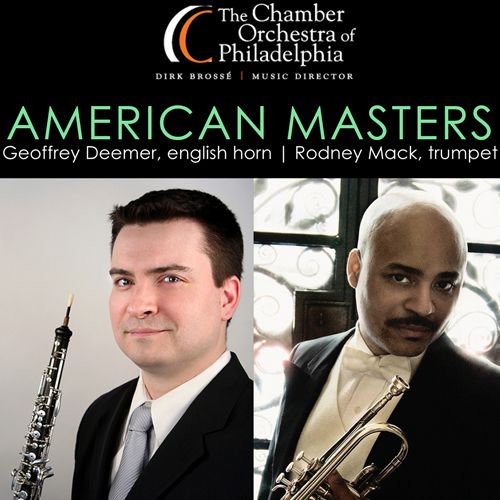
Music by [see above], George Gershwin & Ottorino Respighi (?!)
Played by the Chamber Orchestra of Philadelphia
With Geoffrey Deemer (English Horn) & Rodney Mack (trumpet)
Conducted by Dirk Bross�
"A founding resident company of The Kimmel Center for the Performing Arts, The Chamber Orchestra of
Philadelphia is a 33-member professional ensemble led by Music Director Dirk Bross�. The Chamber
Orchestra, founded in 1964, has a well-established reputation for distinguished performances of
repertoire from the Baroque period through the twenty-first century.
The Chamber Orchestra's development was motivated in part by the desire to provide performance
opportunities to young professional musicians emerging from the Curtis Institute of Music and other
regional training programs but also by a desire to make a substantial contribution to the city and
region's cultural life. In addition to presenting its own productions, the Chamber Orchestra started
to develop an entrepreneurial approach by seeking other performance opportunities among the
region's presenter/producer community, thereby providing additional employment for its members.
The ensemble also championed new music, focusing on regional composers. In total, the organization
has commissioned and premiered over seventy new works.
In 1994, Ignat Solzhenitsyn, a concert pianist and conducting graduate from the Curtis Institute
of Music, joined the Chamber Orchestra as Assistant Conductor. In 1998, he was named Principal
Conductor and Music Director in 2004. Maestro Solzhenitsyn, in assuming the position of
Conductor Laureate in 2010, remains closely associated with the Orchestra.
A conductor and composer of international acclaim, Maestro Dirk Bross� now enters his eighth
season as Music Director of The Chamber Orchestra of Philadelphia. In the 2015-2016 subscription
season, the Orchestra will perform seven concert programs from September through May in the
Kimmel Center's intimate, 600-seat Perelman Theater.
The Chamber Orchestra has performed with such internationally acclaimed guest artists as
Pl�cido Domingo, Luciano Pavarotti, Vladimir Ashkenazy, Mstislav Rostropovich, Issac Stern,
Rudolph Serkin, The Eroica Trio, Jean-Pierre Rampal, The Romeros Guitar Quartet, Julie Andrews,
Bernadette Peters, Ben Folds, Elvis Costello, Sylvia McNair, Steven Isserlis, Joseph Silverstein,
Ransom Wilson, Gerard Schwarz, Jahja Ling, and Nadja Salerno-Sonnenberg, among others.
The ensemble travels regularly, having toured the United States, Europe, and Israel."
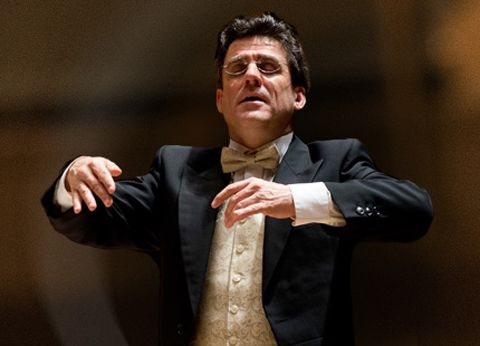
Source: The Chamber Orchestra of Philadelphia CD (my rip!)
Formats: FLAC(RAR), DDD Stereo, mp3(320)
File Sizes: 344 MB / 179 MB
The FLAC link has now expired. No more requests for this, please!
mp3 version -
https://mega.nz/#!2NUGXTQD!mwt-JQI0KiVoxCkkRSOm2ssiuvy61yz48vvMbYZImT8
/>
Enjoy! Don't share! Buy the original! And please click on "Like" if you downloaded this album! :)
wimpel69
09-05-2015, 02:16 PM
No.818
Modern: Neo-Romantic/Neo-Classical
Percy Grainger (1892-1961) was a great eccentric. He was a practitioner of flagellation (his
whips are discreetly displayed in the Grainger Museum in his native Melbourne), he believed in Nordic
Supremacy, and was suspected of having an incestuous relationship with his domineering, syphilitic
mother. Grainger was at his best as a miniaturist. The works on this recording are good examples:
charming tunes, masterfully orchestrated. Though Grainger hardly saw Australia again after he left
at nineteen, the country often appears in his music. The Gum-suckers’ March refers to people
from the state of Victoria, a nickname for those who chew eucalyptus (gum) leaves on a hot day for
their refreshing volatile oils. Eastern Intermezzo reminisces about Grainger’s childhood visits
to Melbourne’s Chinatown. The Colonial Song is a patriotic post-Federation (1901) piece,
somewhat burdened with an overblown God-and-King treatment but superbly crafted. It is this quality,
and Grainger’s ability to turn a catchy tune that has allowed his somewhat parlour-style music to
withstand the test of time.
Douglas Lilburn (1915-2001) is unquestionably New Zealand’s most important composer, and
in Georg Tintner’s opinion, the finest from either country. A farmer’s son, he was talented in both
music and literature, but decided for music in 1936 when Grainger awarded him the Grainger Prize
for one of his compositions. He went to London in 1937 and studied with Vaughan Williams. A fervent
New Zealander, he returned in 1940, and eventually became Professor of Music at Wellington’s
Victoria University. Diversions for Strings was written in 1947 for the Australasian tour of the
Boyd Neel Orchestra. Its five short movements are direct in style and form, and with alternating
moods the composer describes respectively as “Light, nostalgic, satirical, sentimental, and tossed-off.”
George Dreyfus was born in Wuppertal, Germany, in 1928 and went to Australia as a refugee
in 1939 – young enough to have absorbed some of the laconic Australian character. The Serenade for
Small Orchestra, originally titled Music for Music Camp, was written in 1967 for the various annual
music camps in Australia. It was Dreyfus’s first orchestral work, but it already displays a complete
command of orchestration and the usual fine wit. Dreyfus himself describes the music as “of instant
appeal, lighthearted and melodious, something that youngsters enjoy rehearsing and performing.”
Arthur Benjamin (1893-1960) grew up in Australia but, like Grainger, spent most of his career
abroad as a concert pianist, composer and conductor. All of his music is colourful and beautifully
crafted, as North American Square Dance shows, with its skilful use of fiddle tunes from the
United States and Canada.
Benjamin lived mostly in England, but he spent the war years on the west coast of Canada,
where in 1938 he met the young Vancouver composer Jean Coulthard (1908-2000). Though
Coulthard had, like Lilburn, studied with the great symphonist Vaughan Williams, she had until then
only written for voice and piano. Many of Coulthard’s works, including her Excursion Ballet Suite,
were premiered in Vancouver at Arthur Benjamin’s highly successful Prom Concerts, with Benjamin
himself conducting.

Music by [see above]
Played by the Symphony Nova Scotia
Conducted by Georg Tintner
"This is the most intriguing of all the Tintner Edition volumes –title - Georg Tintner conducts Colonial
Diversions all but the Grainger pieces receive their premiere recordings and Dreyfuss and Lilburn don't
even otherwise appear in the record catalogues. Yet, although rare, they're not unfamiliar – even if
not overtly derivative, all are conservative and solidly tonal with barely a touch of dissonance or even
chromaticism, and give little hint of their 20th century genesis. The title of this collection refers to
the English colonies, and specifically those with which Tintner had a professional and personal
connection – Australia, New Zealand and Canada. Tintner's favorite among these composers was
Lilburn, but mine is Coulthard (a protege of Benjamin); her ballet is evocative and bittersweet yet
winningly light-hearted, and especially welcome coming from that extreme rarity, a female composer.
All the works receive magnificent, spirited readings but, like the Mozart set, are best savored
individually rather than in a marathon listening session."
Classical Notes
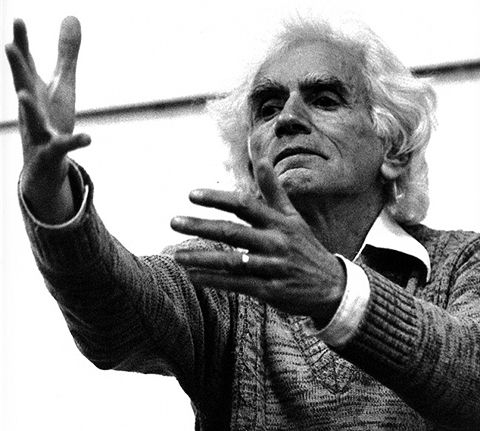
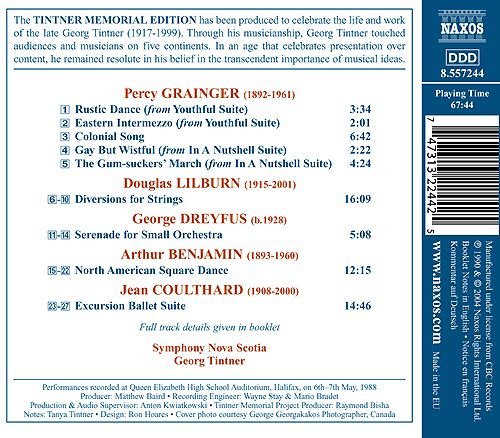
Source: Naxos "Georg Tintner Edition" CD (my rip!)
Formats: FLAC(RAR), DDD Stereo, mp3(320)
File Sizes: 271 MB / 153 MB (FLAC version incl. covers & booklet)
The FLAC link has now expired. No more requests for this, please!
mp3 version -
https://mega.nz/#!fF82RSDZ!a4vtJQag-RWVlFEn_WBupicxla25Cey2win2_lRlom8
/>
Enjoy! Don't share! Buy the original! And please click on "Like" if you downloaded this album! :)
wimpel69
09-06-2015, 03:53 PM
No.819
20th Century: Romantic/Impressionist
Divorced from this line of Flemish influence, Arthur Meulemans studied at the Lemmens Institute with
the redoubtable Paul Gilson as one of his mentors. For many years he shunned a move to the central artistic
points of Belgium, preferring to enhance the musical activities of the province of Limburg. His early influences
certainly came from the Impressionist movement active in France, and from Ravel and Debussy in particular.
He was to play a very significant role in Belgian music when, in 1929, he was appointed conductor of the
Belgium Radio Orchestra, a post that he held until 1942. Though he stated his admiration for Benoit and his
colleagues, he did not subscribe to the Flemish composers 'club', preferring his own view of that part of the
world in his pictorial symphonic music. He was a prolific composer with fifteen symphonies, and many other
orchestral scores. The sixth, seventh and eighth symphonies of Meulemans were in the form of a nature
triptych, their titles: Zeesymfonie, Zwaneven, and Herffstsymfonie (Sea Symphony, Swan Fen
and Autumn Symphony), leading to a highly descriptive scenario. The fact that Swan Fen dates from 1940,
when the war was enveloping his country, is not reflected in the music. On the contrary, it is a very pleasant
score, owing much to Debussy. It retains the composer's faith in melodic invention, though the internal
structure of the four movements is far from academic rectitude. The result being a relaxed, free-flowing
score of immediate attraction.
Lodewijk Mortelmans, born in Antwerp in 1868, was a composition pupil and disciple of the 'father'
of Flemish school of composition, Peter Benoit. Through the organisation Nieuwe Concerten (New Concerts),
which he co-founded and conducted, he was able to bring Flemish composers to the public attention.
He was, however, also to fall under the influence of Wagner, much of his middle period of writing carrying
the Wagnerian sound. He was to be a major source of inspiration to young musicians in his role as director
of the Royal Flemish Conservatoire. This resulted in the ultra-romantic outpouring in Mythe der Lente of
1895, with the character of the earth-goddess, we find in Wagner's The Ring, as its subject.
Veteran Belgian composer Peter Benoit is represented by an early and very short work, In de
Velden (In the Fields) for oboe and string orchestra. It is a simple and very attractive 'song' of a pastoral nature.
Much was expected from Van Hoof's Second Symphony, which dates from 1941, the hostile reception,
in some quarters, to the First Symphony of 1939, bringing him to public attention. It was to be a war
symphony, but one more of reveries for the end of the world. The exception is the second movement
scherzo, full of aggression and anger. It moves to a slow movement with a strong underlying sense of anger,
and only in the finale is there any sense of hope for the future.
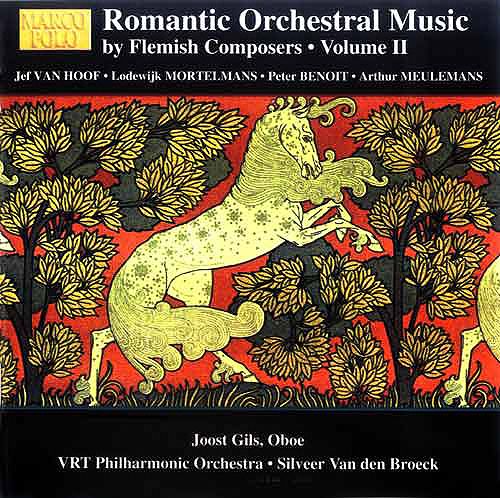
Music by [see above]
Played by the VRT Philharmonic Orchestra
With Joost Gils (oboe)
Conducted by Silveer van den Broeck
"The outstanding work here is Arthur Meulemans’ Seventh Symphony, an atmospheric, vaguely
impressionist piece full of colorful orchestral writing. This guy’s a real find, and if Marco Polo
would concentrate on his work alone (the label already has devoted an earlier release to him),
it would have a genuinely interesting series on its hands."
Classics Today
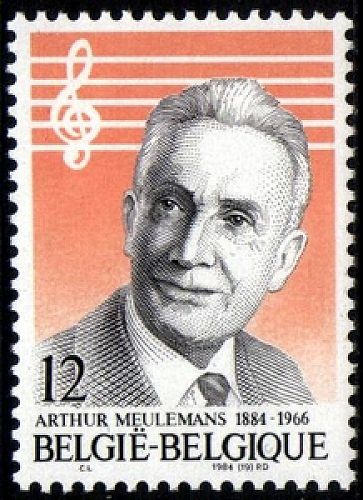

Source: Marco Polo CD (my rip!)
Formats: FLAC(RAR), DDD Stereo, mp3(320)
File Sizes: 321 MB / 169 MB (FLAC version incl. covers & booklet)
The FLAC link has now expired. No more requests for this, please!
mp3 version -
https://mega.nz/#!WJsznYRB!5S4Nj8AcaSUzJYCMthX2Y5unNUNj4mndIz_xenX4e6g
Enjoy! Don't share! Buy the original! And please click on "Like" if you downloaded this album! :)
bohuslav
09-06-2015, 06:02 PM
Super disc, Tintner without Bruckner! Wimpel69 big thanks for this gem.
---------- Post added at 11:02 AM ---------- Previous post was at 10:55 AM ----------
This flemish composers are so underrated, listen to this colorful music, so much better than the most Soundtrack Composers. Hartelijk bedankt wimpel69.
wimpel69
09-07-2015, 11:21 AM
No.820
Modern: Avantgarde
A collection of works for chamber ensemble, with different featured
soloists, by a trio of contemporary American composers, of whom the most
prominent is probably William Thomas McKinley, who was also one of the
founders of MMC.
includes:
John Carbon: Rasgos (Sketches)
Peter Homans: Tribute
William Thomas McKinley: Crazy Rags

Music by [see above]
Played by the Concordia Chamber Ensemble
With the Sirius String Quartet
Conducted by Marin Alsop
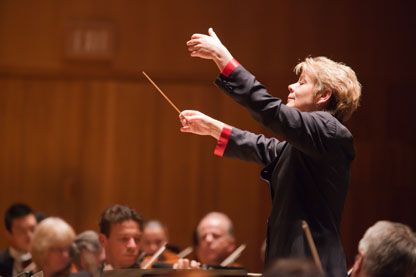

Source: NMC Records CD (my rip!)
Formats: FLAC(RAR), DDD Stereo, mp3(320)
File Sizes: 233 MB / 118 MB (FLAC version incl. artwork & booklet)
The FLAC link has now expired. No more requests for this, please!
mp3 version -
https://mega.nz/#!nZE3FBRC!84j7j2omlmZsuUaNEt3CqvfQvycINhgUB80OiRdxgd8
Enjoy! Don't share! Buy the original! And please click on "Like" if you downloaded this album! :)
wimpel69
09-07-2015, 01:39 PM
No.821
Modern: Neo-Classical
Aulis Sallinen's (*1935) Symphony No.1 marks a powerful re-emergence of the tradition of Jean Sibelius
in terms of the extended tonality of its era. In common with his countryman Sibelius' Seventh and last
symphony, it is a one-movement work that organically emerges from minute motives. Sallinen (born 1935)
went through a phase using atonality and twelve-tone techniques. This reached its pinnacle in 1962 with the
highly avant-garde Mauermusik. After that, he returned to more traditional, expressive melody as the basis
for a tonal language that uses powerful, dissonant chords and important use of the intervals of the second
(both of which are dissonant), both melodically and in the harmonies. He began writing this symphony in
1971, then heard of a composition competition sponsored by the City of Helsinki and entered it. In addition
to the usual prizes, the winner would receive a prestigious prize: It would be performed at the opening concert
of the city's handsome new concert venue, Finlandia Hall. It is Sallinen's first large-scale orchestral work.
Sallinen titled it Sinfonia (Symphony), without assigning it a number. Perhaps this was pessimism and
Sallinen felt that if the work failed, there would never be another, and hence, it did not need a number.
However, the symphony shared first prize and did receive its premiere at the opening in December
1972. The basic harmonic idea of the symphony is a widespread, luminous sonority for subdivided strings.
While it is held, the main melodic idea appears on flute and chimes, a rising second. Soon answered on
cello in a melody that begins with the same interval reversed into a falling second, the interval becomes
the proto-idea of the symphony, generating almost all the material in it, including the accompaniments.
This often results in textures dominated by rising and falling seconds, somehow avoiding sounding like
the theme from Jaws, written a few years later, which is also a pattern of rising and falling seconds.
(However, if one is listening for movie music similarities, one of the most important chords in the symphony
is a major/minor structure that was a favorite of Bernard Herrmann's.) The initial orchestral sound of the
symphony, with static string harmonies and a brooding, wandering theme, links the symphony to the
Sibelius of the Symphony No. 7. Without ever copying his illustrious compatriot's characteristic
sound, Sallinen structures his symphony in a way similar to the Symphony No. 7, with a long,
brooding introduction that constitutes nearly half the length of the entire work. There is a strong
departure from the example of Sibelius in one respect, however: Sallinen's basic seconds motive
has a tendency to turn into bell motives, a feature absent from Sibelius symphonies. The pealing
of bells propels the symphony to its triumphant conclusion, which then fades out into the initial
luminous chord. The work has gone on to international recognition as one of the finest works.
Sallinen's Symphony No.7 ("The Dreams of Gandalf") is related to J.R.R. Tolkien's great
novel “The Lord of the Rings.” The symphony does not actually depict the events in the novel;
rather it is a musical expression of the literary atmosphere and poetry. The symphony was
commissioned by the Gothenburg Symphony Orchestra and composed in 1995-6. It arose
out of music intended for a ballet based on Tolkien's novel. Perhaps because the music was
intended for the dance, it’s the most energetic and impulsive piece on the disc, full of
captivating tunes cloaked in absolutely magical orchestration.
A Solemn Overture (King Lear) Op.75, commissioned by the Monte Carlo Philharmonic
Orchestra to mark the 700th anniversary of the Grimaldi family, uses material sketched for
the opera on which the composer was working at that time. The work was premiered as
Ouverture solennelle; and, for obvious reasons, the subtitle was added later! Though
in no way programmatic (in spite of the later addition of the subtitle), the overture –
incidentally an independent piece of music otherwise unrelated to the opera – may be
experienced as a powerful, at times sombre and menacing, tone poem … not without
grandeur either.

Music Composed by Aulis Sallinen
Played by Staatsphilharmonie Rheinland-Pfalz
Conducted by Ari Rasilainen
"The performances, recorded under the composer’s supervision, are
highly idiomatic and have an unmistakable ring of authenticity that makes this –
and the forthcoming instalments – highly commendable. Rasilainen leads his
forces with a sure hand as well as a clear mind, making the best of these superb
pieces. I am eagerly waiting for the other discs in this series."
Musicweb

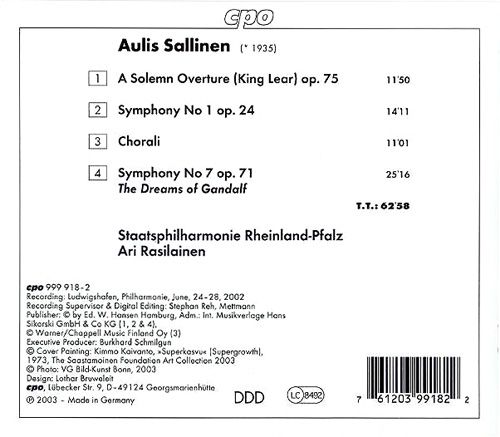
Source: CPO Records CD (my rip!)
Formats: FLAC(RAR), DDD Stereo, mp3(320)
File Sizes: 233 MB / 153 MB (FLAC version incl. cover & booklet)
The FLAC link has now expired. No more requests for this, please!
mp3 version -
https://mega.nz/#!jItSHISa!oFo_25iiZfFLAUkcBWgIw5amrBU1xuUfEwj3-nbL04s
/>
Enjoy! Don't share! Buy the original! And please click on "Like" if you downloaded this album! :)
wimpel69
09-09-2015, 10:41 AM
No.822
Modern: Impressionism
During his brief life (cut short by pneumonia when he was just 35), Charles Griffes was able to compose
music of distinctive beauty. He was fascinated by the music of the French-Impressionist composers Debussy
and Ravel but was also influenced by the Russian sounds of Scriabin and Mussorgsky and a German post-
romantic idiom. Ultimately, Griffes found his own unique voice that blended all of these characteristics.
Griffes had a passion for verse and almost all of his orchestral scores are linked in some way to poetic or
literary ideas. The works on this disc are notable examples of Griffes’ “tone pictures” with the exception
of the Poem for Flute and Orchestra, a miniature tone poem without associated text or images.
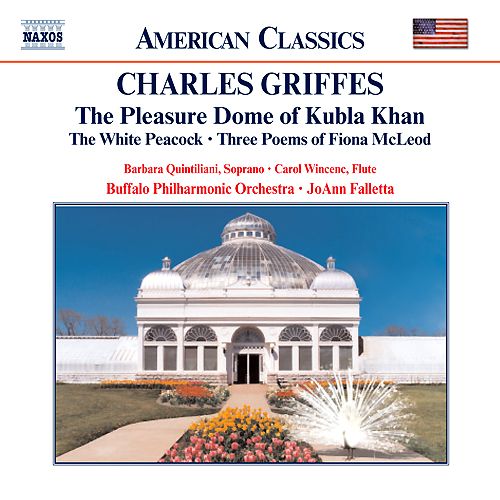
Music Composed by Charles Tomlinson Griffes
Played by the Buffalo Philharmonic Orchestra
With Barbara Quintiliani (soprano) & Carol Wincenc (flute)
Conducted by JoAnn Falletta
"This invaluable disc gives a warm and colourful portrait of this late-romantic American composer,
sadly short lived. It includes not only his three best-known orchestral works, but a clutch of rarities as
well, otherwise unavailable on disc. Most of these started as piano pieces, which Griffes orchestrated,
yet such was the composer’s mastery over evocative tone-painting that one would never guess that.
The shimmering beauty of his writing matches that of Debussy on the one hand, Delius on the other,
with his inspiration regularly coming from English literature, Coleridge in Kubla Khan, Fiona McLeod
(William Sharp) in The White Peacock, as well as in the three songs, and W.B. Yeats in the first of the
Three Tone Pictures. Apart from Debussy and Ravel, Griffes was drawn to Mussorgsky and Scriabin,
as well as to oriental music. The White Peacock (1915) comes from a suite for piano (Four Roman
Sketches), which he later scored for orchestra. The Pleasure-Dome of Kubla Khan (1919) and the
Poem for Flute and Orchestra (1918) are probably his masterpieces. Performances here are
outstanding and very well recorded, with JoAnn Falletta as music director of the Buffalo
Philharmonic drawing refined and atmospheric performances from her players, with Barbara
Quintiliani as the bright soloist in the songs and Carol Wincenc, principal flute in the orchestra,
a most sympathetic soloist in the Poem. This fine compilation fills an important gap in the catalogue."
Penguin Classical Guide
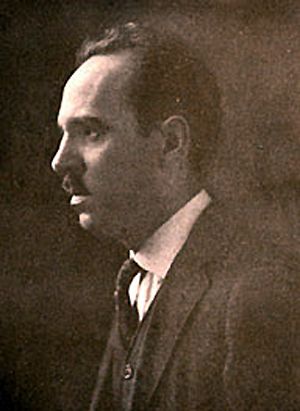
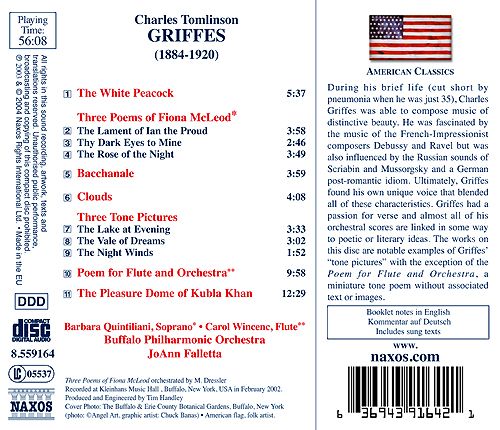
Source: Naxos CD (my rip!)
Formats: FLAC(RAR), DDD Stereo, mp3(320)
File Sizes: 207 MB / 129 MB (FLAC version incl. covers & booklet)
The FLAC link has now expired. No more requests for this, please!
mp3 version -
https://mega.nz/#!PV8AlR5b!JmX-twfI7iEnLWNNWNuYfRMCbvR0mqokYaTRtg0TF9s
/>
Enjoy! Don't share! Buy the original! And please click on "Like" if you downloaded this album! :)
HIborn
09-09-2015, 05:21 PM
Thank you for the Griffes
wimpel69
09-14-2015, 11:56 AM
No.823
Modern: Tonal/Avantgarde
Mieczyslaw Weinberg’s symphonies are recognised today as a substantial continuation
of the Russian tradition. His Twelfth Symphony, written in the style and spirit of
Shostakovich, is a response to the death in August 1975 of his great friend and supporter
of 32 years. With its subtle stylistic allusions to Shostakovich, this is the longest and
most wide-ranging of Weinberg’s purely orchestral symphonies. This recording has been
prepared utilising the composer’s hand written materials and markings. One of only two
surviving ballet scores, The Golden Key is a compelling satire, extending a lineage
which includes Prokofiev and Stravinsky.
The Golden Key is from two decades earlier than the symphony. It's another world;
what with a title like a a Shostakovich ballet - it even sounds similar. The music is brilliant,
splendidly balletic, alive with fantasy of many and various sorts. It's not all heartless neon
either; try the lovely Elegy. Prokofiev's imagination must also have been an influence as
we can hear in the Dance of Artemon and Stravinsky in the cool Dance of The Cricket.
The carousel effect of The Pursuit finale may well remind you of the carefree celebratory
music of Shostakovich's musical Cheryomushki. The Weinberg ballet was premiered in
Moscow in 1962 and two years later Weinberg crafted from its music four orchestral suites
of which this is the last. If you have enjoyed the ballets of Prokofiev and Shostakovich you
will like this colourful score - a lot.
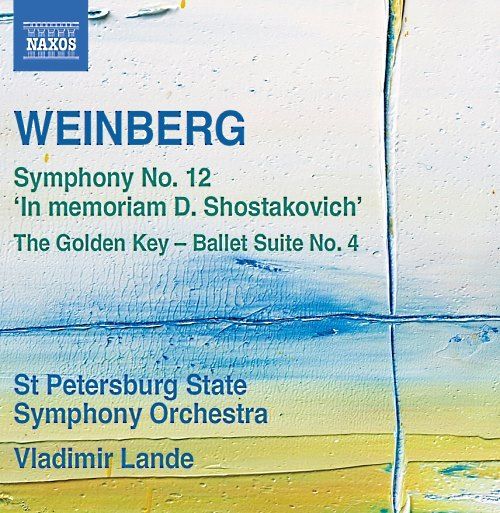
Music Composed by Mieczyslaw Weinberg
Played by the St. Petersburg State Symphony Orchestra
Conducted by Vladimir Lande
"The symphonies of Mieczyslaw Weinberg are appearing with increasing frequency on Western
concert programs, and the reasons he was a favored follower of Dmitry Shostakovich are abundant.
For one, he mastered the Mahlerian type of orchestration often used by Shostakovich in his late
works. That is evident in the beautifully orchestrated Symphony No. 12, subtitled "In memoriam
D. Shostakovich." The work was composed in 1979 and given its premiere by Shostakovich's
son, Maxim; it was one of a number of works composed to honor Shostakovich, who by that
time was back to Soviet national hero status. The references to the older composer are clear
enough, but in Shostakovich's works such devices as the D-S-C-H (D-E flat-C-B natural) motif
have a specific function and referential value; here they seem to be parts of a kind of tour
through Shostakovich's works. There's a lot to enjoy: the orchestration, the splendidly grim
Adagio, the colorful ballet suite from The Golden Key (1944), which could fill the bill for a
sparkling unknown Russian ballet score. But there may be better places to start with Weinberg:
Symphony No. 19, Op. 142 ("Bright May") carries the seriousness with which Shostakovich
also approached the devastation of World War II. Vladimir Lande and the St. Petersburg State
Symphony Orchestra also seem crisper in their performance of that work. For those
already interested in Weinberg, this is a case study in the nature of his influence."
All Music
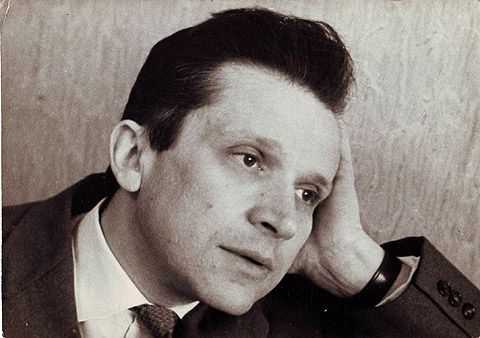
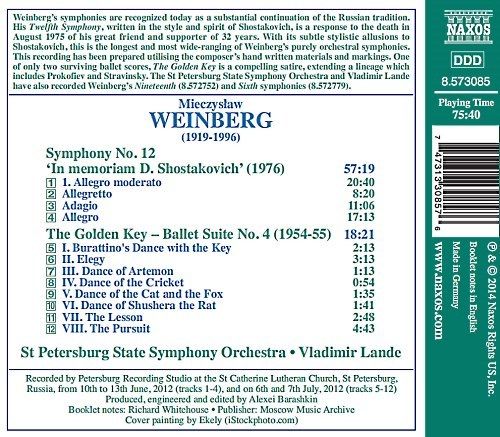
Source: Naxos CD (my rip!)
Formats: FLAC(RAR), DDD Stereo, mp3(320)
File Sizes: 249 MB / 173 MB (FLAC version incl. covers & booklet)
The FLAC link has now expired. No more requests for this, please!
mp3 version -
https://mega.nz/#!3AsFUJKb!IerHHJms9ovZiYa8q00Ow1W07lbwRNasTU8_US9OU48
Enjoy! Don't share! Buy the original! And please click on "Like" if you downloaded this album! :)
wimpel69
09-16-2015, 01:34 PM
No.824
Modern: Tonal
J�n Leif's (1899-1968) ballet Bald(u)r is based on an idea which the author had been developing in
his mind over twenty years, using an inspiration from the Older Edda. The events of the Second World War and the
eruption of the Icelandic volcano Hekla provided ideas for the final dramatic form of the work. Time and place indicated
vaguely as Iceland or Northwestern Europe at the time of the Vikings with a lapse of about fifteen years
between Acts I and II. Leifs called it "A Musical and Choreographic Drama Without Words".
For a different take on this story, see my upload of Geirr Tveitt's >>>Baldur's Drammen<<< (
http://forums.ffshrine.org/f92/wimpel69s-could-film-music-classical-corner-work-121898/58.html#post2859141).
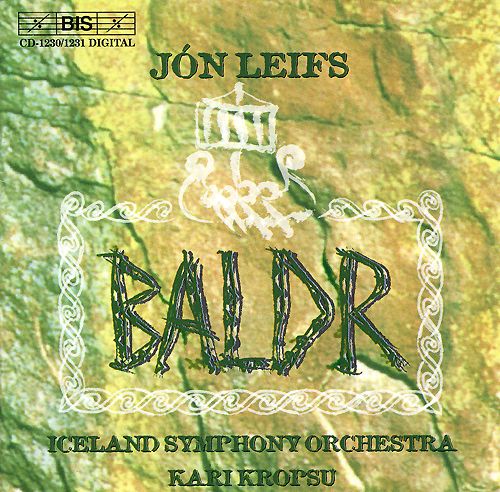
Music Composed by J�n Leifs
Played by the Iceland Symphony Orchestra
With Gunnar Gudbj�rnsson (tenor)
And the Schola Cantorum
Conducted by Kari Kropsu
"The music is squat, swarthy and uncompromising. Great thunder-tread steps, often off-beat
and dissolute, rend the landscape. Leifs liberally deploys a vast array of percussion including
rocks, metal chains, cannons, pistols and anvils. I must not give the impression that the music
is an unremitting round of fury and angular sound. There is much quiet music as well and a sort
of modernised Grieg-like dance appears from time to time (for example the all grace and smiles
in Nanna - Baldr's beloved). Other resonances and coincidences include the wildly unbridled
xylophone solo from Havergal Brian's Gothic Symphony, a touch of the whirling hell-furnaces
of Tchaikovsky's Francesca da Rimini, Prokofievian gawkiness in The Wedding, Copland-like
pastoralism (yet with a certain chilliness) and a Beethovenian stomp as in the dionysian impacts
of the Seventh Symphony (try Act II The Throwing Game). There is very little singing and in
the five episodes where it does appear it is brief. The voices are used as part of the effect in
vocalising ululation and slides in the Dance of the Creatures of the Earth. The final Volcanic
Eruption and Atonement is Leifs' pioneering essay in portrayal of the explosive forces of nature.
It is here that anvils, stones, chains and thunderous assaults are most in evidence. This furious
vehemence was to be followed by much more familiar (or less unfamiliar) later works such as
Geysir, Hafis, Hekla and Dettifoss. The movement was surely inspired by the eruption of
Mount Hekla in March 1947."
Musicweb
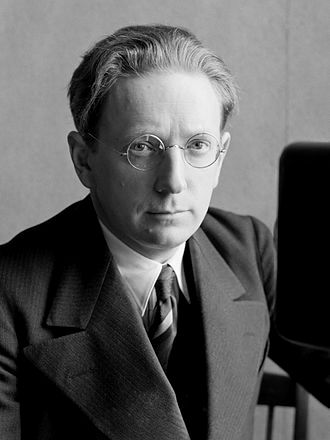
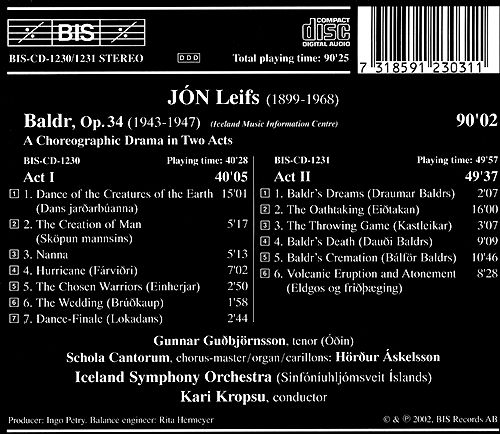
Source: BIS CD (my rip!)
Formats: FLAC(RAR), DDD Stereo, mp3(320)
File Sizes: 322 MB / 211 MB (FLAC version incl. cover & booklet)
The FLAC link has now expired. No more requests for this, please!
mp3 version -
https://mega.nz/#!GE9mjLCB!7Dt6uL95e_K1z5sBIgujzWtzAacCYfowpWa4ehT3wY8
Enjoy! Don't share! Buy the original! And please click on "Like" if you downloaded this album! :)
bohuslav
09-16-2015, 02:43 PM
BIS Jon Leifs series is a winner. All recordings are unique. First music i've ever heard from Leifs was Geysir, it slammed me out of my seat. Many thanks wimpel69.
wimpel69
09-17-2015, 03:29 PM
No.825
Modern: British Light Music
Richard Stewart Addinsell was born on 13th January 1904 in London, the younger of two sons of a
successful businessman father and adoring mother, who became very protective of him, to the extent that
he was educated at home. Some might say this made him rather wary of institutions of all kinds thereafter.
For example, he went to Hertford College, Oxford in 1922 ostensibly to read Law, but stayed for little
more than eighteen months without, naturally, taking a degree. His interests were already turning to music.
So he enrolled at the Royal College of Music for the autumn term of 1925, but he remained there only until
the following Easter (which is why he was never able to orchestrate his own music). Lessons in theory must
have seemed positively prosaic compared with the prospect of writing songs for that year's Andre Chariot
revue, some with the legendary Noel Gay, of Me and My Girl fame. He was later to pursue his own line in
education, and in 1929, he travelled Europe visiting major theatres and musical centres, spending most
time in Berlin and Vienna.
All through the 40s and 50s, he wrote for BBC radio plays and features, in between film and stage work.
In all this endeavour, his method of working was the same. He would play what he had composed at the
piano, making small notes of the outline of the material, but leaving the detailed work of arranging and
orchestrating to other hands. As a man, he was a quiet introvert who only really came alive making music.
In many ways, a lonely man, particularly at the end, but one who could be very generous to his close-
knit group of friends, most of all at Christmas which he celebrated heartily. He had a lively invention,
which, linked to a sense of panache, produced compositions with a singular spark that turned notes
into music, and music into a fond memory.
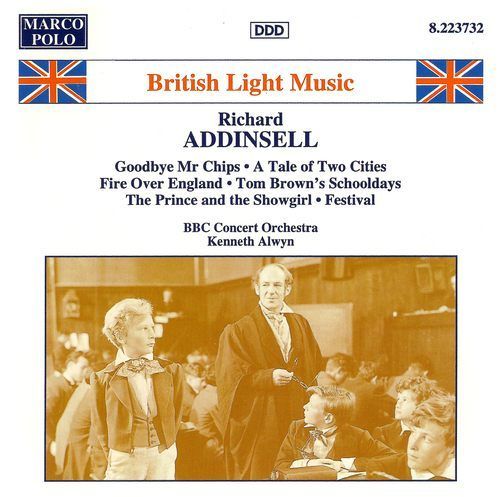
Music Composed by Richard Addinsell
Played by the BBC Concert Orchestra
With Philip Martin & Roderick Elms (piano)
Conducted by Kenneth Alwyn
"A prolific composer of theater and film music, Richard Addinsell is now remembered as a
one-hit wonder, the composer of the lush, faux-Rachmaninov one-movement Warsaw Concerto
for piano and orchestra. Addinsell studied law at Oxford and, briefly (1925-1926), music at
the Royal College of Music in London. He wrote his first theater score for Clemence Dane's
Come of Age or Adam's Opera in 1928; Addinsell continued collaborating with Dane until her
death in 1965. After a break in 1929 for study in Berlin and Vienna, Addinsell returned to
London and the theater. Eva La Gallienne asked him to score her production of Alice in
Wonderland (another Dane project) in 1933. After that, Addinsell continued to write off and
on for the stage, but he focused more on film music, scoring such classics as Goodbye Mr.
Chips, A Tale of Two Cities, Blithe Spirit, Fire Over England, and Dark Journey, as well as a
number of patriotic English documentaries during World War II. Addinsell's most enduring
contribution to the repertory, the Warsaw Concerto, was embedded in his score for
Dangerous Moonlight (released in the United States as Suicide Squadron). From 1942
Addinsell took occasional time out from his movie work to collaborate with Joyce Grenfell
on songs for such London West End revues as Tuppence Colored and Penny Plain, and
later for Grenfell's one-woman shows."
James Reel, Rovi
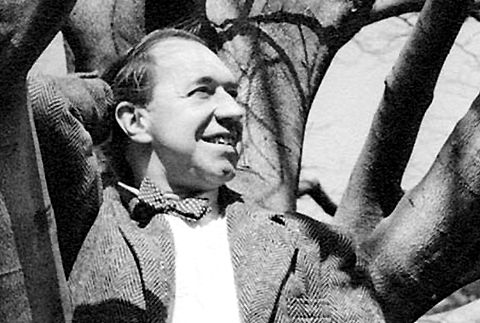
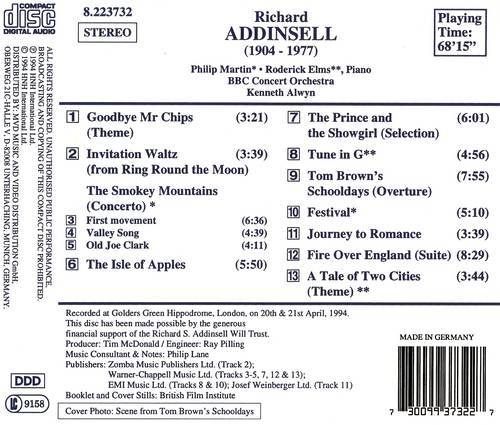
Source: Marco Polo CD (my rip!)
Formats: FLAC(RAR), DDD Stereo, mp3(320)
File Sizes: 321 MB / 155 MB (FLAC version incl. covers & booklet)
The FLAC link has now expired. No more requests for this, please!
mp3 version -
https://mega.nz/#!DA1myAiY!UFKcrbRw988st4HCptrKGUdd-t1dwiCf88SY01d0CgE
/>
Enjoy! Don't share! Buy the original! And please click on "Like" if you downloaded this album! :)
astrapot
09-17-2015, 04:47 PM
magnifique , grandiose...
thanks for the Griffes Wimp, your'e the best a usual.
wimpel69
09-19-2015, 05:09 PM
This thread is temporarily suspended.
booster-t
09-19-2015, 05:56 PM
Thank you for the Duncan CD ...
LePanda
09-23-2015, 01:48 PM
This thread is temporarily suspended.
What !??
Be back soon
http://www.kolobok.us/smiles/artists/just_cuz/JC_cookies.gif
wimpel69
09-29-2015, 09:34 AM
New rule for FLAC: Since the "Like" button is gone, if you want the FLAC links please click instead on
the reputation button (bottom left of each post) and leave a comment (or just add to reputation) and PM me.
No.826
Late Romantic
Along with Alfons Diepenbrock it is above all Johan Wagenaar who has to be regarded as one
of the founding fathers of the rebirth of music culture in the Netherlands. Like many other Dutch
composers of his times, he clearly looked up to Germany because of his education; nevertheless,
he was of the conviction that something on the order of Dutch music did indeed exist. In an article
Wagenaar himself enumerated the musical qualities that he regarded as typically Dutch: �A tendency
toward simple, almost folk-style melodic formation, in some inclining toward heartiness, in others
toward stodginess; a feeling for pleasant comfortability and for naive mirth; a feeling for
sensible serenity drifting a bit toward sentimentality; sharp, clear rhythmic elements and contrasts;
a sense of humor in relation to the particular given situations or to the texts being set – along
with an inclination toward humor with a quite grotesque tone.� Wagenaar came from the most impoverished
circumstances, but his immense musicality enabled him to make progress early in his career, and soon
he himself was a sought-after teacher and the director at the Royal Conservatory in The Hague.
Additionally, he was one of the leading organists and Bach interpreters of his times. His
compositional predilections were nevertheless for the orchestra, and Vol. 2 of the symphonic works
of Johan Wagenaar once again demonstrates that his orchestral works are always endowed with a special
formal sense and rich melodic invention of convincing power.
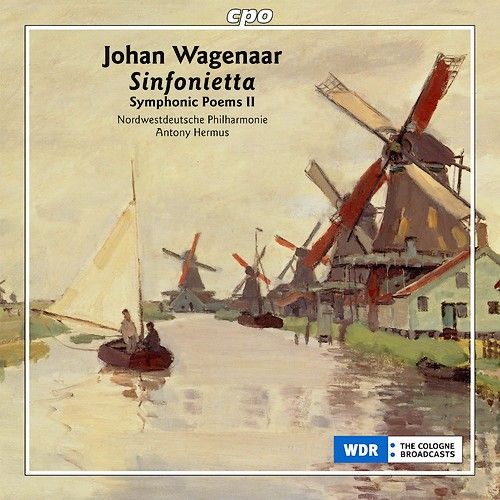
Music Composed by Johan Wagenaar
Played by the Nordwestdeutsche Philharmonie Herford
Conducted by Antony Hermus
"Johan Wagenaar, as you may have guessed from his name, was Dutch. In the booklet, he is
described as “the most popular Dutch composer in the twentieth century”. He studied in Berlin,
had a range of performing positions, and was the director of the Royal Conservatory in
The Hague for almost twenty years.
The first volume of his “symphonic poems” – orchestral works would have been a more
accurate title – was not reviewed here. It includes Saul and David, Wagenaar’s contribution
to the celebrations in 1906 of the three hundredth anniversary of Rembrandt’s birth. The
notes talk of a growing sense of Dutch nationalism around this time, though how this might
have played out in music is not clear.
Also mentioned in the notes is the strong Germanic influence on Dutch composers of the time.
I have to say that this is not particularly obvious to me in the five works presented here.
Genial is the word that comes to mind: they are certainly not dramatic in any way at all.
The Sinfonietta has a smile on its face for almost its entire time: even the Adagio non troppo
has no intense emotions, more a satisfied reverie. The Allegro marciale finale makes me
think of Malcolm Arnold in dance mode. If that makes the work sound a little trite, then
think of a Mozart.
Of the other works, the late Elverh�i makes the greatest impression. It uses an old Danish
saga of a knight tempted by fairies, but again the range of moods is relatively limited.
There are some quite lovely moments that I will call “woodland” and some light-hearted
dances. This is certainly not music that one would date to 1940.
My inclination would be to describe all these pieces as very well-crafted “light music”,
which is certainly not what I expected when I acquired the recording. Is that a bad thing?
On a hot Australian summer day, it suits my mood better than an intense and powerful
Straussian tone poem.
The recording is appropriately transparent and while I have absolutely nothing to
compare them with, the performances seem very satisfactory. The Wikipedia entry
for Wagenaar lists a number of other orchestral works which have not appeared thus
far. I don’t know whether a third volume is planned, but with a running time at well
under the hour, this one could have been better filled."
Musicweb
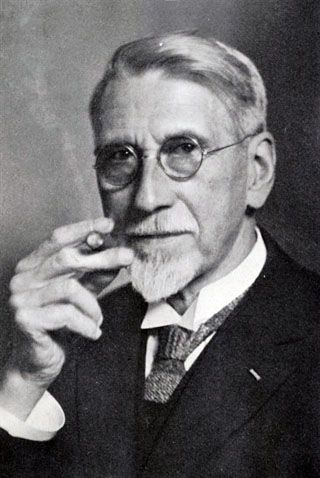
Source: CPO Records CD (my rip!)
Formats: FLAC(RAR), DDD Stereo, mp3(320)
File Sizes: 311 MB / 126 MB (FLAC version incl. cover & booklet)
The FLAC link has now expired. No more requests for this, please!
mp3 version -
https://mega.nz/#!3UlFVCjJ!mLza97wujrddNKxfTsKqcNQUIUw5MlLTt_K72VKemsc
Enjoy! Don't share! Buy the original! And please click on "Reputation" button if you downloaded this album! :)
bohuslav
09-29-2015, 10:36 AM
Welcome back wimpel69.:awsm:
Kempeler
09-29-2015, 10:54 PM
God Bless!
dances43
09-30-2015, 07:02 PM
Welcome back, wimpel69!
wimpel69
10-01-2015, 12:11 PM
No.827
20th Century: Modern
Charles Edward Ives was born October 20, 1874, in Danbury, Connecticut, and died May 19, 1954,
in New York City. He composed his Sonata No. 2 for Piano, subtitled “Concord, Mass., 1840-60,”—widely
known as the Concord Sonata—principally from 1916 to 1919, though drawing on works sketched
as early as 1904. Ives published the piece in 1920 but then effected further revisions in preparation for
a second edition, which appeared in 1947. This sonata, in its original piano version, was doled out to
the public piecemeal. Henry Brant was born September 15, 1913, in Montr�al, Qu�bec, Canada,
and died April 26, 2008, in Santa Barbara, California. He created his orchestration of Ives’s Concord
Sonata, billed as the Concord Symphony, from 1958 through 1994, and it was premiered June
16, 1995, in Ottawa, Ontario, Canada, with Brant conducting the National Arts Centre Orchestra.
Says Brant: "In choosing the Concord Sonata for orchestral treatment I felt, above all, that here
Ives had achieved his most complete and comprehensive expression, and that of all his works,
this was the one with the most immediate audience appeal. . . . In undertaking this project, my
intention was not to achieve a characteristically complex Ives orchestral texture (which in any case,
only he could produce), but rather to create a symphonic idiom which would ride in the orchestra
with athletic surefootedness and present Ives’s astounding music in clear, vivid and intense sonorities.
Exploring the possibilities of an orchestral setting appropriate to the Concord Sonata, and devising
workable solutions to the many technical problems involved—these things have been exhilarating
experiences for me."
American composer Aaron Copland was the first American student of French pedagogue
Nadia Boulanger and spent the years from 1921-1924 studying with her at Fontainebleau. While
there, he met many of the most important artists of the day, including the Russian �migr� conductor
Sergey Koussevitzky. These facts are all central to the creation of Copland's first great piece of
music, his Symphony for Organ and Orchestra. Koussevitzky commissioned the work from
Copland in anticipation of Boulanger's first appearance in America in 1925. Copland wrote the
symphony while working as a pianist at a resort in Pennsylvania. The work was premiered in
Carnegie Hall by the New York Symphony Orchestra under Walter Damrosch. Although composed
in what was then the height of the avant garde musical style -- that is, with complex and
pugnacious rhythms, tonal but pungent harmonies, and with spiky and brilliant orchestration -
Copland's symphony is clearly the music of a young man who had studied the most advanced
music of Europe and who was determined to make a huge impact with his first widely publicized
piece. But it is also the music of an American composer: The long lines of the melodies and
the specific shapes and intervals of the themes could only have been written by a composer
born in the United States.
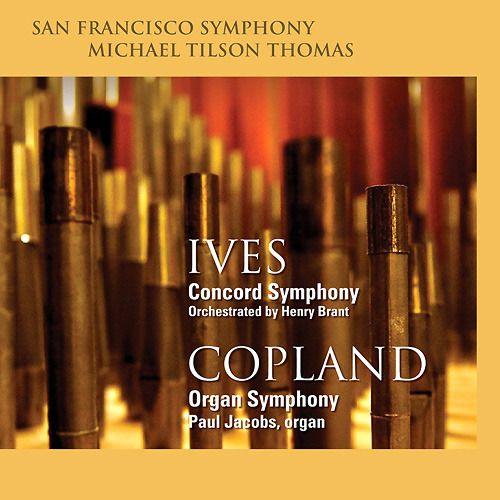
Music by Charles Ives & Aaron Copland
Played by the San Francisco Symphony Orchestra
With Paul Jacobs (organ)
Conducted Michael Tilson Thomas
"The first item on the program here is, as the potential buyer may have guessed, an orchestral
transcrption of Charles Ives' Piano Sonata No. 2, known as the Concord Sonata. But it requires
a little more explanation. Orchestrator Henry Brant was a Canadian-American composer of an
experimental bent who became, one learns from the booklet, "obsesssed" with the Concord
Sonata and worked on an orchestral version in his spare time for the startlingly long period of
36 years, from 1958 to 1994. Further, he did not try to turn it into another Ives symphony, as
the title might imply, "but rather to create a symphonic idiom which would ride in the orchestra
with athletic surefootedness and present Ives' astounding music in clear, vivid, and intense
sonorities." The result is quite unusual: not exactly Ivesian, but wholly absorbing in this reading
by the eternally fresh Michael Tilson Thomas and the San Francisco Symphony. Brant's version
is something like a guided tour through the work, with the swirling flow of musical existence pared
away from the sonata's special features. The recurring references to Beethoven's Symphony
No. 5 in C minor, Op. 67, are pointed up in this version, and the evocations of vernacular
American music (hear the brass band passages) that are part of the torrent in the piano
version are here restored to something like their original sounds. Again, it's not exactly Ives,
but the Concord Sonata has a way of bursting over its pianistic confines anyhow; there is an
optional flute part for the finale that is too rarely performed. The second piece on the
program is likewise underperformed, Copland's short three-movement Organ Symphony
of 1925 is perhaps the one that most clearly reflects his own personality among his early
works. Written in an idiom that clearly owes much to Copland's recent studies in Paris,
it nevertheless works in big lyrical tunes and rollicking fun. Tilson Thomas and organist
Paul Jacobs give the work its due and are sensitive to the clever ways of balancing the
organ with orchestral textures. A highly enjoyable album of unusual Americana."
James Manheim, All Music
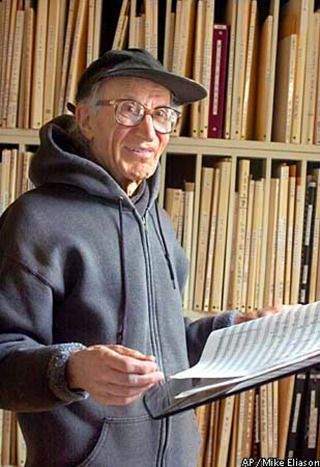
Henry Brant.
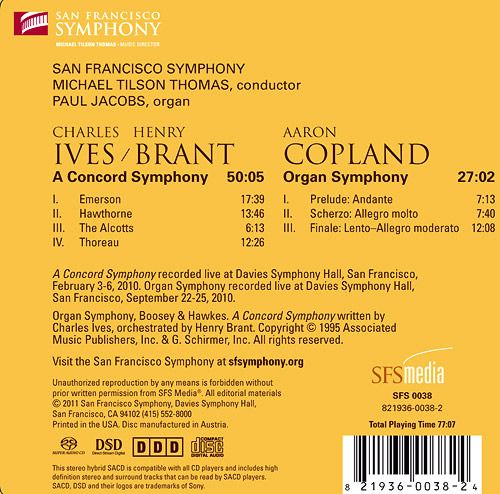
Source: SFS Media CD (my rip!)
Formats: FLAC(RAR), DDD Stereo, mp3(320)
File Sizes: 330 MB / 177 MB (FLAC version incl. covers & booklet)
The FLAC link has now expired. No more requests for this, please!
mp3 version -
https://mega.nz/#!iUtjiI4Y!6R6zkNfU1VdPh5nLni9WHpGnVPpTZYF0VWRFE9_6-PE
Enjoy! Don't share! Buy the original! And please click on "Reputation" button if you downloaded this album! :)
bohuslav
10-01-2015, 01:32 PM
Next great recording. Many thanks wimpel69.
FBerwald
10-01-2015, 07:45 PM
Thank you.
booster-t
10-01-2015, 10:30 PM
Johan Wagenaar: Sinfonietta & Symphonic Poems — this is a beautiful CD ... wonderfully pleasant music to listen to. Thanks
FBerwald
10-02-2015, 10:32 AM
Thank you
wimpel69
10-02-2015, 03:29 PM
No.828
Modern: Impressionism
Toivo Kuula (1883-1918), a Finnish composer with significant melodic gifts and a
private pupil of Sibelius, is best-known as a tragic national-romantic composer of vocal
music. Although Kuula's focus was in vocal music he took considerable interest in writing
orchestral music and in his orchestral works he is often a conjurer of powerful Nordic
moods. Kuula had also aims of becoming a symphonist but his untimely death left the
project unfinished.
This new disc features a large portion of Kuula's orchestral works which were completed
by the time of his premature death. They were mostly written during the 1910s when Kuula
travelled extensively in Germany, France and Italy - and also came in contact with the
works of Debussy. In his works he used elements from the folk music of his home region
in Northern Finland but was also influenced by the new trends present in European art music.
The two South Ostrobothnian Suites belong to Kuula's most popular orchestral works.
They combine melodies collected by the composer from his home region (South Ostrobothnia)
with Impressionistic nuances. After the premiere of the first Suite Kuula was hailed by
some in the Finnish press as a successor for Sibelius. Now for the first time these two
classic works in Finnish orchestral repertoire are released together on one disc.
The disc also includes Festive March (written in Paris in 1910) and Prelude &
Fugue (written in Italy and completed in 1909).
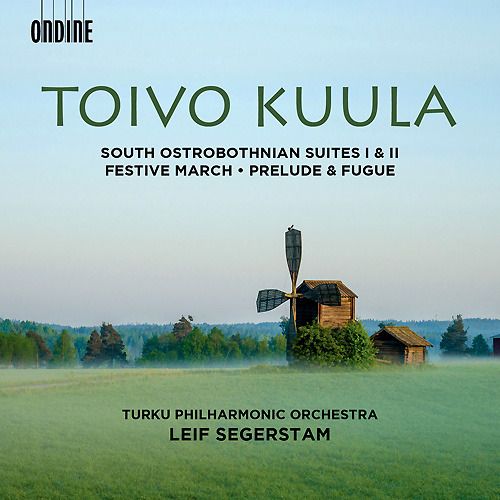
Music Composed by Toivo Kuula
Played by the Turku Philharmonic Orchestra
Conducted by Leif Segerstam
"Toivo Kuula was from the generation following in the giant footsteps of Sibelius, a daunting
prospect. Indeed, he was one of Sibelius's students in 1907, and there is obvious influence in
the writing for strings and woodwinds. However, Kuula was more influenced by Finnish, in particular
Ostrobothnian, folk music than Sibelius. In case your knowledge of Finnish geography is as limited
as mine, Ostrobothnia is a province on the west coast, facing Sweden. The year of Kuula's death
might suggest that he was a casualty of the Great War, but not so. He was notoriously hot-headed,
and got into a drunken argument during celebrations at the end of the Finnish civil war and was shot.
The Festive March was written to celebrate the tenth anniversary of the Suomen Laulu choir, and
as such, it is perhaps surprising that it is purely orchestral. It has very definite Sibelian elements,
and is appropriate grand - the notes describe it as solemn, which I don't hear at all.
Suite No. 1 has three folk tune-based movements, which are enjoyable for their tunefulness and
simplicity, but it is the opening and closing movements, which are all-Kuula, that impress most.
There are certainly Sibelian touches, the plucked strings under the brass that opens Landscape,
but the delicacy of the scoring of the middle section led by the cor anglais is quite beautiful.
Song of Dusk, which closes the work, also features a solo part for cor anglais, but it is the strings
which have the lead role.
Suite No. 2 is similarly contrasted, with again three movements based on folk-tunes, while the
others show the results of his studies in Italy, Leipzig and especially Paris. Rain in the Forest is
very Debussian. Will-of-the-wisp which completes the work is a rather enigmatic name for music
that is the most intense and dramatic, and also as long as the other four combined. That said,
it is very fine music that has few Sibelian touches. The booklet describes it as Impressionistic,
which to an extent it is, but for me, Rimsky-Korsakov comes to mind.
The Prelude and Fugue were written separately, the latter written first. The Fugue comes from
his time studying with Enrico Bossi in Italy, and works up a fine head of steam by the end, very
much in the mode of the Bach fugue orchestrations by such luminaries as Elgar, Vaughan
Williams and Schoenberg.
The Second Suite and the Prelude and Fugue have been recorded on a Dutton disc of a few
years ago, which Rob Barnett described as "very impressive" (review). I haven't heard it, but
I don't believe that it would surpass this. I note that in both works, the Dutton is far quicker:
by four minutes in the Suite and two in the Prelude and Fugue. This doesn't strike me as
necessarily a good thing, as I didn't have any sense of drag with the Ondine. While the BBC
Concert Orchestra (for Dutton) is probably a better ensemble, the Turku Philharmonic has
this style of music in its blood. If you already have the earlier recording, you will want this.
If you don't and the idea of Sibelian-inflected works appeals, your choice will be between
the all-orchestral Ondine and the mixed vocal and orchestral Dutton.
After writing so often about the poor treatment of downloads, especially in connection
with booklets, I'm pleased to be able to report a "good news" story, though it didn't start
out that way. When this appeared on the eClassical New Releases list, I was very irritated
to find that the booklet was not provided. A quick check on other download providers gave
the same story. I contacted eClassical to ask why this particular Ondine release should
be missing its booklet, when others on their site did. I made the point that this was
music by a little-known composer, and hence, the booklet was rather important. They
promised to check with their supplier, which is not the label itself. I didn't hold out any
great hopes, given reports from my colleagues on the track record of that particular
supplier in dealing with other problems. Imagine my delight when eClassical got back
to me a few days later to say the booklet was now available. They didn't indicate why
it hadn't been there from the start, and I chose the diplomatic route of not asking.
The more I listen to this, the more I have enjoyed it, and I can see it ending up on
the shortlist for my Recordings of the Year. What a shame there is not much more in
Kuula's orchestral oeuvre."
Musicweb
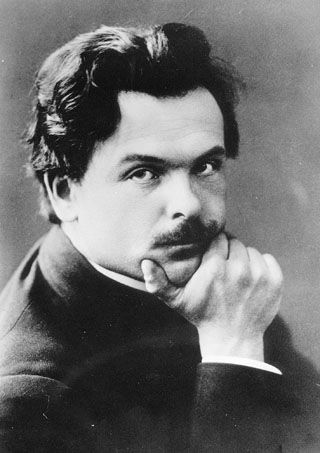

Source: Ondine CD (my rip!)
Formats: FLAC(RAR), DDD Stereo, mp3(320)
File Sizes: 306 MB / 165 MB (FLAC version incl. covers & booklet)
The FLAC link has now expired. No more requests for this, please!
mp3 version -
https://mega.nz/#!yQdlQDRB!JA3zR81xPKgC1FVrcSgT1THcSbWblOHVE6Olhi-LYHY />
Enjoy! Don't share! Buy the original! And please click on "Reputation" button if you downloaded this album! :)
---------- Post added at 04:29 PM ---------- Previous post was at 04:29 PM ----------
P.S.: No more FLAC links will be sent for the next 10 days.
dances43
10-02-2015, 03:49 PM
Thank you very much.
bohuslav
10-02-2015, 04:07 PM
I own this recording since some days, fine music, scandinavian music lovers take a trial. It is worth it.
booster-t
10-02-2015, 08:15 PM
Toivo Kuula: South Ostrobothnian Suites Nos. 1 & 2, Festival March, Prelude and Fugue — another unknown composer (to me) who is worthy of knowing. Recommended.
Powered by vBulletin® Version 4.2.4 Copyright © 2019 vBulletin Solutions, Inc. All rights reserved.







































































































































































































































































































































